Check Our Risk-Free Booking Policy View Details
No recent searches!
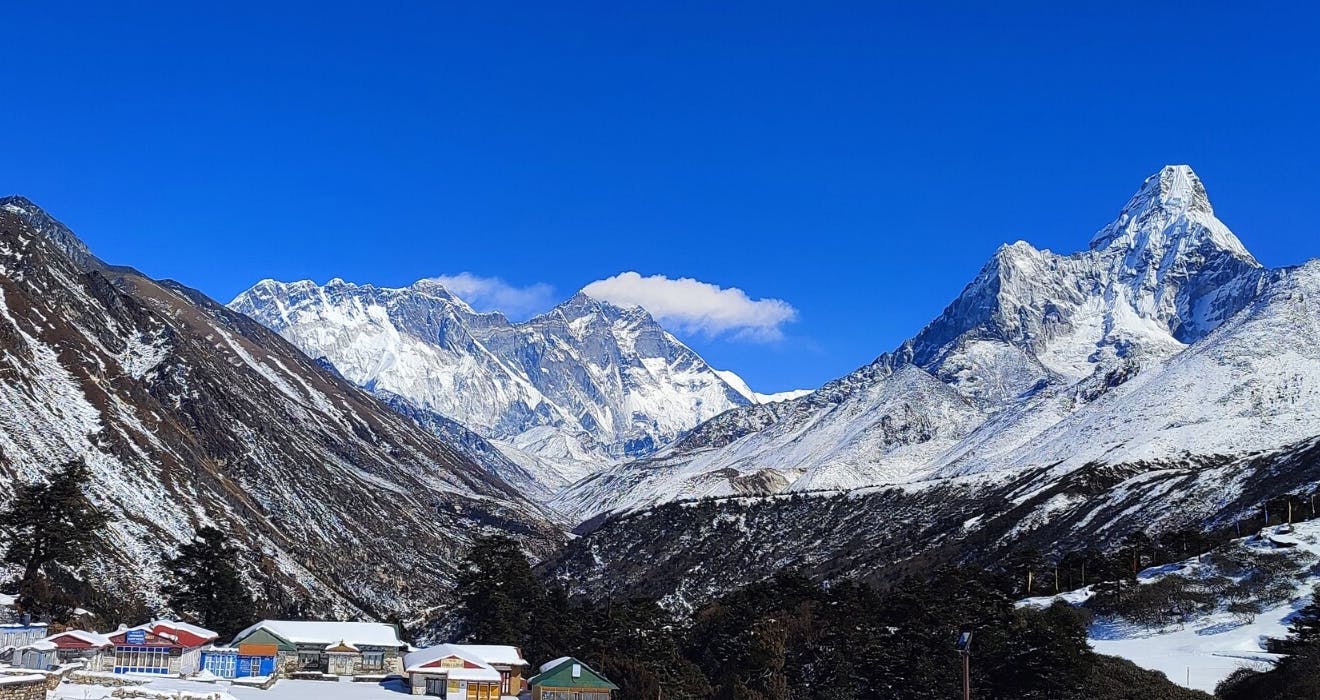
- Everest Base Camp Trek in January

January is counted as an off-season month in Khumbu and other trekking regions of Nepal. It's that time of the year when the trails remain empty and the teahouses vacant. The biting cold of the winter season keeps the tourists away. With nothing much happening on the trail teahouse owners close shop and head to warmer or lower places.
Are you looking for Everest Base Camp Trek in January? Then check out the following packages.
For those hardy trekkers who can battle the cold winter air, January is the perfect month to hit the trail to Everest Base Camp . You can amble up and down the beautiful trail in solitude without having to suffer noisy tourists and choked trails. There's no precipitation in the air and the skies remain clear, which means you can enjoy unobstructed views of the mountains.

Trekking to Everest Base Camp in January Advantages
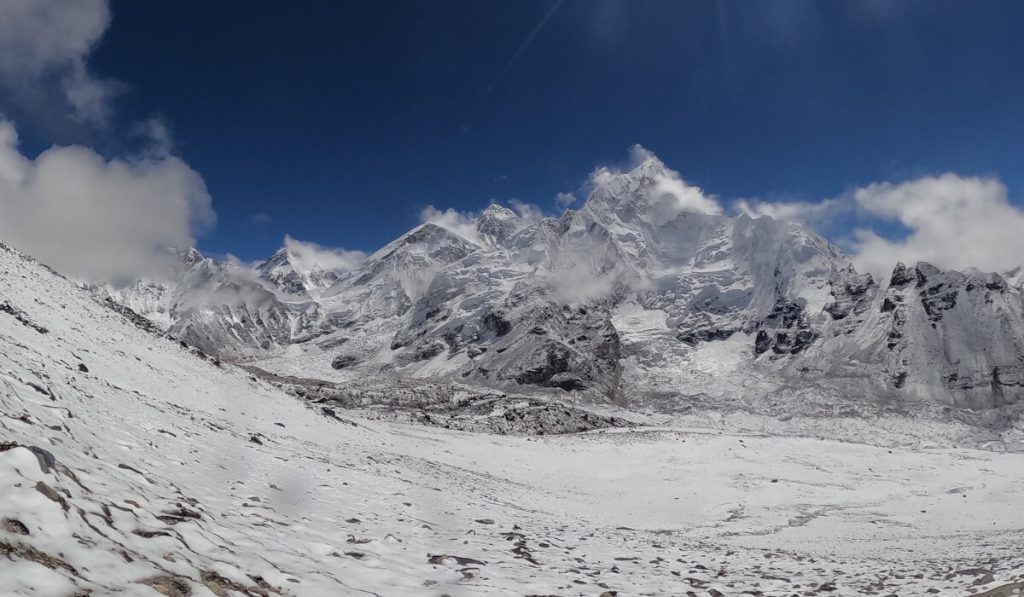
- First of all, you can easily procure a seat on the plane to Lukla ( that is if you are planning to start your trek by flying directly to Lukla). There’s no need to book your ticket in advance. Tickets are easily available and you can book them a day or two before your trip. Sometimes airlines offer off-season discounts too.
- Throughout winter Lukla Flights operates from the domestic airport in Kathmandu. You won't have to take the 4 or 5-hour long road trip from Kathmandu to Manthali Airport in Ramechhap to fly to Lukla, like in the peak seasons.
- Secondly, as mentioned above the trail to Everest Base Camp receives zero or very less traffic in January. Unlike the constant flow of trekkers swarming the trail during peak seasons, there will be fewer people trekking at this time of the year. No traffic jams at narrow crossings and no waiting in line for your turn to show your permit at the check posts. Hurrah!
- There will be fewer pack animals on the trail. The demand for pack animals to transfer goods at teahouses will also decrease as winter rolls in as most teahouses in the upper reaches shut down for the winter season. This means the trail will be less noisy and dusty.
- In January the air remains dry and there's no precipitation in the atmosphere. The skies remain crystal clear. With no fog or clouds blocking your view, you can enjoy clear views of the mountains to your heart's content.
- With the onset of the winter season, wild animals living in the higher reaches tend to migrate to the lower valleys. This means there will more opportunities for wildlife sightings. You may encounter herds of Himalayan Tahr, musk deer, the pretty and colorful Himalayan monal, red pandas, or the elusive snow leopard.
- With fewer tourists on the trail, some teahouses offer discounts (on accommodation). It's possible to find teahouses on the trail offering free accommodation provided you have your meals at their teahouse.
Trekking to Everest Base Camp in January Disadvantages
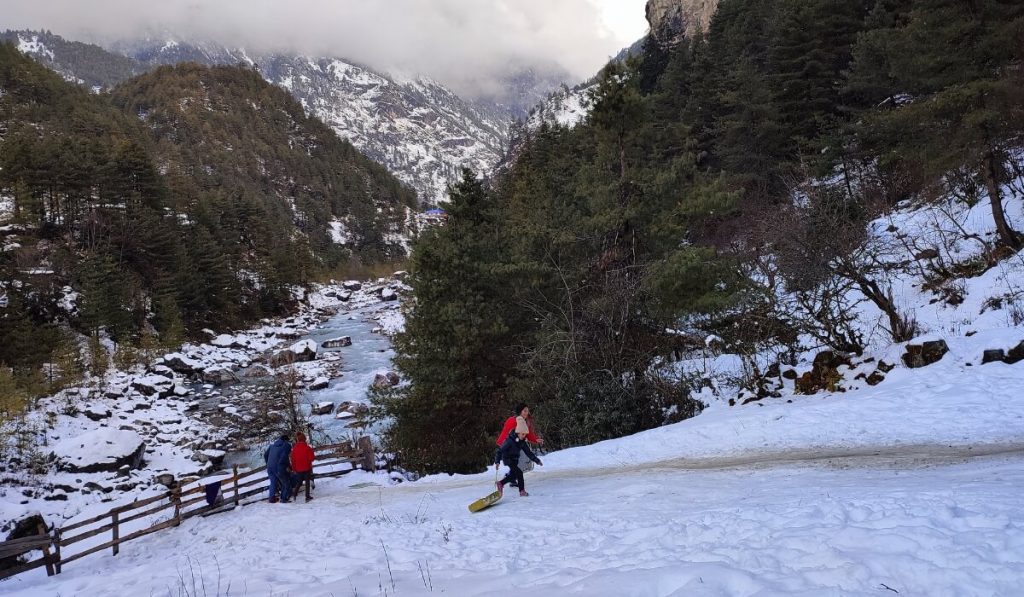
- It will be extremely cold at night, especially at the higher altitudes with temperatures dipping below freezing point at night.
- There's always a possibility of the trails (above 5000 meters) closing down due to the path getting snowbound. You may have to abandon your trek to EBC if the trail is closed.
- Hazard of UV exposure, snow blindness, hypothermia, and frostbite.
- Most of the teahouse owners at the higher reaches close their businesses and head down to the valley. But you will find at least one or two teahouses functioning at each stop even during the off-season.
- It may take a good while to search for a teahouse that's receiving guests. To save yourself from the uncertainty of getting a room at a teahouse we recommend you trek with a local guide. He will know where and which teahouses operate even during dead winter.
Weather in January/Winter Season
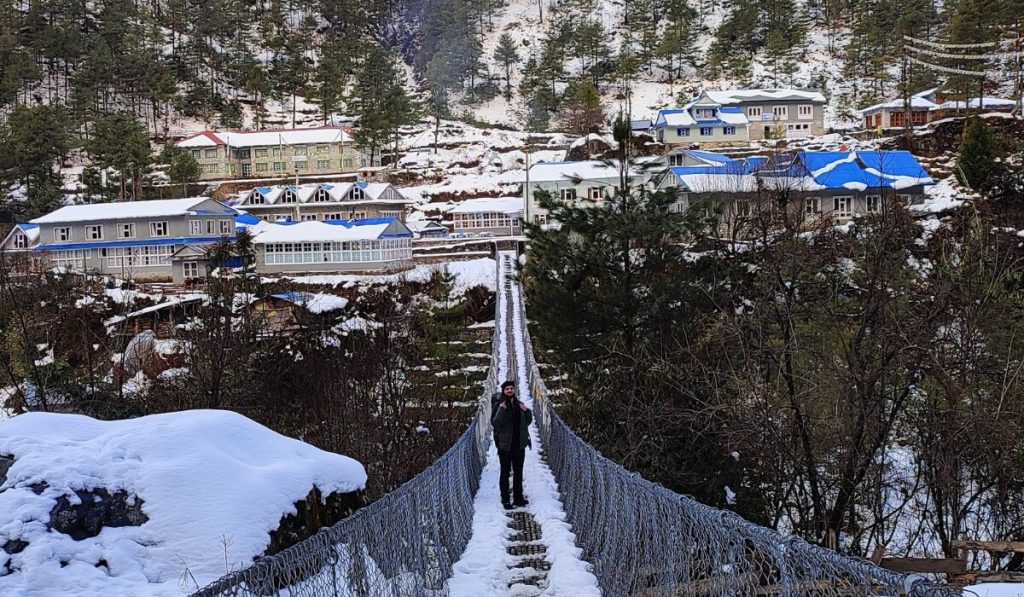
As January is mid-winter, it is the coldest month in the Khumbu Region. In January the minimum average temperature goes down to as low as -26 degree celsius in the higher reaches (5000 meters). The lower valleys (where the villages of Lukla , Namche , and Tengboche are situated) remain a bit warmer with daytime temperatures going as high as 10 degrees Celcius and minimum temperatures dipping below -6 degrees celsius.
One can also expect snowfall on some days and fierce winds. Sun rises at 7:30 AM and sets usually by 5:30 PM. It is advisable to end your trek before sunset as the temperatures outside decrease rapidly after sundown.
In January the days are warm and the sunlight is intense. There's a real danger of UV exposure. To protect yourself apply sunscreen with a high SPF which will offer good protection from harmful UV rays. Also, don't forget to wear a pair of UV protection sunglasses to shield your eyes from harmful rays. UV exposure can cause snow blindness.
Accommodation Situation
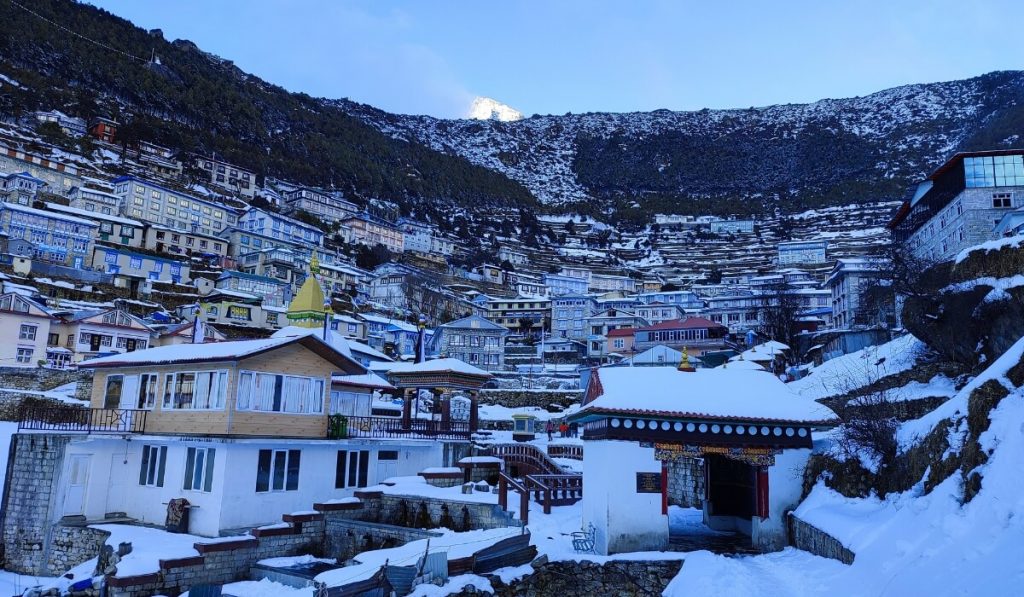
You won't have to worry about accommodation as most of the guesthouses will be empty. While most of the teahouses in the higher reaches close down, it's possible to find at least one teahouse open for business even during the off-season.
Since finding out which teahouse will be open for business can be tough when you are on your own, trekking with a local guide can save you from this hassle. Being a local he will know which teahouses are closed and which remain open.
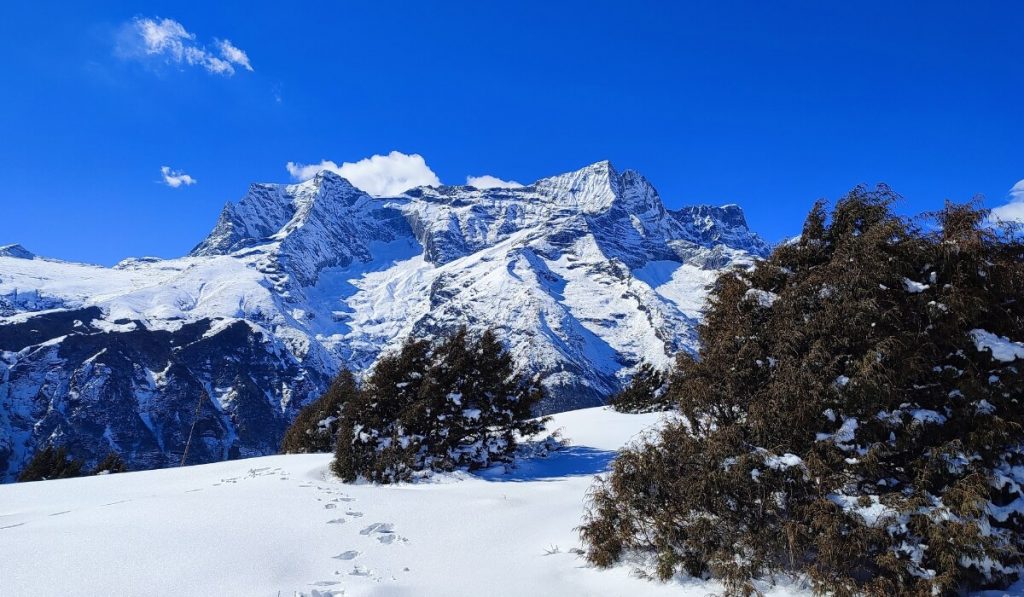
Off-season or not the price of food on the trail will remain the same. But you can expect some concession in the accommodation fee at teahouses.
As there will be fewer shops open on the trail you can shop for snacks in Kathmandu itself and carry them with you.
How to gear up for the January Trek to Everest Base Camp?
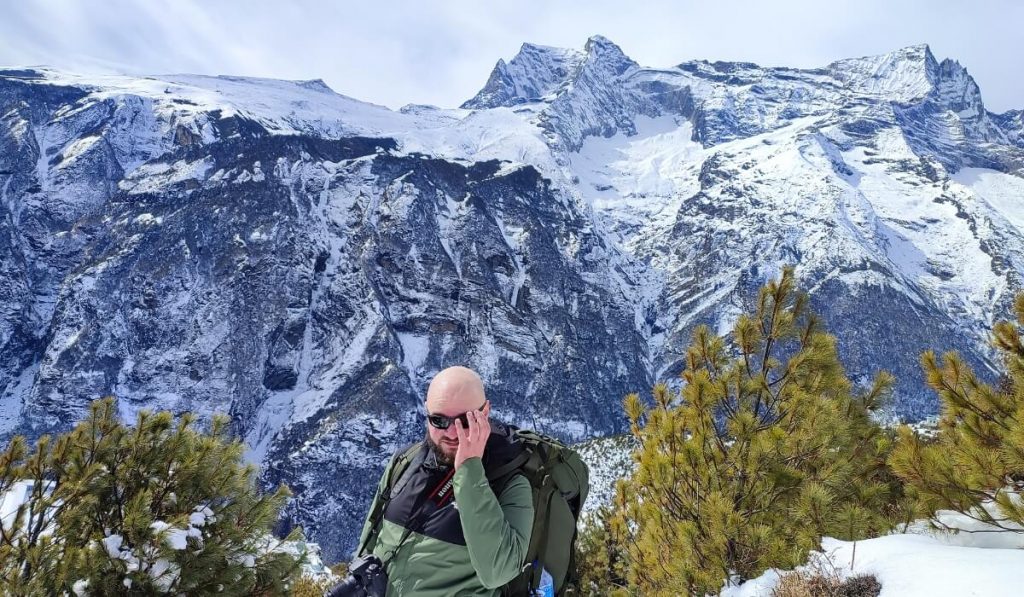
There's no denying the fact that it's going to be super cold in January. Therefore you need to have appropriate clothes to save you from the cold. Carry a good quality down jacket and plenty of warm base layers. A balaclava, down mittens or fur-lined gloves, socks, and a warm hat or cap will save you from the harmful UV rays and freezing cold. A buff or balaclava will offer protection from the dreaded Khumbu cough.
Don't forget to pack a four-season sleeping bag. Of course, the teahouses provide you with blankets or quilts but trust us this won't be enough to keep the freezing cold at bay. A sleeping bag will offer added insulation and keep you warm and toasty on cold nights.
Packing the right clothes may also save your life as hypothermia and frostbite are real hazards at this time of year.
Wear boots that provide good ankle support and are waterproof. You can also carry a pair of gaiters and crampons to wear while walking on snow and ice. Trekking poles will help you navigate the slippery and icy patches.
Last but not least do not forget to carry essential medicines like Diamox, pills for diarrhea, headache, or minor pains, muscle pain relief cream or spray, etc.
Alternate Routes
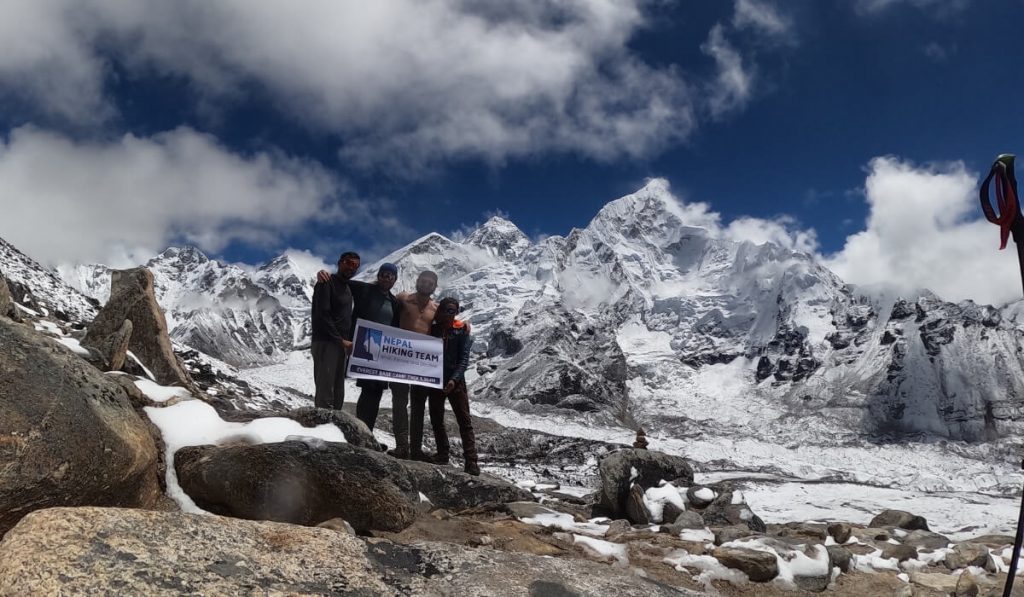
Besides Everest Base Camp , you can also trek to the Gokyo Lakes and Sherpa villages in the lower valleys (Debuche, Thame, Phortse, Pangboche, etc.). Gokyo Valley in winter looks more alluring. Covered in snow and ice, it looks like a winter wonderland. The frozen Gokyo Lakes are ideal spots for trekkers who love ice skating. Ice hockey and figure skating are two outdoor sports that are becoming quite popular among winter trekkers in Khumbu. The Chola Pass usually gets closed during the winter time.
Are you still skeptical about trekking to Everest Base Camp in January?
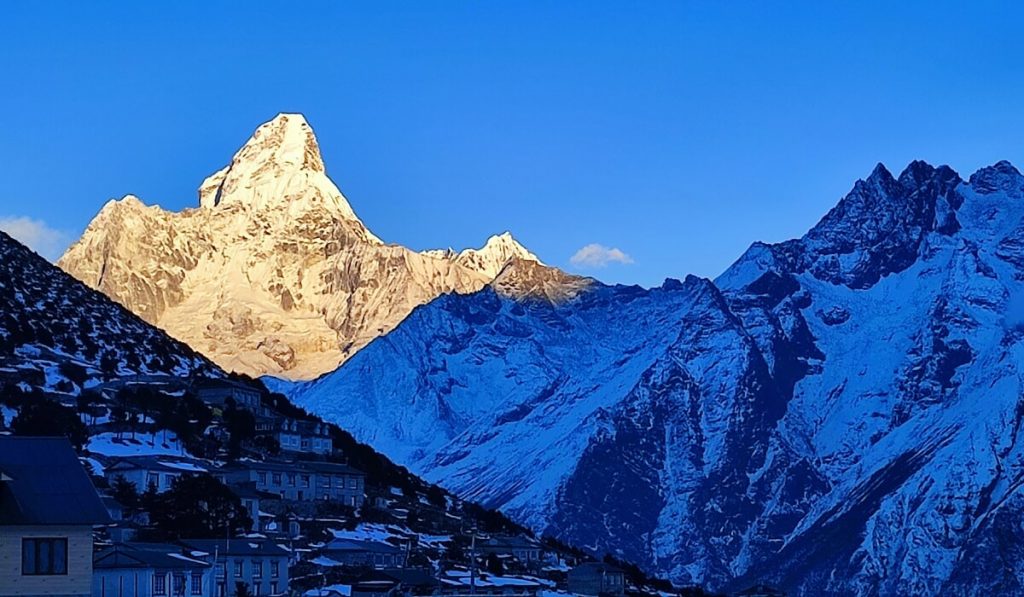
If you still think trekking to Everest Base Camp in January is impossible, then hear this.
A Japanese trekker by the name of Shigeo Osawa trekked to Everest Base Camp every winter to celebrate his new year (1st January). For more than twenty-nine years(starting from the year 1980) he marked his new year by diving into one of the glacial lakes at the Khumbu glacier near the Everest Base Camp.
The International Mountain Museum in Pokhara has showcased his feat in the Hall of Mountain Activities. If you ever visit this museum in Pokhara, do make it a point to check it out.
A German blogger has also mentioned meeting S higeo Osawa at Gorak Shep in 2008. Apparently, Shigeo at the ripe old age of 84 was on his way to Everest base Camp for his customary New Year's swim at the top of the world.
Shigeo Osawa has proved that it is not impossible to battle the extreme cold at Everest Base Camp in winter. Even after hitting the age of eighty, he continued his annual winter tradition, which is to trek to Everest Base Camp and enjoy a swim in the freezing lake waters.
Some adventurers who love winter sports also make it a point to visit the Everest Region in winter. People have skied down Mera Peak, played ice hockey on the frozen Gokyo Lake , and figure-skated on the same lake.
A winter trek to Everest Base Camp in January offers you a great opportunity to experience some of the highest mountains in the world in their winter glory. With few trekkers on the trail, a winter trek to EBC offers you a great experience that you can hardly expect to enjoy during the busy peak seasons.
If you feel like taking up the challenge and hitting the trail to EBC in January give us a call. We would love to arrange your trip for you.
- Everest Base Camp Trek
- Winter Everest Base Camp Trek
- Nepal Hiking Team
- Acclimatization & Safety protocols on EBC trek
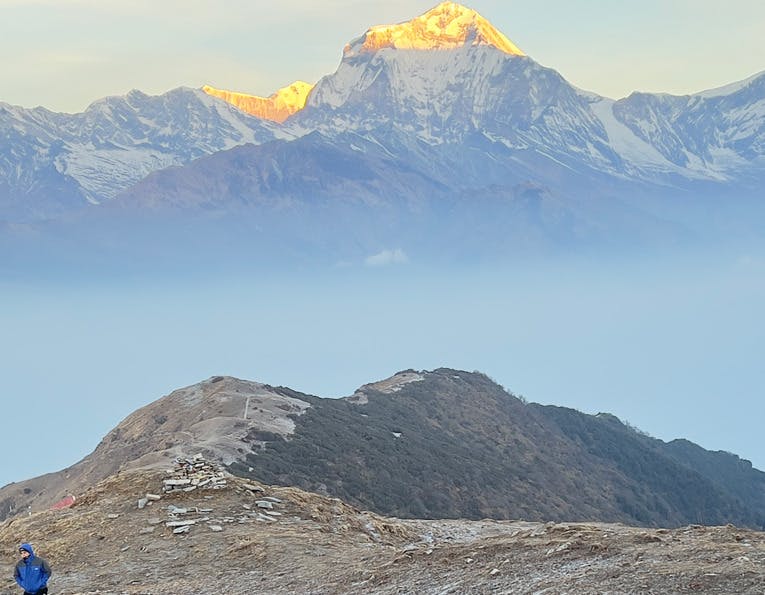
Post a Comment
Subscribe our e-newsletter.
Sign up for Deals and Discount. Get News, Notifications and Updates about the recent Events and Offers.

Nepal Trek Routes
Your Guide to Trekking and Hiking in Nepal
Everest Base Camp Trek in January – Travel Tips, Weather and More

January is the winter month in Nepal and the climate gets colder. However, not many people know that the Everest Base Camp Trek can still be done in January with amazing landscapes in less crowded trails.
Everest Base Camp in January is a unique way of experiencing thrill and adventure in the snowy trails of the Everest Region. Being the coldest month in the winter season, there are not many tourists on the trails which makes the trail less crowded. Thus, you can soak in the beauty and unaffected views during this time of the year.
Although the temperature is low, you will experience no troubles with proper planning and preparation while you trek to the Everest Base Camp. The trip through the Himalayan vistas to the foothill of the tallest mountain in the world is certainly an experience you would not want to miss out.
Table of Contents
- 1. Temperature and Weather
Cloudless Sky
Peaceful trail, cheaper flights and accommodation.
- 3. Getting There
- 4. Food and Accomodation
- 5. What to Pack for EBC Trek in January
Decide on your expectation
Travel insurance, start early.
- 7. Conclusion
Temperature and Weather
January is in the mid-month of the winter season making it one of the coldest months of the year. The days are warm while the nights and mornings are cold.
The average daytime temperature ranges from 8-12 degrees and the temperature at the night is around -17 degrees. You can experience snowfall during this period but can continue trekking as soon as the snow stops. The sunshine is for 5-7 hours per day.
During the period, the trekking can be done in a warm environment. The average daily wind speed is around 8-12 mph. You can enjoy the trek in a warm environment during the day when the sun shines for 5-7 hours a day.
What to Expect On Your EBC Trek In January
During January, there are very few people who make the trek to Everest Base Camp as the cold makes it impossible for some trekkers. But for trekkers who are serious about trekking and want to avoid the crowds in the trails, January is the best month to go trekking at.
Everest Base Camp Trek has many numbers of viewpoints and sites where you can see the tallest mountain in the world and enjoy the snow-covered landscape at its best shining like a white crystal. You can enjoy the beautiful local village, Tengboche Monastery , and a scenic view of the landscape.
The mountains around Tengboche are stunning and mesmerizing. You can get a good picture if you stand in the Everest View Hotel in Namche and soak in the beauty. There are many sites that are unexplainable and words fall short to express the beauty and joy of watching it right in front of your eyes.
There are certainly numerous things you will encounter as you walk to the trail to Everest Base Camp. However, we have listed a few of those things that you shall expect in January during the Everest Base Camp Trek.
In January, the precipitation is very low and the air is dry. So, the skies are clear and cloudless which offers you the best and magnificent view. Also, with no clouds the possibility of flight delays is little.
January is the perfect time for the trekkers to trek in the crowd-free trail. You will enjoy the peaceful environment and soak in the beauty. Also, with lesser people in the tea houses, you can enjoy all the benefits of the tea house. You can talk to the locals and even make personal requests.
The tea houses usually have fixed prices. Since there is a lesser number of trekkers on the trail, you can get the rate cheaper than in other seasons.
Nepali festivals follow the lunar calendar. A festival that is often held in January is Lhosar. The Everest Region has Buddhist in the majority. Lhosar is held on the first day of the New Year. So, you can find Gurung, Tamang, and Sherpa celebrating it.
It is a great time to be on the lap of the mountains during the first day of the new year. Experiencing life in the Everest region is certainly a good start to the year. Make sure you are at Namche Bazaar on the eve of New Years’ as the place is filled with restaurants and cafes. You will meet a lot of trekkers and mountaineers and can share your stories. Also, make sure that you do not consume more alcohol because it might cause altitude sickness or might elevate the alcohol effect.
Getting There
The easiest way of getting to the Everest region is to take a flight to Lukla from Kathmandu. However, the fog in Kathmandu might cause the flight to delay even if the weather at Lukla is perfect.
You can trek from Jiri to Lukla, which is called the Pioneers’ Route. You can take a day drive from Kathmandu to Jiri or can fly from Kathmandu to Phaplu and trek via the Solukhumbu region.
It is not recommended to trek to the higher elevation in January. Avoid treks such as Three Passes Trek as they will have more snow in the region. Trek that is below 13000 feet will be easier and safer during this month.
If you like a shorter trek to the Everest region then you can trek to Namche Bazaar which is two days walk from Lukla.
Food and Accommodation
There is less crowd during the trek in January so you will find the tea houses empty. On the bright side, you can enjoy all the facilities of the tea house and get more time to interact with the locals while you rest in the warm and comfortable accommodation.
The tea houses are comfortable with basic facilities for you to spend your nights and rest properly. The rooms are twin bedrooms where you can either get an attached bathroom or a common toilet depending on the altitude. It is to be noted that the higher you go in the altitude, the more basic facilities get.
The beds have comfortable mattresses, pillows, and blankets. Since the tea house will be empty, you can get more blankets to borrow for the night.
There are facilities for charging gadgets and Wi-Fi but might not be properly available. The tea houses use solar panels, so during gloomy days, there might be no electricity for you to charge the gadgets.
The toilets can either be western style or the traditional ones. While you are at the lower altitude, you can find a good and clean toilet with a western-style flush. But as you higher in the altitude, you can commonly find a squat-type toilet where you have to fill the bucket and pour it to flush. Make sure you carry toilet paper all the time.
Also, carry hand sanitizers because during the morning the water might freeze and become ice.
On the other hand, the food is delicious and is freshly made. It is suggested to try on local food which is Dal Bhaat which has steamed rice, lentil soup, curries, and pickle. Since you will need a good amount of energy, this local food is helpful and easily available.
There are wide varieties of western food as well that you can enjoy during breakfast as well.
For drinking water, you can either opt for Nalgene bottles or bring your own bottle to fill in the water. It is not recommended to buy plastic bottles as you cannot fill in hot waters and the trail might get polluted in case you leave the bottle.
You can ask for boiled water in the tea house and fill in your own bottle to keep you hydrated during the day. Make sure you do not drink from the tap water or the river as they might be contaminated.
Also, Make sure you carry a purifying tablet so that you can drink the tap water after treating it.
What to Pack for EBC Trek in January
January is the coldest month in the winter season and you must be ready to pack extra warm clothes. The temperature falls below zero at night and you must have warm and comfortable clothes to protect your body from the cold. The must thing while trekking to Everest Base Camp Trek in January is insulating warm clothes.
January can be equally fun and rewarding as the peak season with proper planning and information. You must own a good pair of boots to keep your feet warm. Make sure there are microspikes on the boots to prevent any kind of injuries.
Trekking poles are mandatory to help you cross the snowy trails. To avoid exposure to the chilly winds, make sure you have a down jacket, sleeping bag, water, and windproof gloves, and warm base layers.
If you like to read the items in detail, you can check out our packing list item for the Everest Base Camp Trek .
Travel Tips
Being prepared in terms of equipment and information will make your trek the best. If this is your first time trekking to the Everest Base Camp, you will have a lot of confusion on what to take and what better things to do. Being over-prepared and underprepared can be equally daunting and agonizing. There are a lot of tips on your trek to the Everest Base Camp which can help you to make the trip unforgettable.
The trek to the Everest Base Camp can be intimidating for many trekkers but it really should not be. With the help of the experts and trekkers, we have collected lists of the travel guide. We have listed you few travel tips that can give you an outline on how to make the trekking experience better and learn from the experts.
If you are sure of what you want from the trek, then you can decide on which route is suitable for you. In January, the entire route leading to Everest Base Camp is open. If you are trekking in a group and want to have a great conversation during the trek, then use the direct way to the Base Camp.
If you want to avoid the crowd, take the Jiri Everest Base Camp route. For more adventure, there are other routes as well.
Layering your clothes is the ideal way of keeping your body warm. You can easily add or remove your layers as per the requirement.
It is mandatory to have travel insurance for your health safety and emergency evacuation in case you need it at a higher altitude. Make sure it covers high altitude treks in Nepal and air ambulance.
The early you start, the more time you have to explore the beauty of the region. Also, you will reach the destination before dark. You can rest in between the treks or walk at your own pace. You can also spend time with the locals at your tea house and interact with them if you reach your tea house early.
Bring a book
Now, this is a travel tip that will help you pass time during the stay at the tea houses. There is no TV or internet connection at a higher altitude so you will have nothing else to do. Of course, you will need sleep and enough rest for the next day, and bringing a book will help you sleep faster.
Also, you can bring playing cards and pass time before you go to bed.
January is a peaceful trekking month for the trekkers leading to Everest Base Camp. Traveling in a lesser crowded trail not only offers exciting but also thrilling adventure to the classic trek. With the most stunning views, January is the month to explore the route. So, if you are dreaming and want to cut the Everest Base Camp trek off the bucket list, we are here to help you.
If you have any further queries for the treks to Everest Base Camp in January , you can contact us and we will be happy to guide you on your next adventure.
Naba Raj Amgai
Naba Raj Amgai, stepped into the world of travel and tourism in 1996.
Beginning his journey in the tourism industry as a humble Porter Guide to founding hospitality establishments and an adventure travel company, he has come a long way.
In a career spanning more than two decades he has achieved more than anybody dreams of achieving. Along with his professional achievements, his selfless contribution towards his community and society has won him a lot of accolades and praises.
Having dedicated more than two decades in the tourism and hospitality sector, he has amassed a wealth of experience.
After passing high school, he began helping out some trekking guides and was soon recruited as a porter guide at a reputed trekking agency. Within a short period of time he was individually guiding clients across the well-known trails of the Himalayas.
He went on to lead tour groups on multi-country tours to Nepal, Tibet, Bhutan and India. Being a part of mountain climbing expeditions familiarised him with expedition logistics and operations. Later on he went to become the Executive Director and took over the reins of Operations, Sales and Marketing departments. Spending several years in the tourism field has made Naba Raj Amgai a destination expert.
Travelling is his passion and he has been to many countries across the world – USA, Canada, Australia, Japan, Holland, Germany, Austria and many parts of Asia.
His journeys to different parts of the world have enriched his travel experience and knowledge. This experience has been instrumental in planning and organising successful trips for several clients.
As of today many reputed trekking agencies, hotels and restaurants are under his leadership. A dynamic and proactive leader, he continues to inspire and motivate people from all walks of life.
You may also like...
Upper mustang trek permit, 4 best trek routes to nar phu valley, 21 best short treks from pokhara, (1) comment.
Thanks for the article!
Leave a Reply Cancel reply
Your email address will not be published. Required fields are marked *
Save my name, email, and website in this browser for the next time I comment.
- Government Registered No: 113188/070
- Tourism No: 1599
- VAT No: 601221723
Nepal Eco Adventure
Committed To Be Eco Friendly!
- +977 9851170646 (Chhatra)
Everest Base Camp Trek in January
In January, winter sets in Nepal and Everest Camp as well. Everest Base Camp trek in January can be a unique kind of adventure in the snow-covered trails of the Everest region.
This is the coldest month in the Everest region so it experiences fewer tourists in the trekking trails. You will have the most peaceful treks with the unaffected views during this time.
Although you will experience many cold temperatures with wind chills, trekking to Everest Base Camp is no problem with proper packing and physical preparation.
We Have Covered
Highlights of Everest Base Camp (EBC) Trek in January
- A thrilling mountain flight to and from Lukla airport
- A mesmerizing view of snow-covered Everest and other Himalayan giants.
- Full attention and hospitality of the local tea house owners, villages. Panoramic views of the snow shed mountains
- Stunning sunrise or sunset view at Kala Patthar- 5,643 m
- Views of Sagarmatha National Park covered in snow
- An adventurous and thrilling trekking experience.
- Less crowded and peaceful trekking experience.
- A chance to witness the clear blue skies with breathtaking mountain views and beautiful sceneries.
- Send us a Quick Enquiry
- Contact Number
- Your Message *
Temperature and Weather Conditions of Everest Base Camp Trek in January
January is mid-winter season in Nepal. Hence, it is one of the coldest months of the year.
In the Everest Region, the temperatures drop below freezing at night. But, the days are quite sunny, clear and cloudless. The Everest Region receives snowfall from the mid of December.
Temperature
The days are quite warm while the nights and early mornings are cold during this trek in January.
The average daytime temperature in the Everest region is around 8-12 degree. During the night the average drops down to -17 degree. Although it snows, you can start your trek as soon as it stops.
To give you a better idea about the temperatures you will face, here is a breakdown of temperatures of some of the popular rest stops during your Everest Base Camp trek.
Lukla (2,829 m) : This is where most treks to Everest Base Camp begins and ends. Here, the average temperature is around 2.8°C. During the days, it can reach 8. 5°C. During the nights, it can drop to -2.8°C.
Namche Bazaar (3,463m) is a popular acclimatization stop. It is also the highest trade center in the world. Here, the average daily temperature is around -6°C. During the nights, it can drop to -10°C. Yet, during the days, you can enjoy cool temperatures of around -3°C.
Dingboche (4,483 m) is another popular acclimatization or rest day stop. At this altitude, the average daily temperature is around -7.2 °C. The nights have an average temperature of -15.3°C while the days are around 1°C.
Lobuche (4,910 m) sees an average daily temperature of -9.7°C. During the nights and early mornings, the average temperature can drop to -18.3°C. Yet, during the days, you can get average temperatures of -1.1°C.
Gorak Shep (5,180 m) is the highest sleeping point for your Everest Base Camp Trek. Here, the average daily temperatures are around -10.9°C. The nights and mornings are colder with an average temperature of around -19.6°C. The days are warmer with average temperatures of -2.1°C
Average Sunshine per Day
The sun shines for an average of 5-7 hours per day in January for most of the Everest Region.
During these hours, you can enjoy your treks in a warm and comfortable surrounding. After the sunrise, the day temperatures rise up a little bit.
The average daily wind speed in January is about 8-12 mph. This is quite windy.
Note: The weather in the mountains is quite unpredictable. This is true for a winter month like January. You may have to face different weather conditions in a single day. This includes sudden weather changes like blizzards, wind chill. Come ready to face any of these changes.
Benefits of Everest Base Camp Trek in January
Fewer crowds.
January is one of the best time for trekking in a crowd-free trial. The beautiful trails have a very little crowd of trekkers in January. Hence, you can enjoy the solitude and peace of the trails in January.
Awesome Vivid Views
You get some of the most spectacular views of the snowy mountain peaks in January. You can enjoy unobstructed views of the surrounding landscapes and mountains. On the Everest Base Camp trek, you can see views of flat meadows from the top of ridges. You can also gaze at the spectacular snow peaks.
This is especially true for places like Kala Patthar, Khumbu Glacier, and Namche Bazaar. In January, these places offer some of the best scenarios in the world.
It is also the best time to take photos of the landscape and mountains. Not only are the views crystal clear and magical, but there is also very fewer chances of other trekkers of photobombing.
With the very few numbers of trekkers, you can have the best spots for photography for yourself. Hence, you can have more fun and take the time to get the best photographs.
Choice of Flights and Accommodation
Unlike the peak season, January is not packed with trekkers and visitors. Hence, you can get your choice of flights to and from Lukla with abundant seats. There is very less chance of not getting the flights on time.
It is the same for accommodations. Many tea houses and lodges will want you to stay with them in January. Hence, you will get the undivided attention of the tea house or lodge operators with great hospitality. You can also ask for extra mattresses and quilt for extra comfort and warmth while sleeping.
Snowfall and Skating
It is the middle of winter in January in the Everest Region. Hence, there is a chance of snowfall. You can enjoy the white sprinkles of snow. You can also choose to skate amidst the highest mountain in the world. It will make for a great story and memory.
Exotic Mountain Trek Experience
Unlike the peak seasons, January offers an exotic trekking experience. You can enjoy the full glory of the snowy mountain peaks and landscapes. The winter trekking experience has its own wonderful magic. The flawless winter world of the Everest Region along with the fabulous and clear white snowy mountain peaks is mesmerizing.
Discounts and Complimentary Services
January is an off-peak season for treks to Nepal. Hence, you can find better and cheaper deals on flights and accommodation during your Everest Base Camp Trek. Instead of discounts, some lodges and hotels offer complimentary services as well.
Disadvantages of Everest Base Camp Trek in January
Shorter days.
The winter days of January are shorter in the Everest Region. Hence, you will have to trek early to reach your destination before it gets dark and cold. The number of trekking hours is also less. Hence, you have less time to relax.
Piles of Deep Snow
In the higher altitudes, you will come across places with piles of deep snow. Hence, you may have to walk through heavy snow. The snow can also cover the trails. Make sure to follow the directions of your guides during these times. Else, you may lose your way to your destination and get lost.
Cold Freezing Temperature
January is one of the coldest months in the Everest region. During the days, it can be bright and cool. Yet during the nights and early mornings, the temperature is below freezing point. Hence, without proper clothing and supplies, there are chances that you get frostbite if you are not cautious.
Blizzards and Wind Chills
This is one of the biggest challenges you can face during your Everest Base Camp trek in January. The chilling wind can bring bad weather conditions like blizzards to the Everest region. Stay updated on these facts and the weather conditions for a safe trek.
What to Pack for Everest Base Camp Trek in January?
Gearing up well for the winter of January is essential for a safe and comfortable Everest Base Camp trek. Along with all the regular essentials of a high altitude trek, you need to add your winter essentials as well.
Some of the most important ones to remember are:
- Windproof and waterproof down jackets, trousers to keep the snow as well as the cold away.
- Inner T-shirts to go along with full-sleeve shirts.
- Lip balms, sunscreen creams, winter gloves and hats, and a pair of warm socks. This helps to protect your skin and your body which is usually not covered by your clothing.
- Comfortable and capacious backpack. In winter, you will pack more clothes. The clothes will also take up more space. Hence, you need a good, strong and durable bag with enough space to accommodate all your necessary belongings.
- A durable, waterproof pair of trekking shoes. A snow resistant shoes that are crampon friendly will come in handy.
- Sleeping Bag with liners: Make sure it is suitable for -40 degrees Celsius. The tea houses on the trails do not have heating systems. These will help keep you warm during the cold nights.
- Trekking Poles: Adjustable lightweight poles are easy to store, durable and user-friendly. These poles help during the uphill climbs and descents. They are great for support and balance especially while walking in the snow.
Note : These are just a guideline to help you pack for your EBC Trek in January. You are free to change to suit your needs.
Things to Keep in Mind during EBC Trek in January
During winter, your body burns more calories than it would during the warmer days. So, you should maintain your food intake. Make sure your diet is rich in carbohydrate and protein.
Don’t let your stomach feel empty. Also, always stay hydrated. Water is a great healer.
Both of these help to keep altitude sickness away. Avoid alcohol during, before and after the trek. This increases the effects of dehydration as it makes your body dry.
Sun-protection Gear
Make sure to include sun protection gear to your packing essentials for EBC trek in January.
This includes Sunscreen, Sun hat, UV protection lip balm, and Sunglasses.
During the sunshine hours, the sun is scorching in the high altitudes. In January, because of the white snow, 80% of the sun reflects back to you. So, your skin burns faster.
Take sunscreen with a high SPF and apply it every few hours. Make sure your sunglasses also protect you from the glare of the sun from the snow.
Avoid Solo Treks
During winter, solo treks are a huge ‘No’. There are very few to no other trekkers in the Everest Region. The trails also get covered by snow. The chances of losing your way and not getting any help are high. Hence, it is always advised to travel with other trekkers and with a guide.
Layer Your Clothes
During winter treks like this one, layering is a must. It keeps you warm. It is easier to remove or add layers when you get cold or hot. You will not have to go through your luggage when the temperature changes.
Start Your Trek Early
The days are shorter in January. Hence, you should start your trek early in the morning. This way, you will reach the lodge before it gets dark and cold.
Travel Insurance
Always have travel insurance while trekking. Trekking is an outdoor sport and has its risks. To keep the risk minimum and your mind at ease, having one is essential. Make sure your travel insurance covers travel to Nepal and altitude of 5000m and more.
Have a Flexible Trekking Itinerary
During winter treks in January, allow some days for possible delays. The weather conditions are less predictable in winter. This can lead to roadblocks, flight delays due to heavy snow on the trails or the region.
Hire a Porter
You will need to carry more than your regular high altitude trekking essentials. These will include your winter trekking clothes as well as equipment and supplies. You will also be walking on snow. The trails can also be slippery and slushy due to the snow.
Hence, having a porter to carry your luggage will help lighten your load. It will also leave you free to focus on your walk and the trails.
Proper Acclimatization Schedule
Make sure you have a good and professional acclimatization schedule. Stick to it, do not ever skip it. You should acclimatize for at least 3 days at Namche Bazaar and then at Dingboche.
This will lessen the chances of high altitude sickness.
January is an off-peak season. Hence, there will be fewer crowds on the trails, flights, accommodations. Hence, these facilities will be at their cheapest with better accommodation.
These include less expensive flights and special treatments or complementary services.
Be on the lookout for these and be ready to bargain for the best prices.
Walk in a Careful and Mindful Way
Walking on the trails to EBC in January can be a challenge. The trails may have snow which makes it slippery. Hence, keep your focus on the trails and be careful while walking. This is especially true for days after a heavy snowfall.
The best way to know you are walking on the safe side is following your guide and other experienced trekkers.
Physical and Mental Preparation
EBC trek is a mid-long duration high altitude trek. Along with this, January is a winter trek. Hence, getting some training like jogging, walking, and staying fit is essential. Make sure you get these training at least 3-4 months before your actual trek.
The fitter you are the more comfortable the trek will be for you. The physical training will also help to mentally prepare you for the trek. It should help improve your overall performance.
January is a quiet and peaceful trekking month for treks to the Everest Base Camp. It offers extra adventure and thrill to the classic trek.
With some of the most attractive views on offer, January is the month for you if you don’t mind the cold and looking for excitement in the classic route.
For any further question and queries for treks to Everest Base Camp in January, feel free to contact us. You can also contact us to guide and assist you for this trek or any other trek and tour in Nepal throughout the year.
You can also create your own custom itinerary for your EBC trek in January.
Recommended Articles
Poon hill weather.
Poon hill is a beautiful place with incredible scenes located very close to the gorgeous city of Pokhara. This place is full of wonderful villages, friendly people, and pleasant climatic condition. It is an ideal destination for people who are looking for a short trek …
Manaslu Trek without Guide
Manaslu which is also known as Kutang is the eighth highest mountain in the world situated at 8,163 meters (26,781 ft) above sea level. It lies in the Mansiri Himal, part of the Nepalese Himalayas in the west-central part of Nepal. The Manaslu means “Mountain …
Mera Peak Permit Cost
Mera Peak Climbing is a great and fantastic combination of high altitude trek and climb. To climb Mera Peak, you will need two or more trekking permits as well. Depending on the route you pick, the cost of Mera Peak permit varies. A climb to …
Stay Hip with Edgy Updates from the Himalayas.
Trusted by Over 18,000 trekkers &
No Salesy Stuff or Spam
Want to try our new feed system.
Lorem, ipsum dolor sit amet consectetur adipisicing elit. Maiores dicta voluptas vero facere delectus quaerat dolorem perferendis tenetur animi corrupti porro error earum ad modi temporibus beatae praesentium, sapiente cupiditate!
Try new system
Everest Base Camp Trek in January
- Published on April 9, 2020 • Last updated January 7, 2022
Everest Region
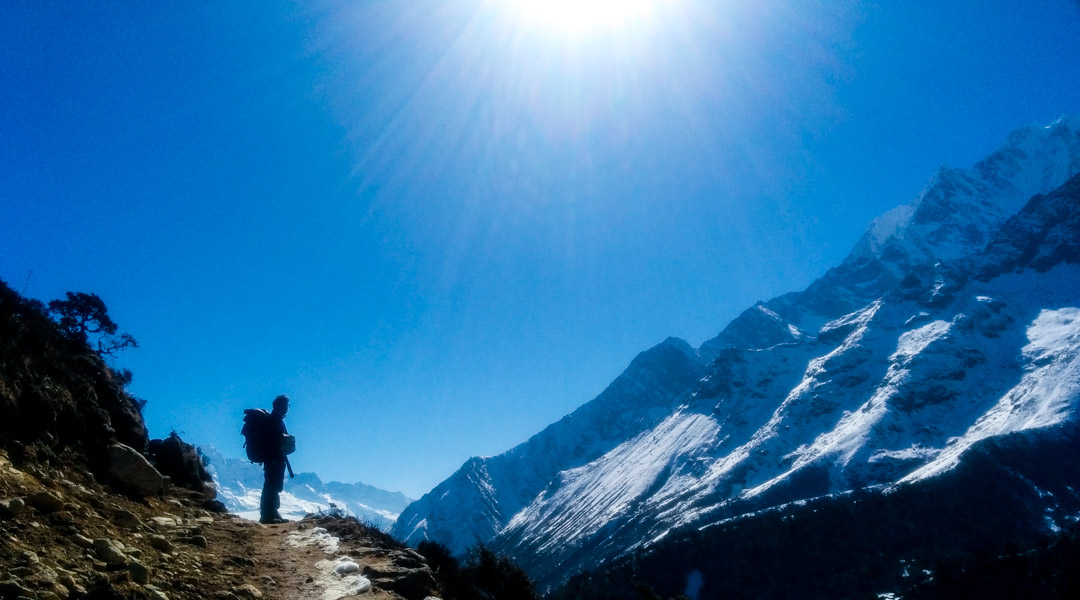
With clear skies and empty trails, Everest Base Camp Trek in January can be a rewarding experience for those that prepare well for the cold weather and snow.
Weather for Everest Base Camp Trek in January
January is the coldest month in the Everest Region . The absolute minimum temperature at altitudes of 5,000 masl can go as low as -26°C or -14.8°F. However, when the mercury hits that temperature, you will be under layers of blankets in a cozy lodge. Daytime temperatures while cold is still tolerable. But once the sun goes down, the temperature starts to drop very rapidly. Ideally, you want to be inside a lodge before sunset.
January also sees at least a few days of snow. And that snow doesn’t melt until mid-March. With snow on the ground and bright sunny days, you will be exposed to a high amount of UV. Also, remember that it is the dry and cold westerly wind that brings snow to Khumbu in January.

Hazards, Gear and Planning Tips for EBC Trek in January
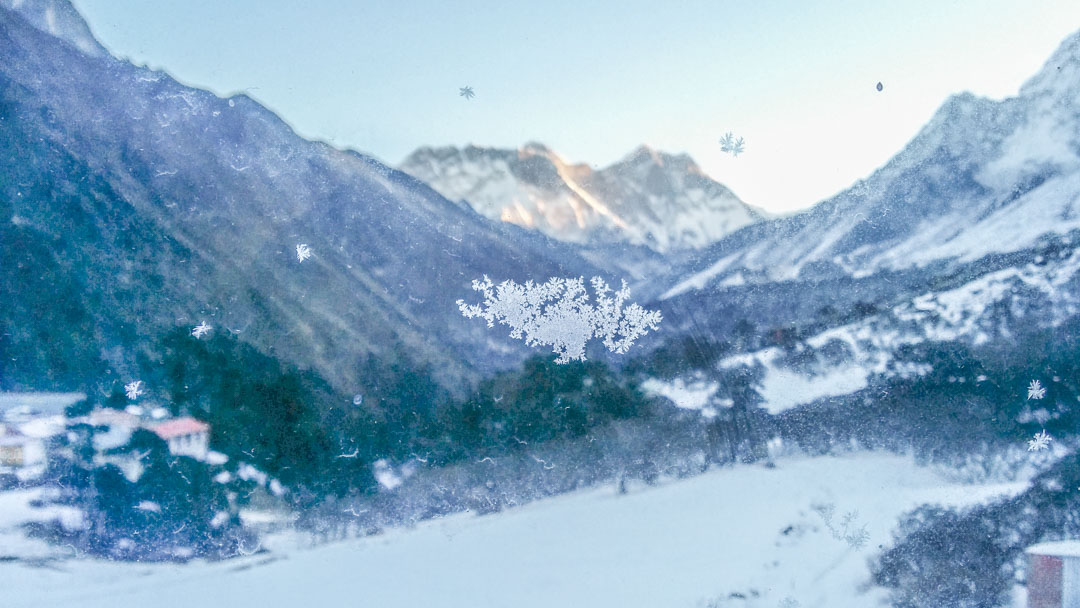
Given the weather, for those that are not prepared, frostbite, hypothermia, snow blindness, Khumbu cough, sunburn, and traumatic injuries are genuine possibilities.
However, for the well prepared, January can be a very rewarding time to trek. A pair of good boots will keep your feet dry and warm from the snow. Consider using microspikes in some sections to avoid traumatic injuries. Trekking poles are also highly recommended. To avoid exposure, it is essential to have a good down jacket, four-season sleeping bag, woolen cap, waterproof gloves, and warm base layers. An extra fleece will and gaiters can also come in handy. Do not skimp on the sunscreen and get good sunglasses to protect yourself against the intense high-altitude UV exposure. A buff over your nose and mouth will protect you from the Khumbu cough and UV at the same time. Also, given limited daylight, it is essential not to be too ambitious with your days.
Generally, if you prepare for the worst, January is an ideal time to trek in the Everest Region . Here is a Comprehensive Gear Checklist for Trekking in Nepal. Also, read more about Altitude Illnesses and Environmental Hazards .
Three High Passes of Everest in January

Contrary to popular opinion, the three high passes of Everest (Cho La, Kongma La, and Renjo La) are doable in January. However, it is imperative to prepare with extra days, an experienced guide, and proper gear. There is an excellent Thorn Tree discussion on midwinter trekking in Nepal .
That said, there is not a single trek in the Everest Region that cannot be done in January.
How crowded is the Everest Base Camp Trek in January?

With only 1,700 of the 56,000 trekkers entering the Everest Region in January, it is one of the most underrated months. Even though winter treks are getting increasingly popular, you can still be assured to have the trail, lodges, sunshine, and mountain views all to yourself!

Lukla Flights in January

Unlike the peak trekking season, flights to Lukla will operate from Kathmandu in January. While fog in Kathmandu and snow in Lukla can cause delays/cancellations, the weather in January is generally stable with clear skies. Do have an extra day for eventualities, but chances are very low that you will have to use it.
Hotels and Prices in January
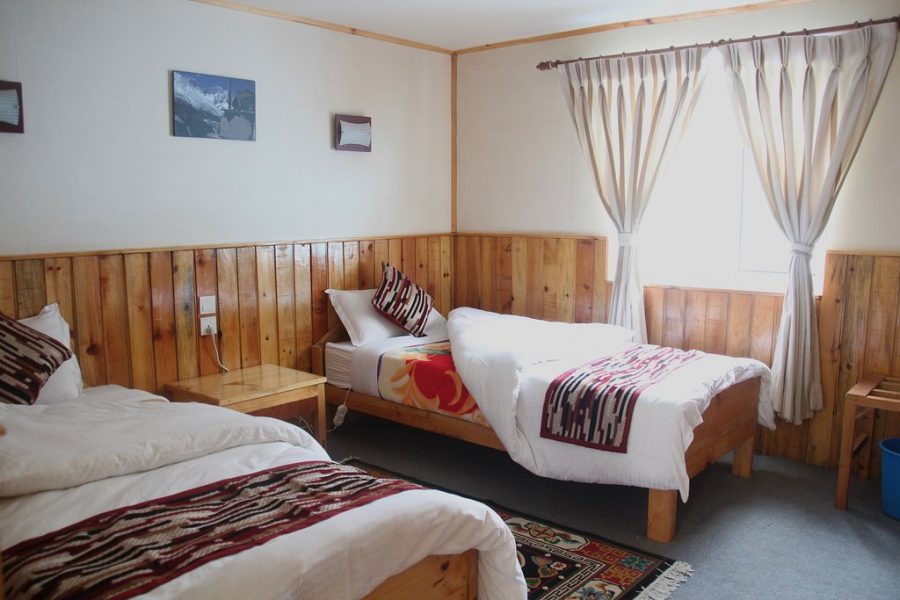
At least one hotel will remain open in a village throughout the winter. While you can’t be sure which one will be open, you can rest assured that at least one will be open. However, it doesn’t hurt to call or book hotels of Everest in advance.
Weird as it may sound, prices in the Everest Region do not fluctuate with the season. You might get a discount here and there, but that will be the extent of it. While you will not save much in Khumbu, you might be able to get a good deal on international flight tickets to Kathmandu during this period.
Attractions in the Everest Region in January

As mentioned already, the most fantastic thing about doing the Everest Base Camp Trek in January is the spectacular mountain views and empty trails. If you plan to go to Gokyo , you will probably be pleased to find that the lakes there are all frozen!
In addition to these, it is also worthwhile to note that a lot of large wildlife descend to lower valleys during the winter, which increases your chance of crossing paths with them. Musk Deer, Himalayan Tahr, Snow Leopard, and Himalayan Monals are more easily seen during January .
Happy trails!
- everest base camp trek in winter
- everest base cap trek in january
- everest trek
- midwinter trek in everest
- winter trek in nepal
Related Post

What to expect on the Everest Base Camp Trek?
- February 16, 2022

How to train for the Everest Base Camp trek?
- February 15, 2022

Travel Insurance for Everest Base Camp Trek
HoneyGuide Staff
This post was created by an internal staff writer.


Mosaic Adventure
Unleash the trekking bug in you…. experience the Himalayan touch……
Everest Base Camp trek in January
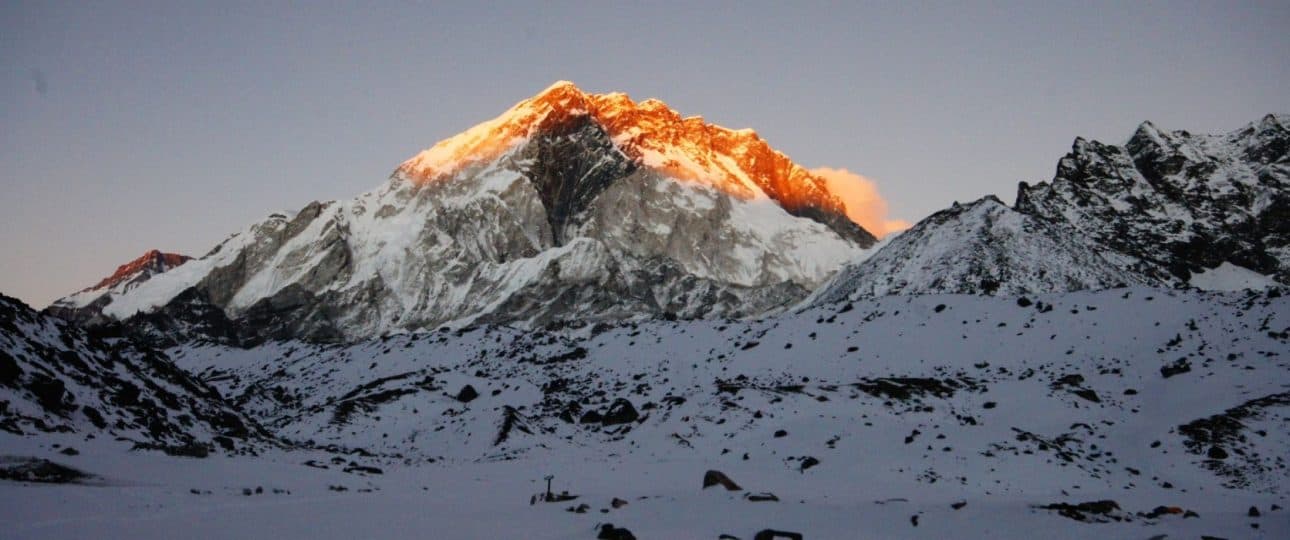
The Everest Base Camp trek in January is generally quiet and peaceful compared to other months.
And, adventurous at the same time.
Just after autumn, a busy season in Nepal, winter season sets in.
Everest Base Camp trek in winter is not the peak trekking season because of the holidays and a cold weather.
But it has the most attractive views.
However, trekking to EBC in January has its own advantages.
Despite the cold, the daytime at Everest Base Camp is warm with bright sunshine.
And, though the night time temperature can get low, it should not bother much because you will be indoors.
Trekking in January means you will get great views of the mountains.
You may not get to experience such glorious and scenic views in any other season but in winter.
Hence if you want to choose trekking in Everest Base Camp in January, there are a few things to consider.
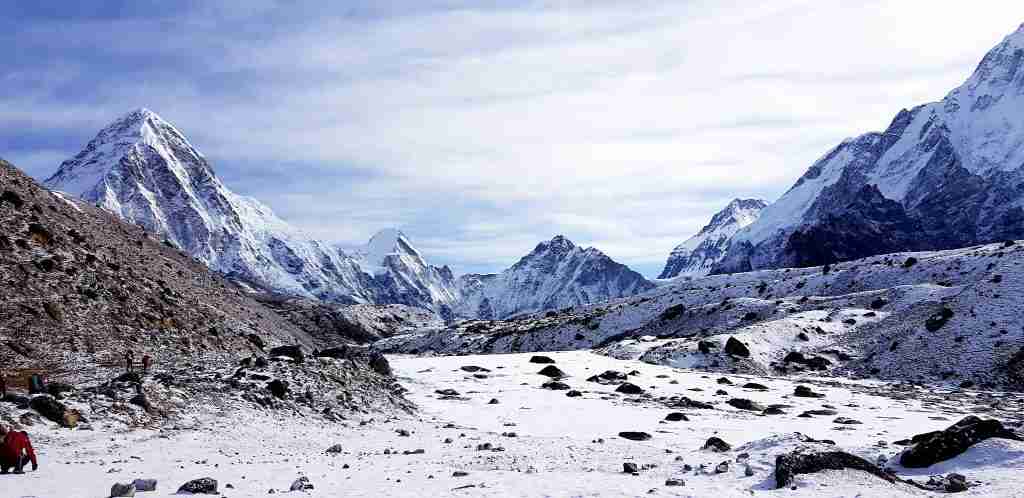
Table of Contents
Weather During Everest Base Camp Trek in January
Altitude of everest base camp, understanding altitude sickness and how to prevent it, packing tips for everest base camp trek in january, advantages of ebc trek in january, disadvantages of everest base camp trek in january, tips to consider while trekking to ebc in january, how cold can it get while doing the ebc trek in january, will the tea houses in the ebc region remain open in january, are guides/porters necessary for ebc trek in january, do i need a travel insurance while trekking in ebc in january, what type of clothes are required for doing the ebc trek in january, everest panorama trek, everest base camp helicopter trek -11 days, jiri to everest base camp trek, gokyo lakes trek.
As it barely rains, the EBC weather in January is mostly dry and stable.
However, the temperature changes drastically from day to night.
During the day, the sunshine is warm and the temperature remains around 4℃ (39℉).
Whereas during the night, the temperature at highest altitude like Gorakshep can drop to as low as -25℃ (-13℉).
There might also be occasional snow that won’t last for a long time (a day max).
You can continue your trek after the snow stops.
During this particular time, the trekking poles will come in handy.
Basically trekking in January is for those who want to avoid the crowd and can handle the cold.
Here’s a detail of the Everest Base Camp Trek Temperature in January
Want more information? Send us your query, and our experts will get back to you within 24 hrs.
- Full Name *
- Address Select Country Afghanistan Albania Algeria American Samoa Andorra Angola Anguilla Antarctica Antigua and Barbuda Argentina Armenia Aruba Australia Austria Azerbaijan Bahamas Bahrain Bangladesh Barbados Belarus Belgium Belize Benin Bermuda Bhutan Bolivia Bonaire, Sint Eustatius and Saba Bosnia and Herzegovina Botswana Bouvet Island Brazil British Indian Ocean Territory Brunei Darussalam Bulgaria Burkina Faso Burundi Cabo Verde Cambodia Cameroon Canada Cayman Islands Central African Republic Chad Chile China Christmas Island Cocos Islands Colombia Comoros Congo Congo, Democratic Republic of the Cook Islands Costa Rica Croatia Cuba Curaçao Cyprus Czechia Côte d'Ivoire Denmark Djibouti Dominica Dominican Republic Ecuador Egypt El Salvador Equatorial Guinea Eritrea Estonia Eswatini Ethiopia Falkland Islands Faroe Islands Fiji Finland France French Guiana French Polynesia French Southern Territories Gabon Gambia Georgia Germany Ghana Gibraltar Greece Greenland Grenada Guadeloupe Guam Guatemala Guernsey Guinea Guinea-Bissau Guyana Haiti Heard Island and McDonald Islands Holy See Honduras Hong Kong Hungary Iceland India Indonesia Iran Iraq Ireland Isle of Man Israel Italy Jamaica Japan Jersey Jordan Kazakhstan Kenya Kiribati Korea, Democratic People's Republic of Korea, Republic of Kuwait Kyrgyzstan Lao People's Democratic Republic Latvia Lebanon Lesotho Liberia Libya Liechtenstein Lithuania Luxembourg Macao Madagascar Malawi Malaysia Maldives Mali Malta Marshall Islands Martinique Mauritania Mauritius Mayotte Mexico Micronesia Moldova Monaco Mongolia Montenegro Montserrat Morocco Mozambique Myanmar Namibia Nauru Nepal Netherlands New Caledonia New Zealand Nicaragua Niger Nigeria Niue Norfolk Island North Macedonia Northern Mariana Islands Norway Oman Pakistan Palau Palestine, State of Panama Papua New Guinea Paraguay Peru Philippines Pitcairn Poland Portugal Puerto Rico Qatar Romania Russian Federation Rwanda Réunion Saint Barthélemy Saint Helena, Ascension and Tristan da Cunha Saint Kitts and Nevis Saint Lucia Saint Martin Saint Pierre and Miquelon Saint Vincent and the Grenadines Samoa San Marino Sao Tome and Principe Saudi Arabia Senegal Serbia Seychelles Sierra Leone Singapore Sint Maarten Slovakia Slovenia Solomon Islands Somalia South Africa South Georgia and the South Sandwich Islands South Sudan Spain Sri Lanka Sudan Suriname Svalbard and Jan Mayen Sweden Switzerland Syria Arab Republic Taiwan Tajikistan Tanzania, the United Republic of Thailand Timor-Leste Togo Tokelau Tonga Trinidad and Tobago Tunisia Turkmenistan Turks and Caicos Islands Tuvalu Türkiye US Minor Outlying Islands Uganda Ukraine United Arab Emirates United Kingdom United States Uruguay Uzbekistan Vanuatu Venezuela Viet Nam Virgin Islands, British Virgin Islands, U.S. Wallis and Futuna Western Sahara Yemen Zambia Zimbabwe Åland Islands Country
- Trip Title *
- Number of Days
- Group Size *
- Travel Date Day Month Year
- Contact Number *
- Your Email *
- Describe Your Trip *
All the trekker who treks in Nepal will witness a great range of altitude.
And Everest Base Camp altitude is no exception.
The capital city of Nepal i.e Kathmandu itself lies at an altitude of 1345 meters.
From Kathmandu airport when you get to Lukla, you will be at an elevation of 2800m.
At the base camp, the elevation will be 5,364 meters (17,598 feet).
Further, you will also get to an elevation of 5,545 meters at Kala Patthar.
Here you will get the best views of the magnificent Mt.Everest.
Down below are some of the places and elevation you will pass through if you take extended EBC trek that lasts for about 3 to 4 weeks,
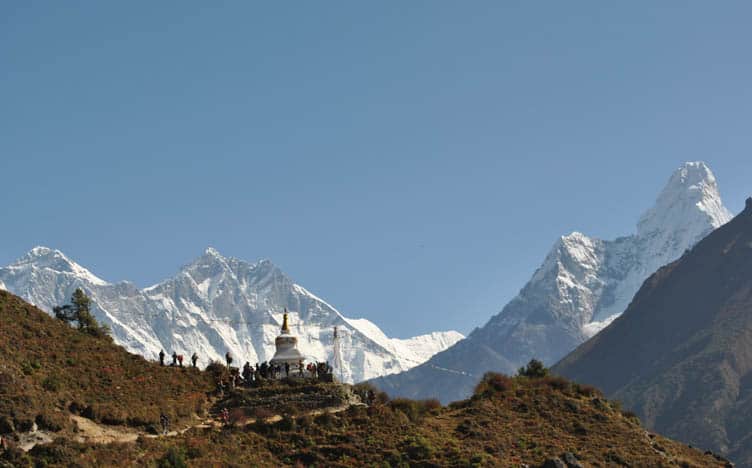
Note that, with the change in altitude the weather and temperature also varies.
Such is the condition of the Everest Base Camp trek in January.
As you start ascending to the altitudes, you will feel much colder.
The dense snow and fog may obstruct the vision.
You may feel snow storms and frequent drops in temperatures in the high altitudes.
Whether you sign up for the EBC trek in January or any other month, it’s important to be aware of the significant risk of altitude sickness that accompanies this journey.
Thus, planning and drafting a well-structured itinerary, taking necessary precautions and acquiring knowledge about preventing altitude sickness are crucial components for ensuring a successful and safe expedition.
Educating yourself about altitude sickness is of utmost importance.
Familiarize yourself with all its symptoms, grasp effective preventive measures and ensure that you’re well-equipped to handle any issues that may arise while you’re on the trail.
Should any concerns or symptoms emerge, don’t hesitate to communicate with your guide promptly.
Moreover, doing the EBC trek in January exposes you to harsh temperatures along the trail.
The colder the temperature, the more challenging it becomes to acclimate to the increasing altitude.
Therefore, it is really important that you prioritize your personal well-being throughout the journey.
Altitude sickness is not to be taken lightly; its consequences can be severe, even fatal.
Thus, maintaining a vigilant and cautious attitude towards it is imperative for your safety and the success of your adventure.
- January is a cold month and hence packing and gearing up well plays a vital role. It is very important to take care of your clothing which will determine your comfort.
- Some important things you should not miss out are windproof and waterproof jackets. They keep away the snow as well as keep you warm.
- Similarly, you need windproof and waterproof trousers as well. It keeps you warm even when the temperature goes below freezing point.
- One of the important packing essential is the toiletries and first aid box in case of emergency. For the cold weather, especially during harsh wind, you need lip balms, sunscreen lotions, winter gloves, hats, and a pair of warm socks.
- During winter, since you need more clothing, you will need a comfortable and spacious backpack. Since the EBC trek is quite long, you will require enough space to accommodate all the necessary items during the trek.
- And most importantly you will need a good pair of trekking shoes that will either make or break your trek. Since there will be snow in the trails, water and snow resistant shoes will come in great use.
- You will also need good quality sleeping bag that you can fill comfortable if temperature goes around minus 25 Degrees Celsius.
- There can be day(s), where you might have to walk over snow so make sure you got spikes for the shoes to avoid slipping on trail
- With few trekkers trekking in January, there are various benefits of trekking in this month.
- In January, the air is dry and the precipitation is very less. The skies are almost clear and cloudless offering a spectacular view.
- This is also an advantage for the flights, they don’t cancel that frequently due to the weather conditions.
- Being an off season there will be very few people on the trail. This means that you will have the path to yourself. You can enjoy the peaceful trail and spend some solitude with nature.
- During this time due to fewer people, you won’t have a problem hiring guide and porter.
- When you are one of the few travelers, the lodges and the teahouses can give you special treatment.
- Rooms will be more available and you won’t have a problem with other services like solar charging etc.
- In other months like October and November, there will be a high number of tourists, queuing up for charging. This is, not at all, a problem in January.
- Due to the few numbers of trekkers, you will get plenty of opportunities to click beautiful pictures of mountains and places.
- In January due to the risk of snow storms and harsh temperatures, the high passes like the Cho La Pass trail and Mera Peak climbing remain closed.
- Sometimes the trekkers might have to fall back as a result of blizzards and hurricane winds in other passes.
- Trekking to EBC in January i.e in winter means the days are going to be shorter. Therefore, you need to start your trek early so as to reach the lodge before darkness settles in.
- January trekking at the EBC is quite pleasant with moderate temperature during the day. However, at night it can get to a freezing point sometimes -20 to -30 degree Celsius.
- Not having proper acclimatization can lead your body to take a lot of time to adjust to the cold at higher altitude. Hence, this can make you susceptible to AMS (Acute mountain sickness).
Preparing for the Everest Base Camp trek in January requires careful packing due to the cold weather.
Ensuring that you have the right clothing for EBC is crucial for your comfort during the journey.
First and foremost, don’t forget to bring windproof and waterproof jackets.
These are essential as they not only shield you from snow but also provide warmth in the chilly conditions.
Equally important are windproof and waterproof trousers, which offer protection and insulation even when the temperature drops below freezing.
Paying attention to essential items is vital.
Pack toiletries and a first aid kit for any potential emergencies.
In the cold climate, especially when facing strong winds, remember to pack lip balms, sunscreen lotions, winter gloves, hats and a pair of warm socks to stay comfortable.
Since winter demands more clothing, opt for a comfortable and spacious backpack.
The Everest Base Camp trek spans a considerable distance, making it essential to have enough room to carry all your necessary supplies throughout the journey.
Arguably the most critical aspect is having the right pair of trekking shoes.
Your choice of footwear can significantly impact your trekking experience.
Given the presence of snow on the trails, it’s wise to invest in water and snow-resistant shoes to prevent discomfort and ensure safety.
A high-quality sleeping bag is another essential item.
Select one that offers adequate insulation, especially if temperatures might reach around minus 25 Degrees Celsius.
Lastly, consider bringing spikes for your shoes, especially for days when you might encounter snowy paths.
These spikes will provide traction and help prevent slipping on the trail.
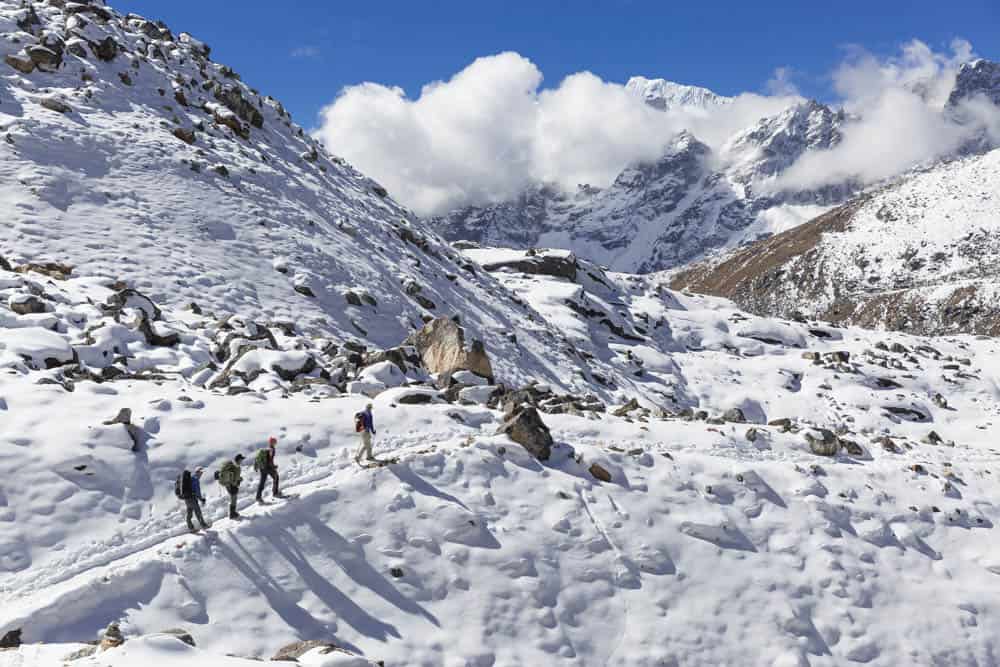
FAQs on EBC trek in January
January is one of the coldest months, with temperatures easily dropping to around minus 25 Degrees Celsius during this trek.
Yes, the tea houses remain open in the Everest Base Camp trek all year round.
Moreover, due to fewer trekkers during this time you will most likely receive better service.
Normally in peak season, there is a shortage of mattresses and blankets in the tea house.
This is not a matter of concern in January.
However, the tea house in the high altitude like Gorak Shep may remain closed due to harsh weather condition.
Besides, you will not have trouble finding tea houses in other places of the trek.
Since trekking in winter is challenging and includes risk, hiring guides are close to compulsory.
As the trekking trails to EBC are less crowded with few trekkers, it is good to hire a porter/guide for Everest Base Camp trek in January.
The trails can be tricky during winter due to snowfall.
Hence having a guide will give you both physical and mental assistance.
As for porter, it is wise to hire them. Because the trek will certainly be much easier without having to carry heavy baggage.
Any insurance you have is a good as you can never prepare fully for misfortunes.
Different insurance policies cover different items.
And, you definitely need a travel insurance for Everest Base Camp trek in January.
Some insurance policies cover only up to 3000m.
Hence, make sure you have a clause in your insurance to cover for the altitude up to 6000m.
This is because in high altitude there is a risk posed by acute mountain sickness and other altitudes related illness.
So, having insurance that covers up to 6000 m will cover you up for the entire course of the trek.
This way you will not have to worry about expensive evacuation or medical assistance.
Also, you can get insurance for incidents like accidents, flight delays, and baggage loss etc.
Ensure that you conduct thorough research and pack appropriately for the EBC Trek in January.
Given the harsh temperatures, it’s vital to have ample warm clothing, a suitable down jacket, a proper sleeping bag, and reliable waterproof hiking boots with excellent grip.
Devote sufficient time to researching a comprehensive packing list for the EBC trek .
Some Alternatives to Everest Base Camp trek in January
The Everest Base Camp trek is not only the trek that you can take in January.
There are other treks that you can consider in the Everest region:
If you want to view the Everest but do not have enough time to complete the classic EBC trek in January.
Then you can try the Everest Panorama Trek .
This trek will take 10 days and will give you amplified time to get familiar with the Everest region.
In this trek, you will come across Lukla, Phakding,
Namche Bazaar as well as Tengboche.
This short trek will offer you spectacular views of the Mt Everest, Mt Lhotse, Mt Thamserku and many more.
With this time you will get a glimpse into the Sherpa lifestyle as well as their culture.
Since trekking in January is challenging, some people may not have the physical capacity to trek to and from the EBC.
Hence Everest Base Camp Trek with Helicopter Return provides this option to trekkers who prefer to take a helicopter tour back to complete it in shorter time or to skip the descent.
With this, you can experience the Everest Base Camp trek in an easier way.
Moreover, this will take a shorter duration to complete and will be great for those who are running short on time.
If you are doubtful about the fact that you may or may not be able to acclimatize with the cold January weather.
Then Jiri to EBC trek will make sure that you do.
This is a long trek to the Everest region.
Here you will take small gains in altitude every day.
This way, there is lesser chances of altitude sickness.
This trek is possible for those who have close to 3 weeks of trekking days.
This 15-day trekking trip to Gokyo Lakes is the best alternative to the EBC Trek.
If you are someone who is looking for an incredible adventure with amazing views, then this trek is for you.
If going to EBC is not your main goal but you are seeking a trip that provides an overall great mix of culture, people, views, etc., then opt for Gokyo Lakes Trek .
There is no denying that January is cold and can be quite challenging.
It is also difficult especially for those who don’t prefer the cold season.
Yet, the cold is not so extreme that trekking becomes impossible.
With proper preparation and precaution, you can successfully complete the Everest Base Camp trek in January.
If you love peaceful trails and want a little thrill to you trekking January is the right month.
The Everest Base Camp trek in January will definitely be rewarding.
For further question and queries, please feel free to contact us .
Also, it is our pleasure to guide and assist you to the best of our ability and plan the trip for you going to EBC in January.
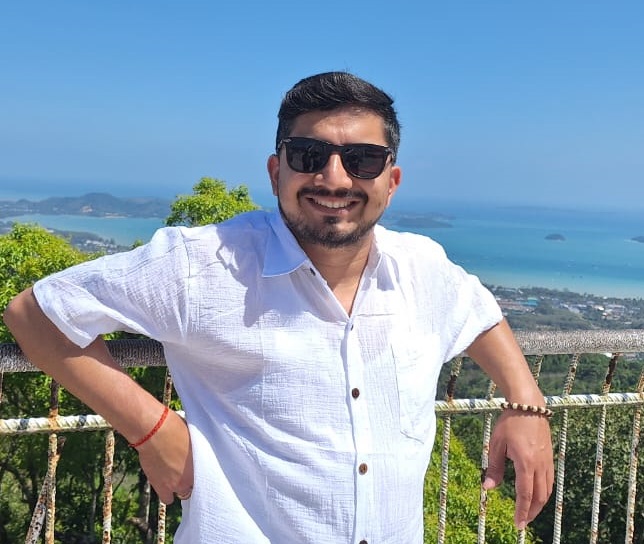
Madhav started working as a porter in 2001 and then moved on to work as a trekking guide. After working in the trekking and tourism industry for eight years, he co-founded Mosaic Adventure in 2009.
Madhav has trekked to most of the trekking destinations in Nepal, including Everest Base Camp Trek, Annapurna Base Camp, Annapurna Circuit Trek, Poon Hill Trek, Jomsom Muktinath Trek, Indigenous Peoples Trek, Langtang Valley Trek, Mardi Himal Trek, and all of the day hikes around Kathmandu.
He has also extensively traveled to other countries such as Australia, the USA, the UK, France, Hong Kong, Japan, China, the Philippines, the UAE, Saudi Arabia, Bahrain, Thailand, Turkey, and India. Madhav is the one who answers most of your questions about trekking and tours and helps to plan your trip by giving a personal touch.
You may also be interested in...
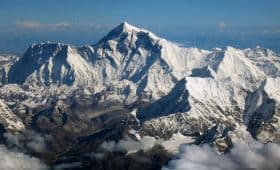
Everest Base Camp Trek Distance, Length and Elevation
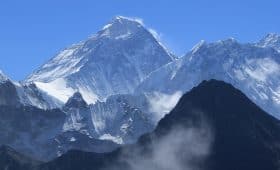
Everest Base Camp Trek in June
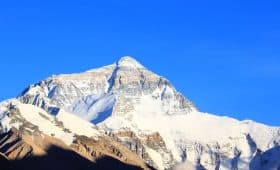
16 Days Everest Base Camp Trek Itinerary
Leave a reply cancel reply.
Your email address will not be published. Required fields are marked *
Save my name, email, and website in this browser for the next time I comment.
Mount Everest Base Camp Trek: EBC Trekking Guide For Nepal
The Mount Everest Base Camp Trek in Nepal is one of the world’s best bucket list hikes. In less than 2 weeks, you can trek to the foot of Mt Everest and other snowy peaks in the Himalayan mountains.
The good news is that it’s not a super difficult hike, and you don’t need a big budget to do it. The EBC trek is worth it for the fun and accomplishment alone, but you also get views of the Himalayas that are out of this world.
This travel guide will explain how you can do the Mt Everest Base Camp hike independently (with or without a tour guide), along with a recommended packing list and everything else you need to know before you go!
Best Everest Base Camp Tours
First of all, if you’d rather skip the hassle of planning your own EBC Trek, Klook has Everest Base Camp Tours starting as low as $900 USD for a full 12-day trek.
You may be able to find something cheaper than this once you land in Kathmandu, but booking online with a vetted tour company has some big advantages, and the reviews on their website are very positive.
We’ve used Klook for lots of tours and activities around the world, and they’re great! Highly recommended.
Book Now: Everest Base Camp Tours

When To Do The EBC Trek
The Mt Everest region has 4 different trekking seasons:
- March – May: High season. Best weather, with stable temperatures and bright sunny days, but the trails can get crowded. During these months you may share the EBC trail with pro climbers on the way to go summit Everest.
- June – August: Monsoon season. There’s a lot more rain during these months, and the trails are mostly empty.
- September – October: Clear days and busy trails. This is one of the most popular trekking seasons.
- November – February: Coldest season, but the weather is stable and dry. The trails are mostly clear.
I trekked in early February, and even though it was nice having the trail mostly to myself, the cold in the evenings and mornings was straight up misery.
My home state of Missouri can get very cold in the winter, but the cold has just never been my thing. If I could go back and change it, I would definitely do my Everest Base Camp hike later in the season.

Everest Base Camp Weather
Temperatures on the Mt Everest Base Camp Trek can range from 5 °C (40 °F) to 20 °C (70 °F) depending on month, and as low as -30 °C (-22 °F) at night during the winter months.
If you trek during the warmer months (Mar-May and Sep-Oct), the cold is not a big problem and shouldn’t be hard to cope with. Winter is a different story. Your snot will freeze in your nose at Gorak Shep.
Sunshine is key for winter trekking in Nepal, and thankfully you should have lots of sun in most months outside of the monsoon season. On my February hike, I often found myself shedding all my layers while trekking because I was heating up in the sun.
If you do your Everest Base Camp hike during the winter, the biggest issue is staying warm in the evenings and at night. For this, you’ll definitely want a top quality down jacket and sleeping bag.

All About Everest Base Camp Trekking
My everest base camp itinerary.
- Day 1: Kathmandu to Lukla to Benkar .
- Day 2: Benkar to Namche Bazaar .
- Day 3: Namche Acclimatization Day .
- Day 4: Namche to Deboche .
- Day 5: Deboche to Pangboche .
- Day 6: Pangboche to Dingboche .
- Day 7: Dingboche Acclimatization Day .
- Day 8: Dingboche to Thukla .
- Day 9: Thukla to Gorak Shep .
- Day 10: Everest Base Camp .
- Day 11: Kala Patthar to Gorak Shep to Pheriche .
- Day 12: Pheriche to Namche .
- Day 13: Namche to Lukla .

If you ever need motivation to keep going on the Everest Base Camp hike, just look at how much the porters are carrying!

Mount Pumori as seen from the Kala Patthar viewpoint, just a short distance from Mt Everest Base Camp.

Ama Dablam, one of my favorite mountains on the Mt Everest Base Camp Trek.
EBC Trek Packing List / Gear
This isn’t a complete list of everything to bring on a Mt Everest Base Camp Trek, and you may have to change things up a little depending on what month you go, but these are just some of the basics.
You can find most of this gear in Kathmandu, but in my opinion you’ll get higher quality and a wider selection if you order online.
- Beanie: I only wore this at night, but it definitely helped keep my ears warm.
- Down Jacket: Bring the biggest, warmest DJ possible. This is your most important piece of gear. You can use it as an extra cover at night.
- Fleece Sweater: This is the only jacket you’ll need to wear while trekking most days, especially if it’s sunny.
- Shirts: Something comfy with quick dry material.
- Trekking Pants: Something lightweight and breathable.
- Thermal Underwear: May not be needed if you trek in the warmer months.
- Gloves: I only wore these at night, but they definitely helped keep my hands warm.
- Socks: Merino wool is best for staying warm and stopping moisture.
- Headlight: Smart to have at least a small one, just in case.
- Tumbler: 1 liter water bottle to refill daily on the trek.
- Sunblock: It’s easy to sunburn at high altitudes. A small bottle is plenty.
- Sunglasses: Good for snow. May not be necessary unless you plan to hike a mountain pass like Cho La.
- Hat: I wore old faithful throughout the hike.
- Watch: An altimeter watch would be fun to play with here.
- Camera: Duh. You can’t do the Mt Everest Base Camp Trek without taking lots of pictures.
- Power Bank: Bring a big power bank and you might only need to recharge it once on the whole trek.

Everest Base Camp Trek Cost
For a 13 day trek, I paid about $21 USD per day for food, drinks, and room. Porter/guide was an extra $25 per day, although it’s not a requirement. Flights to Lukla were $330 return, but again not a requirement if you hike in.
You can read the sections below for more info on the daily trekking costs and what you get for your money. It’s not a very expensive trek, all things considered!
Keep in mind, these numbers are from 2020. They’ll go up a little over time. Exchange rates may also vary, so check the latest rates .

The flight to Lukla from Kathmandu is $165 USD each way. You can shop for flights to Lukla at Skyscanner.
If your budget is tight or you have extra time, you can skip this flight by hiking from Jiri to Lukla rather than flying. It only adds a couple days to the itinerary.

Guide / Porter / Solo
You can do the EBC trek with a guide, porter, OR independently (solo).
A guide will show you the way to Mt Everest Base Camp and help with lodging, navigation, advice, taking pictures for you, etc. A porter-guide will do these same things and also carry a 20 kg (45 lb) pack for you.
A porter or guide is NOT a requirement to do this hike, especially if you go in the warmer months when you may not need as much gear. In 2023, they were supposedly introducing a guide requirement for EBC, but so far that has not been enforced at all, thankfully.
With that said, there are some good advantages to hiring a guide, and it’s pretty cheap by Western standards. A porter is only $15 or $20 USD per day, and a porter-guide is $25 per day. A popular arrangement is to hire one porter for two hikers, splitting the cost and still making things easier for both of you.
In the end, this all depends on your budget and hiking preferences.

Hiking Fees
If you’re hiking EBC independently, you’ll need to be aware of two fees you have to pay near the start of the trek.
There’s a local government tax that they’ve now started collecting in Lukla. This one is currently 2,000 Rupees ($17 USD).
There’s also an Everest park fee/ticket you have to pay at the Sagarmatha National Park entrance just beyond the small village of Monjo, Nepal. This one is currently 3,500 Rupees ($30 USD).
No TIMS card is needed anymore for independent hikers. That fee has been retired for the Mount Everest Base Camp Trek.

Accommodation & Amenities
Throughout the Everest Base Camp hike, you’ll stay and sleep at small guesthouses along the way, called teahouses.
This is where you get your meals and drinks for the trek, along with the occasional amenities like showers, charging, or WiFi. The teahouses start out decent, but quickly get more shabby as you go further up the trail.
You have to pay for everything you use, of course, and the prices get quite high as you go, because everything has to be hauled up on the backs of the poor porters.

Guesthouses
The teahouses on the EBC trek are cold and dingy, with drop toilets and cracks in the walls. Don’t expect luxury.
Most rooms are free as long as you buy your meals there (the meals are how they make their money). If you stay at a lodge and don’t eat there, you’ll be expected to pay for the room.
In some cases, I was charged 500 Rupees for a room on top of my meal costs. I’m not sure why some teahouses do this and others don’t, but I never paid more than 500 Rupees for a room, and most were free with the meals.

Food & Drink
I’m happy to report that the food and drinks on the Everest Base Camp hike are top notch, especially after you’ve worked up an appetite trekking.
You have western food choices, or the standard local staples like veggie fried rice, steamed momos (dumplings), and mushroom soup. Everything was hot and fresh. Meal prices for these ranged from 250 to 750 Rupees depending on altitude. Not too bad.
For drinks I tried hot chocolate, lemon/apple/mint tea, and occasionally bottled water for my tumbler. These ranged from 100 to 400 Rupees. If you want to avoid plastic bottles, there’s usually boiled water available and this is safe to drink too.
Getting enough water on the trek is never a problem. Just fill up a 1 liter tumbler in the morning, and this will last you until evening, especially since you’re likely to pass more tea houses along the trail as you’re hiking throughout the day.

Showers are only available at a few lodges, depending on the season and how high up you are, and they cost 600 to 1200 Rupees. In the winter, water higher up will be frozen most of the time.
I never had a shower on my February EBC trek, and that seems to be the norm (although I got one or two opportunities in Namche). Yes, it’s gross. I could smell myself by trek’s end, and it wasn’t pretty.
But aside from the fact that I hate to fork out money for something as basic as a shower, I also never really got close to other people for very long on the trek, so I didn’t feel too guilty about it.
Most days were cold enough that the thought of stripping down for a shower was not really appealing, either. Your best bet is baby wipes and deodorant.

WiFi / Cell Service
WiFi costs anywhere from $5 to $10 USD per day if you buy it from the teahouses.
Alternatively, you can buy a 10 GB/30 Day Everest Link WiFi card in Namche Bazaar and use this for the entire EBC trek. During my Mount Everest Base Camp Trek the WiFi was down across the whole region, so unfortunately I wasn’t able to use either of these options.
I bought an Ncell local SIM card in the Kathmandu airport and had 3G service for half the days of the Everest Base Camp hike. Coverage is still improving in the area, so if you need to stay connected I’d definitely bring a local SIM.

Electricity
All of the teahouses on the way to Mt Everest Base Camp sell outlet charging for electronics, and the prices range from $2 to $10 USD for a full charge, depending on how far up the trail you are.
The key is to bring a big power bank and then use this to charge all of your other electronics (phone, camera, etc). I did this and only paid once to recharge my power bank on the whole trek.

How Much Cash To Bring
Everything you buy during the Everest Base Camp hike (meals, WiFi, charging, etc) will have to be paid for with cash. Credit cards won’t work. There are no ATMs outside of Lukla and Namche Bazaar (Days 1-4), and even the ATMs there are not reliable.
What this means is that you’ll have to withdraw enough cash (Nepalese Rupees) at an ATM in Kathmandu to cover your entire trek. The ATM fees will bite you, and I hate to carry large amounts of cash, but it’s not really avoidable here.
All up, I spent about $20 USD (2,400 Rupees) per day on the Mount Everest Base Camp Trek, and never spent more than $25 USD in a single day. With that said, I didn’t splurge on WiFi, showers, charging, or alcohol. The only things I bought were the bare necessities: room, food, and drinks.
If you hire a porter/guide, you don’t need to factor that into your daily cash carry. That’s paid before the trek starts. But do reserve a little cash for a decent tip.

Mount Everest Base Camp Trek Difficulty
I’m not going to lie, this is a difficult trek. And if you do it in the winter like I did, it’s even harder. With that said, if you are in decent shape, determined, and obey the guidelines for altitude sickness prevention (more on that below), then you’ll have no problem reaching base camp.
There is a lot of elevation gain and loss on this hike. At times near Lukla, the constant ups and downs will make you feel like you’re hiking a roller coaster, but the trail is never too steep or dangerous. After Namche, it’s mostly a slow uphill plod.
This trek has been completed by old seasoned hikers in their 70s, and young kids in their pre-teens. It’s also been flunked by healthy 20-30 somethings who try to push through it quickly without enough acclimatization to altitude.
Patience and discipline are key for trekking to Everest Base Camp. Slow and steady wins the race here.

Trekking Distance
The one way trekking distance from Lukla to Mt Everest Base Camp is about 65 kilometers (40 miles).
That means the total roundtrip distance of an EBC Trek is about 130 kilometers, even if you don’t do any of the detours.
Don’t let that scare you off. It’s a lot of hiking, but every step is worth it.

Altitude Sickness
By far your biggest danger on the Mount Everest Base Camp Trek is altitude sickness, also known as Acute Mountain Sickness (AMS).
No one is immune to this, and it doesn’t matter how fit you are. If you gain altitude too fast, you can get sick and in some cases even die. Plenty of people have died from AMS on the EBC Trek.
The problem is that overzealous hikers push the envelope on this hike all the time, and a lot of them end up needing a very expensive helicopter evacuation to lower ground.
The best way to avoid altitude sickness is to go slow . At altitudes above 3,000 meters (10,000 feet), don’t increase your sleeping elevation by more than 300-500 meters (1,000-1,500 feet) per night.
Every 1,000 meters (3,000 feet) you should also spend a second night at the same elevation. If you get a bad headache, dizziness, or nausea, descend to a lower altitude until you feel better. As long as you follow these general guidelines, you shouldn’t have any issues.
You can take Diamox (acetazolamide) on the trek for extra AMS prevention. This medication can be found in Kathmandu or Namche. I bought mine in Namche and it seemed to help my headache and slight foggy feeling. I didn’t have any side effects aside from the usual tingling toes/fingers.

Everest Base Camp Altitude
The Mount Everest Base Camp altitude is 5,364 meters (17,598 feet). At this elevation, there is 50% of the oxygen at sea level.
However, most treks also go to Kala Patthar, a viewpoint even higher than base camp where you can get the best views of Mount Everest.
The elevation at Kala Patthar is 5,644 meters (18,519 feet). From there, you’ll be rewarded with an incredible panorama of Mount Everest and other icy peaks like Pumori, Lhotse, and Nuptse.
Happy travels!

If you’d rather skip the hassle of planning your own EBC Trek, Klook has Everest Base Camp Tours starting as low as $900 USD for a full 12-day trek.
You may be able to find something cheaper than this once you land in Kathmandu, but booking online with a vetted tour company has some big advantages, and the reviews on their website are very positive for this Mt Everest Base Camp tour.
More Nepal Travel Tips
Hopefully you were helped by this guide for the Everest Base Camp Trek. Let me know in the comments below if I can help answer any questions.
Don’t forget to check out my complete Nepal Travel Guide with tips, info, photos & more!
You may also like
Dhigurah island travel guide for maldives, 10 best hikes in aruba: family friendly trails, how to visit tanjung puting national park in indonesia, banggai islands travel guide & itinerary for sulawesi indonesia, paisu pok lake in banggai: bluest lake in indonesia, samet nangshe viewpoint: best sunrise spot in thailand.
So much useful detailed information.
Thanks for the straight forward information. Beautiful photos

Leave a Comment Cancel Reply
Save my name, email, and website in this browser for the next time I comment.

EVEREST BASE CAMP TREK

EVEREST BASE CAMP

Pin Tweet Share WhatsApp
THE ESSENTIAL GUIDE
In this guide we cover everything you need to know about the Everest Base Camp Trek in Nepal. This includes suggested itineraries and practical information about accommodation, costs, what to pack, independent vs. guided treks, transport, and more. We also offer a route map with GPX download for use on the trek. And along with this written guide, we also share ‘silent hiking’ films that work well as a visual guide to the trail.
A chance for an adventurous and exciting journey, the Everest Base Camp Trek serves up spectacular scenery and gets you close to the world’s highest mountains, and as one of Nepal’s best known treks, it attracts people of all ages and experience levels. The trek ascends to high altitude (5000 m +) and is challenging, but it is achievable with a sensible itinerary that includes proper acclimatisation. Read on to discover more and start planning your own EBC trek.
Use the drop down menu below to jump to each section of this guide
TABLE OF CONTENTS
EVEREST BASE CAMP TREK OVERVIEW
EBC TREK FILMS
EVEREST BASE CAMP MAP & GPX DOWNLOAD
ELEVATION PROFILE & 3D ROUTE MAP
EVEREST BASE CAMP ITINERARIES
- THE CLASSIC EBC TREK
- EBC TREK VIA KHUMJUNG & PHORTSE
- EBC VIA KONGMA LA (5514 m)
- EBC AND GOKYO LAKES TREK
- BUFFER DAYS
EVEREST BASE CAMP TREK SUMMARY
- LULKA TO NAMCHE BAZAAR
- NAMCHE ACCLIMATISATION DAY
NAMCHE BAZAAR TO DINGBOCHE
- ALT. ROUTE VIA KHUMJUNG & PHORTSE
DINGBOCHE ACCLIMATISATION DAY
Dingboche to everest base camp.
- ALT. ROUTE VIA KONGMA LA
EVEREST BASE CAMP TO LUKLA
- ALT. ROUTE VIA CHO LA & GOKYO LAKES
BEST TREKKING SEASONS
HOW TO GET TO LUKLA
HOW TO GET TO LUKLA WITHOUT FLYING
EVEREST BASE CAMP TREK PERMITS & FEES
TREKKING INDEPENDENTLY
TREKKING WITH A GUIDE (& PORTER)
RECOMMENDED TREKKING AGENCY
ACCOMMODATION ON THE EBC TREK
FOOD ON THE EVEREST BASE CAMP TREK
SAFE DRINKING WATER
WIFI, PHONE SIGNAL & CHARGING
EVEREST BASE CAMP TREK COST & BUDGET
MONEY & ATMs ON THE EBC TREK
WHAT TO PACK FOR THE EBC TREK
ALTITUDE AWARENESS & AMS
TRAVEL INSURANCE
GETTING TO NEPAL
NEPAL TOURIST VISAS
Nepal visa on arrival process.
WHERE TO STAY IN KATHMANDU
BUDGET KATHMANDU ACCOMMODATION
Mid-range kathmandu accommodation, high-end kathmandu accommodation.
MAPS, GUIDEBOOKS & APPS
*Some of the links in this post are affiliate links – if you purchase a product or service via these links, we may earn a small commission at no extra cost to you . This helps offset the cost of running this blog and keeps us travelling so that we can continue to produce great content for you. As an Amazon Associate, we earn from qualifying purchases. We greatly appreciate your support!*
- DISTANCE | 120 -143 km depending on route taken (incl. acclimatisation/day hikes)
- DURATION | 12 – 15 days depending on route (incl. flying to/from Lukla)
- START/END | Lukla
- PERMITS REQUIRED | Khumbu Trek Card 2000 NPR; Sagarmatha National Park Fee 3000 NPR (SAARC nationals 1500 NPR / Nepali nationals 100 NPR)
- TREKKING SEASON | Best Seasons: April to Mid-May , October to Mid-November ; Shoulder Seasons: March, Late May, September, Mid-November to December ; Avoid: June to August, January to February
- TREK DIFFICULTY | Moderate (challenging if including Kongma La or Gokyo Lakes)
- ELEVATION GAIN/LOSS | +/- approx 7600 metres (Classic EBC Trek incl. acclimatisation/day hikes)
- MAX ALTITUDE | 5611 m (Kala Patthar)
- GUIDE MANDATORY? | Khumbu Pasanglhamu Rural Municipality has stated that it is NOT mandatory to trek with a guide in the Khumbu region
- ACCOMMODATION | Teahouses/Guesthouses in villages along the trail
- TREK COST | $35 – $144 USD per person, per day (budget independent trekker to fully inclusive package)
- RECOMMENDED TREKKING AGENCY | Himalayan Masters , Quote HOGG5 for 5% discount
DISTANCE 120 -143 km depending on route taken (incl. acclimatisation/day hikes)
DURATION 12 – 15 days depending on route taken (incl. flying to/from Lukla)
START/END Lukla
PERMITS REQUIRED Khumbu Trek Card 2000 NPR Sagarmatha National Park Fee 3000 NPR (SAARC nationals 1500 NPR, Nepali nationals 100 NPR)
TREKKING SEASON Best Season April to Mid-May October to Mid-November Shoulder Seasons March, Late May, September Mid-November to December Months To Avoid June, July, August January and February
TREK DIFFICULTY Moderate (challenging if including Kongma La or Gokyo Lakes)
ELEVATION GAIN/LOSS +/- approx 7600 metres (Classic EBC Trek incl. acclimatisation/day hikes)
MAX ALTITUDE 5611 m (Kala Patthar)
GUIDE MANDATORY? Khumbu Pasanglhamu Rural Municipality has stated that it is NOT mandatory to trek with a guide in the Khumbu region
ACCOMMODATION Teahouses/Guesthouses in villages along the trail
TREK COST $35 – $145 USD per person, per day (budget independent trekker to fully inclusive package)
OUR RECOMMENDED TREKKING AGENCY Himalayan Masters , Quote HOGG5 for 5% discount
EVEREST BASE CAMP TREKKING FILMS
Get a sense of the Everest Base Camp trekking route in our ‘silent hiking’ style ambient films.
EVEREST BASE CAMP TREK MAP & GPX DOWNLOAD
MAP & GPX DOWNLOAD
We have created a detailed Everest Base Camp trekking map to accompany this guide. It shows the Classic Everest Base Camp trekking route along with the alternative routes outlined in this guide, going via Khumjung and Phorste, Kongma La, and Cho La and Gokyo Lakes. The main side/acclimatisation hike options are included too, and the overland route between Salleri and Lukla is also marked.
Detailed stats and an elevation profile are included for each route section. Guesthouse settlements and tea shops are also marked, as well as key sights and practical info such as checkpoints, hospitals, and transport hubs. Guesthouses as per our own trek itinerary are marked, including info about prices and services, phone numbers (where possible), and a copy of the menu. Photos are included with almost every pin.
You can use the digital map online, or download it for offline use with a mapping app such as Organic Maps, Maps.me or Gaia GPS. This is very helpful for navigation assistance on the trail. It allows you to quickly pinpoint key places and services along the way and calculate distances and elevation differences between destinations.
Note that while we’ve tried to be as accurate as possible when recording and mapping the route, changes on the ground are inevitable (especially on routes crossing glaciers) and this map should not be solely relied upon for navigation.
EVEREST BASE CAMP TREK ELEVATION PROFILE
ELEVATION PROFILE
The image below shows the elevation profile of the Classic Everest Base Camp trek, starting and ending in Lukla. The route shown here includes the various acclimatisation and side hikes as outlined in the suggested itinerary below. Elevation is displayed in metres and distance in kilometres.

3D ROUTE MAP
Watch our 3D relief map video to visualise the landscape and get a sense of the Everest Base Camp trek.
EVEREST BASE CAMP TREK ITINERARY
ITINERARY OPTIONS
There is more than one trekking route to Everest Base Camp . In this section we outline the Classic EBC trek itinerary, but also include three alternative itineraries which enable you to vary your route on the way to and from Base Camp and see much more of the Khumbu region.
We have created an overview table for each of the Everest Base Camp trek itinerary options. These include trekking distances and approximate trekking times for each day (excluding lunch stops, breaks, etc), as well as stats on elevation gain/loss and sleeping altitude. For each itinerary the assumption is that you will fly into Lukla on the morning of Day 1 and start trekking. You will need to add 3 – 5 days if you plan to travel overland from Kathmandu to Lukla or vice versa.
It is also possible to combine the following itineraries to create your own alternative EBC trek. For example, you could trek via Khumjung, Phortse and Kongma La on the way to EBC, or you could include both Kongma La and Gokyo Lakes. A few minor possible alternatives along the way are noted below each itinerary, such as alternate overnight stops.
If viewing the itinerary tables on a mobile device or tablet, scroll to the right to see the full table or flip your screen to landscape mode
CLASSIC EVEREST BASE CAMP TREK ITINERARY
A classic Everest Base Camp trek itinerary is 11 nights/12 days, following the exact same route on the way to and from EBC. If you have limited time, this is the shortest itinerary you can follow while sticking to safe altitude ascent rates.
DAY 1 ALT. INFO*
*Alternatively, continue to Monjo (2830 m) where fewer people stay overnight (a further 5.1 km, approx 2 hours trekking time) . Doing this means the trail will be less busy for both your Phakding to Monjo section, and the Monjo to Namche section the following morning.
DAY 4 ALT. INFO**
**Alternatively, continue to Pangboche (3950 m) where fewer people stay overnight (a further 4.2 km, approx 1.5 hours trekking time). Pangboche is a lovely village with fantastic views of Ama Dablam, and there are many guesthouses. Tengboche, on the other hand, only has two guesthouses and it can be difficult to get a room here in peak season. Continuing to Pangboche also means the trail will be less busy for both your Tengboche to Pangboche section, and the Pangboche to Dingboche section the following morning.
DAYS 8 & 9 ALT. INFO***
***On days 8 and 9 the classic itinerary that most people follow is to visit EBC after lunch at Gorak Shep, then hike up Kala Patthar in the dark for sunrise the next morning (when it is bitterly cold). If you swap these two around as per the above suggested itinerary, you are guaranteed to have a less busy experience at both EBC and on the trail up Kala Patthar. As the skies are usually clearer in the morning you are also likely to have better views at EBC, however it is possible that the views from Kala Patthar will be obscured by afternoon clouds. If you’re lucky and have clear afternoon skies, then you will be treated to a fiery sunset glow on Everest and the surrounding mountains. If you hike up Kala Patthar in the morning, your mountain views will be brief as the sun rises directly behind Everest and you’ll soon be looking directly into the sun.
ALTERNATIVE EVEREST BASE CAMP TREK ITINERARY VIA KHUMJUNG AND PHORTSE
Our first alternative Everest Base Camp trek itinerary is 12 nights/13 days. This itinerary follows a different route between Namche Bazaar and Pangboche on the way to EBC, by trekking via Khumjung and Phortse. The overall difficulty of this route remains moderate, and the additional day allows you to explore more of the region and gives more time for acclimatisation. It’s also a great option for avoiding crowds during the peak trekking seasons, as far fewer people trek this alternative route.
DAYS 9 & 10 ALT. INFO**
**On days 8 and 9 the classic itinerary that most people follow is to visit EBC after lunch at Gorak Shep, then hike up Kala Patthar in the dark for sunrise the next morning (when it is bitterly cold). If you swap these two around as per the above suggested itinerary, you are guaranteed to have a less busy experience at both EBC and on the trail up Kala Patthar. As the skies are usually clearer in the morning you are also likely to have better views at EBC, however it is possible that the views from Kala Patthar will be obscured by afternoon clouds. If you’re lucky and have clear afternoon skies, then you will be treated to a fiery sunset glow on Everest and the surrounding mountains. If you hike up Kala Patthar in the morning, your mountain views will be brief as the sun rises directly behind Everest and you’ll soon be looking directly into the sun.
EVEREST BASE CAMP VIA KONGMA LA TREK ITINERARY
Our second alternative Everest Base Camp trek itinerary is 13 nights/14 days. This changes the route taken between Dingboche and Lobuche on the way to EBC by crossing a high pass called Kongma La (5514 m). This section is more challenging than the rest of the route, but it offers incredible scenery and the chance to explore much quieter sections of trail than you’ll experience on the classic EBC route.
DAY 8 ALT. INFO**
***There are two viewpoints on the Chukhung Ri acclimatisation hike, the lower one (5380 m) which most people visit and the higher one (5516 m) which involves a tough and steep climb towards the end.
DAYS 10 & 11 ALT. INFO****
****On days 8 and 9 the classic itinerary that most people follow is to visit EBC after lunch at Gorak Shep, then hike up Kala Patthar in the dark for sunrise the next morning (when it is bitterly cold). If you swap these two around as per the above suggested itinerary, you are guaranteed to have a less busy experience at both EBC and on the trail up Kala Patthar. As the skies are usually clearer in the morning you are also likely to have better views at EBC, however it is possible that the views from Kala Patthar will be obscured by afternoon clouds. If you’re lucky and have clear afternoon skies, then you will be treated to a fiery sunset glow on Everest and the surrounding mountains. If you hike up Kala Patthar in the morning, your mountain views will be brief as the sun rises directly behind Everest and you’ll soon be looking directly into the sun.
EVEREST BASE CAMP AND GOKYO LAKES TREK ITINERARY
Our third alternative Everest Base Camp trek itinerary is 14 nights/15 days. This varies the route taken between Lobuche and Namche Bazaar on the way back from EBC, by crossing a high pass called Cho La (5368 m) and descending via the spectacular Gokyo Lakes. Again, this route is more challenging than the classic or first alternative EBC itineraries we suggest, due to the extra distance and overall elevation gain. However, it is a highly rewarding trek which includes some of the most spectacular locations in the Khumbu region. The sections of trail that you must repeat on the way to and from EBC are kept to an absolute minimum on this itinerary.
IMPORTANCE OF BUFFER DAYS
Building in buffer days to your Everest Base Camp itinerary is highly recommended, especially if you plan on flying to/from Lukla. Flights are regularly cancelled due to poor weather conditions, sometimes for a number of days. If everything runs smoothly, it takes half a day or less to get to/from Lukla at the start/end of your trek. However, if flights are not operating, it can take up to 3 days to travel overland from Kathmandu to Lukla, using a mixture of buses and jeeps, and by trekking too. Therefore, it’s wise to have at least 3 or 4 days between the end of your planned trek itinerary and any international flight. This would allow you time to get from Lukla to Kathmandu overland if necessary.
Of course, a delay could also happen at the start of your trek while trying to get to Lukla, and this might leave you struggling to catch up with your original itinerary. Having a couple of buffer days built in will mean you don’t have to drastically alter your itinerary, avoiding the need to walk extra long distances to save a day or skipping places because you don’t have time.
Buffer days also allow you to alter your itinerary on the go more easily. For example, if you get sick and need to spend an extra night somewhere, or the weather is bad and you want to wait it out before continuing your trek, then you have the extra days on hand.
It’s worth knowing that should everything go to plan and you don’t need to use any buffer days during your trek, it’s straightforward for a trekking agency to change the date of your flight, bringing it forward a few days for example. However, this is not so easy if you have booked your flight online, independently.
OUR RECOMMENDED TREKKING AGENCY
We partnered with Himalayan Masters for our Langtang Valley, Gosainkunda, EBC and Everest Three Passes treks, and found them to be professional and committed to a high level of service
To enquire about booking your own trek, get in touch via email at [email protected] and mention the code HOGG5 to get a 5% discount off the cost of your trip
ROUTE SUMMARY
LUKLA TO NAMCHE BAZAAR
The first two days of the Everest Base Camp trek are repeated in reverse on the final day of the trek. With only one route connecting Lukla and Namche Bazaar, unfortunately there’s no avoiding this.
This section of the trek passes through numerous villages and teahouse settlements, the last of which is Jorsale, shortly beyond the entrance to Sagarmatha National Park. There are five suspension bridges to cross, including the 125 metre high Hillary Bridge, and numerous smaller fixed metal bridges. The Khumbu Trek Card Registration desk (where you get your Khumbu Trek Card and pay your Sagarmatha NP entrance fee) is shortly beyond Lukla, and there are further checkpoints at Toc Toc, Monjo, and just before Namche Bazaar.
The route follows a mixture of wide stone paths, riverside paths, and forest trail, with plenty of up and down along the way. There is one notable ascent, a 700 metre climb immediately after crossing the Hillary Suspension Bridge, on the last stretch before Namche. This section is a pleasant couple of days and a good introduction to the trek, with greenery and the chance to see colourful rhododendrons and blossoms in spring, plenty of scenic river views, and a definite buzz thanks to all the people coming and going and the numerous villages dotting the trail.
With only one route up and down to Namche, traffic jams are common along this section, with trekkers, porters, and pack mules, yaks and their handlers all sharing the same trail. Bottlenecks are particularly common at suspension bridges and on the steep climb up to Namche. Be sure to wait on the side of the trail without a drop-off when letting pack animals pass, and don’t start crossing a bridge if you can see them coming in the opposite direction – let them cross first. Finally, stick to the left side when walking by any mani stones, mani walls and prayer wheels, as it’s both common practice and culturally appropriate.
For more detail about this section of the route, see Days 1 and 2 of our Everest Three Passes Route Guide .

The Hillary Suspension Bridge as seen from the valley floor, with the old bridge still in place below

NAMCHE BAZAAR ACCLIMATISATION DAY
It’s important to acclimatise properly throughout your Everest Base Camp trek. This allows your body time to get used to the ever-increasing altitude as you ascend to 5000 metres and above. Building in rest days, staying well hydrated, and going on acclimatisation hikes (where you climb higher during the day but sleep lower at night) are all good ways of helping your body acclimatise.
Unless you are already acclimatised (for example you have been at altitudes of 4000 metres and higher within the previous week), spending a second night at Namche Bazaar is highly recommended and this is standard on virtually all Everest Base Camp trek itineraries. You should do this even if it seems like you feel physically fine.
The most common destination for an acclimatisation hike from Namche Bazaar is the Hotel Everest View (3880 m) , where you can get lunch or a drink and enjoy fantastic views from the terrace. It takes around 3 hours to hike up to the hotel and back down again. A must-visit on the way is Sagarmatha Next , a learning / experience / visitor centre and gallery championing waste management solutions for the Khumbu region.

Morning view over Namche Bazaar from the northeast

Morning view of Namche Bazaar from the northeast
For a longer hike and the chance to see more of the local area, doing a loop via Khumjung is a great option. Khumjung is the largest Sherpa village in the region, with an impressive monastery and a school founded by Edmund Hillary in 1960. The original classroom is now the Sir Edmund Hillary Visitor Centre , another great place to visit and learn about the Khumbu region. The loop hike (including Hotel Everest View) is around 7.5 km, and you should allow up to 5 hours for the hike. It’s also possible to include a visit to Khunde village, home to another monastery. This would extend the loop route to around 9.1 km and you should allow up to 6 hours.
If you plan to overnight at Khumjung on day 4 of your trek, following the ‘Alternative Everest Base Camp Itinerary’ outlined above, you might want to opt for a shorter Namche acclimatisation hike. Hiking 100 metres up to the helipad on the western side of the village is a good choice. There is an excellent view over Namche from here, where you can see it curving around the sloping hillside in amphitheatre-like fashion.
Various Namche acclimatisation hiking routes are marked on our EBC Trek map .
CLASSIC ROUTE VIA TENGBOCHE
This two-day section of the Everest Base Camp trek offers fantastic mountain scenery and a beautiful trekking trail, passing through forest and open hillside. There is one notable big climb between Phunki Thanga and Tengboche but otherwise the trail is mostly straightforward, with just a few short steep sections, and plenty of flat, undulating, or gentle climbs. There are a handful of small villages along the route, two suspension bridges, a checkpoint at Phunki Thanga, and an impressive monastery at Tengboche which is well worth visiting (daily 7am – 8am, 9am – 11am, and 1pm – 5:30pm, monks chanting at 3pm). After Pangboche you are more or less above the treeline, surrounded by imposing mountains and expansive views.
For more detail about this section of the route, see Days 4 and 5 of our Everest Three Passes Route Guide .

Trekkers pass through Shomare on the way to Dingboche, with the twin peaks of Ama Dablam rising behind

Trekkers pass through the village of Shomare on the way to Dingboche, with the twin peaks of Ama Dablam rising behind
ALTERNATIVE ROUTE VIA KHUMJUNG AND PHORTSE
This three-day route section follows an alternative trail between Namche and Pangboche before joining the classic Everest Base Camp trail for the final stretch to Dingboche. Opting for this itinerary allows you to vary your route on the way to and from EBC and take advantage of much quieter trails. Plus, the extra day allows for a slower ascent pace, which is a good option for anyone who knows they are slow to acclimatise or prefers to follow a more cautious itinerary.
This route climbs initially to Khumjung, the largest Sherpa village in the region, then stays above the ‘Classic EBC’ route to Pangboche, offering fantastic views throughout. There is a small guesthouse settlement at Mong La (3970 m) which is the highest point on the way to Phortse, a scenic village with a number of guesthouses, local homes, and the Khumbu Climbing Centre .
There is plenty of up and down on this section of the trek, with some notable climbs to Khumjung, Mong La, and both before and after Phortse. However, this route is not considerably more challenging than the ‘Classic EBC’ route, especially as it is split over three days instead of two.
Spending two nights at Dingboche, a sizeable village situated at 4300 m, is advisable in order to ensure you ascend to very high altitude at a safe rate. Going on an acclimatisation hike is also an important part of acclimatising to such altitudes, and Nangkartshang Peak (5039 m) is a great option. This hill rises to the north of Dingboche and there are fantastic views throughout the climb, especially of Ama Dablam. There is an obvious path all the way to the rocky top, which is festooned with prayer flags and spacious enough for plenty of people. The 766 metre climb should take around 2.5 – 3 hours, with the descent about half that. It’s advisable to start early (around 7:30am) for the best chance of clear views and calm conditions.

After a 760 metre climb, people rest and enjoy the views at the prayer flags on Nangkartshang

For a longer and less busy acclimatisation hike, a great option is the side hike up the valley to the east of Dingboche to Chukhung Village and Chukhung Ri, a viewpoint situated at 5380 m. The views from Chukhung Ri are fantastic, looking back down the valley and across to an impressive ice wall, and you’ll be surrounded by numerous majestic snowy peaks including Lhotse, Nuptse, Island Peak and Ama Dablam. Allow up to 8 hours for this return hike.

Plenty of outstanding views to appreciate while hiking up to Chukhung Ri

Plenty of outstanding views to stop and appreciate while hiking up to Chukhung Ri
Whichever acclimatisation hike you decide to do, ensure you have plenty of water, snacks, and warm layers with you.
For more detail about these hikes, see Day 6 (Nangkartshang) and Day 8 (Chukhung Ri) of our Three Passes Route Guide.
CLASSIC ROUTE
If you’re following the Classic EBC route you’ll trek from Dingboche to Base Camp over 2 – 2.5 days, spending a night at Lobuche and then at Gorak Shep. From Gorak Shep you’ll do a return hike to EBC. Most people also include a side hike to Kala Patthar, the highest point of the trek at 5611 m, where you can get a view of Mt Everest (which isn’t actually visible from Base Camp.)
The route heads up the valley to the northwest of Dingboche, climbs to Thok La pass, then heads northeast, running parallel to the Khumbu Glacier all the way to Base Camp. It’s a gradual ascent for most of the way, but at these altitudes (4300 m – 5300 m) even a gentle climb can take your breath away. The climb to Thok La on the way to Lobuche, the short but steep climb on the way to Gorak Shep, and the undulating rocky glacier section immediately before Gorak Shep are among the most challenging sections.
The views are wonderful throughout and the final sight of Everest Base Camp, encircled by soaring peaks, is a memorable one. This is especially true if you’re trekking during the peak climbing season, when a sea of tents sprawls across the glacier at the foot of the Khumbu Icefall – seen from the trail, these tiny yellow dots emphasise the enormity of the surroundings even more.

First sight of Everest Base Camp from the trail

Posing for the obligatory photo on the ‘EBC Rock’
Seen from the Kala Patthar trail about 30 minutes before sunset , the clouds part to reveal the summit of Mount Everest (8849 m)
Lobuche is a small settlement of guesthouses on the edge of the Khumbu Glacier, a very busy spot where everyone going to and from EBC stops for food and/or spends the night. Gorak Shep is even smaller, busier, and more basic with just four guesthouses and no good water supply.
For more detail about this section of the route, see Days 10 and 11 of our Everest Three Passes Route Guide .
ALTERNATIVE ROUTE VIA KONGMA LA
This alternative route to Everest Base Camp is a three day trek between Dingboche and Lobuche, via Chukhung, Chukhung Ri and Kongma La. At Lobuche you rejoin the classic route for the final section to Gorak Shep, Kala Patthar and EBC. This is part of the Everest Three Passes trek and is a challenging but very rewarding addition to the EBC trek. With far fewer people trekking this route compared to the Classic EBC route, you can expect the trail to be much quieter.
The route follows a gently ascending trail up the scenic valley to the northeast of Dingboche before reaching the small guesthouse settlement of Chukhung. It’s advisable to spend two nights here, using the extra day for an acclimatisation hike to the spectacular viewpoint of Chukhung Ri (5380 m) before crossing Kongma La the following day. The scenery around the village is very dramatic, as are the views seen throughout the hike to Chukhung Ri, with Ama Dablam rising to the south, Island Peak to the east, and Lhotse and Nuptse to the north, along with countless other peaks and the dramatic ice wall of the Chukhung Glacier.
The trek to Kongma La (5514 m) involves a long ascent but other than a couple of short steep sections, it’s mostly a steady climb, and the landscape is striking. From the pass you have incredible 360 degree views and you can see all the way down to Lobuche, a small cluster of buildings on the far side of the rocky Khumbu Glacier. The descent is somewhat steep and slippery at first due to loose dirt, shale, and small rocks, but becomes less steep as you work your way down to the eastern side of the glacier. The final section, crossing the glacier itself, involves plenty of up and down as you work your way across jumbled rocks and around small glacial lakes; on the other side, a final downhill stretch leads to Lobuche.
For more detail about this section of the route, see Days 7 – 9 of our Everest Three Passes Route Guide .

On the final approach to Kongma La

The Classic Everest Base Camp trekking route follows the same trail on the return to Namche Bazaar, covering the distance in three days with overnights at Pheriche, Namche, and Lukla. As you drop in altitude more oxygen flows through your blood and the physical strain on your body reduces. This combined with the fact that you no longer need to think about acclimatisation enables you to cover a much greater daily distance than on previous days. The return section of the trek is not all downhill however, and three 17 – 19 km days in a row can be very tiring!
ALTERNATIVE ROUTE VIA CHO LA AND GOKYO LAKES
An alternative route connects Lobuche and Namche Bazaar via Cho La and Gokyo Lakes. This turns your trek into a loop hike commonly known as the Everest Base Camp and Gokyo Lakes trek. Following this route over six days, you’ll cross Cho La (5368 m), a high pass to the west of Lobuche, descend from the pass and traverse the rocky Ngozumpa Glacier to reach Gokyo and a string of brilliant blue lakes, then follow the Gokyo Valley back to Namche where you’ll join the trail to Lukla. The route takes in some of the best scenery in the Khumbu region and is a fantastic alternative to the Classic EBC trek, although definitely more challenging with the addition of the high pass.
This route diverges from the classic trail a little south of Lobuche, working its way around a hillside to the northwest to reach the small guesthouse settlement of Dzonglha. The ascent to Cho La on the next morning is initially gradual, after which there are a couple of steep sections and the crossing of an icy glacier (microspikes recommended) just before the pass. The descent starts off steeply (aided by a fixed metal rope) before becoming more gradual as it works its way down the valley to the guesthouses at Dragnag (Thangnak). On the following morning* you have to cross the Ngozumpa Glacier, the largest glacier in Nepal, with a rocky, undulating trail passing small glacial lakes to reach Gokyo on the other side. The descent onto and climb off the glacier is quite steep.
*If you are looking to save a day it is possible to continue to Gokyo after crossing Cho La, without spending the night at Dragnag (Thangnak). It will very much depend on your energy levels and the weather conditions on the day.

Trekkers crossing the icy glacier towards Cho La (5368 m), the rocky dip ahead

Gokyo, a medium-sized teahouse village, sits on the western side of the glacier, on the shores of Dudh Pokhari, or Gokyo 3rd Lake. The setting is beautiful. You can visit the 4th Lake on a side hike to the north, and climb the steep trail to Gokyo Ri early the next morning for some of the most impressive views in the region. The return to Namche Bazaar is via the Gokyo valley, following the Dudh Koshi river. A good option is to break your journey at the small village of Dole, then continue beyond Namche to overnight at Monjo before the final stretch back to Lukla.

Early morning at Gokyo

Beyond Dole the trail descends towards Phortse Tenga, then climbs to Mong La, on the same route as outlined in the ‘Alternative Route via Khumjung and Phortse’ section. From Mong La it’s possible to descend all the way to Sanasa and take the same trail back to Namche that you followed on the way to Tengboche, or stay higher and follow a trail to the large Sherpa village of Khumjung before descending to Namche. The route between Namche and Lukla is the same as at the start of the trek.
For more detail about the Everest Base Camp to Gokyo section of the route, see Days 11 – 15 of our Everest Three Passes Route Guide .
SEE MORE FROM NEPAL

Everest Base Camp Trek: The Essential Guide

Everest Three Passes Trekking Route Guide

Everest Three Passes Trek: The Essential Guide

Gosainkunda Helambu Trekking Route Guide

Gosainkunda Trek: The Essential Guide

Langtang Valley Trekking Route Guide

Langtang Valley Trek: The Essential Guide

What To Pack For Trekking In Nepal

Upper Mustang Trek: The Essential Guide

Upper Mustang Trek Itinerary: A Day By Day Account

Annapurna Circuit Trek: The Essential Guide

Annapurna Circuit Trek Itinerary: A Day By Day Account

Manaslu Circuit Trek: The Essential Guide

Manaslu Circuit Trek Itinerary: A Day By Day Account
Everest base camp trekking season.
TREKKING SEASON
Like many treks in Nepal , the peak seasons for trekking the Everest Base Camp route are April to mid-May and October to mid-November . These months typically offer the best chance of both clear skies and warmer temperatures, although weather patterns are becoming increasingly unpredictable in Nepal and across the world, so you should still be prepared for snow and colder temperatures during these periods.
The spring trekking season coincides with the Everest climbing season , so the Khumbu region is very busy with helicopters and yaks transporting supplies to Everest Base Camp. If trekking at this time, you will have the chance to see base camp fully set up with all the tents, and there is a great buzz about the place. Outside of the climbing season, there are no tents or any other infrastructure at EBC.

Trekkers crossing the moraine-covered glacier between Lobuche and Gorak Shep on a clear skies spring morning

Trekkers crossing the moraine-covered glacier before Gorak Shep on a clear spring morning
In autumn, expect less wind and higher temperatures than in spring, while in late March and April, blooming rhododendrons and other spring flowers are a beautiful sight at some lower elevations.
The shoulder seasons are March, May, September and mid-November to December. During these times it can be much quieter on the trail. There is typically cold weather in March and December. In March there is a high chance of lingering or fresh snow. December typically has sunny weather and clear skies throughout the day. In late May and early September there is a higher chance of early or lingering monsoon rains and cloudy skies.
The summer months of June, July, and August coincide with the monsoon season . Trekking during this period means lots of walking in rain, muddy trails, leeches, and poor visibility with clouds obscuring the surrounding mountains. Many guesthouses close during this period, and it is not a good time to trek. Flights to and from Lukla are likely to be cancelled regularly and for days at a time.
The winter months of January and February are considered too cold by most to trek and many guesthouses are closed.
PLAN A TREK IN THE LANGTANG VALLEY

PLAN YOUR LANGTANG VALLEY TREK WITH OUR COMPLETE GUIDE

DETAILED TRAIL NOTES AND OTHER INFO FOR THE LANGTANG TREK
Lukla is the gateway for all treks in the Khumbu region, including Everest Base Camp, Everest Three Passes , and Gokyo Lakes. Nestled in the mountains at 2855 m, the closest dirt-road access is approximately 1 day’s walk away, with a tarmac road 3+ days’ walk away. The majority of people arrive in Lukla by air, landing at the small runway or helicopter pad at Tenzing-Hillary Airport (LUA). If you prefer not to fly, it’s possible to get to Lukla overland in 3+ days, by taking a bus/jeep then trekking on foot.
FLYING TO LUKLA
Flights to Lukla operate year-round from either Kathmandu or Ramechhap/Manthali (approx 4 hours’ drive from Kathmandu), although cancellations and delays are common as flights can only run in favourable weather conditions. The flight time is 30 minutes from Kathmandu, and 15 minutes from Ramechhap/Manthali. The Lukla runway is just 527 metres long and is sloped at an 11.7% gradient, making taking off and landing challenging for pilots and a little daunting for passengers.
Flights are operated by Tara (Yeti) Air , Summit Air , and Sita Air , with each company using small 15 seater twin propeller planes . Flights usually only operate in the morning, when the skies are clearer and there is less wind. There is a weight limit of 10 kg checked baggage + 5 kg hand baggage . The cabin is not pressurised and it’s very noisy. There are no assigned seats. For the best mountain views, try to sit on the left while flying to Lukla and the right on the return flight.
During peak trekking and climbing seasons , Lukla flights operate to and from Ramechhap/Manthali in order to ease congestion at Kathmandu Airport. The dates change annually, but this is roughly April 1st – May 20th and September 20th – November 20th . See below for how to get from Kathmandu to Ramechhap/Manthali.

The runway at the Tenzing-Hillary Airport in Lukla, sloped at an 11.7% gradient and just 527 metres long

The runway at Tenzing-Hillary Airport in Lukla, on an 11.7% gradient and just 527 metres long
Flight tickets cost $180 one way from Kathmandu and $152 one way from Ramechhap/Manthali . You can book online directly with the airline, or via an agency in Kathmandu. If you are booking an inclusive trekking package, for example with our recommended local trekking agency Himalayan Masters , your flight will be organised for you. Booking the earliest possible flight time is best as clouds tend to move in and the wind picks up through the morning, with later flights more likely to be cancelled. Note that agencies sometimes have access to earlier flights than are available to book online.
It is free of charge to change your flight date (in advance by calling the airline or in person at the airport) and it’s a good idea to reconfirm the day before you fly to avoid being bumped onto a later flight. Again, if you have booked through a trekking agency, they can take care of any flight changes and reconfirmations for you. This makes the whole process much more straightforward than if you have booked independently (especially if you’re trying to make changes while trekking with limited phone service or internet connection).
Be aware that it can be a bit chaotic at the airport and being bumped onto a different flight time and/or standing around confused about what’s happening is pretty normal. The situation is certainly easier to manage if you are with a guide, who will be used to the process, speaks the local language, and will take care of everything for you.
FLYING TO PHAPLU/SALLERI
Sometimes when flights can’t depart for Lukla, there is an option to fly to Phaplu (2 km north of Salleri) instead. From Phaplu it’s possible to trek to Lukla in about 3 days, or you can take a jeep as far as Thamdada (subject to road conditions) and trek the remaining distance to Lukla in 1 day.
See stages 2 and 3 in the ‘how to get to Lukla without flying’ section below for more details.
HOW TO GET FROM KATHMANDU TO RAMECHHAP AIRPORT (MANTHALI)
You can get from Kathmandu to Ramechhap Airport (RHP) (also known as Manthali) by public bus, shuttle bus, or private car. The journey takes around 4 hours.
Public buses depart between approx 0600 – 1100 from Ratna Park (also known as Old Bus Park) near Thamel, costing approx 600 NPR ($4.50 USD). The journey takes around 4 – 5 hours. You will need to spend one night at a guesthouse in Manthali before flying to Lukla the following morning. There are guesthouses within walking distance of Ramechhap Airport. You can just show up and buy a bus ticket on the day. Buses arrive at the Manthali Bus Park .
Shuttle buses depart from the Thamel area of Kathmandu at 0130 and 0200, allowing you to fly to Lukla the same morning. They also depart at 1100, if you prefer to travel during the day and spend one night in Manthali before flying to Lukla. The journey takes about 4 hours. You must make a reservation in advance. You can do this via a local agency, ask staff at your accommodation to help, or book online via Viator or Get Your Guide . Tickets cost up to $30 USD.
A private car costs approx 14000 NPR ($100 USD), which can be shared by up to 4 passengers. The road condition does not require a jeep/4×4 vehicle. The journey takes about 4 hours, with door-to-door service. You can book a private car via a local agency or ask staff at your accommodation to help organise it.
For the return journey from Ramechhap/Manthali to Kathmandu you must pre-arrange your shuttle transfer or private car transfer. If travelling back to Kathmandu by public bus, you should be able to get one from the Manthali Bus Park after arriving on the flight from Lukla.
HELICOPTER TO LUKLA
It is also possible to fly from Kathmandu to Lukla by helicopter. Helicopters can often fly in weather conditions that would ground twin propellor planes, they are generally considered safer, and they operate out of Kathmandu Airport year-round (unlike planes which only depart from Ramechhap/Manthali during peak season). Flying by helicopter is considerably more expensive though, costing around $500 USD one way per person (assuming there are enough people to fill five seats). You can book via a local travel or trekking agency, or book online in advance via Viator .

Morning mountain views on the helicopter ride to Lukla

Morning mountain views on the helicopter ride
It’s possible to get to Lukla without flying by using a combination of bus and/or jeep and trekking. This takes 3 – 5 days. Eventually there will be a road built all the way to Lukla, but for now the closest you can possibly get by jeep on a dirt road is Thamdada (1 day walk to Lukla), and by bus or jeep on a sealed road is Salleri/Phaplu (3 – 4 days’ walk to Lukla). Buses and jeeps stop for food and toilet breaks along the way. As the road between Salleri/Phaplu and Thamdada is unsealed, its condition can vary greatly depending on how much rain there has been. Sometimes it’s not possible to drive all the way to Thamdada, and you may only be able to reach Bupsa, Kharikhola, or Adderi.
Although it may be possible to get all the way from Kathmandu to Thamdada in one day, we do not recommend this as it means travelling on a dirt road with challenging hairpin bends and steep sections in the dark. Instead, it’s advisable to spend one night in Salleri where there are lots of guesthouses and travel to Thamdada the following day. At Thamdada, there is a guesthouse (Kare Hotel) at the jeep stop and two more approximately 25 minutes’ walk from the jeep stop. Additionally, there are many more guesthouses at Paiyu, which is around 2 hours’ walk away. It’s also possible to stop shortly before Thamdada to stay at a guesthouse in Kare (approx 1 hours’ walk to Thamdada).
The trekking route from Salleri to Lukla goes via Ringmu, Nunthala, Kharikhola, Bupsa, Kari La (Thamdada), Paiyu and Surke. Common overnight stops are at Nunthala, Bupsa, and Surke, after which you join the classic Lukla (or Cheplung) to Namche Bazaar route. There is a lot of elevation gain and loss on the Salleri to Lukla trekking route, so expect plenty of tiring up and down. The driving route from Salleri to Thamdada goes via Adderi and joins the trekking route shortly before Kharikhola.
KATHMANDU TO LUKLA OVERLAND STAGES
Step 1 // drive kathmandu to salleri/phaplu.
9 – 12 hours travel time (mostly sealed road); Phaplu is about 2 km north of Salleri
B us is approx 1700 NPR ($13 USD); departs from Chabahil Chowk (approx 0430) or from Koteshwor Chowk (approx 0500); no advance booking required
Shared Jeep is approx 2600 NPR ($20 USD) per person; d eparts from Chabahil Chowk and Koteshwor Chowk ( approx 0500); b est to reserve seat in advance (ask local travel agency or accommodation staff)
Private Jeep is approx $280 (can be shared between up to 7 people); d oor-to-door service, depart any time in morning; b ook via a local travel/trekking agency
STEP 2 // DRIVE SALLERI/PHAPLU TO THAMDADA (or Bupsa, Kharikhola, Adderi or elsewhere depending on road condition)
6 – 7 hours travel time (unsealed road)
Shared Jeep is approx 2600 NPR ($20 USD) per person; d eparts approx 0600; b est to reserve seat in advance; (ask your accommodation owner to book when you arrive in Salleri)
Private Jeep is approx $235 (can be shared between up to 7 people); d oor-to-door service, depart any time in the morning; b ook in advance in Kathmandu via a local travel/trekking agency
STEP 3 // TREK THAMDADA TO LUKLA OR CHEPLUNG
You can bypass Lukla itself and join the trail to Namche at Cheplung instead (you can get your Khumbu Trek Card from the checkpoint at Toc Toc as you will not pass the checkpoint at Lukla). There is a lot of up and down on this section. It is possible to cover the distance over two days if you prefer, staying at a guesthouse along the way (for example at Chheubas or Surke). The route and villages/guesthouses along the way are marked on our map .
To Lukla: 13.3 km | approx 7 hours trekking time | +1870 m / – 1744 m
To Cheplung: 13.9 km | approx 7 hours trekking time | +1785 m / – 1825 m
EVEREST BASE CAMP TREK PERMIT AND FEES
PERMIT AND FEES
You need two permits for the Everest Base Camp trek. Both are issued locally in the Khumbu region so you don’t need to organise permits in advance in Kathmandu. You will need your passport and the fee in cash in Nepalese rupees.
Keep your permits in a safe place as you will need to show them at various checkpoints during the trek.
KHUMBU TREK CARD
Issued at checkpoint (Lukla or Toc Toc)
C an register in advance online (not mandatory)
SAGARMATHA NATIONAL PARK FEE
(1500 NPR SAARC nationals/ 100 NPR Nepali nationals)
Pay at checkpoint in Lukla or NP entrance beyond Monjo
TREKKING EVEREST BASE CAMP INDEPENDENTLY
The Nepal Tourism Board announced on March 9th 2023 that as of April 1st 2023, all international trekkers in Nepal are required to hire a licenced trekking guide and obtain the TIMS card through an authorised trekking agency registered with the government of Nepal.
However, the Khumbu Pasanglhamu Rural Municipality has confirmed that it is NOT mandatory to trek with a guide in the Khumbu region. This means that you do not need to have a guide for the Everest Base Camp trek , or indeed for any other trek in the region such as the Gokyo Lakes or Three Passes treks. We have included copies of the official press release from April 2nd 2023 and an info card from September 2023 stating that a guide is not mandatory in the Khumbu region. You can check the Khumbu Pasanglhamu Rural Municipality Facebook page for any further updates.

PROS AND CONS OF INDEPENDENT TREKKING IN NEPAL
While having a guide in the Khumbu region is not mandatory, this does not mean that trekking to EBC independently is the right decision for you, especially if you are an inexperienced high altitude trekker. If you are thinking about doing the Everest Base camp trek without a guide, here are a few thoughts on the pros and cons of independent trekking in Nepal.
This is the cheapest way to trek to Everest Base Camp. You won’t have to pay for anything extra beyond your daily food and accommodation costs, permit fee, and transport to/from the trailhead.
You have complete freedom and flexibility. You can choose how long to trek for each day, what route to take and where to stay. If you like somewhere, you can choose to stay an extra day without having to consult anyone else or consider their needs.
It is easier to enjoy a bit of ‘alone time’ on the trail. If you are trekking with a guide or group it can be harder or more awkward to branch out and enjoy walking alone with your thoughts.
You’ll likely have more interaction with locals. If you are trekking with a guide it is common practice for them to deal with everything at your guesthouse and act as a go-between. It’s normal for your guide to take your order, bring out your food, and settle up the bill on your behalf, which means you may have little interaction with the owner or staff yourself. But, you’ll be doing all that by yourself if you trek independently.
With freedom and flexibility comes more responsibility and the need to do more research, preparation and daily planning. You will need to spend time organising things both on and off the trail. You will need to sort out all the logistics like your permit, transport, and accommodation by yourself, and be confident in your route planning and navigation.
You are more vulnerable in an emergency situation or if you get sick. This is especially true if you are trekking solo. You should prepare as best you can with a comprehensive medical kit, emergency contact numbers at the ready, and ideally an emergency communication device like the Garmin inReach .
In peak trekking season you may find it harder to get a room. Many guesthouses prefer bigger groups with organised companies and will give preference to them over independent solo trekkers or those in small groups. Guides with existing local contacts often call ahead to book rooms, something which isn’t as easy for independent trekkers with no personal contacts. Tengboche, Lobuche, and Gorak Shep all have limited accommodation options and it’s not uncommon for guesthouses here to be full during the peak seasons.
You miss out on all the insights a knowledgeable, English speaking guide can offer. Your understanding of the region, and Nepal in general, is likely to be much broader after spending two weeks in the company of a Nepali guide rather than going it alone.
This is the cheapest way to trek the Everest Base Camp. You won’t have to pay for anything extra beyond your daily food and accommodation costs, permit fee, and transport to/from the trailhead.
You have complete freedom and flexibility. You can choose how long to trek for each day, what route to take and where to stay. If you like somewhere, you can choose to stay an extra day without having to consult anyone else or consider their needs.
It is easier to enjoy a bit of ‘alone time’ on the trail. If you are trekking with a guide or group it can be harder or more awkward to branch out and enjoy walking alone with your thoughts.
In peak trekking season you may find it harder to get a room. Many guesthouses prefer bigger groups with organised companies and will give preference to them over independent solo trekkers or those in small groups. Guides with existing local contacts often call ahead to book rooms, something which isn’t as easy for independent trekkers with no personal contacts. Tengboche, Lobuche, and Gorak Shep all have limited accommodation options and it’s not uncommon for guesthouses here to be full during the peak seasons.
TREKKING EVEREST BASE CAMP WITH A GUIDE (AND PORTER)
TREKKING WITH A GUIDE (AND PORTER)
Although not mandatory, many people choose to do the Everest Base Camp trek with a guide, and often with a porter too. If you are an inexperienced high altitude trekker we would absolutely recommend hiring a guide for this trek, but even if you are experienced, trekking with a guide is a great option. Not only can a guide be invaluable when it comes to your safety, a guide can also enrich your experience on the trail, giving you the opportunity to learn more about the history, culture, and geography of the land. Hiring a porter to carry your bag will put less strain on your body, making your trek much easier and perhaps allowing you to better enjoy the surroundings. Hiring a guide and/or porter also provides jobs and supports the trekking tourism economy.
One guide can accompany a maximum of five trekkers. A porter shouldn’t be asked to carry more than 25 kg, ideally no more than 20 kg. If you pack appropriately, one porter can carry two trekkers’ bags. Ensure that your guide and porter have appropriate clothing and equipment for the trail, including warm clothing for high altitudes (a down jacket, hat, gloves), boots, sunglasses, and waterproofs.
WHAT TO EXPECT WHEN TREKKING WITH A GUIDE
If you are doing the Everest Base Camp trek with a guide you may meet them in either Kathmandu or Lukla. If you meet in Kathmandu, you will travel to the trailhead together and return to Kathmandu together at the end. Professional guides in Nepal are both licenced and insured, and will speak English (sometimes other languages too).
During your trek a guide will walk with you on the trail, suggest the best spots to stop for lunch, and take you to their recommended overnight accommodation. At busy times, they may call ahead and pre-book a room for you. They will act as your go-between at each guesthouse, arranging your room, taking your food orders, and settling the bill. It’s normal for a guide to run through the following day’s itinerary each evening, giving you an overview of the trail, trekking time, and any other relevant information.

A guide can help with many practical things, provide insight into local culture, and be a good companion on the trail

Your guide will always be around at your guesthouse, but they won’t stick by you constantly. You will have plenty of freedom to hang out in your room or the dining room, read your book, chat with other guests, play cards, etc. Guides sleep and eat in the same guesthouse as you, always in a separate room. A guide’s meals and accommodation are usually provided free of charge by guesthouses in exchange for their trekking clients’ custom. If a guesthouse is busy, your guide may share a room with other guides or be obliged to sleep in the dining room.
WHAT TO EXPECT WHEN TREKKING WITH A PORTER
If you’re doing the Everest Base Camp trek with a porter, you will usually meet them locally at the start of your trek. It is not common for porters to travel with you from Kathmandu due to the expense of getting to/from the Khumbu region. Trekking agencies usually have a pool of porters that they work with regularly and can arrange a porter as part of any trekking package. As porters usually do not speak English, your guide will communicate and organise the day-to-day logistics with your porter during the trek.
Porters often go at their own pace so you won’t always trek with them. It’s common to pack your bag and have it ready for them before breakfast, and for your bag to already be in your room when you arrive at your guesthouse for the evening.

A porter putting in the hard work on the Everest Base Camp Trek

CONDITIONS FOR PORTERS IN THE KHUMBU REGION
Conditions for trekking porters across Nepal are far from ideal, however they are particularly poor in the Khumbu region. Unlike in other trekking regions, guesthouse owners in the Khumbu do not permit porters to sleep or eat in their guesthouses alongside trekkers and guides (with the exception of a rare few based on our own experience). Instead, porters sleep and eat at designated Nepali hotels or porter shelters in each village or teahouse settlement in the Khumbu region. Also, unlike in other regions, porters in the Khumbu must pay for their meals, with a large proportion of their daily wage being spent on food.
The conditions in which porters sleep, often in one dormitory-style room with up to 100 or more porters, are much more basic than those experienced by trekkers and guides in guesthouses. Sometimes porter accommodation is full, and porters must walk to a different village to find available accommodation, returning to meet their trekking clients in the morning. This is especially common at Lobuche and Gorak Shep, where limited accommodation means that porters often have to walk for hours, back to Thukla or Pheriche to spend the night before returning early the next morning.
You can read more in the informative paper ‘ Uphill Struggle: Impediments and Facilitators to Porter Health in the Khumbu Region ’ by Nate Barott (2018).

Porters stop for a break at Lawi Schyasa, between Namche Bazaar and Tengboche on the Everest Base Camp trail

HOW TO ORGANISE AN EVEREST BASE CAMP TREKKING GUIDE (AND PORTER)
The easiest way to arrange a trekking guide is via a trekking agency . You can book an inclusive Everest Base Camp trekking package which covers your transport, entrance fees, guide (and porter), accommodation costs, and three meals a day. Alternatively, you can pay for a guide (and porter) only, and then pay-as-you-go for your accommodation, food, transport, and entrance fees (although this involves more day-to-day hassle than opting for an inclusive package).
Choosing a trekking agency is often the trickiest part as there are thousands of registered agencies in Nepal and the quality of service can vary greatly between them. Many trekkers will choose a guide or agency based on a trusted recommendation from a friend or fellow trekker, and this is a good approach. An alternative option is to visit a number of trekking agencies in person when you arrive in Thamel (Kathmandu) to get a feel for a company that you like, or to contact agencies online in advance.
Having trekked with three different agencies and three different guides on three visits to Nepal, our best experience has been with Himalayan Masters . We partnered with them for our Langtang , Gosainkunda Helambu , and Everest Base Camp and Three Passes treks, and found them to be very professional, committed to a high level of service, and competitively priced.
We really appreciate the fact that Sandip, the agency owner, is super flexible when it comes to itinerary amendments that don’t just follow the norm. He’s also a problem solver and what we’d call a real ‘go-getter’, a trait that’s highly valuable to his clients, whether he’s retrieving a swallowed bank card from a Thamel ATM in record time, or fixing logistical issues when things go wrong last minute at 2am (both real life examples experienced by us or fellow Himalayan Masters clients we met on the trail!).
We’d also highly recommend our Himalayan Masters guide, Govinda Rai, who we spent over a month trekking with in Nepal. He is very professional, taking care of everything you would expect from a guide, but also tailoring his suggestions and advice specifically to his clients, resulting in a more enjoyable trekking experience overall. We quickly came to trust his choices for lunch stops and accommodation as we felt they were always among the best options available. His knowledge of the trail was excellent, and his advice on trekking times for each day (based on our own pace) was spot-on, making it easier for us to plan our itinerary and make on-the-go changes as we saw fit. And on a personal level, we found Govinda to be easy-going, friendly, and an all-round great person to spend time with.

Govinda, o ur Himalayan Masters guide

Govinda, our Himalayan Masters guide
We also met a number of other Himalayan Masters guides while out on the trail, including Dipak who we chatted with lots, as our Langtang Valley trek itinerary coincided for three nights at the same guesthouses. From our interactions with Dipak, and positive feedback shared over dining room chats with his two trekking clients, we’re confident that Himalayan Masters are working with great guides across the board.
In addition to our guide, Govinda, we’d also highly recommend our porter, Prakas Tamang, organised last minute for us by Himalayan Masters. He knows the trail inside out, portering on the Everest Base Camp route, along with various others in the Khumbu region, multiple times a season. We felt he went above and beyond his role as a trekking porter, especially when breaking trail for us in snowy conditions while crossing Ngozumpa Glacier and Renjo La.
To discuss planning your Everest Base Camp trek you can get in touch with Himalayan Masters at [email protected] and you’ll get a 5% discount off your trip cost by using our code HOGG5 .
HOW ABOUT TACKLING THE MANASLU CIRCUIT?

DAY BY DAY ACCOUNT
ACCOMMODATION ON THE EVEREST BASE CAMP TREK
Accommodation.
Accommodation on the Everest Base Camp trek is in the form of guesthouses, also known as teahouses or lodges. These can be found regularly along the trail in local villages (such as Namche Bazaar and Dingboche) or in guesthouse-only settlements (such as Lobuche and Gorak Shep). In general, the standard of accommodation is decent on the EBC trek, but it becomes more basic at higher altitude, with accommodation at Gorak Shep (5160 m) the most basic (and the toilets the most unpleasant) of the whole trek.

The accommodation at Gorak Shep (5160 m) is the most basic on the Everest Base Camp Trek, but the mountain views are spectacular

Guesthouses provide both accommodation and meals, and you are expected to eat dinner and breakfast at the guesthouse you sleep at. Lunch is usually at a different guesthouse along the trail, unless you arrive early at your destination for the day.
Rooms are basic, but comfortable. They usually have two single beds, although some places will have rooms sleeping three, or just one. Beds always have a sheet-covered mattress, a pillow with a pillowcase, and a blanket. We have seen plenty of bedding hanging out to dry which would suggest sheets, pillowcases, and blankets do get washed, however there is no guarantee that they will be freshly laundered for each guest. Personally, we always trek with our own sleeping bag and silk liner, using the blanket over our sleeping bag for extra warmth at higher altitudes.
There is always a light in the room, powered by mains electricity or solar. Often there is a small table, some hooks on the wall, and a bin, and there is almost always a window with curtains. Some guesthouses will have charging sockets in the room, but this is not always the case. There is no heating in guesthouse rooms, only ever in the main dining room.
DINING ROOM
Every guesthouse has a dining room where you can eat your meals, drink tea, and hang out. There are usually tables and benches around the perimeter of the room, with plenty of plastic chairs for huddling around the central stove. Expect to see a display cabinet of snacks and sundries for sale (eg. chocolate bars, biscuits, Pringles, toilet paper, soft drinks), and often a Buddhist prayer altar, too. The dining room is the only room with a stove. This is usually lit in the late afternoon or early evening as the sun goes down and it starts to get cold, making it nice and cosy.

The dining room of Mountain Paradise Lodge in Dragnag/Thangnak on the Everest Base Camp and Gokyo Lakes Trek

The dining room of Mountain Paradise Lodge in Dragnag/Thangnak, a small teahouse settlement on the Everest Base Camp and Gokyo Lakes Trek
TOILETS AND SHOWERS
There are usually rooms with attached bathrooms (ensuite) available as far as Dingboche. After Dingboche, rooms with shared (common) bathrooms are generally all that is available. If you have an attached bathroom this will usually have a toilet, sink (not always), and shower. Shared bathroom facilities normally consist of separate toilets and shower rooms, with a sink outside, although sometimes there is no dedicated sink and you’ll need to wash your hands/brush your teeth at an outdoor tap.
Toilets may be sit-down or squat style. Toilet paper is never provided , so you’ll need to pack your own and buy more as you go. Do not flush toilet paper down the toilet, always put it in the bin next to the toilet (this may be an old tin can, a cardboard box, a plastic container, or such like.) Sit-down toilets will likely have an automatic flush, although at higher altitudes in cold weather, the pipes can freeze and you may need to flush the toilet using a bucket of water. Squat toilets never have an automatic flush; you always need to flush using the scoop and bucket of water provided.
A gas shower is usually available although sometimes the water is solar heated. If neither are available, guesthouses can provide a bucket of hot water which you can use to wash. You can expect to pay up to 800 NPR for any kind of hot water shower at guesthouses between Namche Bazaar and Lobuche. There are no shower facilities at Gorak Shep.
COME JOIN US ON INSTAGRAM

FOOD AND DRINK
Every guesthouse serves meals and you are expected to eat dinner and breakfast at the guesthouse you are sleeping at, otherwise the cost of the room will be much higher. There are also a few bakeries, coffee shops, and tea shops along the route where you can pop in for treats.
Every guesthouse has a menu, and the options for breakfast, lunch, and dinner are similar at each. Prices increase the higher you go as food and fuel needs to be transported further via porters or pack animals, resulting in additional costs. Meat is on the menu at most guesthouses (usually buffalo, yak, or chicken), but it’s advisable to stick to vegetarian food; meat is not usually fresh or kept refrigerated and the chance of getting an upset stomach is much greater if you eat it.
EVEREST BASE CAMP TREK MENU
Click into the slider to see a typical example of a menu on the Everest Base Camp trek. This menu is from Dingboche, where prices are more expensive than at lower altitudes but fairly representative of prices above 4000 m.
We have included photos of the menu from every guesthouse that we stayed at on the Everest Base Camp trek in our accompanying map .

Breakfast dishes include porridge, muesli, eggs, Tibetan bread (a kind of fried dough), chapati (flat, unleavened bread), and pancakes . Honey, jam, peanut butter, apples, chocolate sauce, and yak cheese are common accompaniments on offer.
Breakfast options are generally priced between 300 – 1200 NPR (approx $2 – $9 USD), depending on location and item.
LUNCH AND DINNER
Dal Bhat is a ubiquitous Nepali meal , eaten twice a day by many locals. It consists of plain rice, a lentil soup, veggie curry, papad (poppadom), and some sort of pickle. Depending on the veggies available, you may also get saag (spinach) or something similar. Everything is served on a big plate, and you can get free refills of each item (apart from the papad!).

There are always free refills of rice, dal and curry with Dal Bhat , giving rise to the familiar catchphrase ‘Dal Bhat power 24 hour’

With Dal Bhat , t here are always free refills of at least the rice, dal and curry, giving rise to the familiar catchphrase, ‘Dal Bhat power 24 hour’
Other options include various soups (some fresh, some from a packet), basic pasta dishes (usually fried), fried rice, fried noodles, boiled or fried potatoes, and momos (steamed or fried dumplings). Ingredients more or less revolve around eggs, cheese, potatoes, carrots, cabbage, onion, garlic, and tinned tuna.
Lunch and dinner options are generally priced between 350 – 1200 NPR (approx $2.5 – $9 USD), depending on location and item.
Various hot drinks include black/green/milk/masala/mint/ginger lemon honey tea, instant coffee, and hot chocolate . You can order a single cup or a small/medium/large thermos (called ‘pots’). Cups or pots of hot water are also available.
Soft drinks like Coke, Fanta, and Sprite are available to buy at each guesthouse shop, along with bottled water (although we recommend purifying tap water to drink instead of buying bottled water). You can also buy beer (bottles/cans) and small bottles of Khukuri rum , however it’s best to avoid alcohol at higher altitudes as this dehydrates you and makes acclimatisation more difficult.
Hot drinks are on average about 80 – 350 NPR per cup ($0.60 – $2.60 USD), or up to 800 – 3000 NPR per large pot ($6 – $22 USD). Soft drinks are about 300 – 600 NPR ($2.30 – $4.50 USD), bottled water is about 100 – 500 NPR ($0.75 – $3.80 USD), and beer is about 800 – 1200 NPR ($6 – $9 USD).
SNACKS AND DESSERTS
You can buy chocolate bars, biscuits, and Pringles at most guesthouse shops. Other snacks like popcorn, papad, prawn crackers, yak cheese, or french fries are often available on the menu, and you can usually get desserts like apple, Snickers, or Mars spring rolls/fritters/pies/momos.

A typical example of what’s on sale in guesthouses

A fairly typical example of what’s on sale
Prices for Snickers/Mars start from 300 NPR ($2.30 USD), packets of biscuits start from 100 NPR ($.75 USD), and Pringles start from 600 NPR ($4.5 USD). Desserts range from 350 – 900 NPR ($2.70 – $6.80 USD).
BAKERIES AND COFFEE SHOPS
You’ll find bakeries and coffee shops (some with even proper coffee machines!) in various villages along the Everest Base Camp trekking route. These include Namche Bazaar, Tengboche and Dingboche. Common bakery treats include brownies, cinnamon buns, and apple pie. A few bakeries in Dingboche also show mountain-related films every afternoon.
Coffee costs around 300 – 400 NPR ($2.20 – $3 USD); bakery treats are usually around 400 – 600 NPR ($3 – $4.5 USD).
FANCY THE BIGGEST TREKKING CHALLENGE IN THE KHUMBU REGION?

PLAN YOUR TREK WITH OUR GUIDE

TRAIL NOTES AND OTHER INFO
SAFE DRINKING WATER ON THE EVEREST BASE CAMP TREK
Bottled water is available to buy along the trail, however a much better option (environmentally and economically!) is to treat tap water and drink this instead. Come prepared with a refillable water bottle and/or water bladder , and a method of treating the water to make it safe for drinking.
The cheapest option is to use water purification tablets . You drop these into the water, wait about 30 minutes, then your water is safe to drink (although it can have a strange taste due to the active chemical in the tablets, ie. iodine or chlorine). You can buy these easily in supermarkets and outdoor shops in Kathmandu.
Our preferred method of water sterilisation is to use a Steripen Ultra in conjunction with a filter . The filter screws onto the top of our Nalgene water bottle and ensures any weird floaty bits or particulates are filtered out. Then we stick the Steripen into 1 litre of water for 90 seconds and the UV light sterilises the water, making it safe to drink immediately and with no change to the taste. The Steripen Ultra model is rechargeable via USB, so we can charge it using our solar panel, power bank, or an electrical socket. We always carry water purification tablets as an emergency backup, although we’ve never had to use them during 6+ years of using the Steripen.
Other common sterilisation methods include a Lifestraw , Grayl , Water-To Go , or a squeeze filter system .
As pipes can freeze overnight at higher altitudes, be sure to fill water for the following day before going to bed . There is usually a tap where you can fill your water bottle, but if not your guesthouse owner/staff can fill it for you from their water storage container.
The only place on the Everest Base Camp trek where it is not possible/advisable to drink the local water is at Gorak Shep . There is no good water supply here. The local guesthouses have to fill water from a questionable spring and store it in containers for use in the kitchen. Given the scarcity of water and the effort involved to carry it to the guesthouse, staff will not fill your bottle for you. The only option is to buy bottled water (500 NPR) or do as we did and carry enough water with you from Lobuche. Given the poor water supply and likely less than ideal hygiene standards at high altitude Gorak Shep (5160 m), it is not uncommon for people to get sick here. We would advise caution with what you order, perhaps avoiding hot drinks (which may not have been properly boiled).

WIFI, PHONE SIGNAL, AND CHARGING ON THE EVEREST BASE CAMP TREK
WIFI, PHONE SIGNAL, AND CHARGING
Nepal Telecom SIM cards work best on the Everest Base Camp trek. With NTC you’ll have a phone signal and usually a data connection for most of the trek between Lukla and Pangboche . You’re unlikely to get much of a signal beyond here.
WiFi is available at most guesthouses and bakeries along the trail. Between Lukla and Pangboche the usual WiFi cost for unlimited use at a guesthouse is around 300 NPR ($2.30 USD), although sometimes it’s free. Beyond Pangboche you can connect to the internet via Airlink . To do so you buy a card with an individual access code and this costs 600 – 700 NPR for 24 hours. Poor weather conditions can affect WiFi connectivity so there are no guarantees it will be working 24/7.
Most guesthouses run off solar power, and free in-room charging isn’t usually available. Instead you pay per device , charging in the dining room. Prices increase the higher you go, with one phone battery full charge costing between 200 – 800 NPR ($1.50 – $6 USD), and a power bank full charge costing between 1000 – 2000 NPR ($7.60 – $15 USD). Some guesthouses do offer free in-room charging (and a hot shower) if you are paying for a more expensive room with an attached bathroom. Depending on how many devices/batteries you need to charge, paying for the more expensive room can sometimes work out better value overall. Some coffee shops (notably in Dingboche) offer free phone charging with the purchase of food or drink.

One of the cafes in Dingboche offering free phone/battery charging for customers

It’s definitely a good idea to pack a power bank (or two, depending on your usage), enabling you to charge your phone and batteries on-the-go. A portable solar panel allows you to charge your devices for free in sunny conditions, and may be worth buying if you’ll continue to use it on future trips.
EVEREST BASE CAMP TREK COST AND BUDGET
COSTS AND BUDGET
The cost of your Everest Base Camp trek will very much depend on how you choose to trek (independently or with a guide), how many people you share the costs with, how much you eat and drink, and how often you want to have a hot shower, connect to the internet, or charge your devices.
EVEREST BASE CAMP TREK BUDGET SUMMARY
An inclusive Everest Base Camp trekking package with a local agency such as Himalayan Masters (quote HOGG5 for a 5% discount! ) usually works out at around $125 per day . This normally covers your accommodation during the trek in a mixture of rooms with attached and shared bathrooms, three meals and three hot drinks per trekking day, a guide and porter, internal flights, all airport transfers, all permits, and a couple of nights accommodation in Kathmandu. You will need to pay for any extras during your trek such as hot showers, charging devices, WiFi, and snacks – budget about $20 per day to cover all of this. You should also budget for a tip for your guide and porter.
An independent trekker with a mid-range budget (travelling without a guide or porter) could expect to pay around $50 – $55 per day on the EBC trek. This would cover flights to and from Lukla, your permits, accommodation in a mixture of rooms with attached and shared bathrooms, three meals and three hot drinks plus one treat a day (such as a Coke, Snickers, or real coffee), connecting to WiFi, charging a power bank, and having a hot shower every other day, and charging a phone or camera battery every day.
The minimum that we estimate a budget independent trekker could spend on the Everest Base Camp trek is about $35 per day . This would mean trekking without a guide or porter, opting to travel overland by public transport (minimum 16 days required Kathmandu to Kathmandu), sharing a twin room and using shared bathroom facilities every night, eating three simple meals a day with no snacks or treats, and not paying for any WiFi, hot showers, or device charging.
DETAILED EVEREST BASE CAMP TREK BUDGET
Below is a complete breakdown of the average costs for an Everest Base Camp trek. This should allow you to plan your budget according to your own style of trekking. We have calculated these costs based on the actual prices charged at each guesthouse we stayed at, averaged out over an 11 night/12 day itinerary as outlined in our Classic Everest Base Camp Itinerary table above .
TRANSPORT COSTS
Flight: Kathmandu < > Lukla; $180 (one way)
Flight: Ramechhap < > Lukla; $152 (one way)
Helicopter: Kathmandu < > Lukla; $500 (one way)
Kathmandu to Ramechhap
Local Bus: Kathmandu < > Ramechhap; 600 NPR ($4.50) (one way)
Shuttle Bus: Kathmandu < > Ramechhap; $30 (one way)
Private Car: Kathmandu < > Ramechhap; 14000 NPR ($100) (one way) (cost can be shared among 4 people)
Kathmandu to Salleri
Local Bus: Kathmandu < > Salleri; 1700 NPR ($13) (one way)
Shared Jeep: Kathmandu < > Salleri; 2600 NPR ($20) (one way)
Private Jeep: Kathmandu < > Salleri; $250 (one way) (cost can be shared among 7 people)
Salleri to Thamdada
Shared Jeep: Salleri < > Thamdada; 2600 NPR ($20) (one way)
Private Jeep: Salleri < > Thamdada; $235 (one way) (cost can be shared among 7 people)
PERMITS/ENTRANCE FEES
2000 NPR ($15) Khumbu Trek Card
3000 NPR ($23) Sagarmatha National Park Fee (1500 NPR SAARC nationals / 100 NPR Nepali nationals)
Twin Room with attached bathroom: 1000 – 1500 NPR ($7.50 – $11) per night (cost can be shared between 2 people)
Twin Room with shared bathroom: 500 – 1000 NPR ($3.80 – $7.50) per night (cost can be shared between 2 people)
11 nights twin room with shared bathroom average cost 750 NPR ($5.70) per night (cost can be shared between 2 people)
11 nights twin room with attached bathroom where possible average cost 1200 NPR ($9) per night (cost can be shared between 2 people)
3 x meals with hot drinks, average 3150 NPR ($24 USD) per person, per day
Costs based on 1 x chapati with omelette (breakfast) + 2 x dal bhat (lunch and dinner) + 3 x masala tea per day
It will cost extra if you want to have soft drinks, snacks, desserts, etc.
For a detailed look at food prices, check out the menus for each guesthouse we stayed at in our Everest Base Camp map
Average 500 NPR ($3.80) per day (if using wifi every day)
PHONE/CAMERA BATTERY CHARGING COSTS
Average 400 NPR ($3) per day (if charging one phone or camera battery every day)
POWER BANK CHARGING COSTS
Average 550 NPR ($4) per day (if charging one power bank every day)
HOT SHOWER COSTS
Average 550 NPR ($4) per day (if taking a hot shower every day)
TREKKING GUIDE
$20 – $30 USD per day (cost can be shared with up to 5 people)
$18 – $25 USD per day (max weight carried 25 kg, cost can be shared between 2-3 people)
GUIDE AND PORTER TIPS
Guides and porters rely on tips to supplement their daily wage and it is expected that you tip at the end of your trek
Recommended minimum amount is:
500 NPR ($4 USD) per person, per day for guides
400 NPR ($3 USD) per person, per day for porters
For larger groups, tip 10% of total tour cost to be split between all trekking staff
Average 500 NPR ($3.80) per day (if using wifi every day)
PHONE/CAMERA BATTERY CHARGING
Power bank charging, money and atms on the everest base camp trek.
MONEY AND ATMs
You will pay for everything in cash on your Everest Base Camp trek. It is best to bring all the cash you need from Kathmandu , in Nepalese rupees . There are ATMs in Lukla and Namche Bazaar, but we advise you to think of these as emergency ATMs only and not to rely upon them. It’s a good idea to have a mixture of large and small bills, as guesthouses, shops, and bakeries don’t always have change.
ATMs in Nepal have maximum withdrawal limits (usually 35,000 NPR) and your bank card is also likely to have a max daily withdrawal limit . Be sure to plan ahead and start withdrawing cash a few days in advance. If this is not possible, for example you plan to depart for Lukla soon after arriving in Nepal, you will need to have enough foreign currency (USD is best) to exchange for Nepalese rupees.
If you are trekking independently you will need to carry quite a lot of cash. You will need less cash if you choose an inclusive trekking package as your guide will pay for accommodation and food during the trek, but you will still need enough to cover daily expenses such as hot showers, snacks, and device charging. You should also ensure you have enough cash to tip your guide and porter at the end of the trek, as one or both may not be returning with you to Kathmandu.
PLAN YOUR JOURNEY ON THIS CLASSIC NEPAL TREK

WHAT TO PACK FOR THE EVEREST BASE CAMP TREK
WHAT TO PACK
Everything you need for your Everest Base Camp trek is covered in our dedicated packing guide, What To Pack For Trekking in Nepal , so be sure to check this out for a complete rundown. You can also download our Nepal Packing List , a useful online or printable checklist for your trek.
In a nutshell, you will need layers suitable for trekking in warm and cold conditions and dry clothes for the evening, gear which you will use on the trail and at your guesthouse, any relevant electronics , hygiene and first aid items, and a few essentials such as cash , emergency contact details , your travel insurance documents, and your passport . We would highly recommend carrying microspikes (crampons) for crossing the icy glacier at Cho La, and in case you encounter any other snow or ice during the trek.
If you arrive in Nepal without the appropriate gear for trekking, you can buy and/or rent everything you need in Kathmandu (either fake or genuine items). Some trekking agencies provide gear free of charge to clients. Himalayan Masters , for example, provide sleeping bags, down jackets, trekking poles, water bottles, purification tablets, caps, T-Shirts, and a duffel bag if you’re trekking with a porter.
There are also lots of trekking shops in both Lukla and Namche Bazaar , with others dotted along the trail in various smaller villages. You can buy genuine gear from the likes of Icebreaker, Osprey, and Black Diamond at Sherpa Adventure Gear stores in Namche. There is also a branch of The North Face in Namche. Most other shops sell counterfeit/cheap gear.
You can leave any excess luggage at your hotel in Kathmandu and pick it up when you return from your trek.

WHAT TO PACK FOR YOUR TREK

Download our handy Nepal packing list to print or fill in digitally using a PDF reader
ALTITUDE AWARENESS AND AMS
Acute Mountain Sickness (AMS) , also commonly referred to as Altitude Sickness, can affect people at heights of around 2500 m and above . It can affect anyone regardless of age, physical fitness, or other factors. The higher you go the less oxygen there is, and it takes time for your body to adjust. Symptoms of AMS, such as headaches, nausea, vomiting, dizziness, fatigue or loss of appetite, can occur when your body is not properly acclimatised to being at a particular altitude.
The highest sleeping altitude on the Everest Base Camp trek is at Gorak Shep (5160 m). The highest point you are likely to trek to is Kala Patthar (5611 m) . These altitudes are considered ‘ very high altitude ’ in trekking terms.
AMS can develop into the life-threatening conditions of HACE or HAPE, therefore symptoms of AMS should never be ignored. Read up on the causes, symptoms, and treatments for AMS prior to your trek – it could save your life or that of a fellow trekker! We have found the altitude.org website helpful, along with the PDF booklet about Travel at High Altitude (available in a number of languages) produced by Medex . A number of other medical websites, such as the NHS , are also good resources.
In a nutshell, the best way to avoid developing AMS (or the life-threatening conditions of HACE or HAPE) is to follow medically advised best-practices . This includes ascending slowly, sleeping no more than 300 – 500 metres higher than the previous night, taking a rest day for every 1000 metres ascended above 2500 m, staying well hydrated by drinking lots of water, and going on acclimatisation hikes where you can climb high but return to sleep at a lower altitude.

Ascending at the correct rate and doing acclimatisation hikes like this one (Nangkartshang) will help your body adjust to high altitude properly

Ascending slowly and doing acclimatisation day hikes like this one (Nangkartshang) will help your body adjust to high altitude properly
If you develop AMS symptoms, do not ascend any higher. Rest, drink water, eat something, take paracetamol and ibuprofen to help with the pain, and assess whether your condition is worsening or improving. If it is worsening, you should descend to a lower altitude immediately. If it is improving or staying the same, rest at the same altitude for a night and allow your body more time to acclimatise before ascending.
Acetazolamide (Diamox) is a tablet that can be taken as a preventative to AMS, or as a treatment to help reduce the symptoms. It helps to speed up the acclimatisation process by causing you to breathe deeper and faster, resulting in higher oxygen concentrations in the body. It usually comes in tablets of 250 mg and the dosage is 125 mg twice a day. You can speak to a medical professional prior to your trip about taking Acetazolamide (Diamox). It is available to purchase over the counter at pharmacies in Kathmandu and trekking guides will often carry it in their first aid kit. Common side effects of taking Acetazolamide (Diamox) are tingling fingers, lips, and/or feet.
Note that many guides and locals will advise you to eat garlic soup as a remedy to AMS, but there is no medical evidence to support this notion.
TRAVEL INSURANCE FOR TREKKING IN NEPAL
You will have the chance to trek up to 5611 m on the Everest Base Camp trek. Trekking to this altitude is NOT automatically covered by most travel insurance providers , but you should be able to pay extra for an add-on ‘activity pack’ or such like which will cover you for trekking at such heights. When choosing your travel insurance policy, it’s also wise to ensure you have Search and Rescue cover and Medical Evacuation cover included.
Always check the inclusions and exclusions of your policy carefully. Some travel insurance providers have specific exclusions or conditions when it comes to trekking in Nepal. For example, the excess for helicopter evacuation may be considerably higher for Nepal than elsewhere. This is due in part to a scam in recent years whereby trekkers who become ill are pressured or encouraged to fly out of the mountains by helicopter for medical attention, with unscrupulous guides, helicopter companies, doctors, and even some trekkers themselves, profiting from the scam.
You should also make a note of the correct procedure for medical emergencies and the insurance company emergency contact number. Add this information to your phone, and keep a written copy with you while trekking.
Whether you are currently in your home country or are already travelling, two travel insurance policy providers that can cover you for trekking in Nepal are World Nomads (for residents of 140+ countries) and True Traveller (for UK and EEA residents only). We have purchased travel insurance policies from both of these companies on numerous occasions and have found their policies to be comprehensive, and their online claims and extension processes straightforward.
If you still need to organise your travel insurance, we’d suggest getting a quote from each to see which suits you best.
Click the links below to get a quote
Click the links to get a quote.
It’s possible to travel overland from India to Nepal, crossing the border at Sunauli. The route and details are described in this post on Seat 61 .
The easiest way to get to Nepal is by flying and this is how the vast majority of people arrive. A number of different airlines operate flights to Nepal’s only international airport, Tribhuvan International Airport, on the outskirts of Kathmandu. There are very few long distance direct flights to Nepal, so you can expect to transfer somewhere in Asia or the Middle East, depending on your direction of travel.
It’s best to book your flights at the earliest possible opportunity . During busy times, such as the peak trekking seasons in spring and autumn, flights are often fully booked.
CHECK FLIGHT OPTIONS HERE
Arriving at kathmandu airport.
There is a money exchange booth next to the visa payment counter , prior to passing through immigration. There is an ATM next to the visa payment counter too, however it is unreliable. More ATMs are available after passing through immigration, but it’s best to have some cash with you just in case.
You can arrange a SIM from NCell or Nepal Telecom at arrivals , and SIM cards are also available from many small shops in Thamel.
AIRPORT TAXI
A taxi from the airport to Thamel costs approximately 800 – 1000 NPR ($6 – $7.50 USD) and takes between 15 – 30 minutes depending on traffic and the time of day. There are prepaid taxi counters at arrivals, or you can negotiate a fare with a taxi driver outside (there are no metered taxis). You need to pay cash .
PLAN YOUR TREK TO UPPER MUSTANG

Tourist visas are available on arrival at Tribhuvan International Airport and at all land border crossings that are open to foreign travellers .
While tourist visas on arrival are available for many foreign passport holders, citizens of some countries are required to get a visa prior to arrival, while those from SAARC countries can get their visa free of charge.
See the Nepal Immigration website for more details.
NEPAL VISA ON ARRIVAL
There are three Nepal tourist visas available and three things you must have to get one on arrival:
- 15 Days – 30 USD
- 30 Days – 50 USD
- 90 Days – 125 USD
WHAT YOU NEED
- A passport valid for at least six months
- At least one blank page in your passport
- The visa fee in cash (US Dollars is best)
The Nepal tourist visa on arrival process is as follows:
- Go to the machines to the right as you enter the arrivals hall. You’ll need your passport details and hotel address . After filling in the required details on the screen, take a photo of the confirmation page on your phone (the printer doesn’t work).
- Next, you need to pay for your visa at the desk on the left as you enter the arrivals hall. You can show the confirmation on your phone. They want a cash payment for the visa. A sign indicates that a number of currencies are acceptable, including EUR, GBP, CAD, USD, AUD, JPY, KRW, AED, SGD, THB, MYR, CHF, DKK, QAD, SAR, CNY, HKD, KWD, and BHD. Note that they will NOT accept Bank of Scotland GBP notes, only Bank of England notes. You cannot pay in NPR. The sign says they accept card payments, but they will refuse and advise you that you must pay cash. If you insist hard enough, then they’ll send you to the desk on the far left to pay at a card machine with a $1 surcharge. The machine can be temperamental and the payment may fail to go through a few times. Also, it’s treated as a cash advance from your credit card, not a transaction, so you’ll probably be charged a cash withdrawal fee by your credit card company. After paying for your visa you’ll get a receipt .
- Take the receipt of visa payment, your passport , and boarding pass for your flight into Kathmandu to the immigration desk and get stamped through.
RECOMMENDED KATHMANDU ACCOMMODATION
Thamel is the main tourist hub in Kathmandu , with plenty of restaurants, bars, shops, and services aimed at trekkers. Here are some recommendations for accommodation before and after your Everest Base Camp trek, with something to suit all budgets.
Flock Hostel | Dorm and Private rooms, modern design, close to Thamel, rooftop bar and terrace, restaurant
Zostel Kathmandu | Dorm and Private rooms, terrace, bar, restaurant, close to Thamel
Flying Yak | Dorm and Private rooms, modern design, central Thamel, bar, terrace
Yakety Yak | Dorm and Private rooms, sleek modern design, rooftop terrace, bar, restaurant, central Thamel
Bag Packer’s Lodge | Budget private rooms with shared or private bathroom, rooftop terrace, restaurant, central Thamel location
9ine Thamel | Sleek minimalist design, central Thamel, excellent restaurant
Nomad Hotel | Tasteful modern design, short walk from Thamel, restaurant and terrace
Oasis Kathmandu Hotel | Good location in Thamel, restaurant, generically ‘nice’ decor
Kathmandu Aagantuk Hotel | Good location in Thamel, restaurant, generically ‘nice’ decor, some rooms with balconies
Hotel Roadhouse | Stylish Modern design with heritage feel, central Thamel, popular restaurant on ground floor
Dalai-La | Central Thamel, courtyard restaurant, artistic Nepali design
Hotel Thamel House | Classic heritage style with lots of brick and wood, leafy courtyard restaurant, central Thamel
Kathmandu Marriott Hotel | Sleek and minimal design, walking distance to Thamel, Nimsdai store on-site
Aloft Kathmandu | Modern design, Thamel location
Baber Mahal Vilas – The Heritage Hotel | Heritage boutique hotel invoking a range of historic styles
The Dwarika’s Hotel | 5* luxury heritage style hotel, half-way between airport and Thamel
SEE MORE KATHMANDU ACCOMMODATION HERE
Everest base camp trek maps, guidebooks and apps.
MAPS, GUIDEBOOKS AND APPS
You can easily pick up trekking maps of the Khumbu region in Thamel, Kathmandu, with many shops selling them. Check that your map covers the full Everest Base Camp route, plus the section to the south as far as Salleri if you’re planning to travel overland to Lukla (or plans change at the last minute and you need to trek instead of fly!).
Good guidebooks for the Everest Base Camp trek specifically, and the Khumbu region and Nepal in general, include A Trekking Guide to Everest: Everest Base Camp, Gokyo Lakes, Thame Valley, Three High Passes, Classic Everest, Arun Valley by Sian Pritchard-Jones and Bob Gibbons (available in paperback or kindle), Cicerone’s Trekking Everest: Base Camp, Kala Patar and Other Trekking Routes in Nepal and Tibet , Lonely Planet’s Nepal Guide , the Lonely Planet Trekking in the Nepal Himalaya guide, and The Rough Guide to Nepal .
We would also suggest having a mapping app on your phone that can be used offline . Our favourite is Organic Maps ( iOS / Android ) (very similar to Maps.me, but with less ads) which is easy to use and has a straightforward interface. You can download maps for the area beforehand and use it offline with the GPS on your phone. Our Everest Base Camp Trekking E-Map includes a KML file with the various routes and all relevant places pinned, which can be imported to Organic Maps or Maps.Me for easy navigation and planning.
We also use the Gaia GPS app ( iOS / Android ) when we want more detailed topographical info, ensuring that we’ve downloaded the relevant map region online in advance. Again, our Everest Base Camp Trekking E-Map includes a GPX file download of the routes and key places, which can be imported directly into your app.
THANKS FOR READING!
If you’ve found this guide helpful, please consider leaving us a small tip. Your support is greatly appreciated and helps cover the costs of running this blog.
Kim and Del Hogg
If you’ve found this guide helpful, please consider leaving us a small tip.
Your support is greatly appreciated and helps cover the costs of running this blog.
That’s it for our guide to the Everest Base Camp trek. We hope you found it useful. If you’ve any thoughts or experiences to share, or any questions about this trek, drop them in the comments below.

ORGANISE YOUR TRIP
Still not sorted your travel insurance it’s not too late get a quote now, liked this guide pin it for later, 3 leave a reply.
Wow, there is nobody ever who even talks about the Sherpa Porters in the region. Exactly, the porters have difficulty in getting the right accommodation and good food. I really love the way it has been explained in this guide. They should be paid more and they should have as good facilities as the guides. They are superhumans.
Thanks Naresh, we were happy to highlight this issue. Ultimately, porters do a valuable job and we believe that both they and trekking guides should be well treated and provided for.
This guide is truly the most comprehensive and accurate I have come across in over 30 years! Still I would like to make a few comments: – about guides and trek packages: some guides want to have total control and not just act as helpers and fixers. Getting a trek package which does not include food and lodgings helps in this regard, as you as the paying client are responsible to pick the lodge to the stay at and also can eat anything from the menu, or nothing in some cases, without the guide having anything to say about it. … Read more »

WORK WITH US
We use cookies to ensure we give you the best possible user experience on Going the Whole Hogg. By continuing to browse this site, we assume you're happy with this.
Cookie and Privacy Settings
We may request cookies to be set on your device. We use cookies to let us know when you visit our websites, how you interact with us, to enrich your user experience, and to customize your relationship with our website.
Click on the different category headings to find out more. You can also change some of your preferences. Note that blocking some types of cookies may impact your experience on our websites and the services we are able to offer.
These cookies are strictly necessary to provide you with services available through our website and to use some of its features.
Because these cookies are strictly necessary to deliver the website, refusing them will have impact how our site functions. You always can block or delete cookies by changing your browser settings and force blocking all cookies on this website. But this will always prompt you to accept/refuse cookies when revisiting our site.
We fully respect if you want to refuse cookies but to avoid asking you again and again kindly allow us to store a cookie for that. You are free to opt out any time or opt in for other cookies to get a better experience. If you refuse cookies we will remove all set cookies in our domain.
We provide you with a list of stored cookies on your computer in our domain so you can check what we stored. Due to security reasons we are not able to show or modify cookies from other domains. You can check these in your browser security settings.
We also use different external services like Google Webfonts, Google Maps, and external Video providers. Since these providers may collect personal data like your IP address we allow you to block them here. Please be aware that this might heavily reduce the functionality and appearance of our site. Changes will take effect once you reload the page.
Google Webfont Settings:
Google Map Settings:
Google reCaptcha Settings:
Vimeo and Youtube video embeds:
You can read about our cookies and privacy settings in detail on our Privacy Policy Page.

Everest Base Camp Trek Weather and Temperature
- Last Updated on Dec 31, 2023
The Everest Base Camp trek is a very adventurous multiple-day hike in the eastern Himalayas of Nepal. From the starting point of the trail to the highest point, the landscape, terrain, and weather drastically changes. In this blog, you will understand the Everest Base Camp trek weather and temperature. This information will help you decide when to trek here and what to expect in each month.
Learning about the weather and climate along the trail will help you a lot in making the most of your trekking expedition. You will have ample information, which will set the right expectation benchmark for you. You will not be surprised even if the weather suddenly changes, and ultimately, it will not ruin your mood because you know it's inevitable.
The Everest Base Camp trek starts from Kathmandu at 1,400 meters (4,593 ft). From here, you will take a 30 to 35-minute flight to Lukla and ascend to Everest Base Camp at 5,364 meters (17,598 ft) and Kala Patthar at 5,545 meters (18,192 ft). This elevation change also brings changes in climate, vegetation, and weather. As the blog unfolds, you will learn the month-by-month breakdown of the weather and temperature in the Everest region.
Check out our Everest Base Camp trek cost blog for in-depth information on the money needed for this trek.

Everest Base Camp Trek

Everest Base Camp Trek Return By Helicopter

Everest High Pass Trek
Table of contents, everest base camp trek weather and temperature by month.
Month-by-month breakdown of the weather and temperature in the Everest region
Everest Base Camp weather and temperature in January
- Temperature : The daytime temperature usually reaches a maximum of 4°C, while during the night, the temperature drops to around -17°C.
- Estimated hours of daylight : In January, the daylight hours range from 5 to 7, so you have to start trekking early in the morning.
- Wind : The average daily wind speed is roughly 12-19 km/hr (about 8-12 mph).
January is the middle of the winter and one of the coldest times in the Everest region. The daylight hours are short, ranging from 5 to 7 hours in the upper part of the region. During the daytime, the temperature ranges around 6°C and can drop below -20°C by midnight/early morning. Snowfall is common, and some lodges in the upper part of the trail get closed.

Trekking to Everest base camp in January!
Likewise, the mornings are frequently shrouded by fog, but by the afternoon the sunrises, making the region brighter and the mountain views excellent. Somedays can be gloomy with no clear sky. The air is cold and crisp. If the day is clear, you will get to witness the best mountain panoramas as the mountains are covered by snow.
In January, there is no crowd. Moreover, the Everest Base Camp trail is almost empty, so trekking can become quite therapeutic with adventurous walks and tranquility. The lodges offer discounted accommodations and meals.
But with all these perks also comes the challenge of cold weather in January. You have to be well-packed and prepared for the trek. Good-quality down jackets, thermal innerwear, warm gloves/socks, hats, and high-quality sleeping bags are essentials. Even with all the challenges, January can be quite a lovely time to do Everest Base Camp trekking for experienced trekkers.
Everest Base Camp weather and temperature in February
- Temperature: The temperature ranges around 4°C during the daytime and drops below -14°C in the night.
- Estimated hours of daylight: In February, the daylight hours range from 6 to 7, so you have to start trekking early in the morning.
- Wind: The average daily wind speed in February is around 12-19 km/hr (around 8-12 mph).
February is the last month of the winter season. Like January, the weather remains extremely cold, with frequent snowfall and short daylight hours. However, as the days pass by, the climate gradually begins to warm up, and by the end of February, the daylight hours also increase. During the daytime, the temperature ranges around 8°C in the lower altitudes, whereas the nighttime is still extremely cold, with the temperature dropping to -15°C.
February also sees empty trails. If you love solitude and want to experience the serenity of the Everest region, February is another great time for trekking. The mountains are all covered with blankets of white snow, and on clear days, the views are just out of this world. Not many trekkers have seen the Everest region's winter beauty. It is incredible and will take your breath away.

Trekkers trekking to Everest base camp in february!
As the winter is also at its peak in February, you have to pack well for the trek. High-quality insulating clothes, thermal wear, and sleeping bags are essential. Likewise, you will also need a trekking boot that has a good grip on snow. As February comes to an end, the landscape gradually begins to change. You can see life back in the lower parts of the trail.
If you are planning to do the Everest Base Camp trek in the winter season, you have to be strong physically and mentally. Winter demands a lot more than any other trekking season. It will test your endurance, patience, and determination. So, be well prepared.
Everest Base Camp weather and temperature in March
- Temperature: The temperature ranges around 7°C during the daytime and drops below -12°C in the night.
- Estimated hours of daylight: In March, the average daylight hour is 7.
- Wind: The average daily wind speed in March is around 15 km/hr (around 9 mph).
March is the beginning of the spring season, the transitional time in the Himalayas, and also the start of one of the peak trekking seasons. The climate slowly begins to warm up and the weather also gets stable. The average daily temperature is -2°C to 7°C during the daytime and -12°C at night. The daylight hours begin to rise, and the mountain views are much more clear with the bright sky.
The trekkers return to the region. All the lodges are ready to serve them. Gradually, the trail to Everest Base Camp begins to bustle with laughter and joy. Hundreds and thousands of flowers decorate the lower parts of the trail, especially rhododendrons. The leaves are back on the trees, and the streams and waterfalls start to unfreeze.
As the month progresses, the valleys and passes begin to melt as well, making the trails accessible once again. The cold is still there but not as intense as in February. There could be occasional snowfall in March, which indicates that the season is changing. If you wish to do the EBC trek in peak season but avoid the crowd, thendo the Everest Base Camp trek at the start of March . The trails are still serene, with only a handful of trekkers.
Everest Base Camp weather and temperature in April
- Temperature: The temperature ranges around 10°C during the daytime and drops below -5°C in the night. The daytime gets warm, so dress in layers and remove them as needed.
- Estimated hours of daylight: In April, the average daylight hour is 7 to 8.
- Wind: The average daily wind speed in April is around 15 km/hr (around 9 mph).
April is the peak of the spring season. It is one of the best times to do the Everest Base Camp trekking because of the stable weather and moderate climate. The trekking route all around the Everest region and other parts of the Himalayas sees a bustle of travelers from all around the world. The daylight hours range from 7 to 8, and the sky remains mostly bright and clear.

Reaching the Everest base camp in April!
In April, the temperature ranges from 10°C to -5°C. The nights and mornings are on the cold side, whereas the daytime has a moderate climate- neither too hot nor too cold. The lower parts of the trails are full bloomed with rhododendron and magnolia. You can see rivers, streams, and waterfalls, almost back to life. The landscapes are clear and stunning.
With the beginning of April, the Lukla flights are also mostly on time. There are fewer delays and a rare chance of flight cancellation. With better weather conditions, you can trek in the Everest region without having a contingency day in your itinerary. Likewise, if you love birds, then April is a great time as various bird species migrate to the region.
By April, the EBC trail will be packed with travelers. While packing for the trek, make sure to bring some warm pieces, too. Focus on layering!
Everest Base Camp weather and temperature in May
- Temperature: The temperature ranges around 20°C during the daytime and drops to around -10°C at night. The daytime gets warm, so dress in layers and remove them as needed.
- Estimated hours of daylight: In May, the average daylight hour is 7 to 8.
- Wind: The average daily wind speed in May is around 15 km/hr (around 9 mph).
May is the last month of spring. It is also the best time to climb mountains in the Himalayas. The excellent weather conditions in the month make trekking to the Everest Base Camp spectacular. The temperatures are relatively mild, with daytime averages at the base camp ranging between -2°C to -5°C. The nights can get colder, reaching around -10°C. Likewise, the temperature can reach up to 20°C in the lower part of the trail during the daytime.

Outfitter Himalaya trekking group reached everest base camp in May!
As May is the last month of the spring, the crowd is relatively low. Most trekkers have already left the EBC trail or are on the return journey to Lukla. However, you will see many mountaineers at the base camp. The landscape in May is surreal and adorned with the beauty of blooming rhododendron flowers at lower altitudes. Likewise, the upper part of the trail boasts barren, rocky sceneries.
The trail is in the best condition. As the next season is monsoon, there could be occasional rainfall in lower elevations, signaling the change in season. With the right preparation, including proper acclimatization, suitable gear, and pre-arranged accommodations, trekking to Everest Base Camp in May promises an unforgettable experience.
Everest Base Camp weather and temperature in June
- Temperature: The temperature ranges around 25°C during the daytime and drops to around 0°C at night. The weather is quite unstable, so you need to pack all kinds of clothing, including warm, waterproof, and light, breathable.
- Estimated hours of daylight: In June, the average daylight hour is 11 per day. This month has longer daytime and shorter nighttimes.
- Wind: The average daily wind speed in June is around 16 km/hr (around 9 mph). The morning and evening times are usually chilly in the higher regions.
June marks the beginning of the summer/monsoon season. It brings unpredictable weather and gloomy days. The Lukla flights may not be on time most of the time, so contingency days are important in the itinerary. Even though it is the start of monsoon season, the full impact may not hit the region. So, if you plan well, you can do the EBC trek in June.
The daytime temperature ranges from 25°C to 15°C in different elevations. During the night, the temperature ranges between 0°C to 8°C. While there's a potential for some rain, cloudy sky, and reduced visibility, these factors do not significantly hinder the trek. Trails may become slightly muddy, but they remain navigable, adding a touch of adventure to the journey.

The Himalaya view in Everest in June!
As June is the start of another off-trekking season in Nepal, the number of trekkers decreases significantly, making the trails around the Himalayas almost empty. This creates a more intimate and tranquil experience with nature, allowing you to appreciate the beauty of the Everest region without the crowds.
The monsoon rains bring a refreshing touch to the flora, transforming the landscape into lush, green surroundings. Despite the wet conditions, the overall trekking experience is enhanced by the vibrant colors and rejuvenated environment. You have to pack waterproof clothing for trekking in June.
Everest Base Camp weather and temperature in July
- Temperature: The temperature ranges around 32°C during the daytime in lower elevations and drops to around 0°C at night around EBC. The weather is unstable, and you need to pack all kinds of clothing, including warm, waterproof, and breathable.
- Estimated hours of daylight: In July, the average daylight hour is 7 to 8 per day.
- Wind: The average daily wind speed in July is around 16 km/hr (around 9 mph). The humidity is high as well.
July is the peak of the monsoon season in Nepal. The lower part of the trail is in its poorest condition during this month because of heavy rainfall. The trails are muddy and slippery, and some sections have leeches as well. Most hilly areas are on high alert for landslides, including the trekking routes. Likewise, the rivers, streams, and waterfalls are raging with rainwater.

EBC weather in July!
Expect frequent rainfall, which can vary from drizzles to heavy downpours. Despite being summer, temperatures are still relatively cool at higher altitudes. Around Everest Base Camp, temperatures range from 10°C during the day to -5°C at night. Likewise, the lower elevation has higher temperature. The humidity is at its peak this month, and the clouds block the views often.
July is not an ideal time for Everest Base Camp trekking because of elevated weather challenges. However, the trails are empty, and the prices of accommodation and meals are low along the way. Some tea houses may close during the monsoon season. Likewise, flight delays and cancellations to and from Lukla are more common.
Everest Base Camp weather and temperature in August
- Temperature: The temperature ranges around 30°C during the daytime in lower elevations and drops to around -1°C at night around EBC. The weather is unstable, and you need to pack all kinds of clothing, including warm, waterproof, and breathable.
- Estimated hours of daylight: In August, the average daylight hour is 6 to 7 per day.
- Wind: The average daily wind speed in August is around 16 km/hr (around 9 mph). The humidity is high as well.
August is the last month of the summer/monsoon season. The weather is similar to in July with heavy regular rainfalls and cloudy days. The trails are muddy and slippery due to rainfall. Trekking can be more challenging during this time, and proper footwear with good traction is essential. Likewise, the risk of landslides remains, particularly in areas with steep terrain.
The humidity is also quite high, and the temperature ranges from 15°C to -1°C. On days with no rainfall, the temperature rises above 30°C in the lower part of the trails. As the weather is unpredictable in August, you will come across fog, gloomy days, heavy downpours, drizzles, and occasional bright, clear days.

Everest Base camp weather in August!
While there may be breaks in the weather, the overall visibility of the Himalayan peaks might still be limited, and clear views are not guaranteed. August is the last month of the off-season, and there are fewer trekkers on the trail. If you appreciate a quieter experience and are prepared for challenging conditions, you may consider trekking to EBC in August.
Everest Base Camp weather and temperature in September
- Temperature: The temperature ranges around 20°C during the daytime and drops to around -5°C at night around EBC. The weather gradually gets stable.
- Estimated hours of daylight: In September, the average daylight hour is 7 to 8 per day.
- Wind: The average daily wind speed in September is around 8-11 km/hr (around 5-7 mph).
September starts the final peak trekking season of the year in Nepal. September is a transitional month, so you will see a mixed weather pattern. The weather begins to transition into clearer skies and more stable conditions. There could be occasional rainfall till the second of this month. Gradually, the climate begins to get cold with crisp air. The trekkers return to the trails.

Trekkers at Everest base camp in September!
The first two weeks of September see empty trails, so it is the best time to do the Everest Base Camp trek if you wish to escape the crowd of peak season. Trails start to dry up as the monsoon subsides, reducing the mud and slipperiness. However, some sections might still be wet, so good trekking shoes are essential. With the decrease in rainfall and clearing skies, September provides better opportunities for clear views of the Himalayan mountains.
Daytime temperatures range from 10°C to 20°C, offering a comfortable trekking environment. Nighttime temperatures may still drop between -1°C to -5°C, especially at higher altitudes. There is a good balance between the end of the monsoon season and the onset of colder winter weather. By the end of September, the weather gets stable, making it easier to trek and enjoy the scenic landscapes.
Everest Base Camp weather and temperature in October
- Temperature: The temperature ranges around 10°C to 20°C.
- Estimated hours of daylight: In October, the average daylight hour is 8 to 9 per day.
- Wind: The average daily wind speed in October is around 8-11 km/hr (around 5-7 mph). The humidity is high as well.
October is the best time to do the Everest Base Camp trek. The trail is crowded with trekkers from all around the world. The environment is joyful and lovely. Likewise, the mountain views are breathtaking and clear. The monsoon rain clears the sky, making the air quite refreshing, and there is a very soothing hint of coldness in the climate. The weather remains dry and stable, perfect for trekking.

Clear weather in Everest Base camp in October!
The trails are almost dried up, reducing the chances of mud and slippery conditions. The daytime temperatures in October range from 10°C to 20°C at lower altitudes. Likewise, nighttime temperatures may still be chilly, especially at higher elevations. The autumn season brings vibrant colors to the landscapes.
As October is a popular month for trekking, accommodations along the trail can fill up quickly, so you have to make early bookings. The EBC trek in October may coincide with Dashain, the biggest festival in Nepal. This adds a cultural dimension to the overall trekking experience. While daytime temperatures are moderate, it's essential to pack layers for varying temperatures.
Everest Base Camp weather and temperature in November
- Temperature: The temperature ranges around 18°C during the daytime in lower elevations and drops to around -10°C at night around EBC.
- Estimated hours of daylight: In November, the average daylight hour is 7 to 8 per day.
- Wind: The average daily wind speed in November is around 8-13 km/hr (around 5-8 mph). The humidity is high as well.
November is the last month in the autumn season and also brings the hint of winter by the middle of the month. This month is also a peak time for trekking in the Everest region due to favorable weather conditions. The sky remains clear with dry weather and moderate humidity. The daylight hours are also good, ranging from 7 to 8.

View of Everest Base camp in November!
EBC Trek in November offers some of the best mountain views of the entire year. The skies are clear, and visibility is excellent. In November, you'll witness the autumn foliage, with colorful leaves on trees like rhododendrons. The landscapes are vibrant, adding to the scenic beauty of the trek.
The daytime temperatures at lower altitudes range from 6°C to 18°C, and nighttime temperatures can drop around -10°C in the upper part of the trail. The crowd gradually begins to lower, offering a tranquil environment once again. Although November is less crowded than October, it's still a popular month for trekking, so booking teahouse accommodations in advance is recommended.
Everest Base Camp weather and temperature in December
- Temperature: Throughout December, daytime temperatures will generally be around 4°C to 12°C. At night, the average minimum temperatures drop down to around -14°C.
- Estimated hours of daylight: In November, the average daylight hour is 5 to 7 per day.
- Wind: The average daily wind speed in November is around 12-19 km/hr (around 8-12 mph). The humidity is high as well.
December starts the long, dark winter in the Himalayas. The weather begins to get quite unpredictable, and the cold rises. You can still do the EBC trek in December; however the Lukla flight may begin to see a lot more delays than in November. The possibility of snowfall is high at upper elevations.

Everest Base camp weather in December!
Trails can be covered with snow and ice, especially as you ascend to higher altitudes. This can make trekking more challenging, and proper gear, such as trekking poles and crampons, may be necessary. December offers clear skies, providing good visibility of the snow-covered landscapes, but the unstable weather may disrupt the views on some days.
Most of the vegetation has shed its leaves, and the landscapes may appear more barren compared to other seasons. The daytime temperatures at lower altitudes can range from 4°C to 12°C, but temperatures drop significantly at upper altitudes (-14°C). With fewer trekkers on the trail, you can enjoy a more peaceful and serene trekking experience.

Arjun Rijal
Hello, Hi & Namaste from the Himalayas !!!
I am Arjun Rijal, Founder Director of the Outfitter Himalaya Holidays P. Ltd & working as a travel planner/consultant for Nepal, Bhutan, and Tibet Travel. I love hiking, trekking, and traveling.
I have been in most of the trekking regions in Nepal, that include Everest Base Camp , Annapurna Base camp , Annapurna Circuit , Manaslu , and Langtang . I also have travelled to Bhutan , India & planning further travel to many other countries in the world.
Find my writing on traveling, trekking, tours, travel news, and updates about the tourism activities of Nepal, Tibet & Bhutan.
You can also follow me on social media to receive regular news and updates.
- Trip Advisor
Drop us a message
Recent posts.
- Annapurna Circuit Trek Weather and Temperature
- Deluxe Hotels in Chitwan
- Standard Hotels in Chitwan
- Deluxe Hotels in Pokhara
- Standard Hotels in Pokhara
- Deluxe Hotels in Kathmandu
Related Posts
- Annapurna Travel Guide
- Bhutan Travel Guide
- Everest Travel Guide
- Kathmandu Travel Guide
- Langtang Travel Guide
- Manaslu Travel Guide
- Nepal Travel Guide
- News and Updates
- Places to Stay in Nepal
- Pokhara Travel Guide
- Tibet Travel Guide
We use cookies to ensure that we give you the best experience on our website.
Everest Base Camp Trek in 2018: The Ultimate Guide
Everest Base Camp is a trekker’s paradise. Located in the snow-capped Himalayas, thousand of trekking enthusiasts every year visit this place.
EBC is one of the most sought-out trekking destination in the world. It has mesmerizing view of the mountains, wonderful trekking facilities, and warm, hospitable people.
The biggest charm of the EBC trek is that you can be up close and get a magnificent view of the tallest mountain in the world i.e. the Everest. Also, other tall peaks such as Mt. Lhotse, Cho Oyu Makalu are located in this region.
As EBC is located at a high altitude, trekking there takes about two weeks. You have to take care of your health while trekking. In addition, you also have to prepare well to ensure that you can complete the trek.
There are many things to consider before you trek to Everest Base Camp. This article will serve as your ultimate guide for trekking to Everest Base Camp.
Table of Content
Highlights of the Everest Base Camp trek
- Trek to the Base Camp of Mt. Everest, the tallest mountain in the world.
- Explore the Sherpa culture of the Everest region by visiting various monasteries and villages of this region.
- Visit Sagarmatha National Park, a site listed in the UNESCO Natural Heritage Sites.
- Enjoy the mesmeric view of Khumbu glacier.
- Go through the wonderful rhododendron and pine forests of the Everest region.
1. Weather of Everest Base Camp
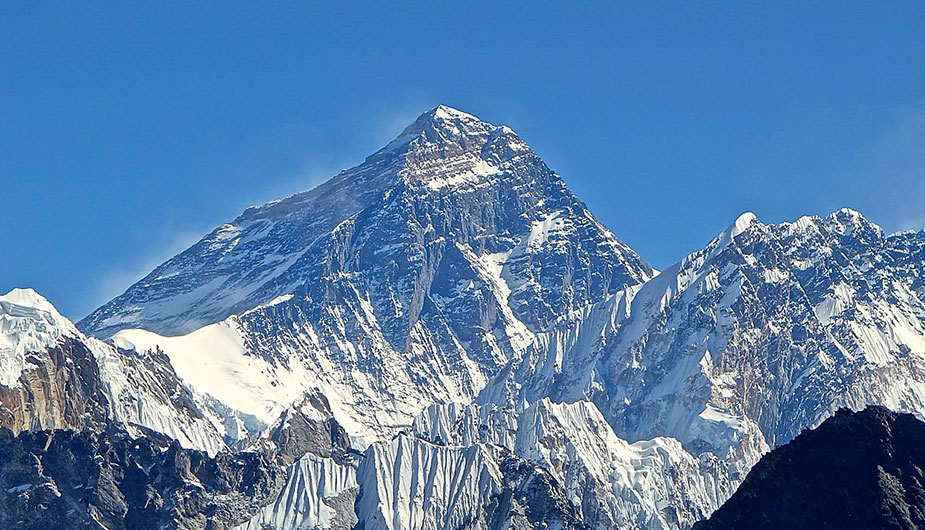
Everest Base Camp lies in the mountainous part of Nepal. The altitude you gain while you trek in the Everest Base Camp is quite significant.
To start your trek, you will take a flight from Kathmandu to Lukla and finally get to Everest Base Camp.The altitude of Kathmandu is 1400 meters while that of Everest Base Camp is 5380 meters.
Thus, in total you will gain an altitude of 4000 meters. Thus there will be variation in the weather of various places along the trek.
As you ascend higher, the weather turns unpredictable in this trek. So, it is better to start preparing.
Everest has four seasons- summer, spring, autumn and winter.
Summer in EBC falls in the month of June , July , and August . During this season, the minimum temperature along the highest points of the trek is around 0 degrees. This is a pleasant temperature considering the fact that you will be at the Base Camp of the tallest peak in the world.
However, due to the fact that monsoon season coincides with summer in Nepal, EBC trek in summer season is not as popular as trekking there in autumn or spring. But, if you plan your trip taking monsoon into account and have the appropriate gear, summer trek in EBC could be a pleasant experience.
December , January , and February are the months when there is winter in EBC. During the winter season, minimum amount of rainfall takes place in the Everest region. The most stunning pictures of the mountains are captured in this season. But due to heavy snowfall some trekking routes are closed in this season.
In addition, some places along the trek have temperature of -20 degrees in the winter. Therefore, winter treks in the Everest region is also less popular. But for people who like to trek in solitude, this is a great option.
In Everest Base Camp, autumn falls in the months of September , October and November . With moderate temperature and relatively low chances of rainfall, autumn trek to EBC is extremely popular. During this time, the temperature is mild. This means you have pleasant trekking temperatures during the daytime. In the nighttime, the temperatures are not extremely low.
Just after the completion of winter in EBC arrives the spring season. This season falls in the month of March , April and May . The vegetation in the Sagarmatha National Park becomes lush during this season and the views of rhododendron and pine forests in the Everest region is awesome.
The mountains, glaciers and quaint villages in this region bring out their best color during this season. Photography becomes awesome in EBC during the spring.
Tell us about your trip to Nepal and what you expect from it. We will answer your questions in 24 hours and help you design a trip with a comfortable itinerary to best meet your needs.
- Solo Traveler
- Number of Adults *
- Number of Children *
- Age of children at time of trip *
- I have my exact travel dates
- I have approximate dates
- I don't have my dates yet
- Travel Start Date * MM slash DD slash YYYY
- Travel End Date * MM slash DD slash YYYY
- Month of departure * Choose Month December 2020 January 2021 February 2021 March 2021 April 2021 May 2021 June 2021 July 2021 August 2021 September 2021 October 2021 November 2021 December 2021
- Approximate Duration * Less than a week 1 week 2 weeks 3 weeks More than 3 weeks
- Full Name *
- Give your trip a short title * A short descriptive headline that describes what you're looking for.
- Describe your trip *
2. Altitude of EBC trek
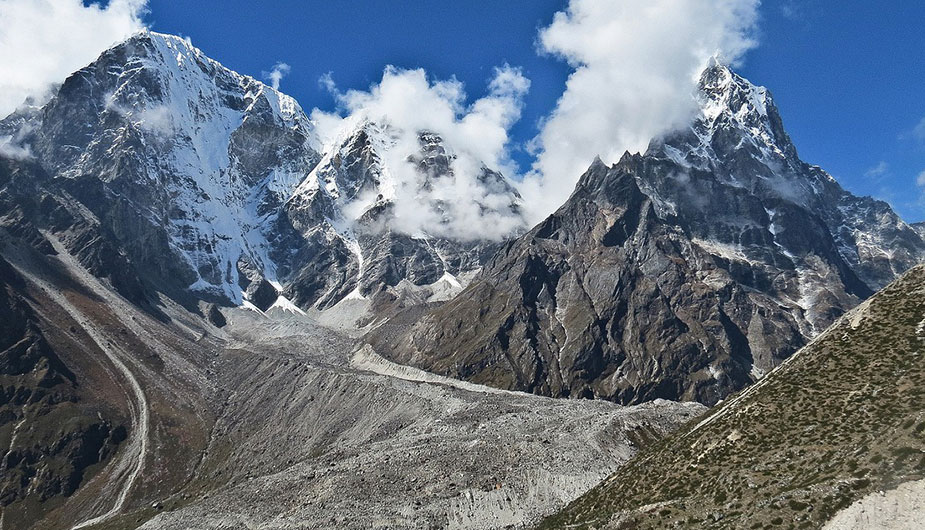
You will go to various places during your trek to EBC. The classic Everest Base Camp trek starts in Lukla. Lukla has an altitude of 2800 meters. From Lukla, you will have various stops where you will stay overnight and eventually complete the classic EBC trek in around 2 weeks’ time.
Mostly, the altitude of the places you go to in the EBC trek is more than 3000 meters, you have to spend your time acclimatizing as well. Also, there are various trekking options in the Everest region. So, trekking there might take take more or less than 2 weeks depending upon the trekking packages you want.
So, with different trekking packages comes different places along the trek and different altitudes as well.
Namche Bazaar is the town of Sherpa people and is a place that is renowned for trade. Khumjung Monastery and Tengboche Monastery are two places in the Everest region that reflect Tibetan Buddhism prevalent in this region.
Gokyo is a wonderful valley in the Everest region which people visit during Gokyo Valley trek.
There are some mountain passes that you can cross when you come for trekking in the Everest region.
3. Difficulty of EBC trek
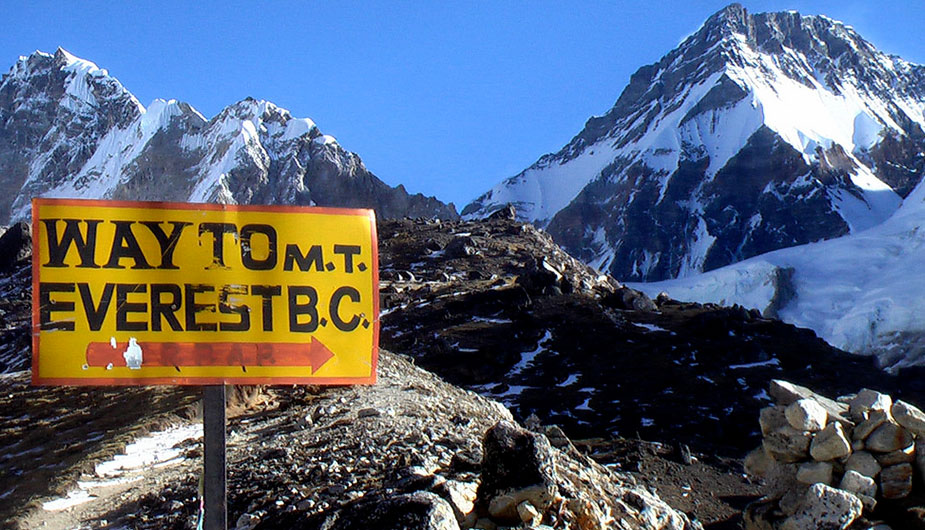
The other pressing question that every trekker asks about Everest Base Camp is whether the trek is doable. The difficulty of the EBC trek is determined by various factors such as altitude, the number of trekking hours as well as the season that you decide to do your trek.
Longer trekking routes in Nepal can take up to a month to complete while shorter trekking routes can be completed in a week. Trekking for a month in the mountains is quite strenuous. However, Everest Base Camp trek is two week long. This makes it moderately difficult in terms of the number of trekking days.
While doing the EBC trek, you have to trek for around 5-6 hours a day. You have your breakfast in a teahouse/ lodge in the morning and set out for trekking and trek for around 3 hours before having your lunch. After lunch and a bit of rest, you head out and trek for around 3 hours before reaching the place where you stay overnight.
Thus, the EBC trek is also moderate in terms of the number of trekking hours per day.
Altitude is another big factor that is detrimental to the difficulty of the trek. There are various ways in which you can prepare for altitude sickness. You need to go slowly in your treks and spend time for acclimatization as well.
Therefore, taking all these factors into consideration, EBC trek has a moderate level of difficulty.
4. Cost of trekking to EBC
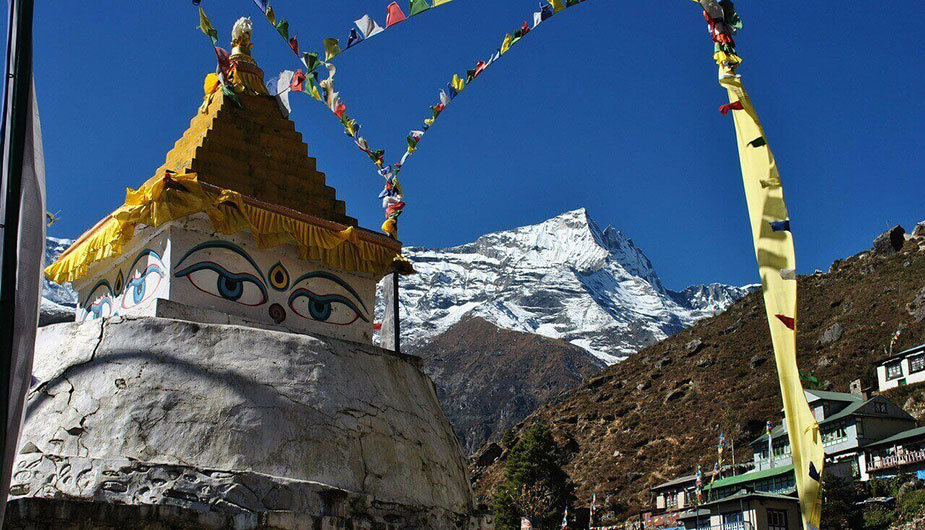
There are various kinds of expenses that you have to bear while trekking at Everest Base Camp. The cost of EBC trek includes the price of flights, accommodation, food, gear, travel permits, insurance, cost of hiring a guide and other miscellaneous costs.
The flight to Lukla from Kathmandu costs about 177$. If you choose the Jiri to Everest Base Camp, you won’t have to take a flight and this will reduce the cost of the flight. The price of flight from Lukla to Kathmandu is also identical.
You have a great range of places for accommodation. There are tea houses along the trekking trails which are quite cheap. Right next to tea houses, you can also find luxurious hotels. So, the price of accommodation in the EBC trek depends on the comfort and facilities you are looking for during your treks. For example, if you book the Everest Base Camp luxury trekking package, then your cost is going to be higher.
In addition, you should expect to pay higher charges for accommodation as you go to higher altitudes.
Also, you have to get several permits while trekking in the Everest region. EBC trek lies in the Sagarmatha National Park. The permit to Sagarmatha National Park costs 33$. Besides, you also have to acquire a TIMS card, the price of which varies according to your nationality. If you are planning to trek from Jiri, you will have to acquire a permit for Gaurishankar Conservation Area.
Guides and porters are also necessary for you in order to have a comfortable trip. Their prices vary from 20 – 40 US$. There may be miscellaneous expenses while charging you electronic gadgets, tipping porters/ guides/ waiters, and donating some amount to the locals.
5. Travel Insurance for EBC
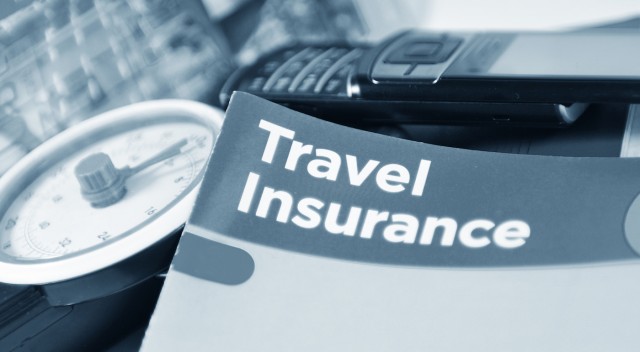
Irrespective of where you are traveling, getting a travel insurance makes you feel secure about the things that can go wrong during your trip. As there are some problems you can face while trekking such as altitude sickness, accidents, illness etc., a travel insurance will come in handy.
In the worst case, you may be down with altitude sickness while trekking. Without a travel insurance, charting a helicopter for rescue can take upto 5000 US$. There might also be bruises and cuts during your treks which may require you to charter a flight.
In addition, some travelers lose their bags and other personal belongings due to forgetfulness or petty theft.
If you get a travel insurance for the EBC trek , you will be able to overcome such problems. There are many travel companies that provide a travel insurance for EBC. Make sure you check the list of items covered in the travel insurance you choose.
6. Altitude Sickness in EBC
While trekking in altitudes greater than 3000 meters, the oxygen level in the air goes down.. Due to lower levels of oxygen, the bodily functions may not function as it would normally do. This results in altitude sickness in some trekkers.
There are various types of altitude sickness viz. Acute Motion Sickness, High Altitude Pulmonary Edema (HAPE) and High Altitude Cerebral Edema (HACE). These many forms of altitude sicknesses have their own symptoms and preventive measures.
Acute motion sickness is quite mild in nature whereas HAPE and HACE are extreme forms of altitude sickness. HAPE and HACE are conditions where fluid is built up in your lungs and brain respectively. If left untreated, these conditions can be fatal.
In order to reduce the chances of altitude sickness during EBC trek, you need to prepare physically as well as mentally. While you are trekking, you need to go slow and make sure that your body is receiving enough nutrients in the form of food and water.
Taking medication, paying close attention to sanitation, and descending when you feel the symptoms of altitude sickness are some other preventive measures you can use to keep altitude sickness away.
7. Hiring a guide to EBC
If you have trekked to EBC many times before, you may be tempted to go to EBC without a guide. With enough trekking experience, you can do that. But, if you do not have prior trekking experience, hiring a guide is much helpful.
Guides help you in various ways during your trip. The biggest help they offer besides guiding you in trekking trails is by helping you understand the local community. Knowing the local community and learning the culture and lifestyle is an integral part of your trek.
In addition to guides, you can also hire a porter. A porter will carry your belongings giving your body relief during the trek. This will enhance your trekking performance and help you complete the trek on time..
In addition, you can also hire a porter cum guide who guides as well as carries your belongings during the trek..
Guides and porters help you in getting awesome views of the mountains of the Everest region as they have a lot of idea about the best places for mountain viewing. Plus, they can guide you through the best local cuisine of the region.
Hiring a guide to EBC also helps to boost the economy of the region. Guides and porters also help you have good conversations along the way and provide you physical as well as mental support that you need while trekking to EBC.
There are excellent travel agencies in Nepal which provide you the facilities of licensed guides and porters.
8. Finding a travel agency for EBC trek
Finding a travel agency is another important factor to consider while trekking to EBC. As there are many travel agencies in Nepal, it is extremely important to review the various factors that makes a travel agency good.
Travel agencies are necessary as they help you arrange accommodation and guides fork safe and easy trek. In peak trekking seasons, accommodation is difficult to find and you may end up sharing rooms or not finding rooms with good insulation.
Travel agencies also provide you licensed guides. Good trekking companies have a good track record of providing emergency services during your trek. In addition, they will also provide you good advice and customize your trips according to your convenience.
While you are looking for a travel agency for trekking in Nepal, the first thing you need to do is to check whether the agency is registered. Experience is another important factor to consider while choosing a trekking agency for EBC trek.
But, before you consult a trekking agency, you might want to know what you want. If you make a rough estimate of the number of days you are planning to trek, your budget as well as the places you want to visit, it makes it all the more easier to approach any trekking company with clarity.
If you read the reviews of Nepal’s trekking companies in online platforms such as TripAdvisor and Lonely Planet, you will have some idea about if the services provided by the trekking agencies have a good standard.
You can also interview the guides offered by the trekking agencies and know if you will be comfortable with the guides. lso, look at the track record of all the trekking agencies to see if they have a good history of emergency services they have provided.
9. Everest Base Camp training program
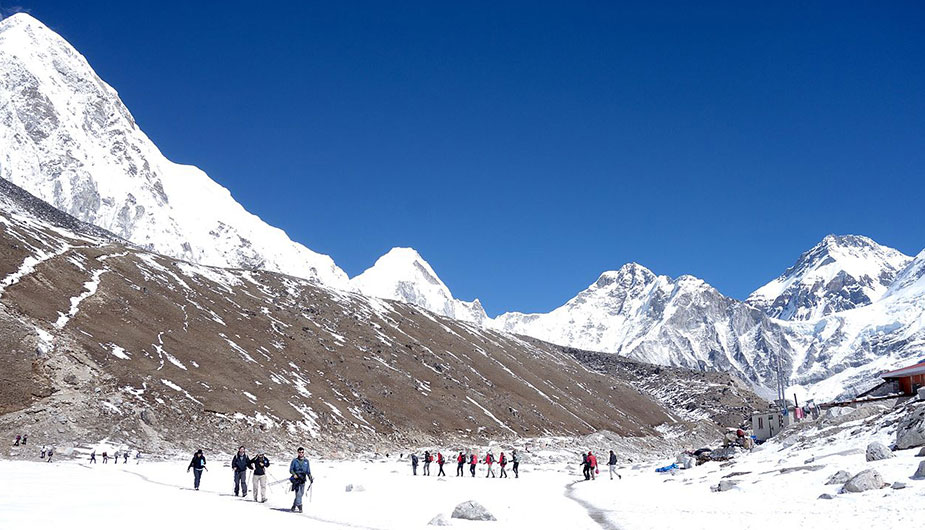
If you are looking for completing Everest Base Camp trek, you should consider proper training for this trek . As you have to trek for about two weeks and prepare for the altitude as well, you need to undergo a rigorous training regime.
If you are a beginner who has little or no trekking experience, you should do a few hikes or treks before you take on the EBC trek. You can come to Nepal a few days early and do a few short treks to get your body adjusted to walking for longer hours..
In addition to that, you also need to do a cardio training to build endurance. You can either opt for some running, cycling, or swimming. All of these exercises help you strengthen your limbs as well as forearms which will immensely help you in your treks.
Diet is of paramount importance in order to build endurance and strength in your body. You need to make sure that the food you eat is rich, not simply in terms of protein but other minerals and vitamins as well.
You can also use elevation masks to prepare for your treks as elevation masks are known to build endurance in the body. Although, preparing with elevation masks is no guarantee that altitude sickness will not catch you, it will help simulate the environment that you are likely to encounter during your treks.
During your trek to EBC, you should not rush. You should continue your treks slow and you need to acclimatize properly as the altitude increases.. If at any point during your trek you don’t feel well, you need to take rest and assess your bodily conditions.
At times, you may feel symptoms of altitude sickness. In that case, you need to descend to a lower altitude and take all the necessary precautions.
10. Everest Base Camp trek route
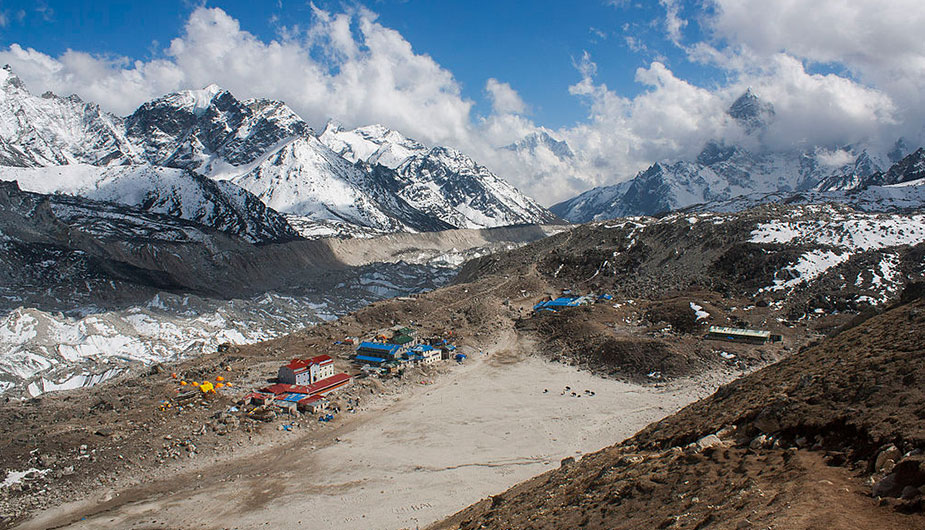
11. Other trekking options in the Everest region
Everest base camp panorama trek.
If you are a beginner looking for some trekking experience in the Everest region, Panorama trek in the Everest region will be perfect for you. It is a light trek in the lower altitudes of the Everest region.
In this trek, you will visit places such as Namche Bazaar, Tengboche and Phakding. All of these places have an altitude lower than 3500 meters.
Everest High Passes and Island Peak
This is a trek from where you not only go to Everest Base Camp and Kala Pathar but also cross mountain passes such as Cho La Pass and Kongma La Pass. You will also climb Island Peak which is 6187 meters tall. This will be a long trip which will last about 25 days.
Gokyo Valley Trek
Another wonderful trekking option in the Everest region is Gokyo Valley trek. Gokyo is one of the most awesome valleys in Nepal with breathtaking mountains, Buddhist monasteries, glaciers and lakes.
Even trekking in Gokyo region has several alternatives such as Gokyo valley and Renjo La Pass trek and Gokyo to Everest Base Camp trek. All of these treks can be completed in different number of days as the routes can be customized by consulting a travel agency.
Jiri To EBC trek
Jiri to Everest Base Camp trek is one of the longest treks in the Everest region. During this trek, you will trek from Jiri, a place with an altitude of 1900 meters. Trekking from this place will help you acclimatize while trekking to the higher regions of Everest.
12. Death in Everest Base Camp
With so many movies depicting Everest Base Camp and expeditions in Mt. Everest, you might be wondering if there have been many instances of death of trekkers during Everest Base Camp trek. Well, the answer is YES.
But the fact that there have been deaths in the Everest Base Camp should not deter you from trekking to the Everest Base Camp. You have to look more closely at what lead to the deaths of people wanting to trek to EBC.
Most deaths that are shown in the Everest region in the movies are the ones which take place in mountaineering expeditions. And mind you, mountaineering expeditions are tough. You need a rigorous amount of training and sophisticated mountaineering equipment to complete the Everest expedition.
However, trekking to Everest Base Camp is rarely dangerous. The trekking trails to Everest Base Camp are relatively safe and thousands of trekkers trek there with appropriate training and guides.
A recent casualty while trekking in the Everest region was a travel enthusiast from Melbourne, Australia. Before that, in October 2014 and early 2014, there were casualties in the Everest region.
All of these casualties were reported to have problems coping with altitude sickness. You should prepare extremely well for the altitude sickness while going to the higher altitudes of the Everest region. .
If you have friends during your trip, they might provide you with necessary physical and mental support during your trips. If you are traveling alone, it becomes important for you to hire a guide or a porter, who can provide you such support.
13. Alternatives to trekking to EBC
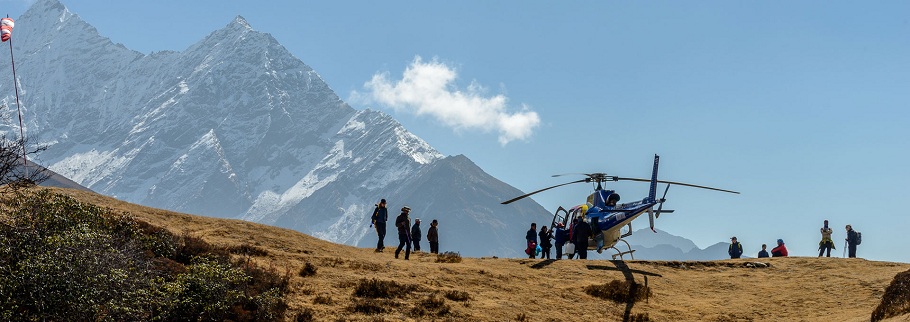
You might be desperate to visit the Everest region but not be up for trekking in the region. You might wonder if there is any way you can go to the Everest region without taking the trouble of trekking. Well, there is a way.
Everest Base Camp is easily accessible in a helicopter. Everest Base Camp Helicopter tour allows you to go to Everest Base Camp and Kala Pathar in a helicopter. You take a helicopter from Kathmandu and travel to the Base Camp.
First, you’ll go to Lukla from Kathmandu early morning and stay in Syangboche for a delightful breakfast in Hotel Everest View. Everest View is a sophisticated hotel in the Himalayas of the Everest region from where you can enjoy the peaks in Everest region such as Mt. Lhotse, Mt. Makalu and Everest.
After the breakfast, you will go to Everest Base Camp and Kala Pathar. From Kala Pathar, you can enjoy a very close view of Everest. After you spend about an hour and a half, you will get back to Kathmandu.
In a helicopter tour, you will get to the Everest region and come back the same day in the safety and comfort of a helicopter. Another wonderful feature of the helicopter tour is that it is accessible all year round.
You also have options of joining a group in a helicopter tour while going to Everest Base Camp or choose a private tour.
14. Everest Base Camp Packing List
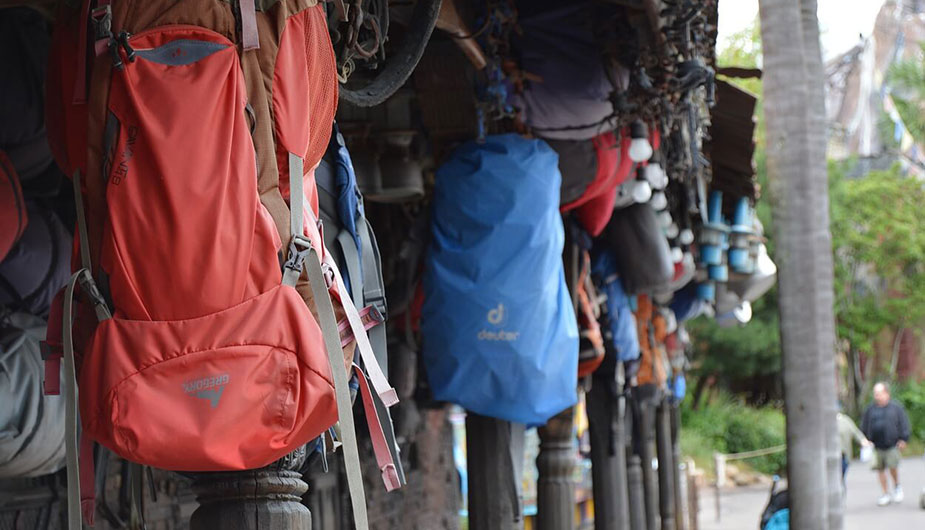
Your packing list for EBC trek is of utmost importance. You need to consider the season in which you are planning to do the trek and choose your gear as well as clothing accordingly.
When you are in the lower altitude, the temperature might be lower than that of the regions in higher altitude. Therefore, multi-layered clothing will be the way to go.You need to put on base layer, insulation layer and the outermost layer of clothing.
Since you cannot completely ignore the possibilities of rain, you should make sure that your down jacket and trousers are waterproof.
You will need a voluminous backpack which can accommodate a lot of belongings from clothes, digital accessories to sleeping bags. Make sure that you get a rain cover for your backpack as well.
You will also need sturdy trekking boots. Sunscreen will help you ward off the UV radiation that can harm your skin. You will also need sunglasses to protect your eyes from such radiation.
In addition, you will need woollen hats, gloves and socks to keep cold away. You may also want to consider buying a trekking pole to help you have a form grip on the ground that you tread while trekking. Basic toiletries and first aid will come in handy during emergencies.
Frequently Asked Questions
What type of accommodation is available in the everest region.
There are luxurious hotels like Hotel Everest View in the Everest region along with tea houses, which are basic. As you trek to higher altitudes, facilities such as WiFi, room heating become scarce. Make sure you check the trekking agency you are traveling with to know what kind of accommodation is arranged for you.
What kind of food is served while trekking to EBC?
The type of food served is also dependent on the hotels that you dine in. Luxurious hotels such as Everest View have a great range of food from Continental to American. But if you go to normal lodges, you will most often be served traditional Nepali food in the form of Dal Bhat for lunch and dinner.
Is there a great range of beverage available during the EBC trek?
Nepal is quite famous for the wonderful variety of tea and coffee it serves. So, you will find a range of tea while trekking to EBC. The same goes for coffee.
However, you should avoid consumption of alcohol while trekking. Consumption of alcohol leads to dehydration, which increases the chances of altitude sickness.
What kind of snacks do I need to carry for the EBC trek?
Chocolate is always the most handy snack that you can carry. Chocolates have high carbohydrate and energy. Constantly munching it while trekking will help you maintain your energy level.
Is drinking water at EBC pure?
One of the biggest problems that you may face during EBC trek is finding clean drinkable water. Drinking impure water may lead to diarrhoea, which will lead to dehydration. So, you can carry a water purifier or water purifying tablets to ensure that the water you drink is safe.
What kind of toilet facilities are there in the EBC region?
Most of the toilets that you find in the Everest region are squat toilets. In squat toilets, is no automatic flushing here and you have to use a bucket of water in order to flush. But lodges that are recently built have automatic flush toilets as well.
Is cell phone reception available in the EBC trek?
Cell phone reception and its quality varies from one location to another but is available in several parts in the EBC trail. There is mobile phone facility at Everest Base Camp as well. In addition, several villages and lodges have landline facility too.
Is there any limit on age for the EBC trek?
There are no restraints on the age while doing the EBC trek. But, highlighted before, you need to undergo basic training before setting off for the EBC trek. You might also want to consider consulting a doctor for a precautionary checkup about the state of your health. The doctor will also prescribe you some medicine for altitude sickness, if necessary.
What is the limit of the weight of my baggage to Everest Base Camp?
If you are taking a flight to Lukla, there is a certain limit to the weight of your baggage. The maximum weight of the check-in baggage is 10 kg whereas that of the hand carry is 5 kg.
Are ATMs available in Everest Base Camp?
No. ATMs are not available in Everest Base Camp. There are some ATMs in Namche Bazaar or Lukla but not in places higher than that. And in worst scenarios, ATMs might run out of cash or the machines may not work properly. So, carrying some hand cash is always a good option.
Is there a rule for tipping/ donations while trekking in EBC?
Tipping is not compulsory. If you want to tip someone or make some donations, you are free to do so but, there is no hard and fast rule about how much you should tip.
Everest Base Camp trek is a trek of a lifetime. Trekking there will give you memories that will last forever. But, there are many things to consider before you can start your trek there. You need to carefully assess all things mentioned above while planning for your trek. If you are well prepared, it will be the most amazing trekking experience of your life.

- Classic EBC Trek
- EBC + Gokyo Trek
- Jiri to EBC
- 3 Passes Trek to EBC
- Island Peak and EBC
- Acclimatisation
- Packing List
- Get a Trek Quote
Start planning your Everest base camp trek
We help adventure-seekers plan and book their dream trek to EBC
Welcome to EBC Trek Guide
Reaching Everest Base Camp has become the goal of thousands of avid trekkers the world over. There is a sense of grandeur that comes with trekking through an area considered a Mecca for climbing and mountain enthusiasts.
This website is the most comprehensive online guide to the Everest Base Camp Trek. On it you will find all the information you need to trek safely and successfully in the region.
On this page we provide a general overview to the Everest Base Camp Trek, along with many links to further reading on topics like: Altitude Sickness, Packing Lists, Route Variations and many FAQs!
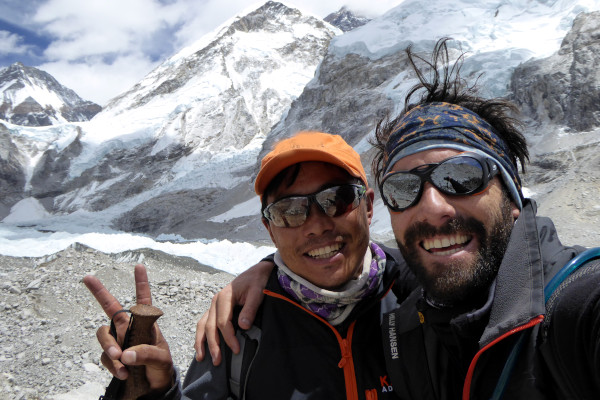
Plan your EBC Trek
Get a quote from our recommended local EBC trek operator
Everest Base Camp Trek FAQ
What makes the everest base camp hike special.
The iconic Everest Base Camp Trek leads you through the Khumbu Valley, allowing you to experience the immense beauty of the surrounding Sagarmatha National Park while simultaneously providing breath-taking vistas of 4 of the 6 highest peaks in the world – My. Everest (8.848m), Mt. Lhotse (8,516 meters), Mt. Makalu (8,470 meters) and Cho Oyu (8,201 meters).
The classic trek retraces the footsteps of Sir Edmund Hillary, Tenzing Norgay and the countless other early pioneers of Mount Everest as you trek from Lukla to the Base Camp.
As a teahouse trek you will stay in some of the highest villages in the world as you explore the local culture and traditions of the native Sherpas by learning about their spiritual connection with the mountains.
On the trek you will have the chance to ascend Kala Patthar , reaching an altitude of 5,500m and witness awe-inspiring views of Mount Everest.
You will also have the chance to explore the various Buddhist monasteries dotted along the trail and learn about a culture steeped in history and tradition, inextricably linked to the very mountains on which you have unforgettable views.
Below we have provided a brief overview of the classic route itinerary, with regional and trekking maps. We have also answered some of the most frequently asked questions on the logistics of the trek, permits, tour guides, weather, insurance, cost, difficulty and what to pack.
Where is the Everest base camp trek located?
All treks in the Everest region are located within the orange rectangle on the map below. The block represents the Everest or Khumbu region of Nepal and shows its location in relation to Kathmandu, where flights to and from Nepal arrive and depart.
The starting point of the Everest Base Camp Trek, Lukla , is also visible on the map. Other variations of the trek which don’t involve flying to Lukla generally start at Jiri – you can read more about this route variation here .

What is the best Everest region map?
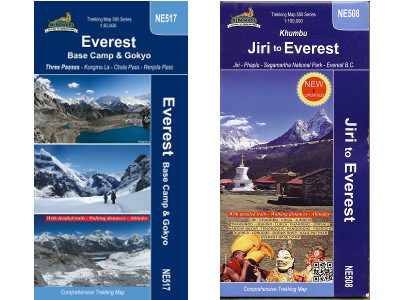
There are many great trekking maps for the Everest Region. Some take in the Gokyo region, whereas others cover Jiri and further Southern and Western aspects of the region.
We recommend Nepa Maps .
What is the best Everest guidebook?
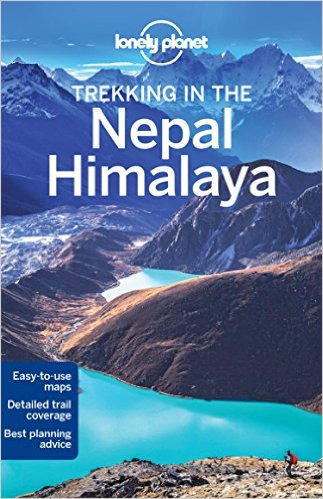
We recommended taking a detailed guidebook with you on the trek.
The Lonely Planet Trekking in Nepal Himalaya guidebook is updated regularly and is a well-known, trusted resource used by many trekkers worldwide.
The guide is very detailed and contains information for many treks, meaning you can use it more than once!
How high is Everest base camp?
Everest base camp is 5,364 metres (17,598 ft) high. The graph below shows the altitude profile for the classic Everest Base Camp trek. The order of the names on the horizontal axis shows the typical progression of the hike with the major stops on the way. The graph makes it easier to see the gradual ascent and more rapid descent of the trek.
The highest point on the EBC hike is Kala Patthar at 5,554 meters.
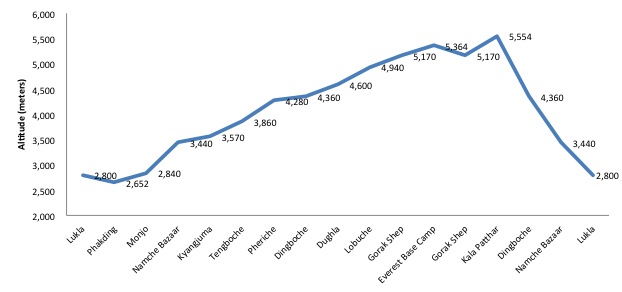
What is the day-to-day itinerary on the Mt Everest base camp hike?
The classic Everest Base Camp Trek starts in Lukla and leads you through the Khumbu Valley to the Everest Base Camp situated on the south-side of Mount Everest.
Most trekker’s adventures, however, begin in Kathmandu where the international airport for Nepal is located. From there it is a short, yet unforgettable flight into Lukla from where you will start the actual trekking (try get a seat on the left hand side of the plane for best first views of the Himalaya).
The entire journey including the trek typically lasts between 14 and 16 days, with 12 days on the trail. Of these 12 days, 2/3 will be spent acclimatising to the high altitude, so 9-10 days of actual trekking can be expected.
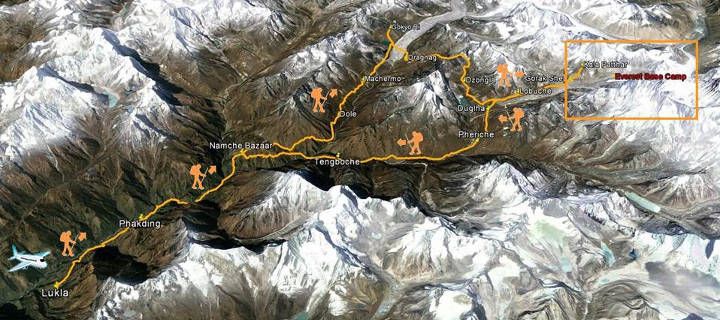
For those who don’t want to start their trek by flying into Lukla Airport, the Jiri to Everest Base Camp Trek variation provides a unique alternative. This trek starts with a bus ride from Kathmandu to Jiri from where the trekking starts. Because Jiri is considerably further away than Lukla, this variation will add around 5 days onto the trek.
Here is a standard itinerary for a 14-day Everest Base Camp Trek experience.
Day 1: Arrive in Kathmandu
If you have organised a trip with a tour operator they will usually provide airport transfers, otherwise there are loads of taxis available at the airport. Top tip: make sure to agree a price before getting in the taxi. Meters are sometimes used, but rare. We recommend staying in Thamel (which is about 15 minute drive from Kathmandu airport). There are many hotels in Thamel, Kathmandu, with varying degrees of hospitality.
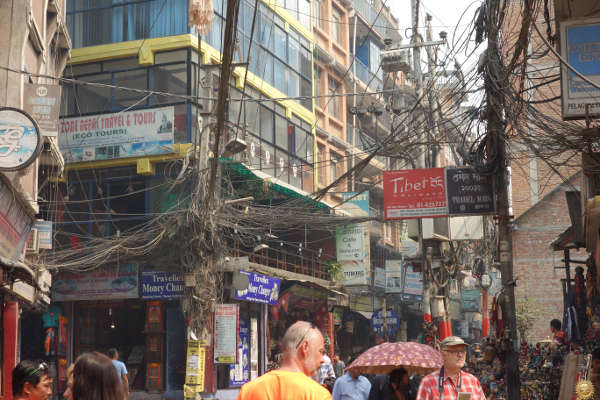
Vibrant streets of Thamel, Kathmandu
Day 2: Fly Kathmandu to Lukla. Trek to Phadking
Weather permitting you will fly from Kathmandu International Airport to Lukla in the morning. Flights to Lukla are prone to delay due to weather. We recommend building as much flexibility into your itinerary to cater for delays (i.e. having a day or two spare after the trek).
If trekking with a tour operator they will have arranged your flight, otherwise you can purchase tickets at the airport for around US$250-$300 return. If you are taking a guide the cost of his flight with be charged at a local rate of about $100 return.
Expect a nerve-racking flight into the famous Lukla Airport that provides great views of the region and of Everest – try to get a seat on the left side of the plane. Once landed, you will start the trek to the village of Phadking – on the way you will pass incredible boulders, carved with Buddhist prayers.
Day 3: Trek from Phadking to Namche Bazaar
This day will be spent trekking from Phadking through Mojo, ending up in Namche Bazaar. Some people cut this day short by stopping in Mojo (if you do the Mount Kailash Teahouse is great, and offers hot showers!).
You will enter the Sagarmatha National Park (a UNESCO World Heritage Site) on this day. You will have plenty of time spent in Namche Bazaar – a small Sherpa market town, with countless sightseeing opportunities including the potential to catch your first glimpse of Everest.
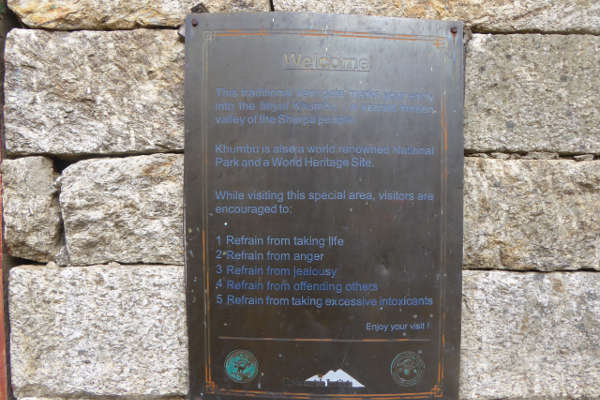
Sign with rules about entering Sagamartha National Park
Day 4: Acclimatization day in Namche Bazaar
At close to 3,500m, Namche Bazaar acts as an important acclimatization stop while doubling up as an opportunity to explore the village and surrounding areas. If it happens to be a Saturday, be sure to check out the market. Most tour guides will take you on a short acclimatization trek to the Everest View Hotel.
If it’s a clear day you should be able to snap some awesome pics of Ama Dablam in the foreground, and Mount Everest in the background. The hotel also provides WiFi at a cost so if you’re looking to call back home or just to connect, bring your device with you. For more information on internet on the trek, check out our detailed article .

Namche Bazaar
Day 5: Trek from Namche Bazaar to Tengboche
The day is spent trekking from Namche Bazaar to Tengboche, the home of the Tengboche Monastery – the largest in the region.
Some variations will take you through the ancient Tibet-Nepal trading route over the Nanpa La pass to Thami.
Day 6: Trek from Tengboche to Periche
The next stop on the trek is Pheriche – the home of the Himalaya Rescue Association . The route takes you through Phangboche, which offers amazing views of Ama Dablam towering above you.
Day 7: Acclimitization Day. Potentially Trek from Pheriche to Dingboche
Pheriche is usually used as a stop for the second acclimatization day. There are various activities to do in the area. Tshola Tsho Lake is a popular destination for trekkers stopping in Pheriche.
Your tour guide might even take you to the nearby village of Dingboche where you will be able to see great views of Lhotse and Island Peak to the east. Dingboche is used as the start to the variation trek to Island Peak .
Day 8: Trek from Pheriche to Lobuche
This day is long and is spent climbing over 600m from Pheriche to Lobuche. On the way, you will pass the well-known Khumbu Glacier as well as various memorials to those Sherpas and climbers who have died on Everest.
You will be able to see Scott Fischer’s memorial here. You will also see Lobuche East (make sure to use the zoom on your camera or if you have binoculars to try see any climbers on the peak)
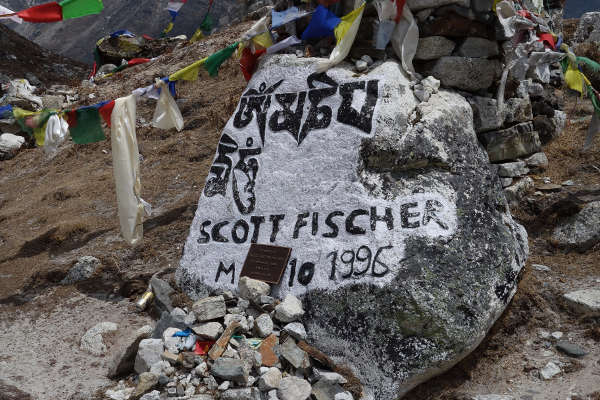
Scott Fischer's memorial
Day 9: Hike from Lobuche to Gorak Shep
Hike from Lobuche to Gorak Shep, the highest permanently inhabited village in the world. Here, you will rest for a while and have something to eat before climbing further to the Everest Base Camp.
The trekker stop point is just before the actual base camp.
Most tour groups are not allowed to enter or stay in Everest Base Camp so take the chance to experience the buzz and excitement of the climbing groups is often limited.
After getting your iconic picture taken at EBC you will descend back to Gorak Shep where you will stay for the night.
Day 10: Gorak Shep to Kala Patthar, then onto Dingboche
Another day of steep trekking allows you to reach Kala Patthar – the highest point on the trek at just over 5,500m. Its location and height result in the best views of Everest, Nuptse and Lhotse in the area. Just hope that the weather is kind to you on this day as it is one of the highlights of the whole trek.
That same day you will descend over 1,000m down to Dingboche where you will spend the night.
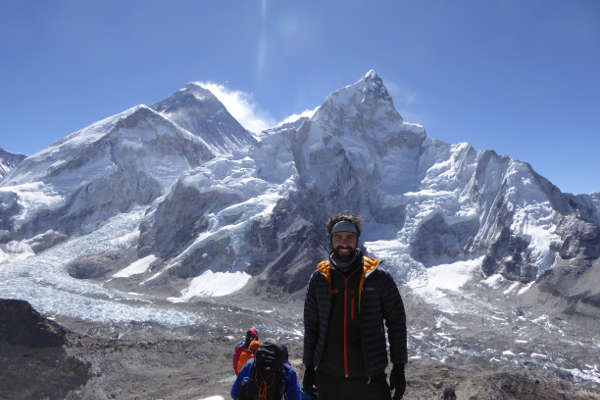
View from Kala Patthar with EBC, the Khumbu Glacier, Nuptse and Mount Everest in the background
Day 11: Hike back to Namche Bazaar from Dingboche
Descend back to Namche Bazaar via Tengboche. Keep your camera on you as you pass through the rhododendron covered slopes – making for a great photo.
Day 12: Hike from Namche Bazaar to Lukla
Return all the way back to Lukla with a long day of hiking. Your last night on the mountain will be spent celebrating in Lukla.
Day 13 and 14: Fly back from Lukla to Kathmandu
Catch the return flight from Lukla to Kathmandu in the morning. Onward travel back home our to your next destination!
More Everest Base Camp hike FAQs
How much does it cost to trek to everest base camp.
You can trek to Mt Everest base camp for as little as $700 if you go solo without a guide. Guided tours that often include return flights to Kathmandu cost around $1000-1300 per person depending on the operator. For a detailed breakdown of costs, see our article on the cost of the Everest Base Camp Trek .
Can you trek to Everest Base Camp independently or without a guide / support?
Yes, but it is only advised for trekkers that have experience of high altitude multi-day trekking, and are comfortable carry 15-20kg a day.
Trekking independently is the cheapest option because you forgo any of the amenities and expertise that is typically offered with a guided trek. You will have to arrange your own domestic flights to and from Lukla airport, and arrange accommodation for each stop in the trek.
If you are comfortable organising the logistics of the trek, then this might be an option for you.
Should I join a guided EBC trek / group?
If this is one of your first high altitude trekking experiences then we recommend using a tour operator and joining a guided group. The typical package will include domestic flights, transport to and from the airport, accommodation for every overnight stop, all permits and passes, porters to carry your luggage and of course the expertise of a guide who will provide you with an insight into the region.
Local tour operators are abundant and often cheaper than western operators, but their level of service will be reflected in their price. Hygiene and ethical standards of some of these operators is also questionable. Prices range from £600 ($750) to £1000 ($1300).
Western tour operators will provide a much more consistent service. Without cutting prices, they offer affordable yet comfortable accommodation and will employ the best guides in the region who will be able to converse in English. Prices range from £1000 ($1300) to £2000 ($2600).
When is the best time to hike to Everest Base Camp?
Contrary to what you might think, the best time to go on the Everest Base Camp trek is not during the height of summer. The spring months of February through May is widely considered the peak season or best time to hike to Everest base camp. This is also the time when the region is at its busiest.
Weather during these months is stable and dry – perfect for trekking and for sightseeing. The lower mountains and foothills are most colourful during this time as well, so you can expect verdant fields and hillsides covered in rhododendrons.
September and October is another popular trekking period on the other side of summer that tends to be a little less busy. Another way to avoid the hustle and bustle of peak season is to try some of the trek variations such as the Gokyo Lakes hike .
Trekking in the winter months (November-January) is still possible, but be prepared for temperatures below freezing. Peak summer is known as monsoon season, characterised by short, sharp downpours. The trails are very wet and trekking during these months is not advised.
Read our detailed article on the best time to trek to Everest Base Camp .

How difficult is the Everest Base Camp Trek?
Contrary to popular belief, Everest Base Camp trek is not very difficult. It requires no prior trekking experience or mountaineering skills of any sort. We have seen people from all walks of life, shapes and sizes completing the trek.
The round-trip length of the trek is 130km, which is spread over just short of two weeks of trekking. Expect to cover around 15km over 5/6 hours of trekking each day – a very achievable number. The hardest part of the trek is the altitude and the effect that it can have on your body.
All good tour operators will factor in acclimatisation days into their itinerary and will aim for a gradual pace of ascent that will ensure your body slowly gets used to the altitude.
We recommend undertaking a gym training programme and practice hikes 6-8 weeks prior to embarking on the trek. Read up more on the difficulty of the EBC trek and how to train for the EBC trek .
Do I need a visa or permit for the EBC Trek?
Yes. If you are a national of a country other than India, you will need to purchase a visa. The 15-day multi entry visa starts at $25 and the 30-day visa goes for $40. The usual guided trek lasts around 15 days, but there is always the possibility of travel delay so we recommending opting for the 30-day visa for a slightly higher price.
You will need a Trekkers Information Management System card (TIMS) as well as a Sagarmatha National Park Entry Permit. Tour operators will include both in their price and will obtain them for you beforehand. If you plan to trek independently, however, you will need $20 for the TIMS card and roughly $40 for the Sagarmatha entry permit.
Make sure you bring at least four passport sized photos in case they are needed for permits.
Will I get altitude sickness on the trek to Mt Everest base camp?
Most people who follow the standard route itinerary, take a gradual ascent with acclimatisation days built in and monitor their symptoms will not suffer from any sort of altitude sickness.
That being said, altitude sickness is not correlated to age or fitness and can affect some people worse than others.
Because it is a potential risk, you must read up about acclimatisation and altitude sickness so that you understand the symptoms and how to prevent them.
What should I pack for the Mt Everest trek?
Condensing a packing list into one short answer is impossible, so we have compiled a very detailed and comprehensive EBC Packing List guide to help you plan and pack for the trek.
It is possible to buy most gear in Kathmandu, but we recommend bringing all the important stuff with you from home. Read our guide for recommendations on what to bring, which brands are trusted as well as items you won’t need during the trek.
What insurance do I need for EBC?
You will need to take out insurance that will cover you for hiking up to altitudes of 6,000m.
Typical travel insurance will not cover this so we have compiled an article that will help you find the right insurance policy that adequately covers delays, accidents and altitude related illness.
World Nomads provide insurance for treks to Everest Base Camp.
Read our detailed guide on travel insurance for the Everest Base Camp Trek .
EBC Trek Route Variations
There are a number of route variations for the trek to Everest Base Camp. Below we briefly discuss the three most popular options.
Gokyo Lakes Trek
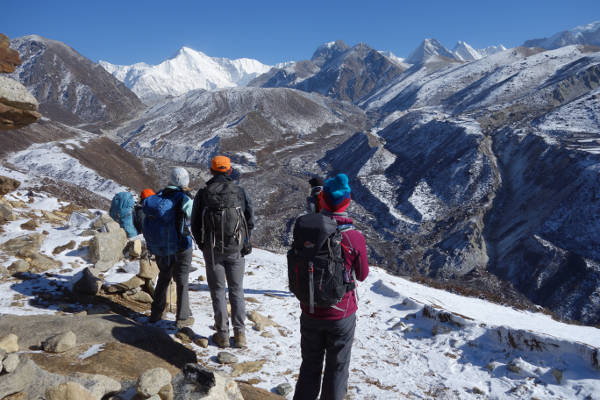
One of the more popular variations of the Everest Base Camp Trek, the Gokyo Lakes Trek , also starts at Lukla and follows the classic base camp trek to Namche Bazaar where it forks north-west.
The trek proceeds through the towns of Dole and Machermo before reaching the stunning Gokyo Lakes. From there you can ascend to the peak of Gokyo Ri in the north, before crossing the Ngozumba glacier and Cho La Pass and re-joining the classic trek at Lobuche.
The detour adds 2/3 days onto the trek but provides the wonderful opportunity to summit a peak while also avoiding some of the busier parts of the trek.
Jiri To Everest Base Camp

This variation of the classic trek offers an alternative to flying into Lukla from Kathmandu to start the trek. The Jiri variation starts with an 8-hour bus ride from Kathmandu to Jiri, where the trek begins.
The variation adds an extra 5/6 days onto the trip as you trek through the Solukhumbu region and make your way past Lukla, where the trek then follows the same route as the classic Everest Base Camp Trek.
It involves a scenic, yet long, bus ride as well as a lot more exposure to the Tibetan and Sherpa cultures. Expect to trek through more forests and streams as you start at the relatively low altitude of 1,800m and work your way up to Lukla and beyond.
Three Passes Trek

The Three Passes Trek is a tougher variation than the classic Everest Base Camp Trek because it involves crossing three very high passes as well as summiting some walking peaks which are not included on the classic trek.
The variation starts by following the classic trek from Lukla to Namche Bazaar before veering west towards Thame and the remote Nangpa Valley. The first of the three passes encountered is the Renjo La, where you will be afforded magnificent views of Everest before descending to the idyllic Gokyo lakes.
The next pass, Cho La, involves walking up a fairly steep and icy trail before reaching a small glacier at the top. From here, you descend and re-join the main base camp trek where you summit Kala Patthar – the iconic viewpoint. You continue onto base camp itself before descending to Lobuche.
You then head east over the third pass of Kongma La and continue onwards to summit the third peak of Chukking Ri. Once again you will have amazing views of the surrounding peaks that you would not get to see on the classic trek. The circuit is completed by returning to Lukla through the main Everest trail.
Island Peak Climb via EBC
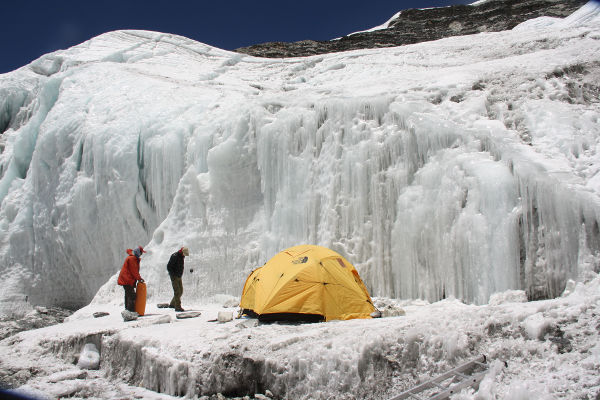
Island Peak is not so much a variation as it is an expedition in it’s own right. Summiting Island Peak is significantly harder than the trekking any of the routes mentioned above, but it does usually involve a visit to Everest Base Camp to acclimatise before the summit attempt. The climb to the peak is not considered technical although it still requires basic knowledge of jumaring, abseiling, using crampons and ice axes. Standing at just under 6,200m, altitude is a real factor.
Most climbers of Island Peak use the traditional base camp trek as a means of acclimatising before heading to the Island Peak Base Camp via Dingboche on the main trail, or by traversing the Chongma La pass. Summiting from the base camp typically takes two days and the whole variation will add around 4 days onto the classic EBC trek.
Recent EBC Blog Posts
Coronavirus pandemic: can i still hike to everest base camp (covid 19 update), mount everest deaths rise due to overcrowding, everest base camp trek packing list – exactly what you need to bring, dj paul oakenfold plays gig at everest base camp, food on the everest base camp trek, teahouses on the everest base camp trek.
References: EBC Trek Guide is maintained by a group of passionate Nepal guides and independent trekkers, many of whom live in Kathmandu and are experts on the trekking trails to Everest and throughout the region. Much of the site is based off personal experiences which are then cross-referenced with secondary sources like trail and travel guides (i.e. Trailblazer, Lonely Planet ), and third party websites. If you find any inaccuracies on the site please contact us.
Tags: Everest Base Camp Trek, Trekking to Everest Base Camp, EBC Trek
Get my recommendations on the Best EBC trek operators

Everest Base Camp Trek – Ultimate Guide For 2024
Written By: The Planet D
Adventure Travel , Nepal
Updated On: January 5, 2024
Trekking to Everest Base Camp is different than other treks around the world. Nowhere else on earth will you experience trekking as you do in Nepal and nowhere quite compares to the majesty of the Himalayas. Villages dot the landscape filled with restaurants, markets, bazaars, and tea houses (mini-hotels) where you can stop for lunch, buy supplies, and have a piece of apple pie while surrounded by the highest mountains in the world.
Every hundred meters or so there is a hotel, restaurant, or cluster of buildings making up a small village. The villages are stunning reminding us of something out of the Swiss Alps on steroids. Well-built lodges and brick homes line the trail with the magnificent setting of the Himalayas draped in the back.
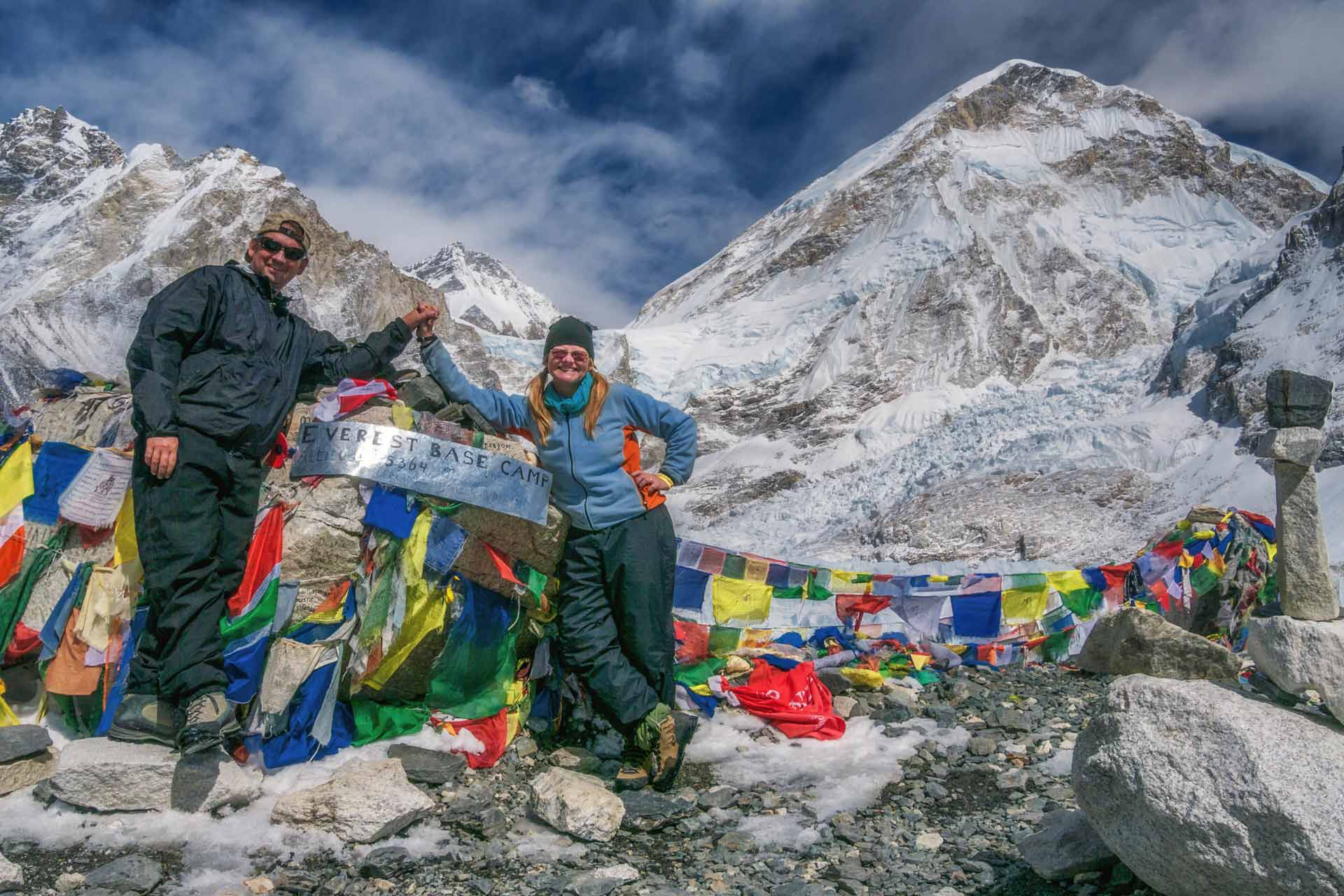
Table of Contents
Trekking to Everest Base Camp
What is it like trekking to Everest Base Camp in Nepal? The EBC Trek is life-changing, it’s exhilarating, and it is challenging. We share everything you need to know from planning your trek to Everest to packing for your trip. This guide to the Everest Base Camp Trek breaks down each day. So sit back and take a journey with us through Nepal’s legendary Sagarmatha National Park.
Everest Base Camp Trek Itinerary
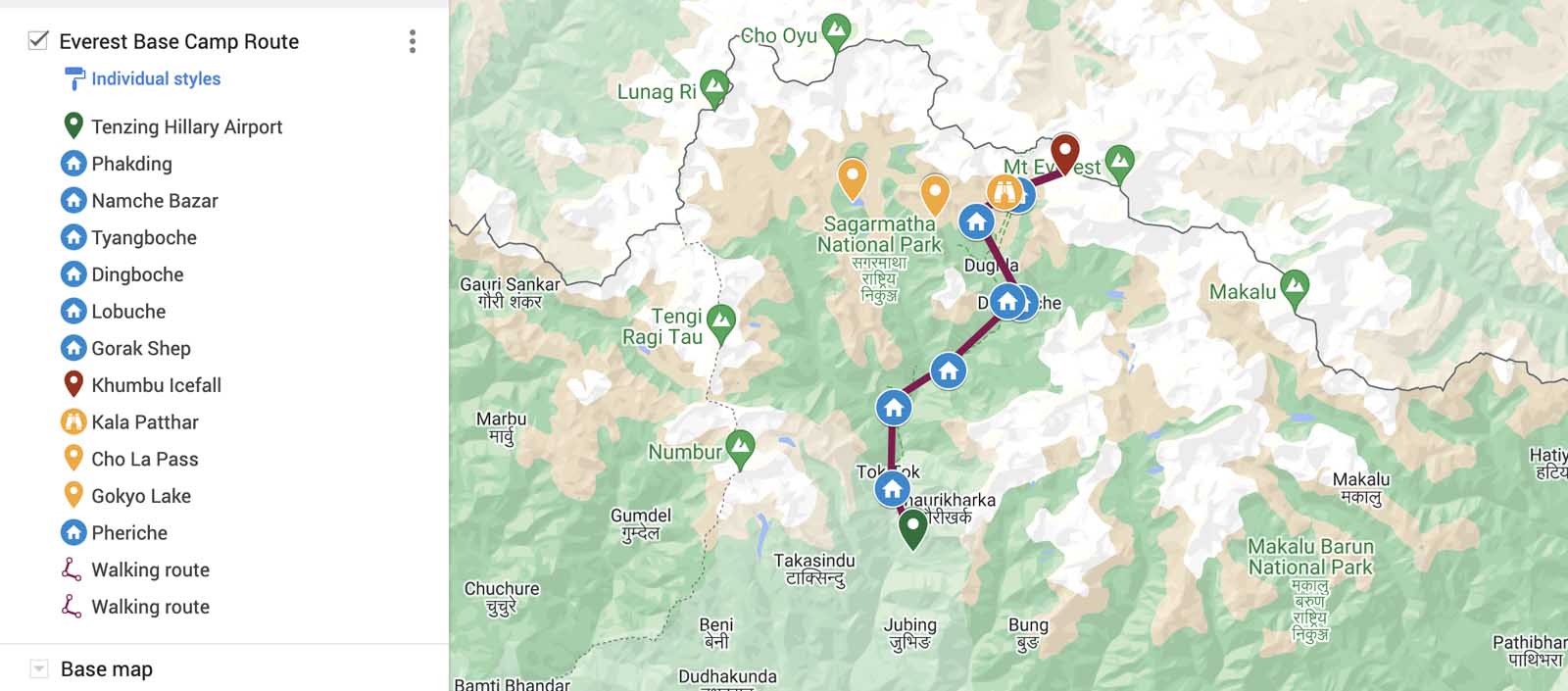
On the map, the Everest Base Camp trekking route distances look fairly easy to hike from village to village through the Khumbu Valley. Eight days may seem like it would be more than enough time to cover a mere 63 km (39 miles) one way, (128 km return) but with several sustained days in a row above 4000 meters (13,000 feet), the walk is slow and steady.
It is important not to push too fast to avoid altitude sickness which is a very real possibility. When trekking to Everest base camp, expect to hike anywhere from 7 – 17 km (4.5 – 10 miles) per day with the entire trek taking 12 – 14 days.
Hiring a Guide for the EBC Trek – Mandatory
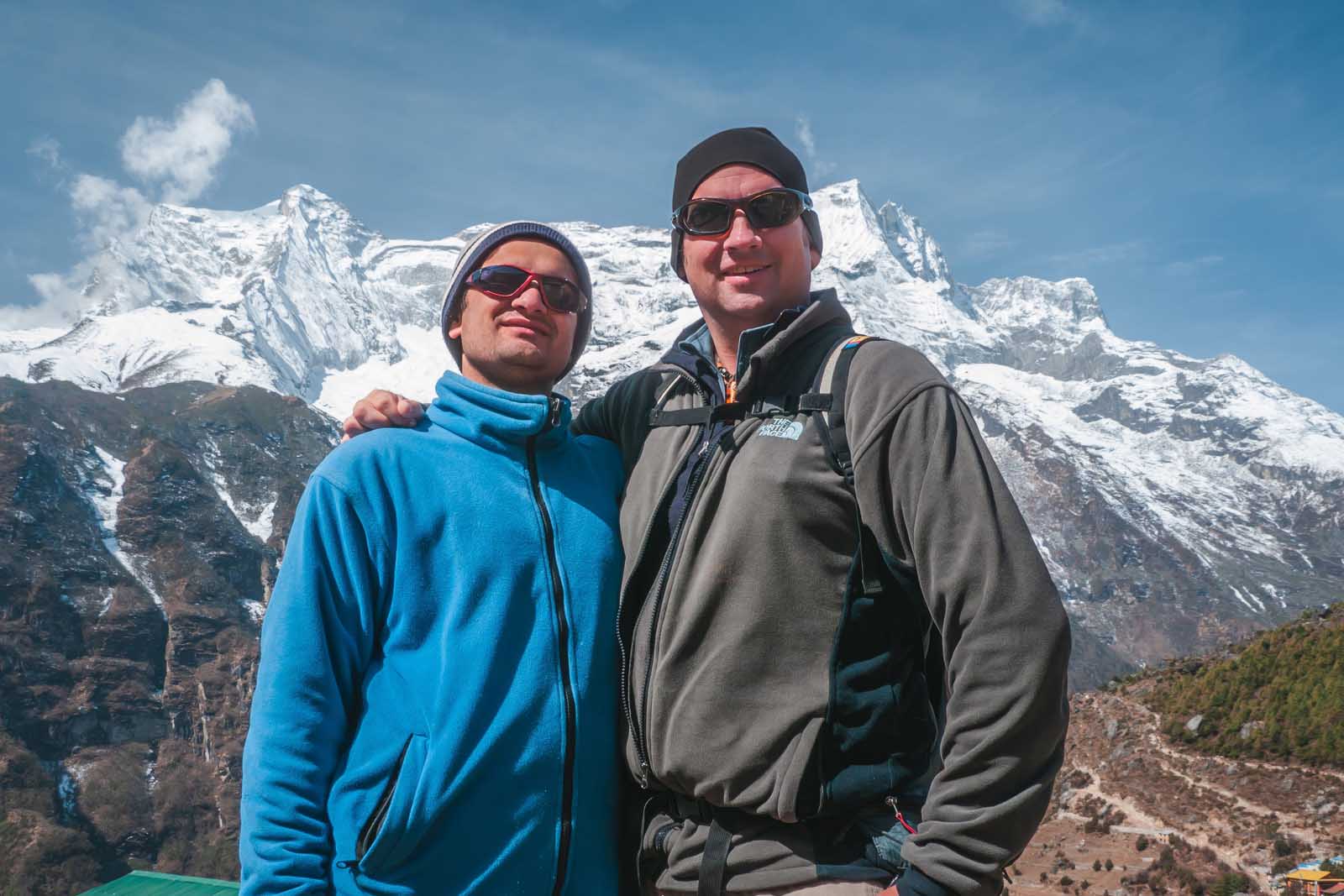
In April 1, 2023, Nepal has banned solo trekking. Foreigners must hire a guide for treks in high-altitude trekking regions of national parks. According to the Kathmandu Post in March “ solo or independent trekkers have to mandatorily hire a guide or a porter before setting off to Nepal’s mountains.” However, after an updated article in the Kathmandu Post, it seems that the Everest Region is an exception. Before booking, we would check with local companies and authorities as rules are constantly changing.
Book Locally
Many people book ahead of time with a tour company located outside of Nepal such as Intrepid Travel or GAdventures, but we hired locally and it saved a lot of money.
Plus, you know your money is going directly to the local economy and you have a more intimate experience by trekking with a local guide. We spent a couple of days in Kathmandu looking for a guide to Everest and found Simrik Real Nepa l owned by Kathmandu resident Dipendra Simkhada.
Dipendra planned the entire trip for us, and all we had to do was wait for him to pick us up at our guesthouse in Kathmandu to take us to the airport to board our Tara Air flight to Lukla Airport. Book your Trek to Everest Base Camp with Simrik Real Nepal – A Locally owned and operated tour company, Simrik is located in Kathmandu.
Kathmandu – The Hub of Nepal Treks
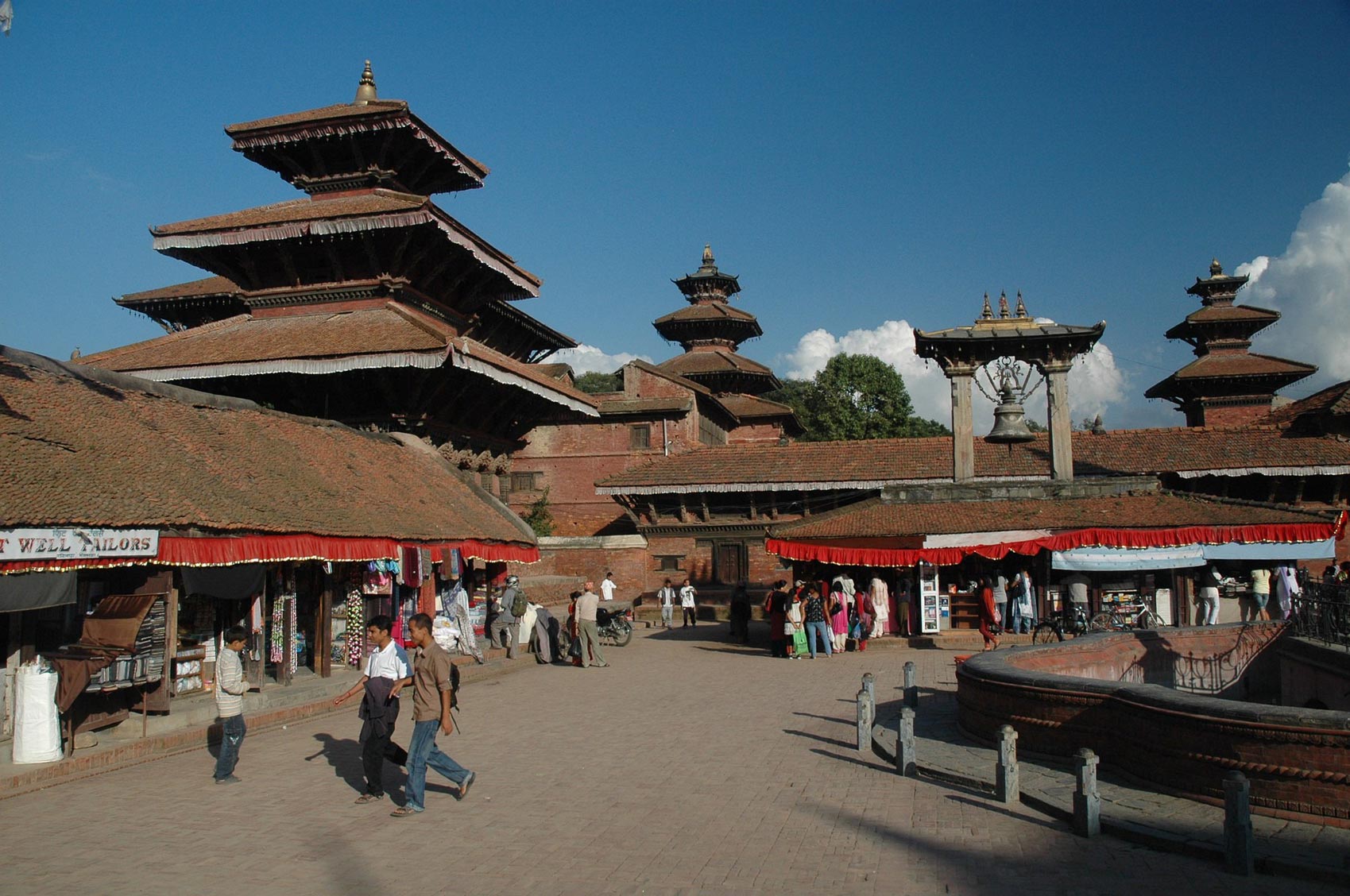
We spent a few days in Kathmandu picking up supplies and doing some sightseeing before trekking to Everest. We suggest not spending too long here as it can be very polluted in Kathmandu and by the time we were ready to trek, I was already quite congested.
Our recommendation is when you arrive in Kathmandu, only spend two to three days to get yourself organized and instead do your sightseeing at the end of your trek. Read more: Top Places to visit in Kathmandu, Nepal
Day 1: Fly from Lukla Trek to Pakhding
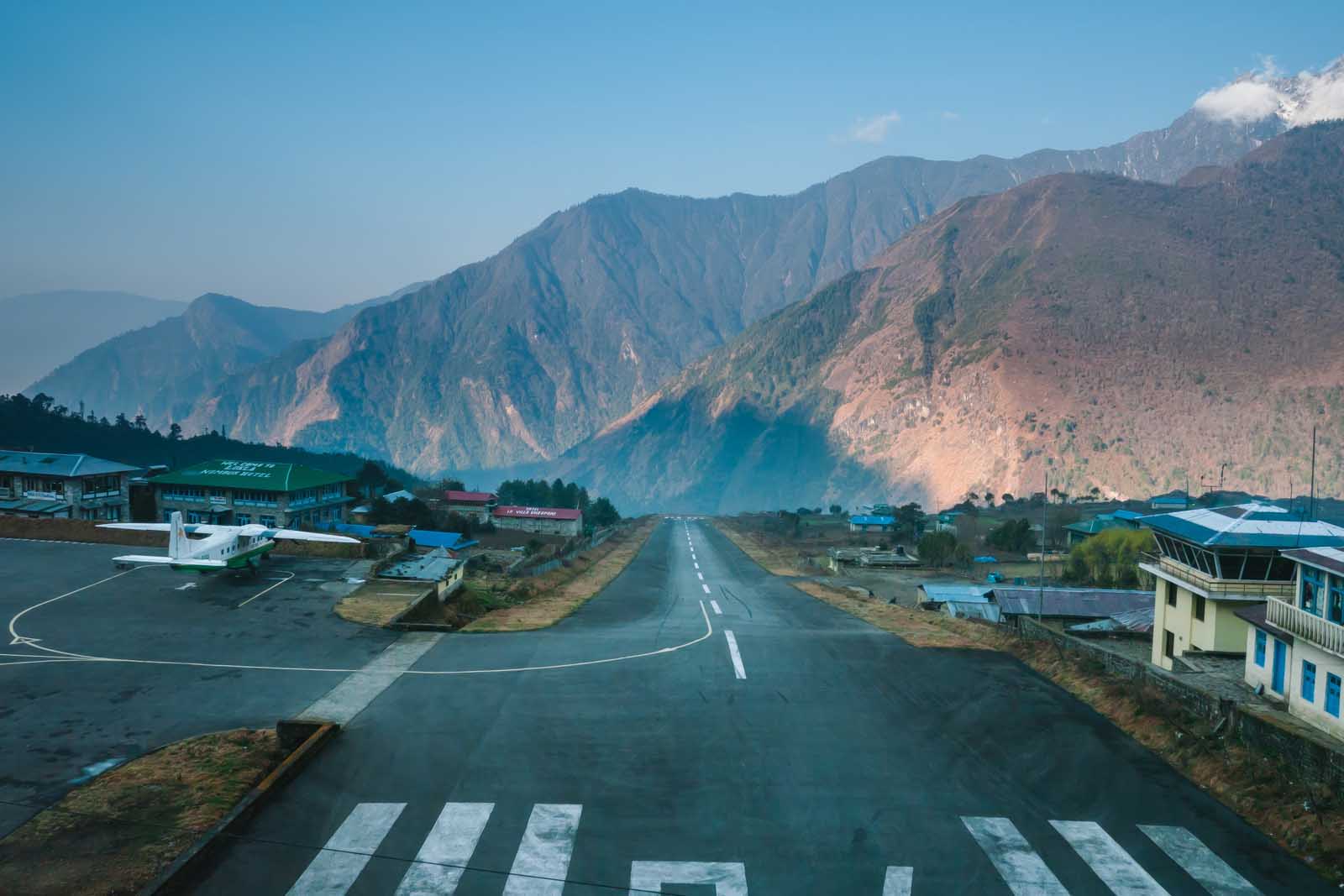
Flights to Lukla no longer leave from Tribhuvan International Airport (Kathmandu Airport) in Kathmandu due to congestion. Flights are now out of Ramechap airport which is a 4 1/2 hour drive from Kathmandu. You can book private helicopters from Tribhuvan International Airport.
The flight from Ramechap airport is much shorter than the flight from Tribhuvan International Airport. Flights to Lukla are only 12 minutes so more flights can get through when the weather is clear making flights less likely to be canceled or delayed for too long.
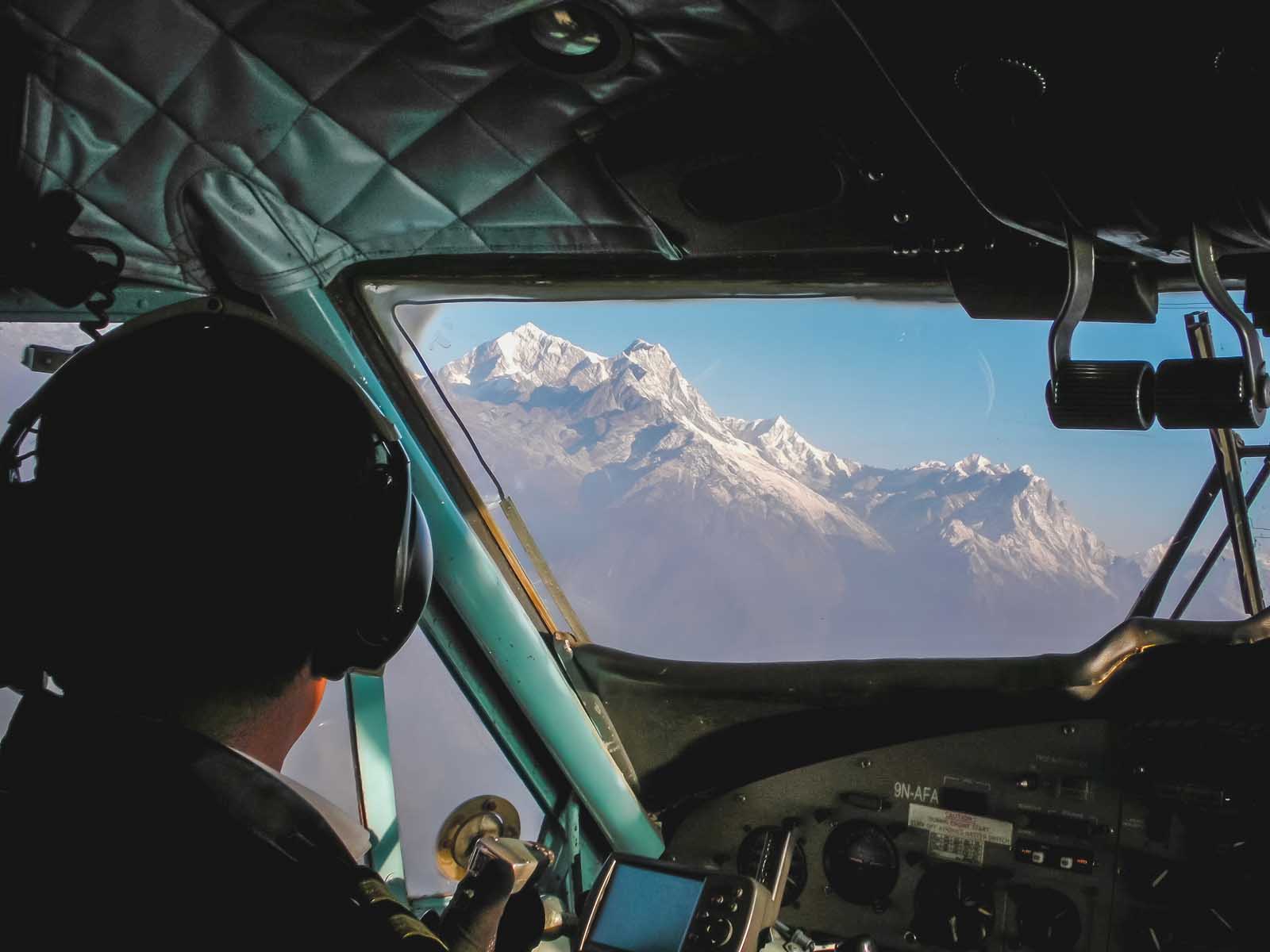
The flight to Lukla is a scary flight and is considered one of the most dangerous in the world. We flew from Kathmandu but flights now are much shorter from Ramechap. I think I would like it better as we sat at the front of the plane and saw the pilot’s instruments constantly flash “ obstacle ahead. ” It looked as if we were about to crash into a mountain at any time. Read all about our flight to Lukla and watch the video here
Watch Us Fly to Lukla Airport
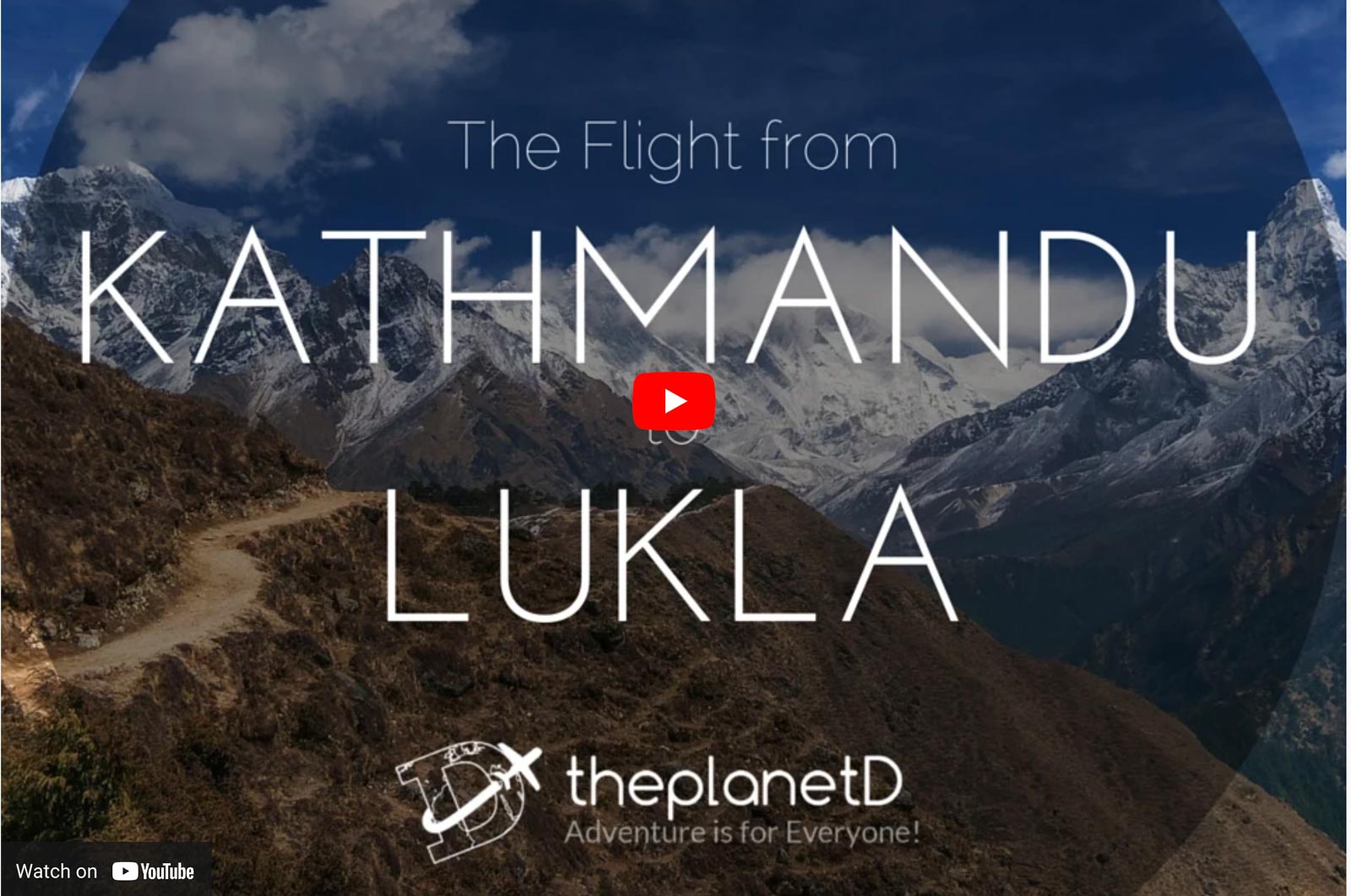
The Lukla airstrip at Lukla Airpot is a short landing strip at only 525 meters (1,729 feet long.) Built on the side of a mountain it is also a very steep grade that is needed to slow the planes down quickly. Needless to say, we held our breath during the landing.
We survived that flight, but it was the flight back to Kathmandu I was nervous about. Taking off on that short of a runway was a hair-raising experience. One false move and we’d drop thousands of feet into the valley below. Lukla Airport is actually called Tenzing Hillary Airport named after the first two men to summit Mount Everest.
Hiking from Lukla to Pakding
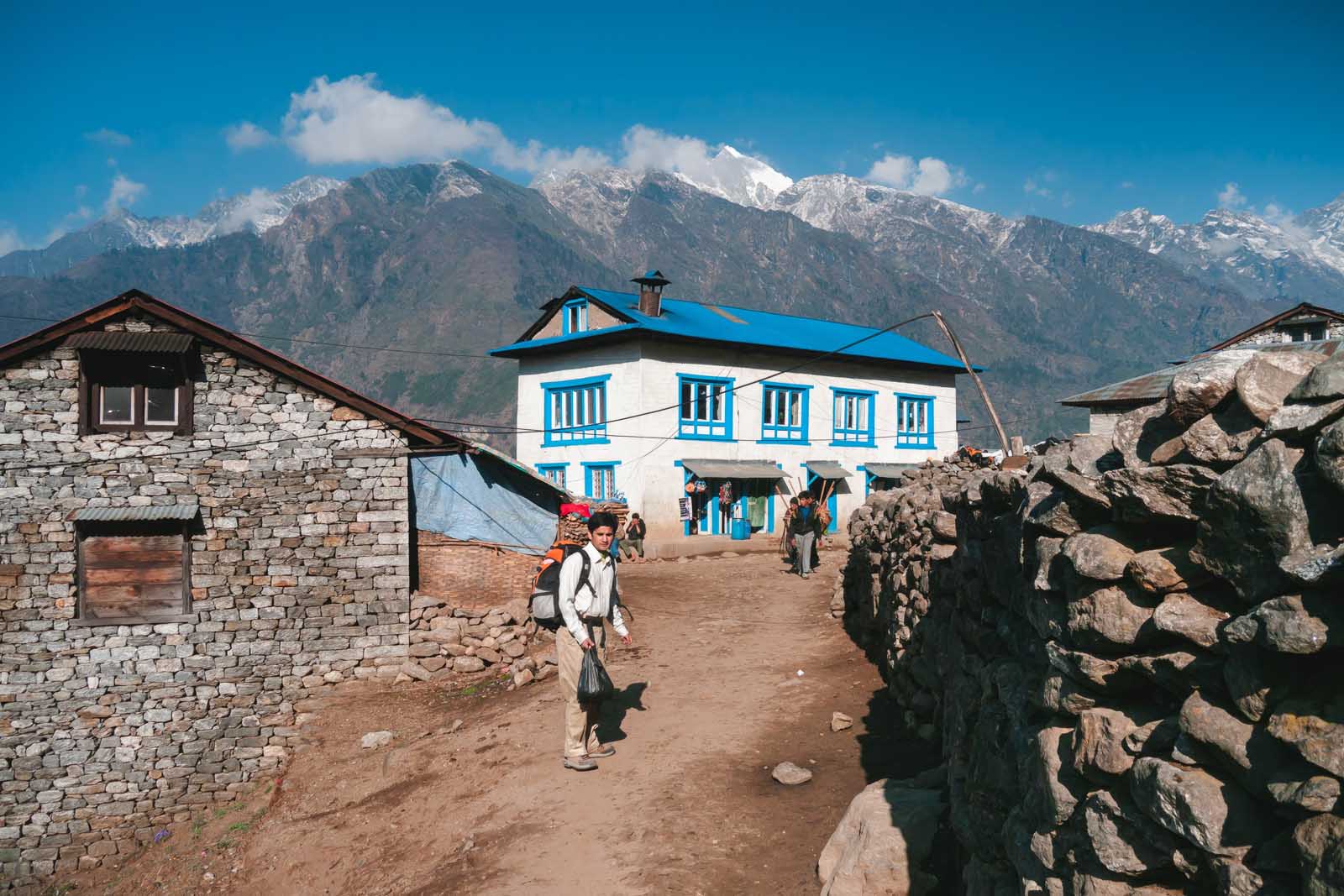
The trek begins officially in Lukla. Lukla is a busy town with plenty of accommodation, shops, and eateries. If you forgot anything for your EBC trek, you can pick up supplies in a pinch. But we suggest purchasing all your gear in Kathmandu. It is much cheaper.
From Lukla, we immediately started our Everest Base Camp hike. After a quick snack and a cup of tea in Lukla, we set off on an easy three-hour trek along trekking trails that were easy to follow weaving through villages, crossing rivers, and stumbling over stony paths.
Entering Sagarmatha National Park
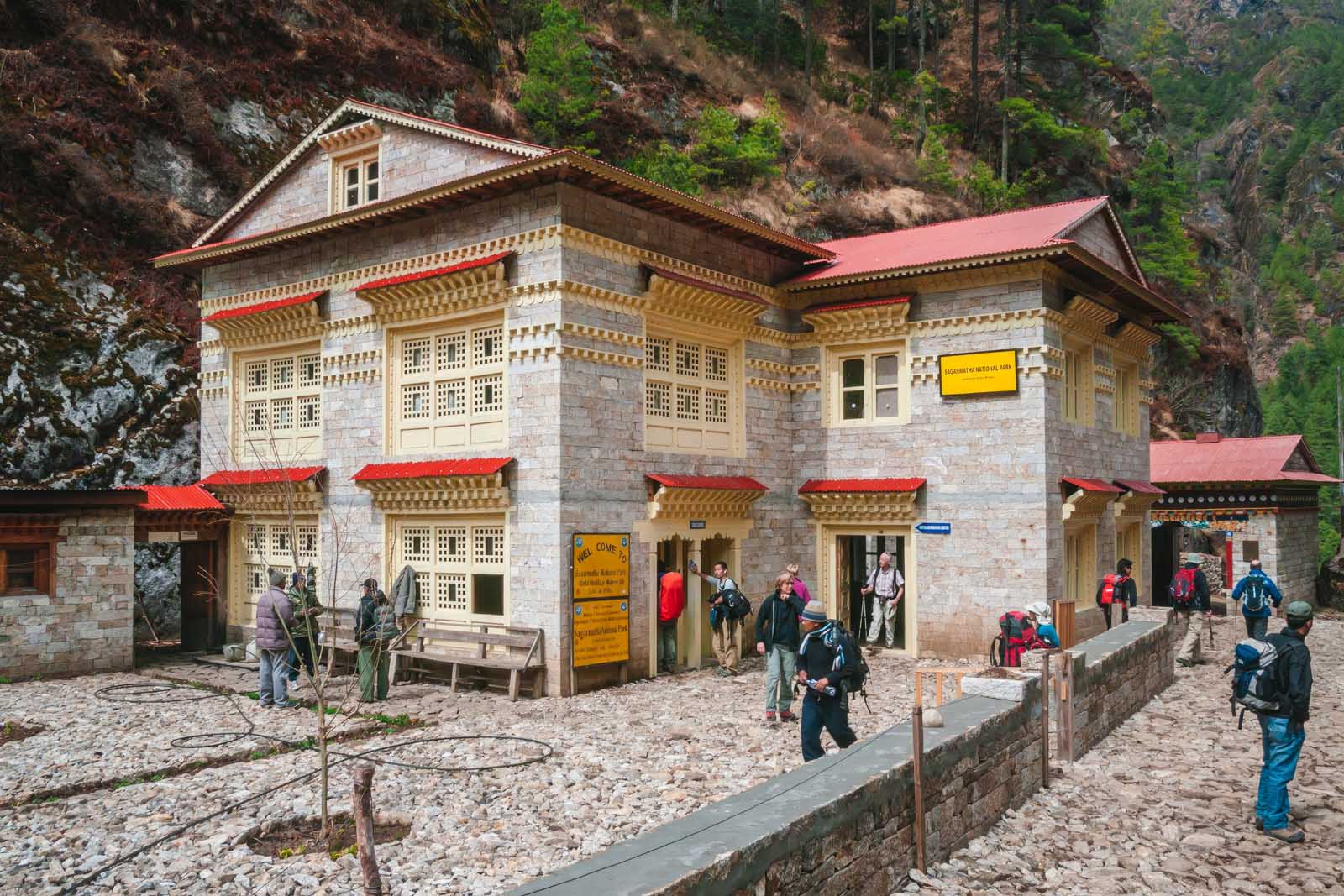
A permit is needed to hike to Everest Base Camp as it is located in Sagarmatha National Park. We checked in with the national park headquarters and Dipendra took care of everything. He had all our paperwork in order so all we had to do was start walking through the beautiful Khumbu Valley to make our way to Everest base camp.
Sagarmatha National Park has been a UNESCO World Heritage Site since 1976. At 1148 square km (443 square miles) in area, it is one of the most beautiful places we have ever visited.
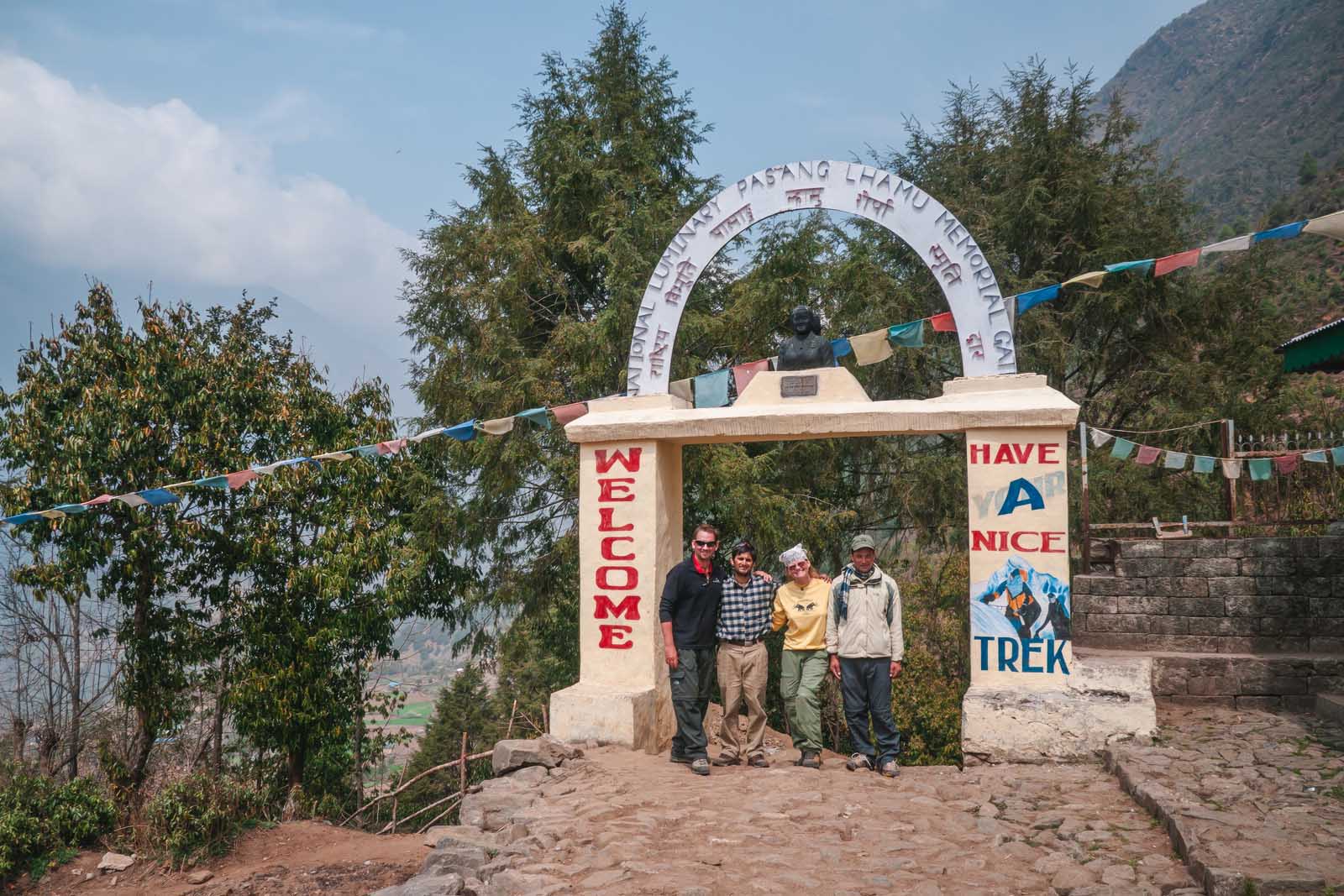
We felt giddy stepping through the welcome gates located just outside of Lukla. This was it, we were following in the footsteps of the great adventurers of our time. It was awe-inspiring to hike through the Khumbu region surrounded by the Himalayas.
As we hiked out of Lukla, Dipendra pointed out the surrounding jagged white peaks named Kwangde, Mumbu, and Kishumkongara. At 6000+ meters, (19,000+ feet) these are the “little guys” of the world’s highest mountain range. It wouldn’t be long until we were among the famous 8000-meter (26,000 feet) peaks.
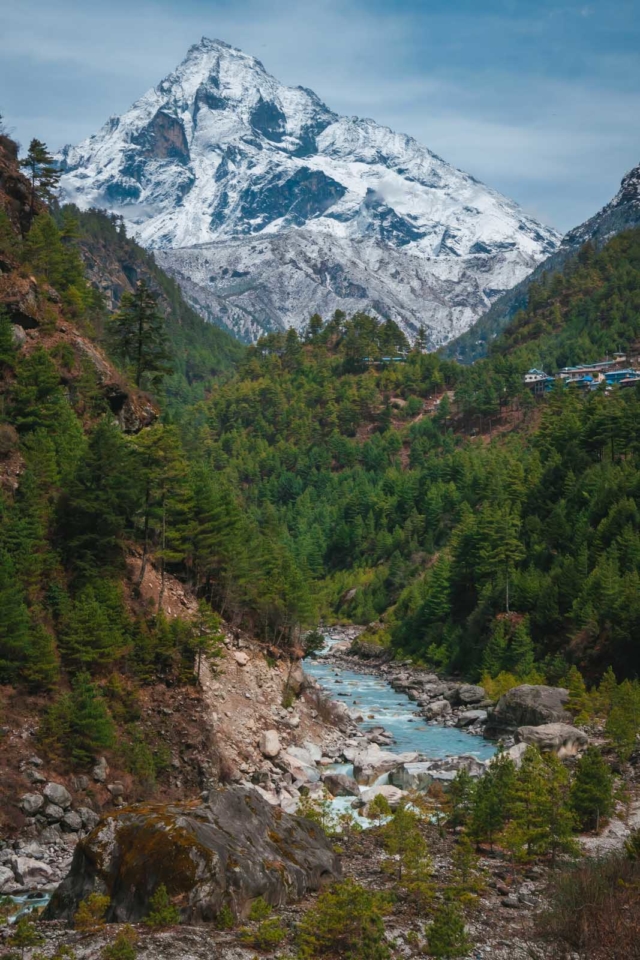
Our first day was filled with a relaxing walk while learning about the Khumbu region. It was quite early in the day, so we had plenty of time to take our time to learn about the customs of climbing and learn the names of the mountains found in this beautiful region of Nepal.
For the rest of the day, we followed the Dudh Koshi River Valley at a steady but leisurely pace to the village of Pakding. Temperatures were warm and the first day of trekking was comfortable. Lukla to Pakding actually has an elevation loss, so it is a good introduction to hiking through the region as we had a lot of downhill trekking.
After about 5 hours, we came to our first night on the trek where we spent the night in a comfortable teahouse in the village of Phakding.
Our First Night on the EBC Trek
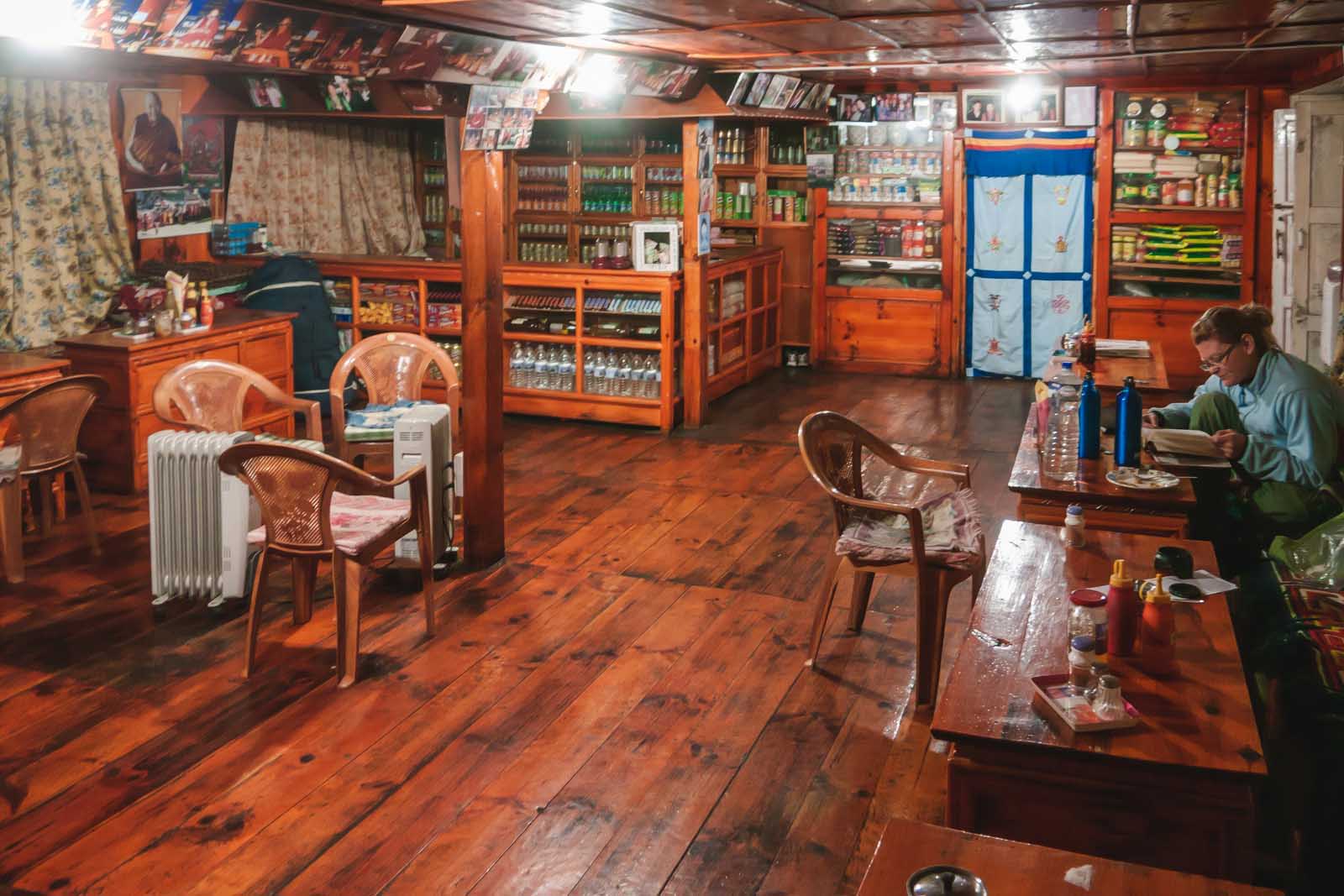
The accommodation in Pakding was a quaint little hotel/teahouse that looked like a cottage. The wood-burning stove smelled delicious as it warmed the restaurant while they prepared our meals.
Our porter “Sher” carried all our supplies including the sleeping bags that we borrowed from our trekking company. We each rented a sleeping bag that was included in the price of our EBC trek. The beds were comfortable and Dave and I had private rooms. Some tours use dorm rooms but we had private rooms. Toilets were shared, but everything was clean and comfortable. The rooms were clean and we slept like rocks snuggled up in our thick down sleeping bags.
Heated Lodges – Teahouses on the EBC Trek
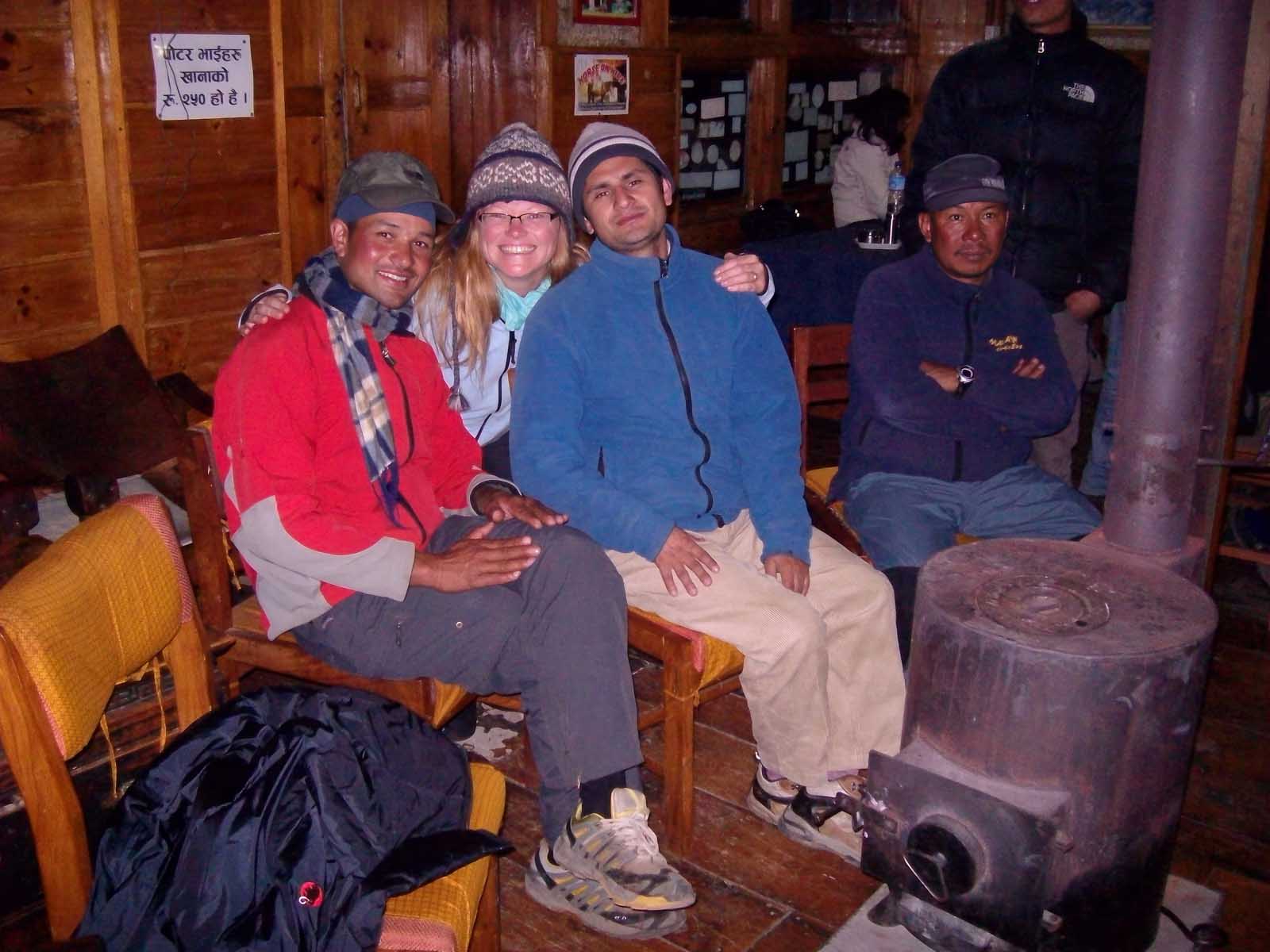
During the EBC Trek, you don’t stay in tents. You stay in charming teahouses with cozy beds, wood-burning stoves, and fully stocked restaurants that serve dinner.
The teahouses are a welcoming sight after a long day of trekking helping to make the trek to Everest one of the most memorable experiences of our lives. If you are planning to trek to Everest Base Camp in Nepal, read on for all the information you’ll need to help you prepare.
The main lodges of each teahouse we stayed in during the first half of our EBC trek were cozy and warm. At the lower elevations, woodstoves burned wood in the dining room and common areas and our rooms were a comfortable temperature with heating as we were wrapped up in our sleeping bags. We ate hearty meals of pasta and meat and enjoyed a relaxing night soaking in the amazing day we just had on the mountain.
- From Lukla – Elevation 2869 meters (9,350 feet)
- To Pakding – Elevation 2610 meters ( 8563 Feet)
- Length – 7.7 km (4.78 miles)
- Elevation loss – 79 meters (259 feet)
- Duration – 3 Hours
Day 2 – Pakding to Namche Bazaar
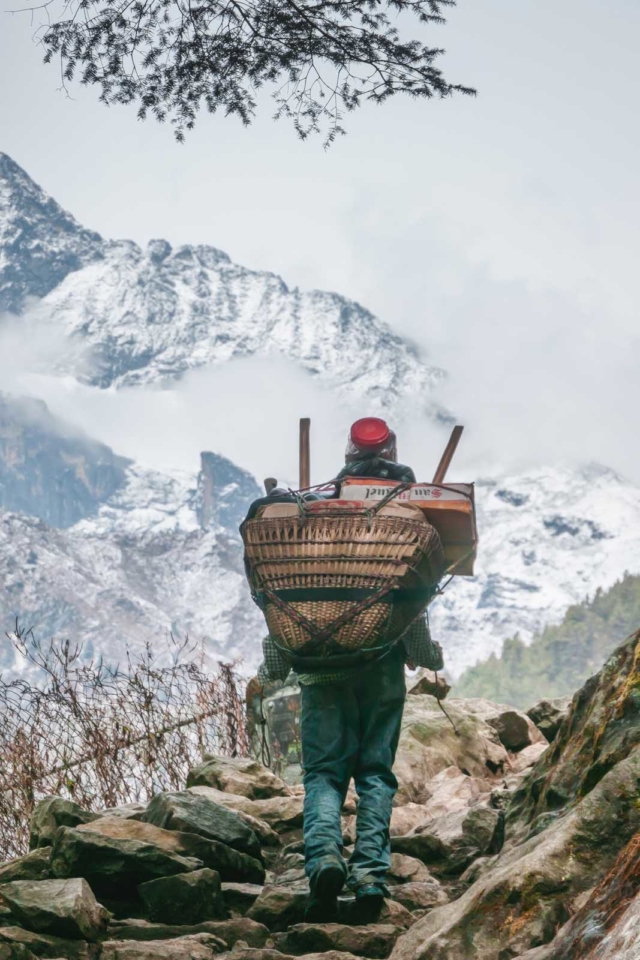
On day two, we checked in at another gate of the Mt. Everest park headquarters to show our documentation. We had to show our passports and give them extra passport photos to go into the log. (So make sure you have extra passport photos with you) Once we signed in, we were officially in the Khumbu region and officially on our way trekking to Everest Base Camp.
We covered a lot of terrain on day two making it the longest day of the Everest Base Camp trek. The trail up the mountains was steep and challenging but it was a memorable day.
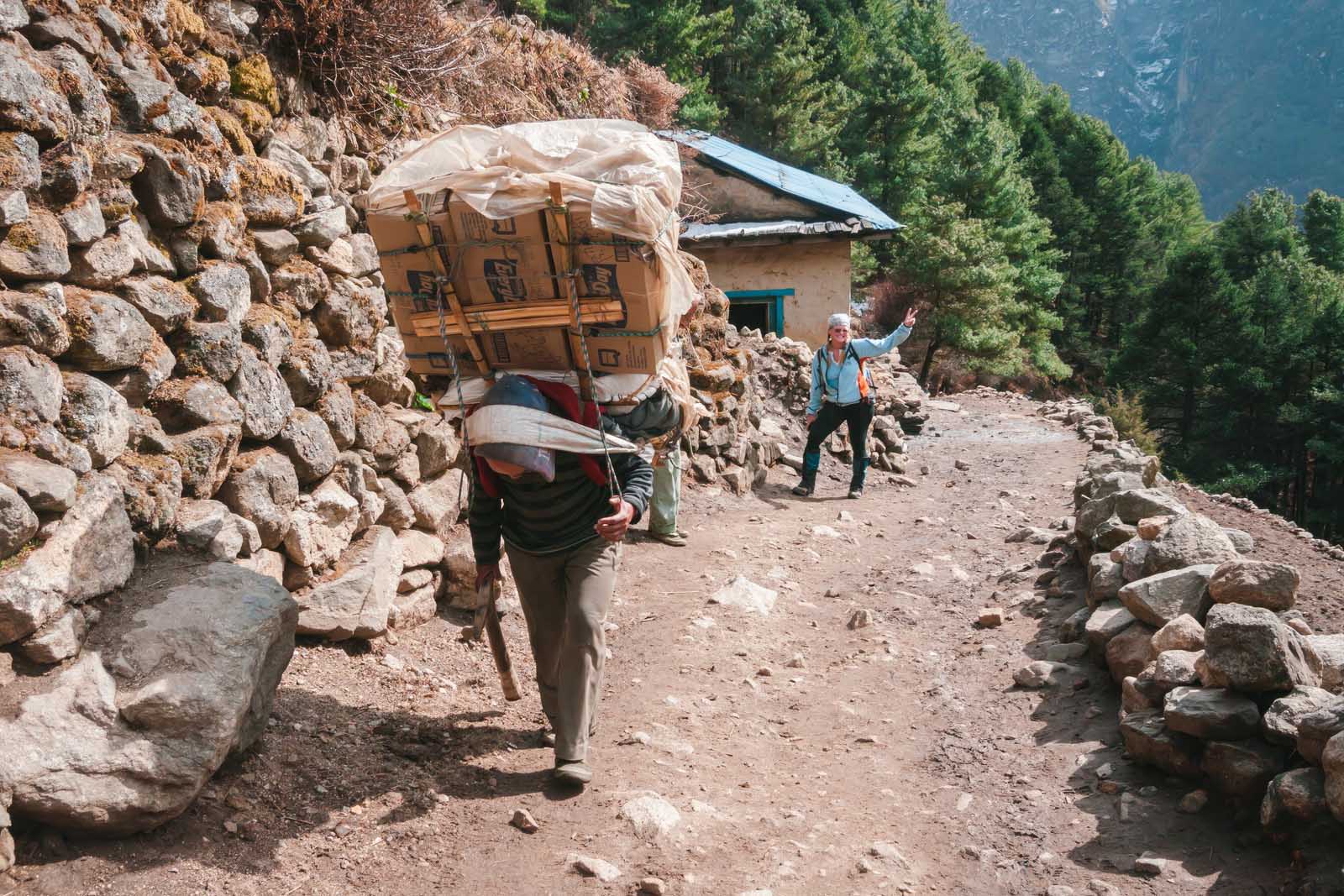
Day two of the EBC trek was a hike of almost 10km (6.2 miles) with an elevation gain of 800 meters (2624 feet). But throughout the hike, there was a lot of elevation loss mixed in so it felt like a lot more.
We would lose elevation as we descended into the valley only to have to climb back up again to a higher elevation. Today was a lot of fun though because we crossed several suspension bridges over Dudh Kosi River Valley.
Suspension Bridges on the way to Everest
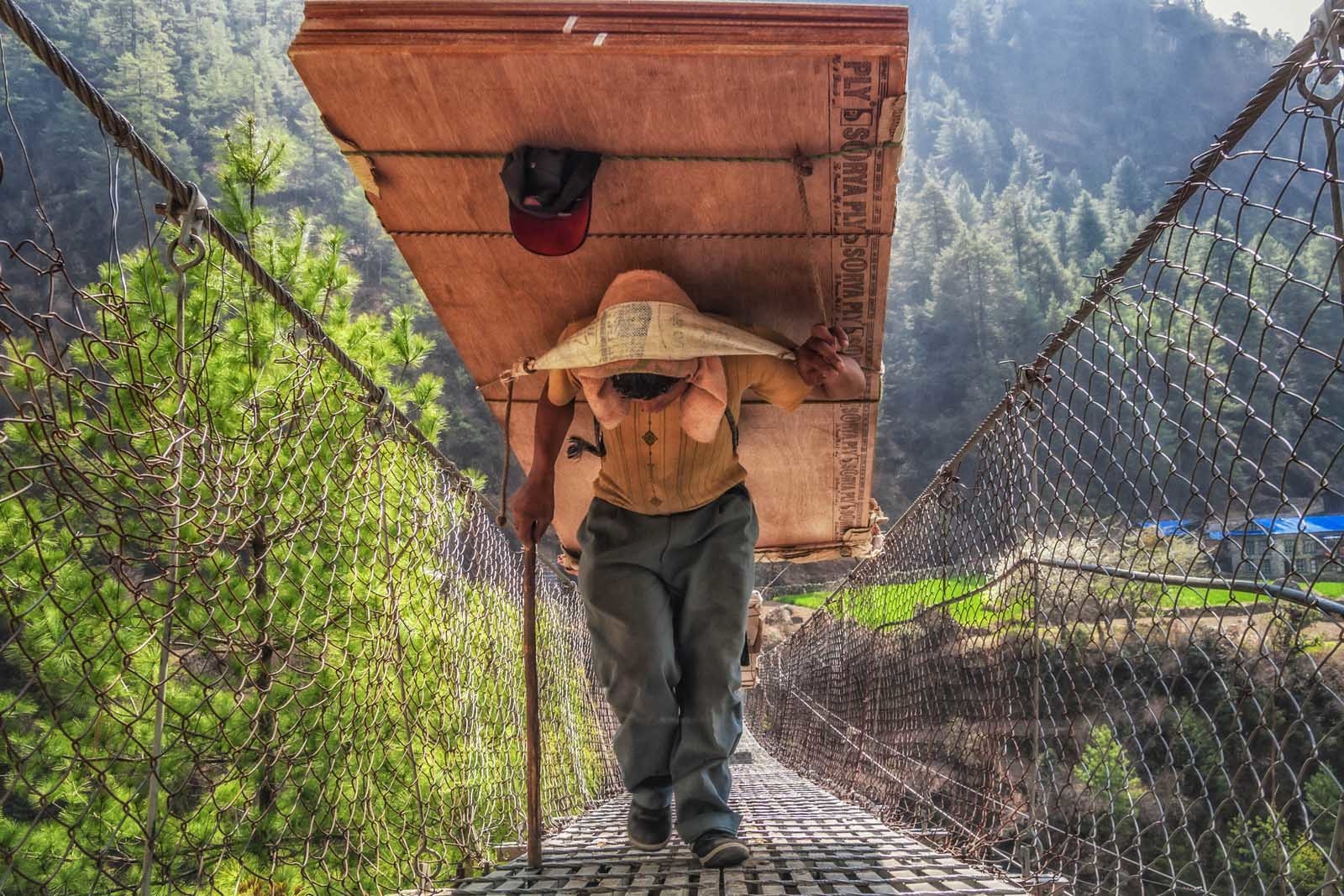
If you have a fear of heights, crossing suspension bridges may not be your favorite moment, but the suspension bridges while trekking to Everest Base Camp are well constructed, made of steel, and in excellent condition.
I was nervous about the suspension bridges. The Lonely Planet Guide said, “ Grit your teeth and climb onto a drooping suspension bridge floating at a dizzying height .” That sentence freaked me out.
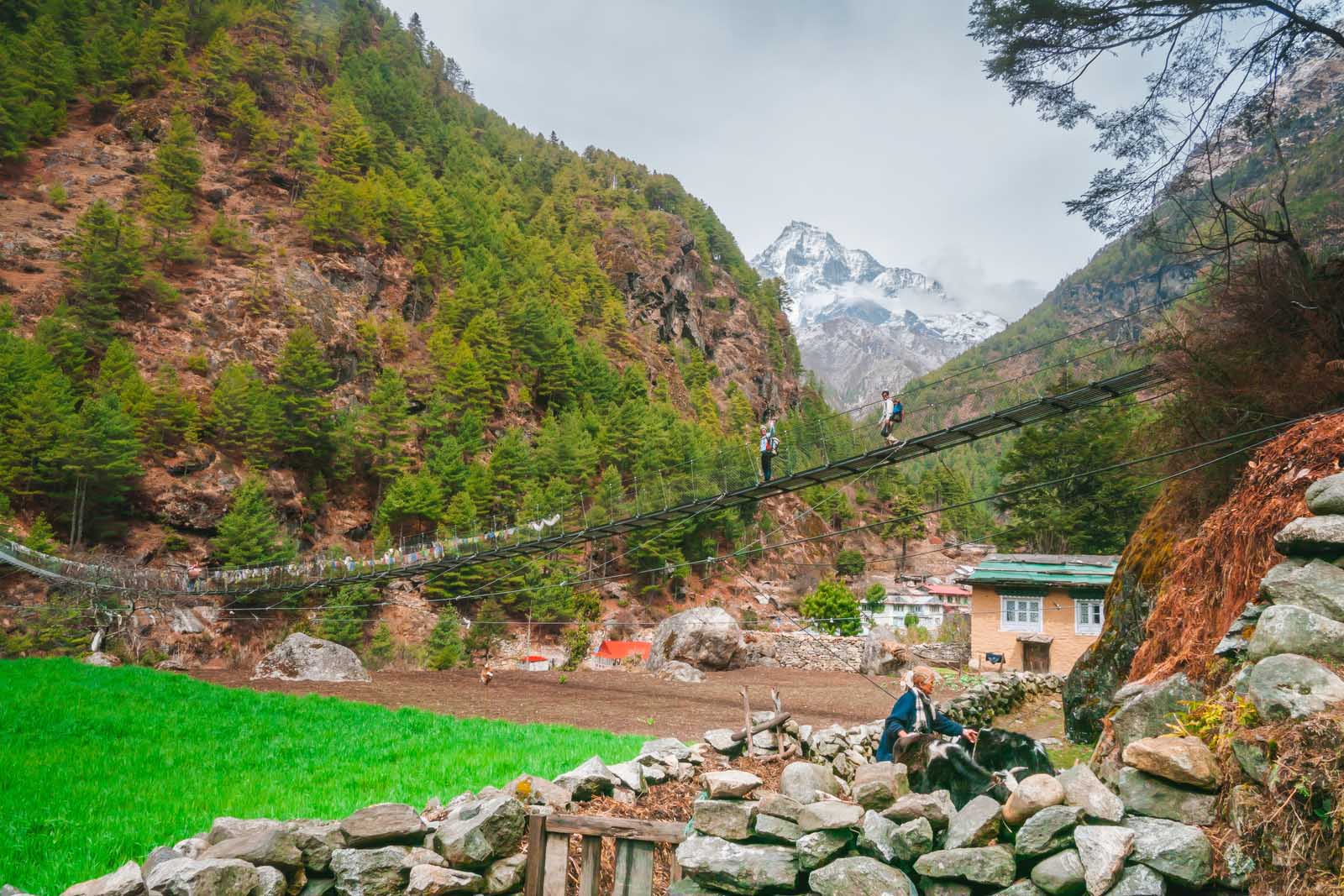
I had built the suspension bridges of the EBC trek in my head as something monstrous. But by the time we reached the first bridge, I wondered what all the fuss was about. Once I crossed my first bridge, my confidence was up and I was ready for anything the Everest trek was ready to throw at me.
Donkey Trains
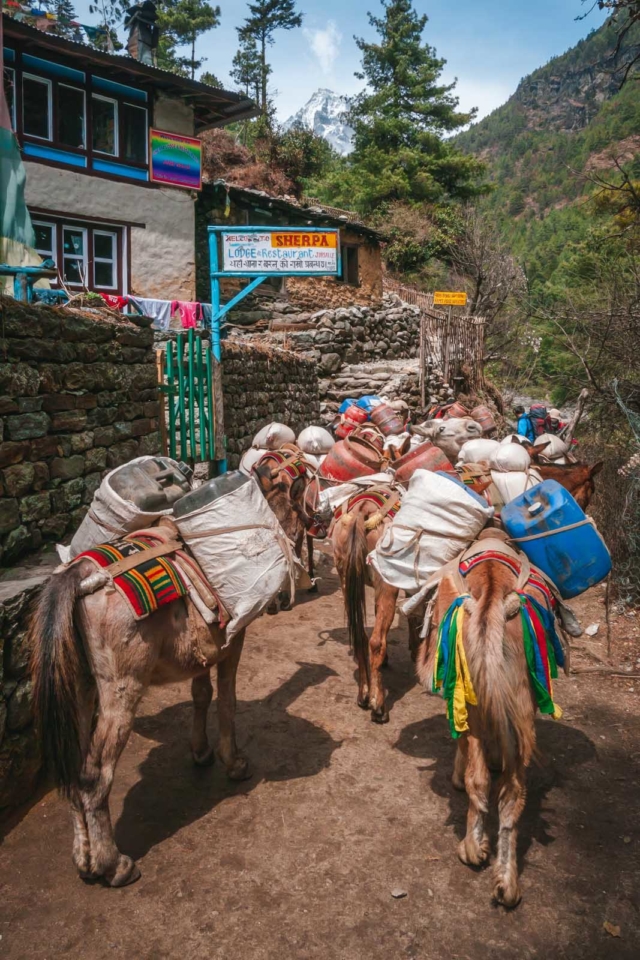
Today we also started to see a lot of donkeys, cows, and goats taking supplies to the villages. Traffic can get very heavy on the Everest Base Camp hike. When animal trains go by, make sure to get out of their way and stay to the side.
They are loaded down with heavy gear and they have a mission to keep on walking until they are done. They can easily nudge you right off the side of a cliff as no matter what is in their way, they just keep walking.
The trail is a highway, but instead of transport trucks or trains carrying cargo, people and farm animals carry everything from lumber and building supplies to food and kitchen appliances.
Safety Tips on the Everest Base Camp Trek for yaks and donkeys
- Important Tip: When a yak, donkey, or cow train passes you during the EBC trek, be sure to stand on the mountainside of the trail so they can’t push you over the edge !
- It is better to be squished into a mountainside than to go tumbling over the edge!
Final Stretch to Namche Bazaar
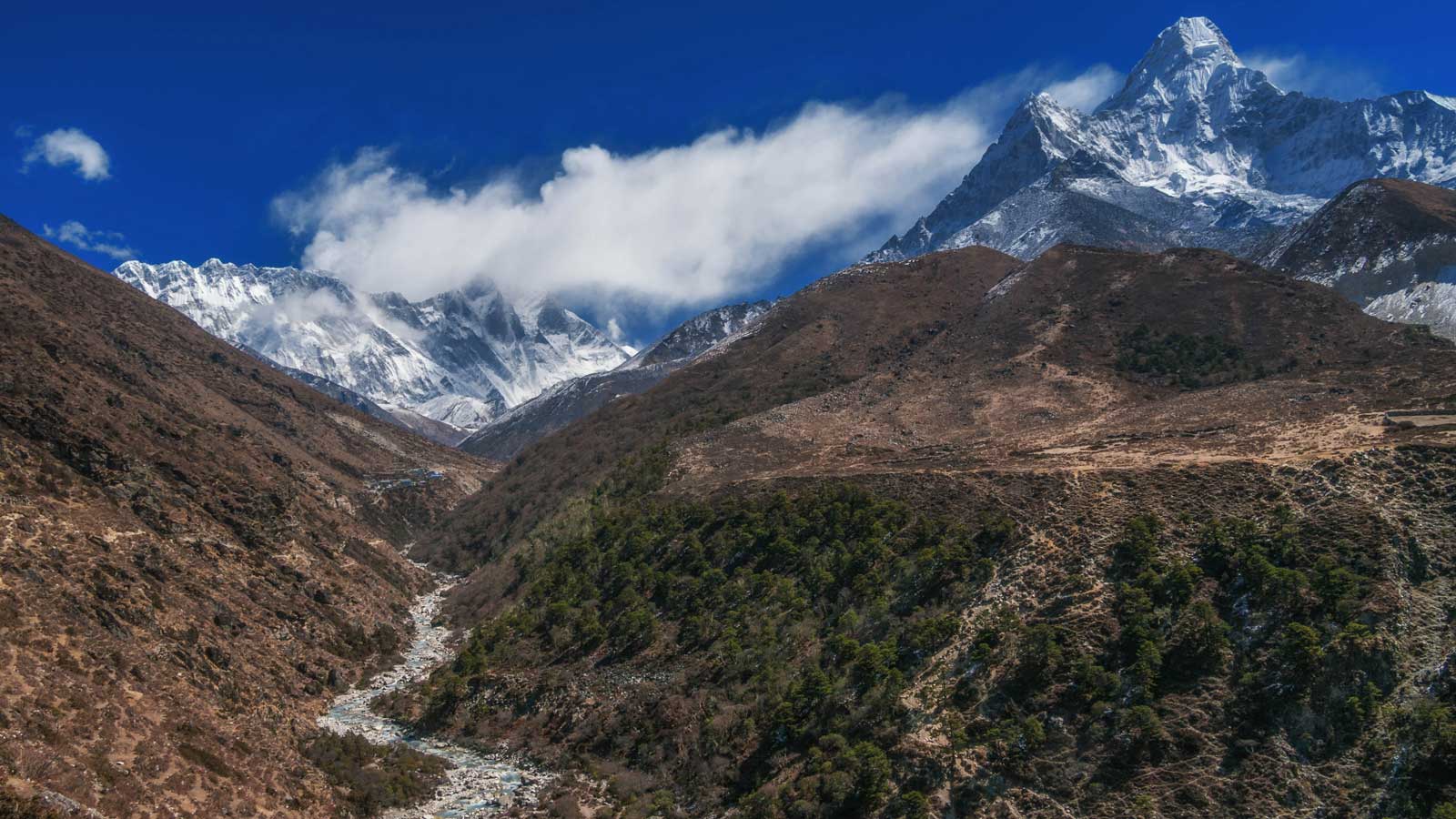
Right after crossing the last bridge, the hardest part of day two of trekking to Everest base camp started The last push of the day consisted of 2-hours straight uphill to Namche Bazar.
We were drenched with sweat but the air was cool. Whenever we stopped for a break, we would get a chill so we just kept on chugging away.
Large tour groups passed us quickly, only to be caught a few minutes later as they rested. We realize that we were the tortoise and they were the hare! Slow and steady is the way to climb at high altitudes and in the end, we made it to Namche Bazaar with plenty of time to spare in the day.
Arrival to Namche Bazaar
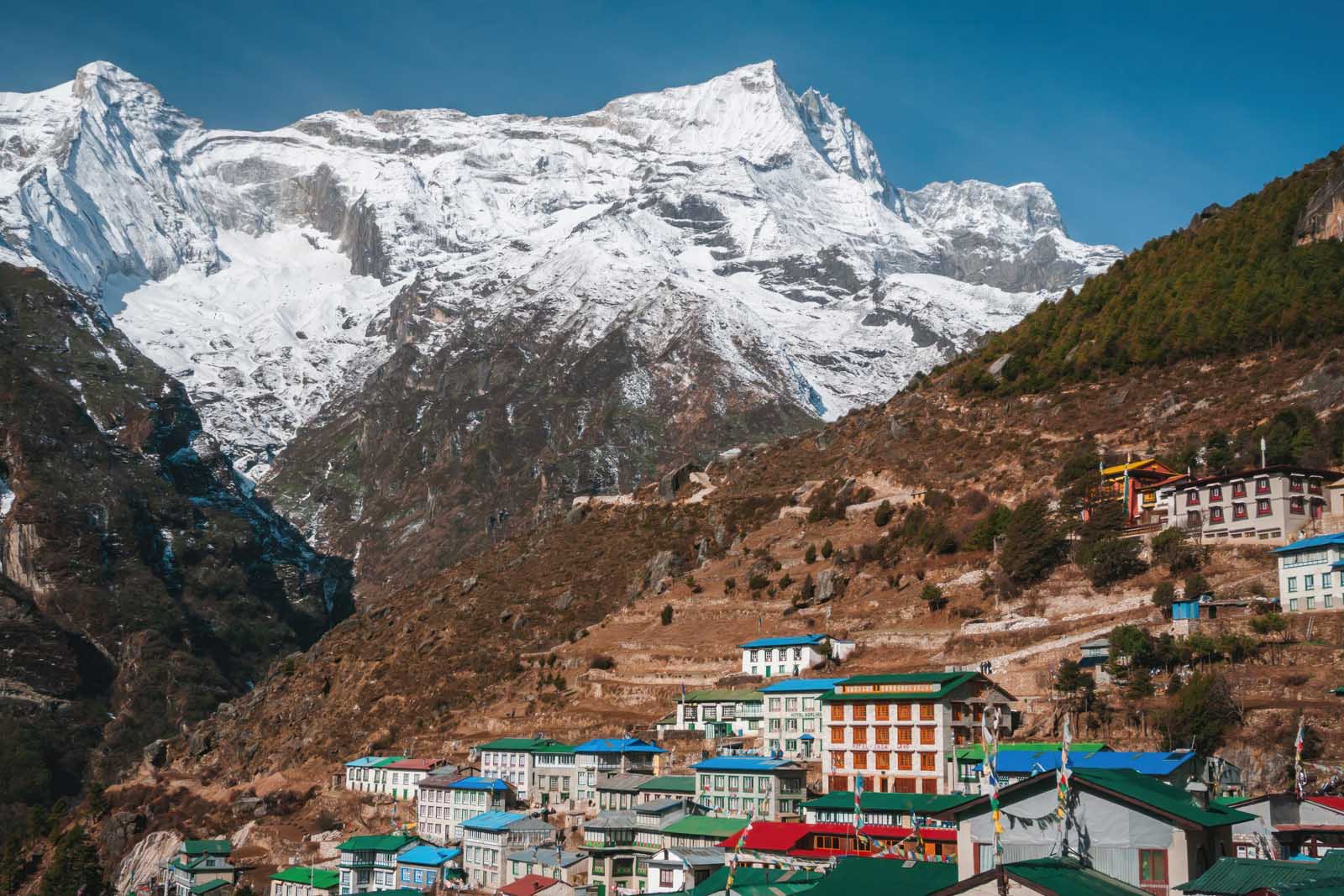
We checked into the security post and cringed when we found out that our lodge was an uphill walk for another 20 minutes. Rest had to wait a bit longer.
When we arrived at our accommodation, we were thrilled to see our porter Sher’s smiling face. He had already checked us in and put our bag in our room. We immediately went for a nap and then did a little walking around town in the evening to do some shopping and grab a bite to eat before turning in for an early night.
There are plenty of shops and restaurants at Namche Bazaar, this town is bustling and we spent two nights of our EBC Trek here which was awesome.
Pakding – Elevation 2610 meters ( 8563 Feet) Namche Bazaar – 3440 meters (11,286 feet) Elevation Gain – 830 meters (2723 feet) Distance – 10km (6.2 Miles) Duration – 6 hours
Day 3 – Acclimatization Day at Namche Bazaar
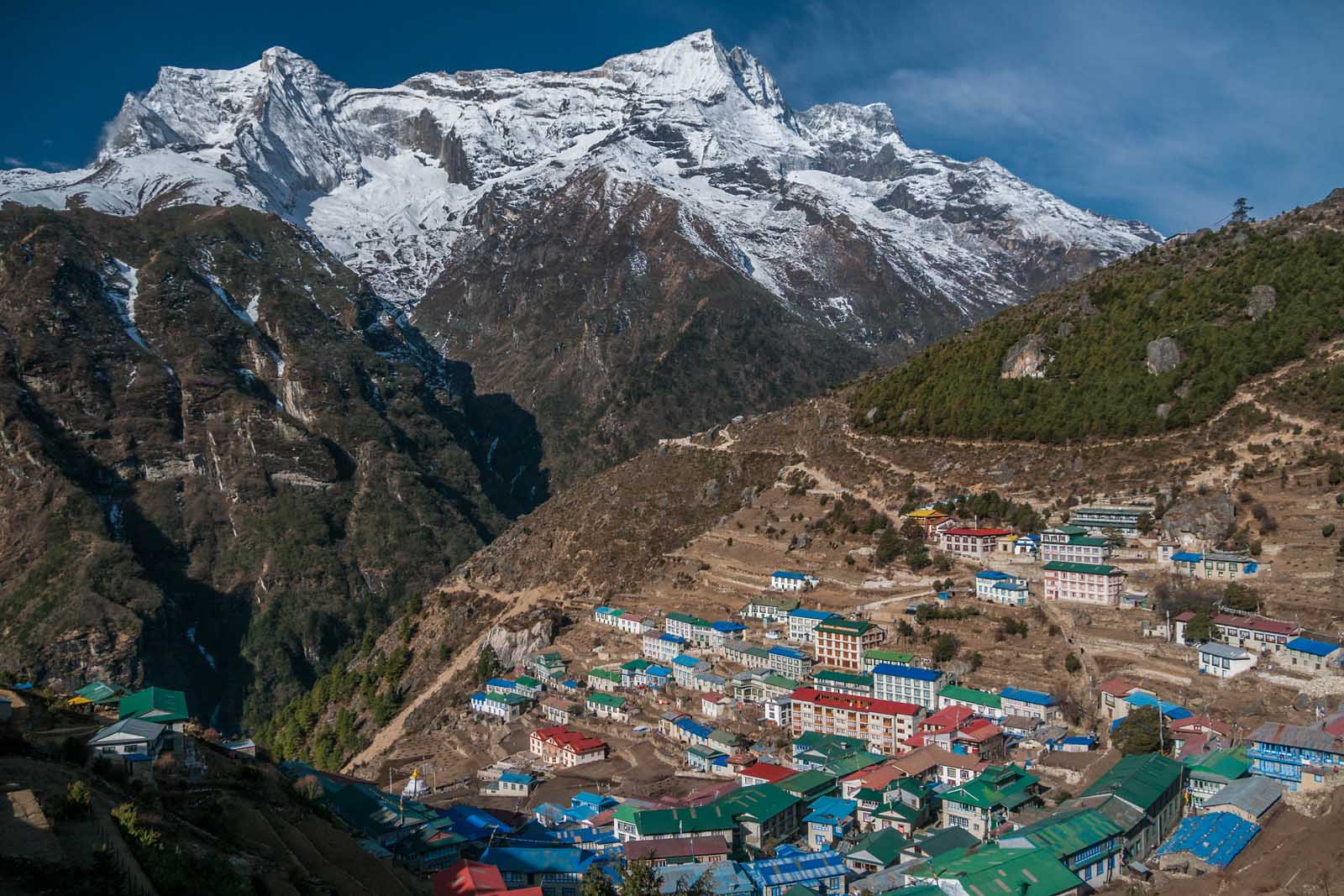
We had two glorious days at Namche Bazaar. Dipendra chose great accommodation for us throughout our EBC trek and we had a good rest in this splendid teahouse where we enjoyed delicious pasta, meats, and of course dhal baht. We spent the morning enjoying coffee and doing a bit of shopping.
What to do in Namche Bazaar
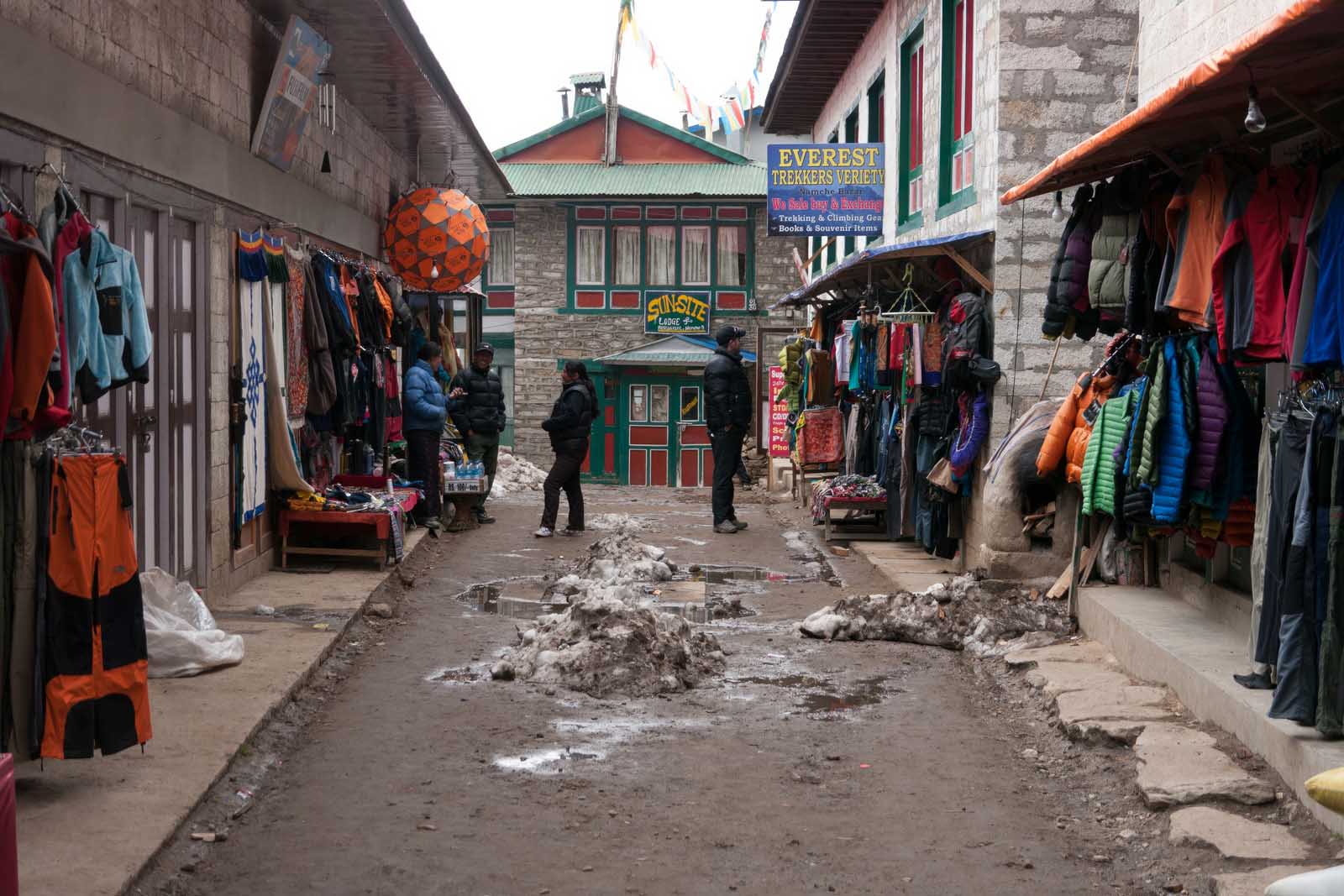
We explored Namche Bazaar and checked out its many shops. The streets are packed with shopping stalls and markets. We searched for gear that we missed getting in Kathmandu and got some great deals. We were surprised the prices weren’t inflated at Namche Bazaar.
We bought some down booties to keep our feet warm at night, a couple of sherpa hats, and a warmer set of gloves. The Everest Bakery was a highlight with delicious apple pie, fresh coffee, and WiFi. We had two pieces each!
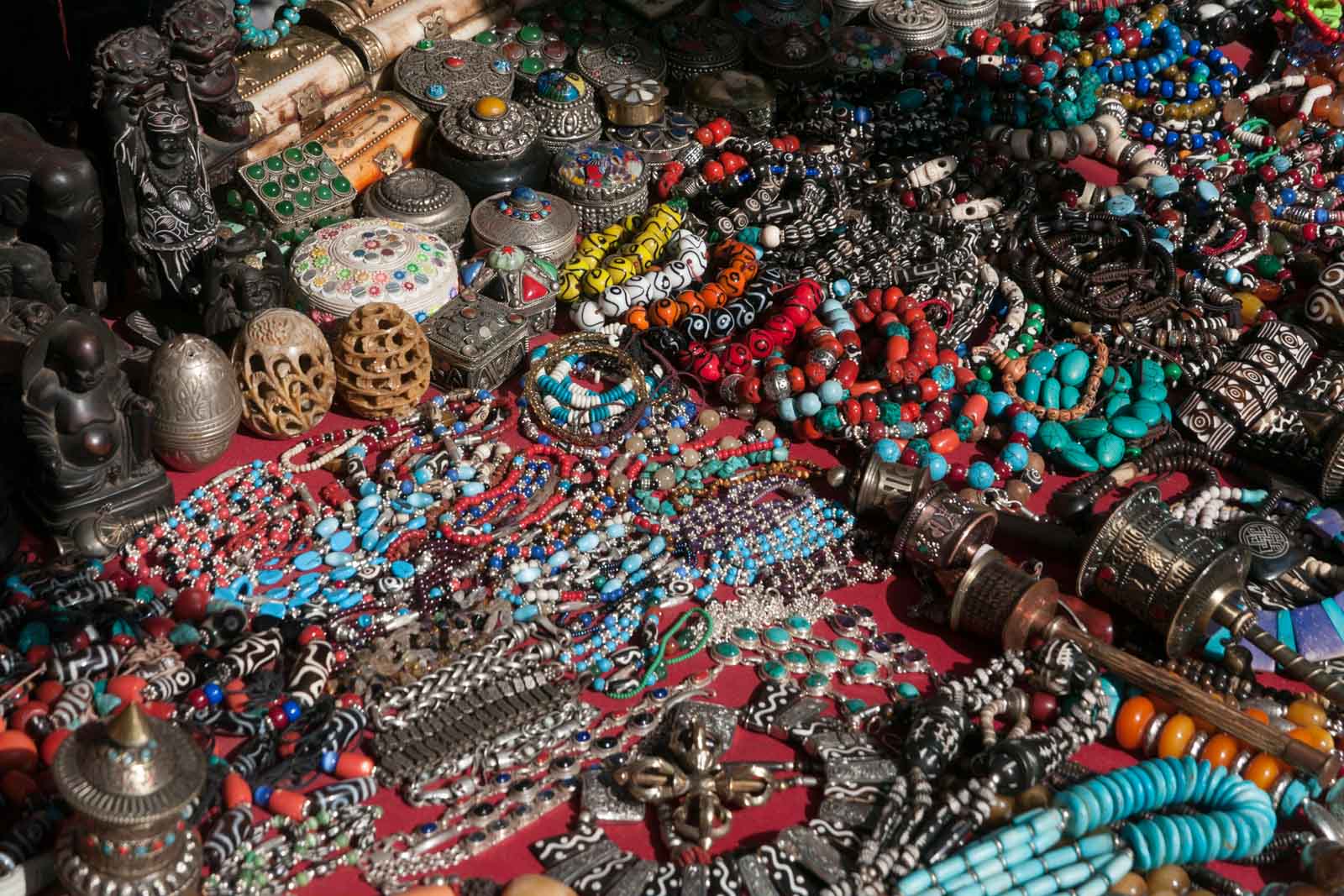
But we took it very easy, making sure to stay hydrated and to eat enough food to stave off altitude sickness. Namche Bazaar is located at a high altitude of 3440 meters (11,286 feet). We already saw a woman suffering from altitude sickness. She was having her blood pressure taken and heart rate monitored and when she got up, she was staggering as she leaned on her guide.
Her Everest base camp trek had already come to an abrupt end. It reminded us to relax because the days ahead were going to be tough. So we went back to our teahouse to relax and prepare for the rest of our journey
The Acclimatization Hike for EBC Trek
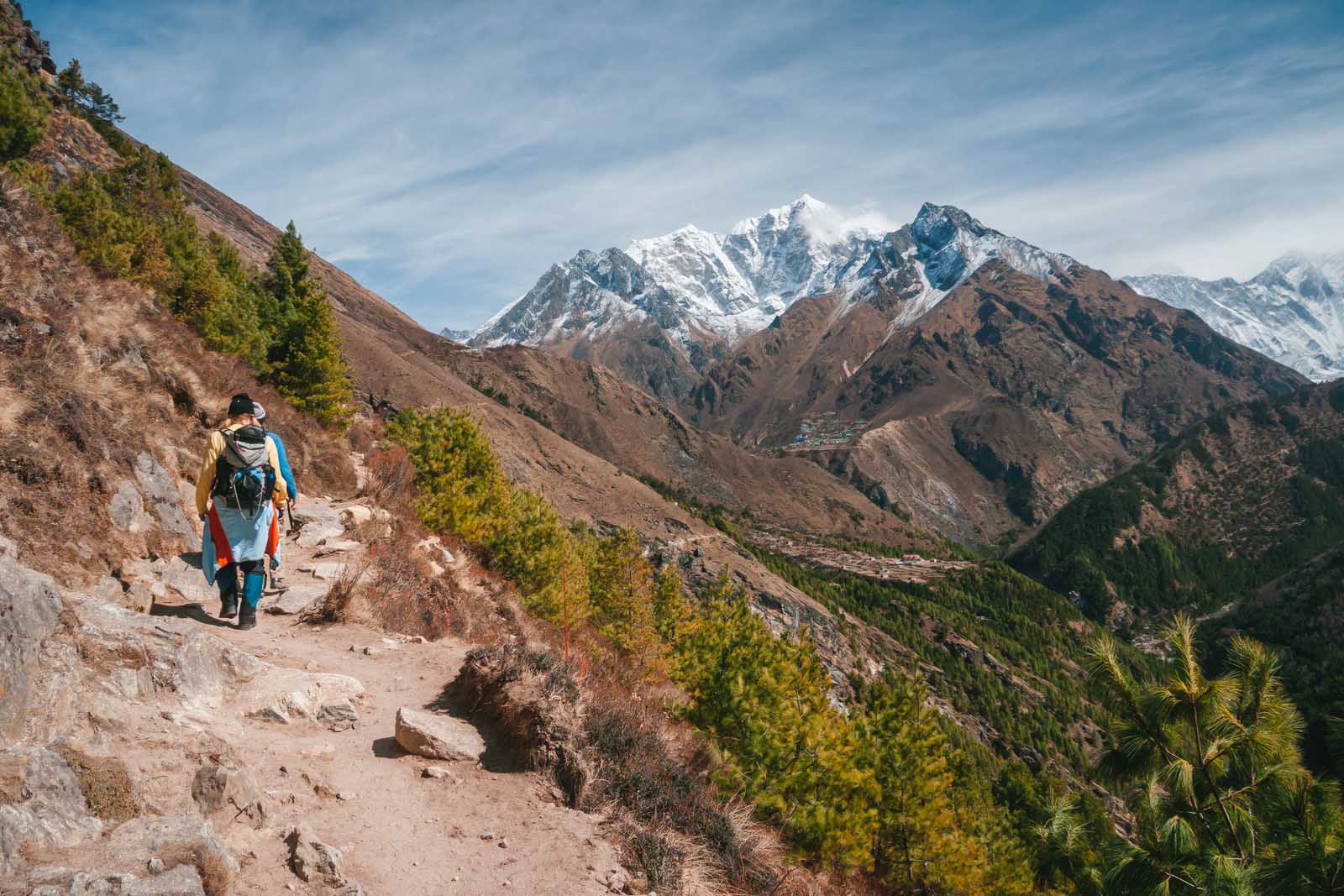
Most high-altitude treks have at least one acclimation day . The Everest Base Camp trek is no exception. An acclimatization day consists of hiking to a higher altitude and then coming back down to sleep at a lower elevation. It gives your body a chance to adjust to the altitude but you don’t stay for long.
As you will be constantly gaining altitude on the Everest Trek, it is good to have at least one day to climb higher and sleep lower to help prevent altitude sickness.
Our acclimation hike took us to the Everest View Hotel. With an elevation gain of only 400 meters, it wasn’t too much higher than our hotel in Namche Bazaar, but it is enough to help acclimate to the high altitudes. Everest View Hotel offers amazing views of Mount Everest (hence the name). Plus it holds the Guinness book of world records as the highest hotel in the world.
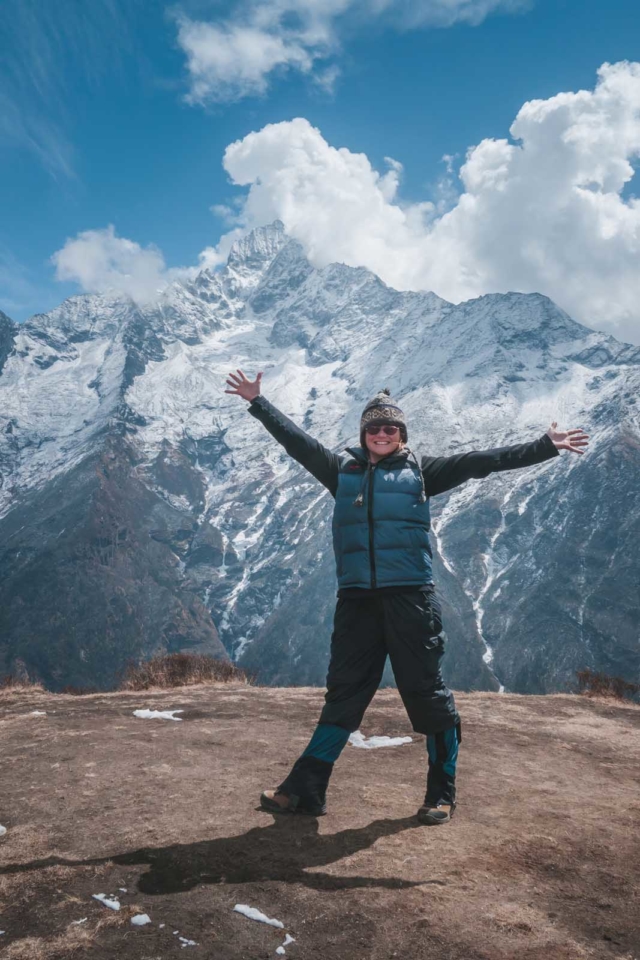
It is not an easy day off though. Just walking through town takes your breath away. As we made our way up the steps, I wondered if I should have just stayed in bed and skipped the viewpoint to relax. When we started the climb I was breathing heavily just walking up a few flights of steps. We hadn’t even left Namche Bazaar and I was pooped!
Once we got on the trail, things became easier. The steep grade gave way to a sloping trail and I started to feel better. After one and a half hours of climbing, we reached what has to be the world’s highest airstrip at 3700 meters (12,139 feet). We arrive just in time to see a small plane take off.
First Views of Mt. Everest
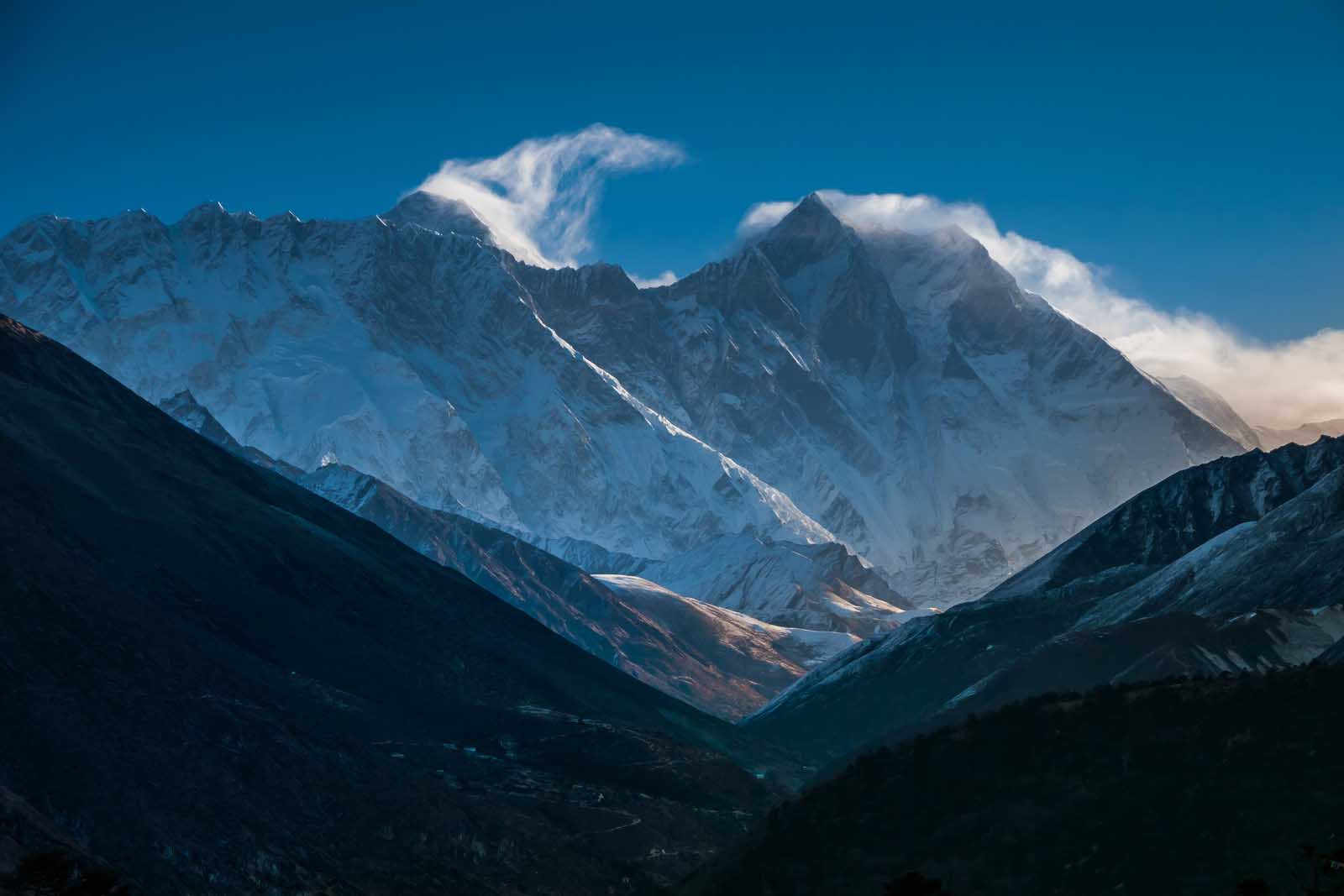
It was here that we got to see our first breathtaking views of Mt. Everest and the surrounding mountains. We hiked a bit farther and there it was, standing quietly behind the other highest peaks of the earth.
Lhotse, Changri, Ama Dablam, and Nuptse surround the mighty Mount Everest, the world’s highest peak. At 8414m (27,604 feet), 6027m (19,773 feet), and 7861m (25,790 feet) they are the little sisters of this sacred mountain. Mount Everest stands at 8848 meters (27,716 feet).
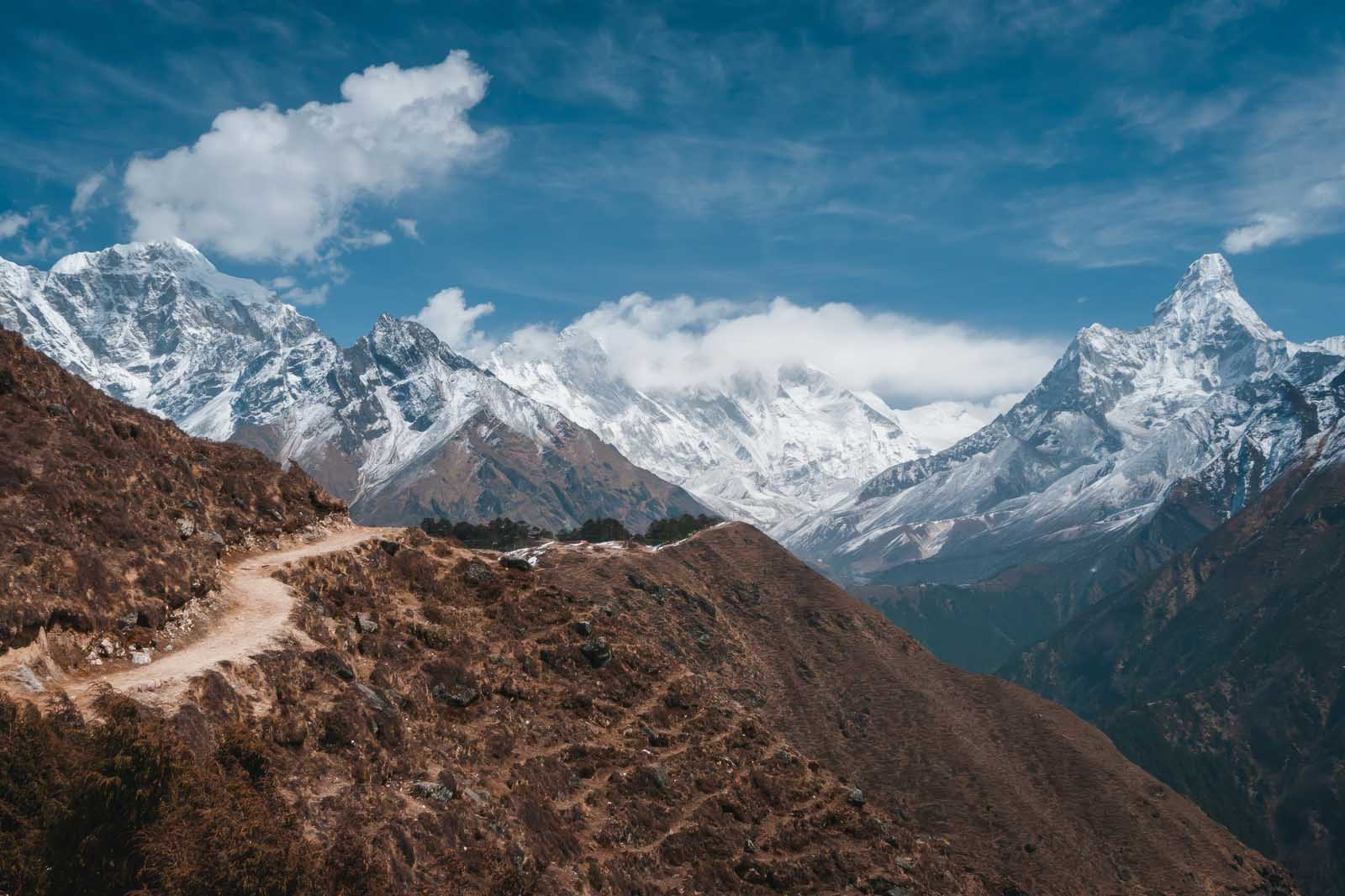
The deep Khumbu valley views were magnificent. The river wove far below, carving through the panorama of the white mountain tops. We walked a narrow trail snaking along the side of a steep mountain and suddenly realize “this trek has become real.” We were high in the Himalayas and one false move could mean catastrophe falling into the abyss below.
The sky was a deep blue and the white summits reached toward the billowing clouds. The view was so awe-inspiring it brought me to tears. Everything was so crisp and clear. During the EBC trek, you feel as if you could reach out and touch heaven.
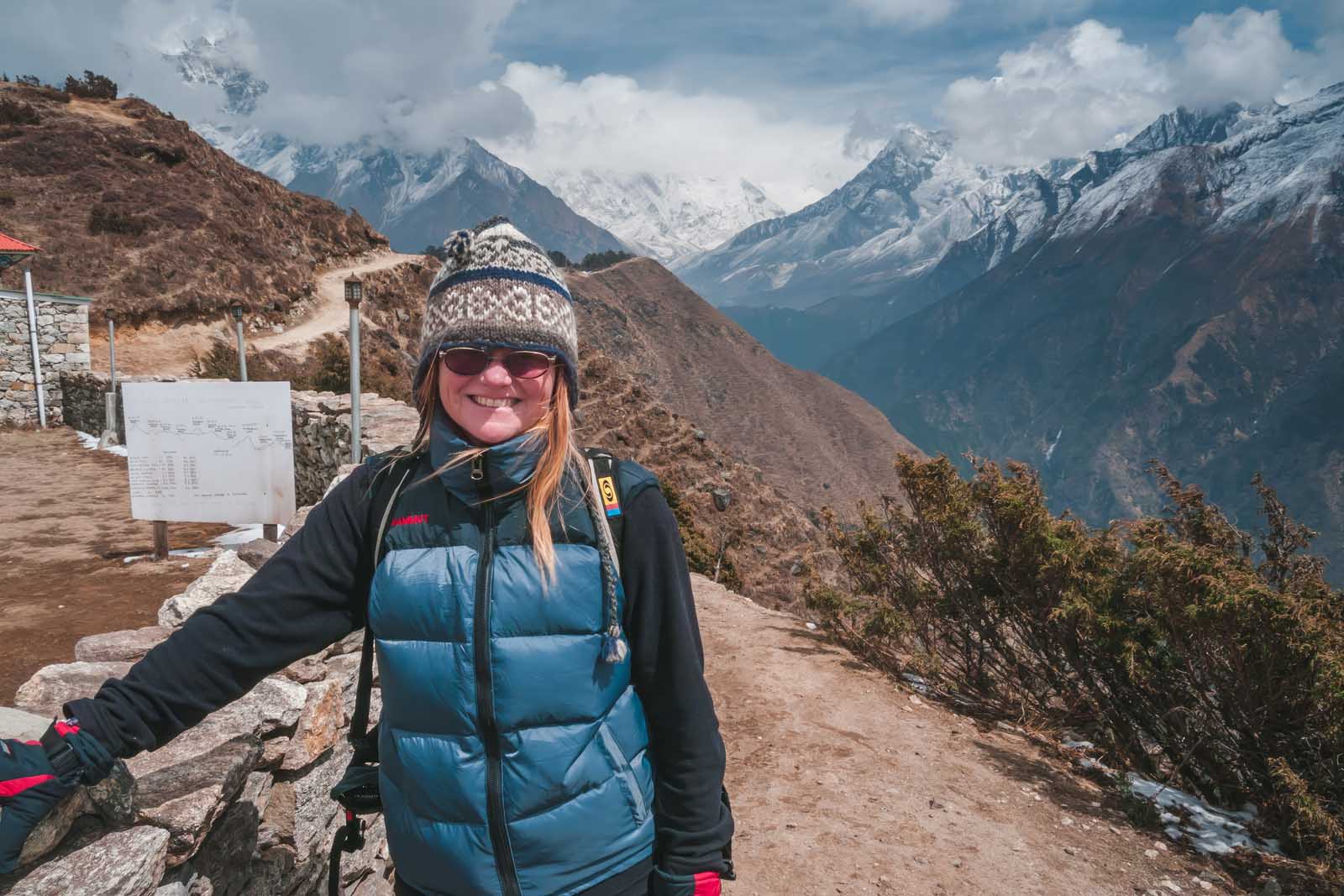
The clouds rolled in quickly so it was time to go. The weather conditions change quickly on the Everest base camp hike, so it is good to have the experience of a guide leading us through all terrain and conditions. We went back to Namche Bazaar to relax and gain strength for the rest of the trek.
Namche Bazaar – Elevation – 3440 meters. (11246 feet) Everest View Hotel – 3880 meters (12,730 ft.) Elevation – Bounce of 440 meters (1443 feet) Duration – 3 hours return Elevation Gain – 0 km
Day 4 – Namche Bazaar to Tengboche
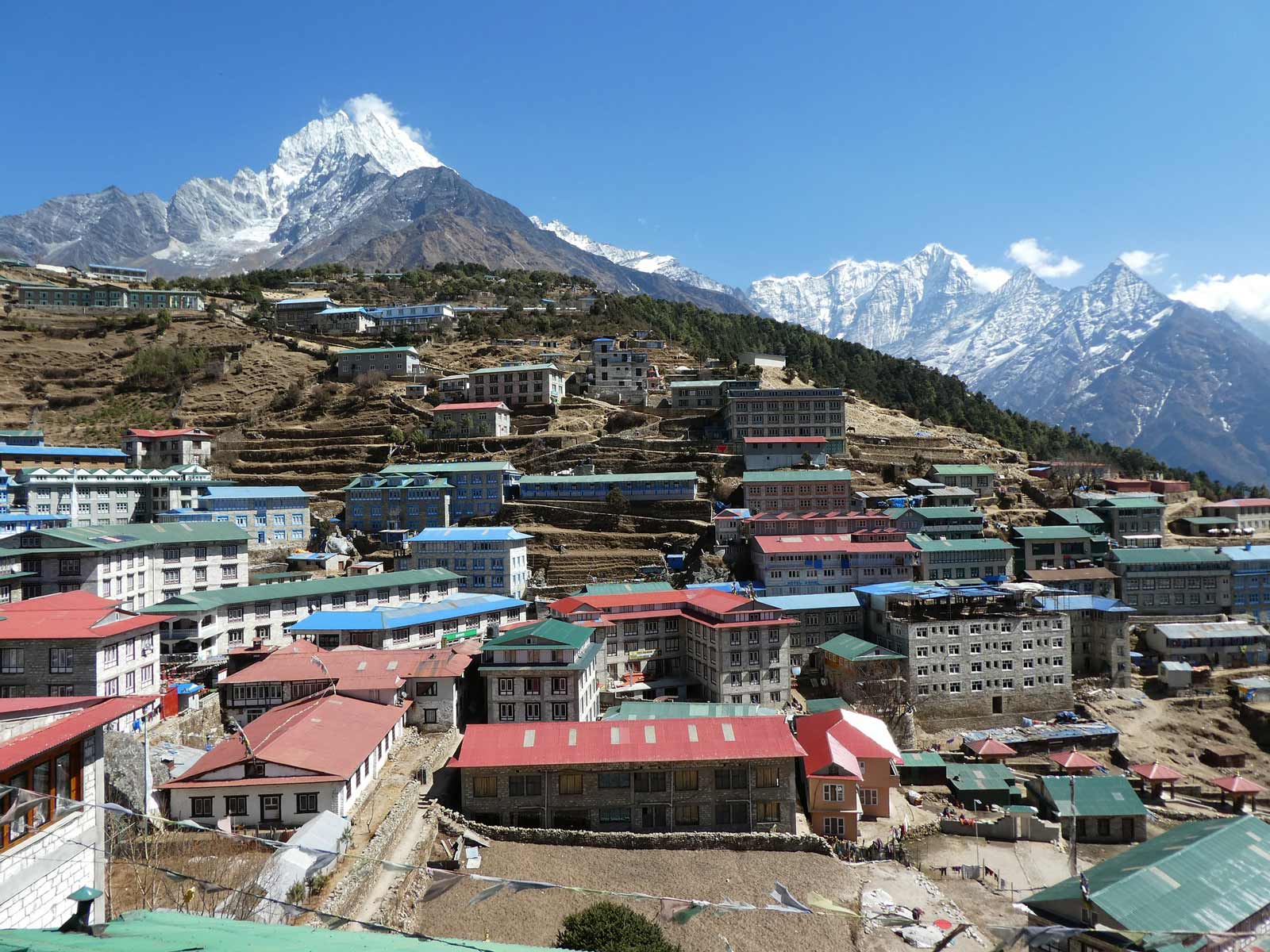
We awoke earlier than usual on Day 4. Two large group treks (Intrepid Travel and G Adventures) had checked into our lodge and we didn’t want to have to compete for service or breakfast. We also didn’t want to have to wait in line for the bathroom.
Lodges become more and more sparse as you go higher on the Everest Base Camp Trek and fewer toilets are shared between more people. Up until now, we hadn’t encountered crowds of people. It had been pretty quiet on the mountain and we liked it that way.
Luckily, we were a day ahead of the other tours. They had to stay in Namche Bazaar for another day to acclimate to the high altitudes, So we moved on to enjoy our EBC Trek free from crowds of people – for now.
Tenzing Norgay Memorial Stupa
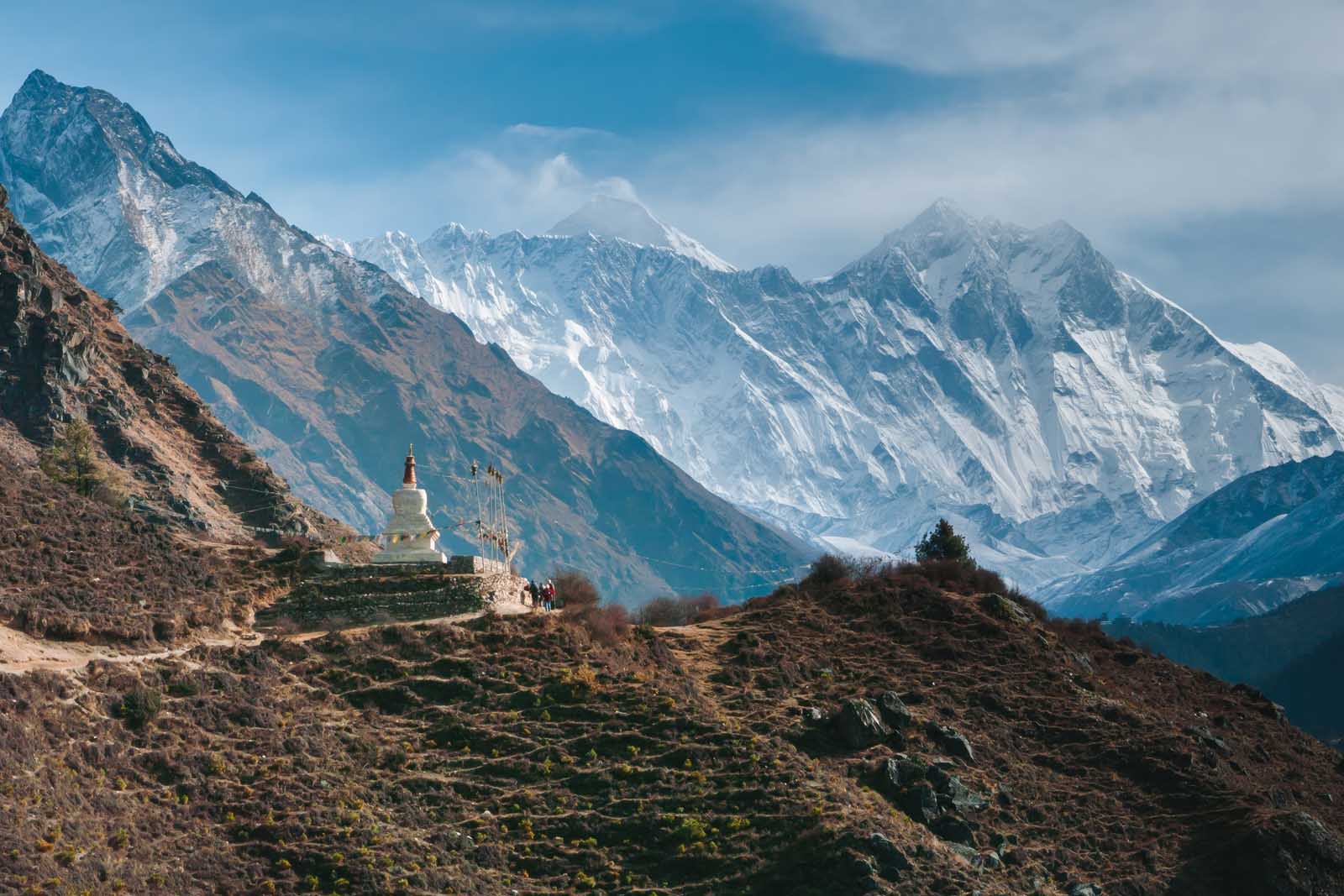
During day 4 of the EBC trek, we hiked along trails clinging to the side of the mountain. The narrow trekking trails along this route were a little scary. They wound along the edge of the cliff with nothing but a sheer drop to the abyss into the Khumbu Valley. But we kept our wits about us putting one foot ahead of the other until we reached the Sherpa Monument.
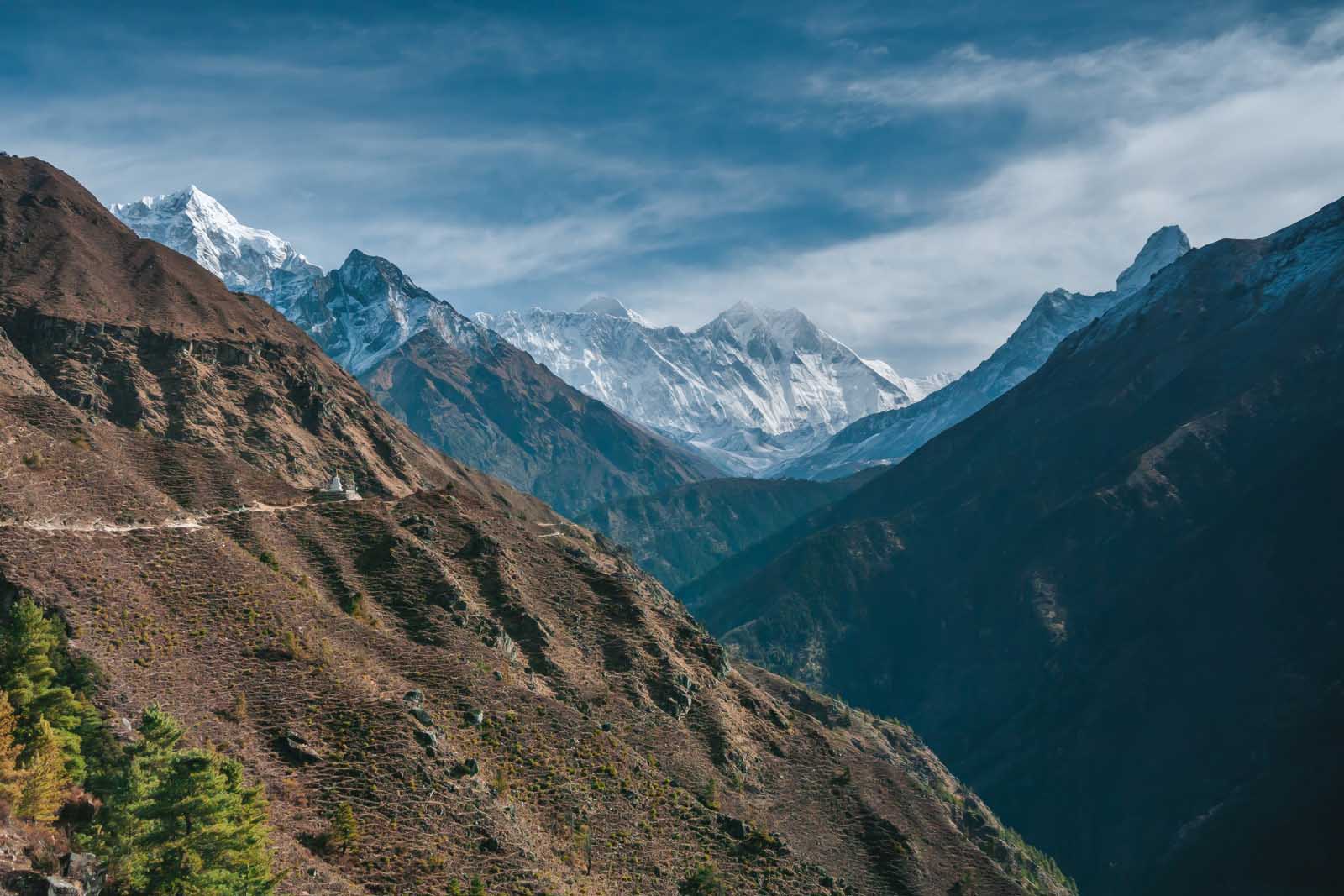
Tenzing Norgay Sherpa monument was erected by the Norgay family. It is a stupa honoring Tenzing Norgay Sherpa and all the Sherpas that risked their lives to help climbers reach the summit of Mt. Everest.
All treks pass this monument and it is an important stop on the journey to pay respect to the famous Sherpa of the Everest region. In case you don’t know, Tenzing Norgay Sherpa was the first man to summit Everest along with Sir Edmund Hillary.
What is a Sherpa?
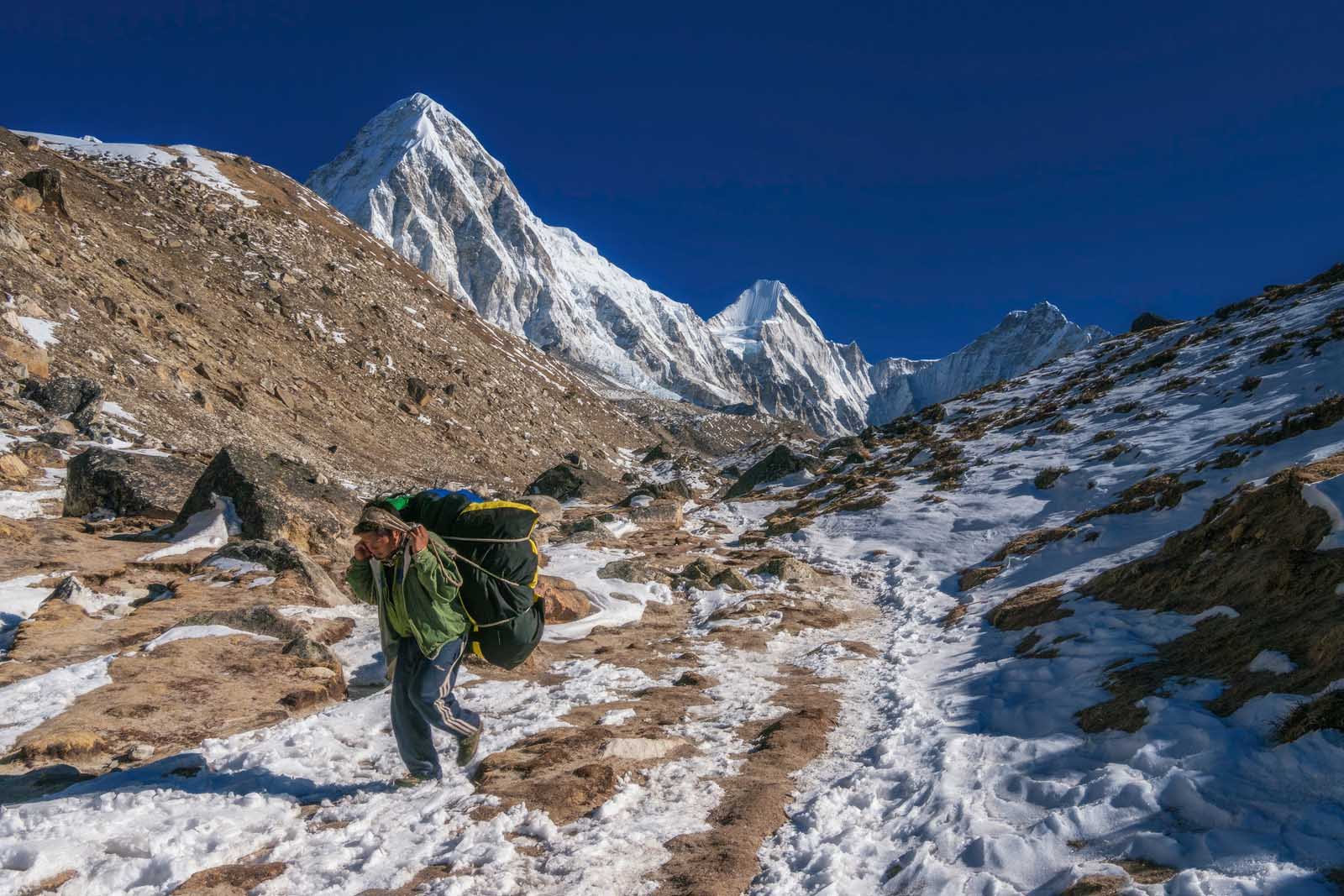
Sherpas are the unsung heroes of Mt. Everest. They do all of the hard work and technical work on the mountain. They carry the heavy loads, set the ladders and ropes to cross the Hillary Step and Khumbu Icefield for mountain climbers, and they take care of setting up camp while climbers and trekkers catch their breath and try to survive life on the world’s highest peak.
Difference Between a Sherpa and a Porter
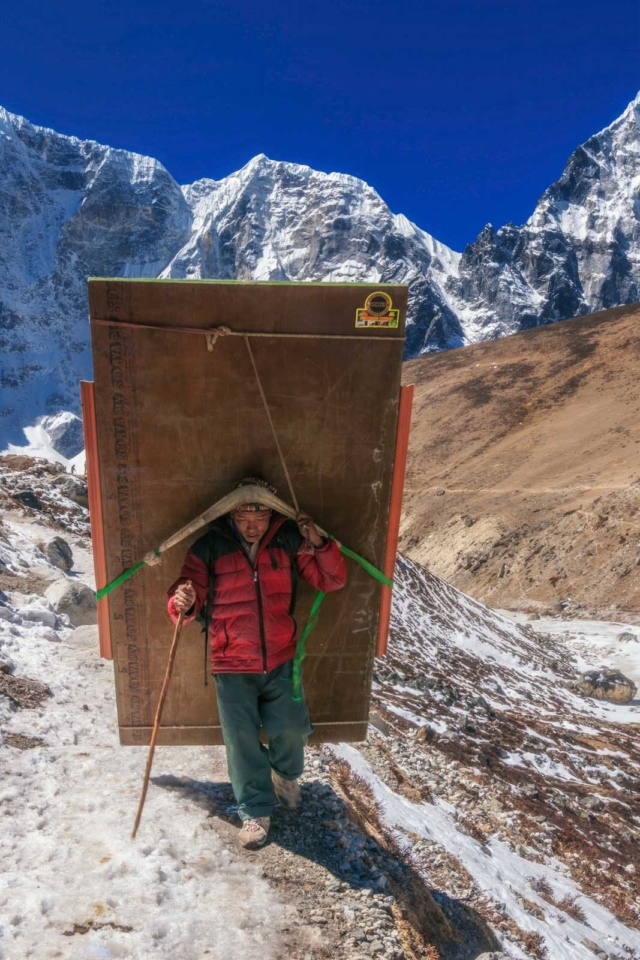
Sherpas and porters are very different from one another. We learned that a Sherpa is actually the name of an ethnic group from Tibet. The original mountaineers hired Sherpas as their guides in the Himalayas and the world has now adopted the name for porters in the Everest region. If you aren’t born into the Sherpa ethnic group, you cannot be called a Sherpa. Porters are porters and Sherpas are Sherpas.
We were told that some porters, especially commercial porters carry up to 60kg (150 pounds) of supplies and gear to businesses located along the EBC trek. That is a lot of weight and we were very surprised. When climbing Mount Kilimanjaro , porters had a mandatory weight limit of 35kg. (77 pounds).
Dipendra told us that they get paid per kilo so some people push it too far. The Nepalese are a strong bunch but this is a lot to carry at such a high altitude no matter what shape you are in.
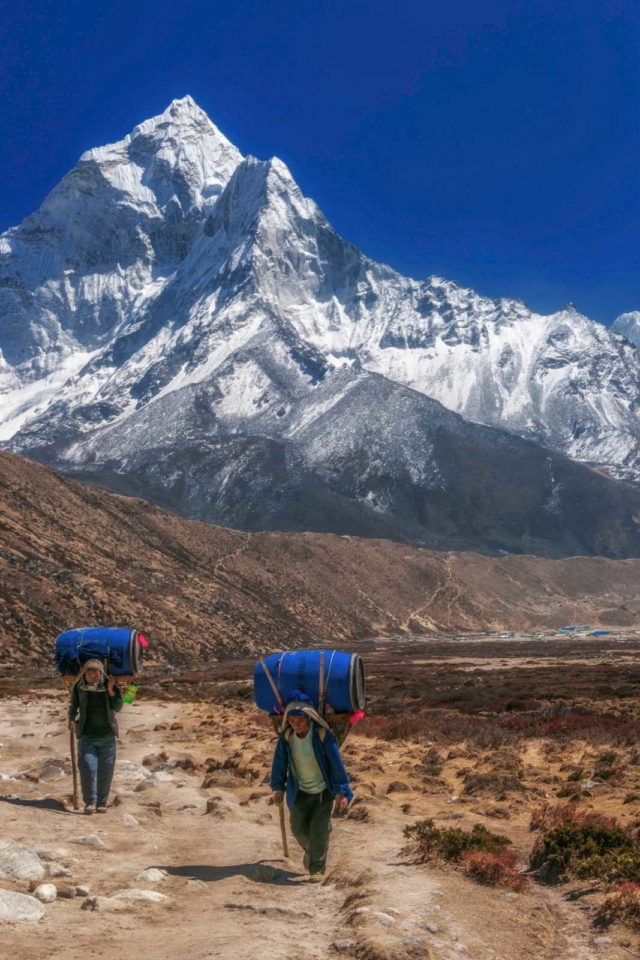
We kept our pack as light as possible at around 22kg (48 pounds) for Sher and we even felt bad about that! We have heard there is a 30kg (66lb) limit for Everest, but judging by what we saw other porters carrying on the Everest Base Camp hike, people were pushing it well beyond that.
We saw men carrying stacks of plywood with heavy white sacks loaded on top. We saw men carrying propane tanks, doors, and huge packs. What could people possibly need on the EBC Trek that they packed their packs so full? Read more: Packing List for Everest Base Camp Trek
Approaching Tengboche
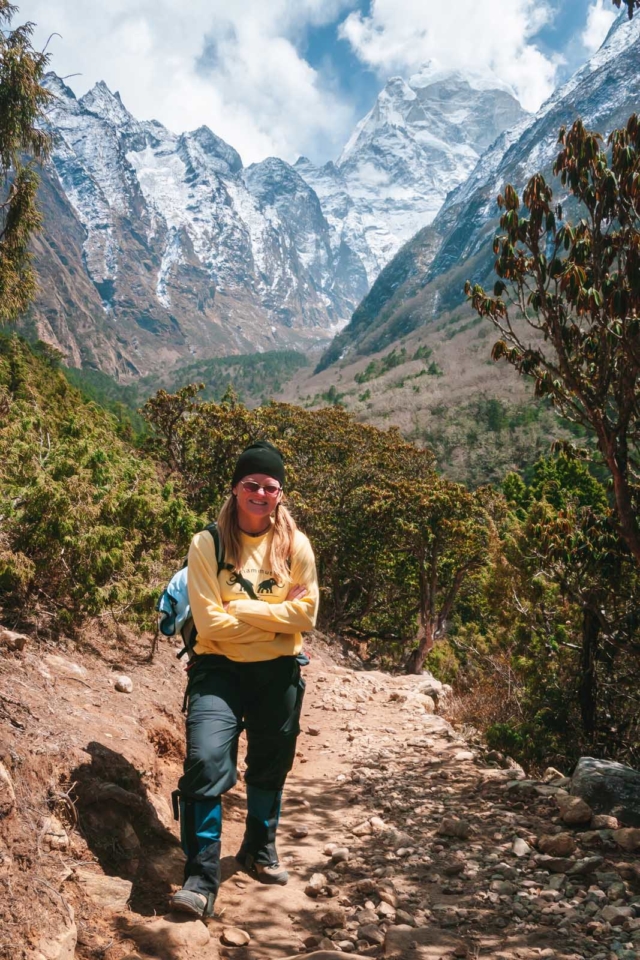
The final push of our EBC Trek day 4 was to Tengboche Monastery. It was a tough yet steady 2-hour steep climb. We are now gaining altitude climbing above the tree line. We put our heads down and huffed and puffed our way up. We didn’t stop for any photos or videos and were surprised to cut the climb down to just one and a half hours.
We reached the prayer wheels of Tengboche Monastery just in time for light snow to start falling. We made it into our camp at Tengboche by 1:30 pm and had the entire afternoon to ourselves at 3900 meters (12795 feet). This is an excellent place on the Everest Base Camp hike to have some extra time to relax as there are a few special things to see and do.
Tengboche Monastery
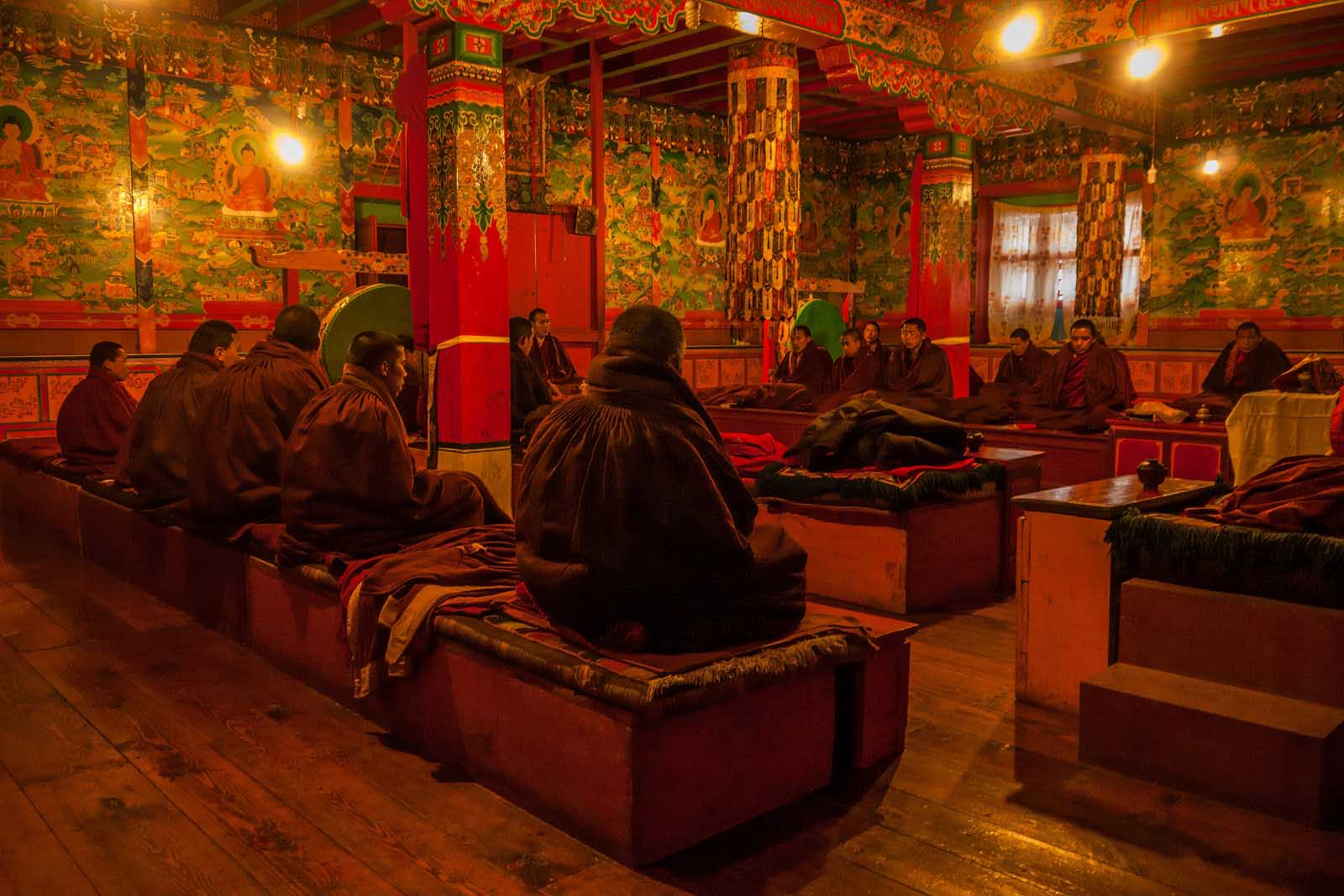
We warmed our feet with our new down booties that we bought at Namche Bazaar and changed into some dryer clothes before heading off to see the monks chant at Tengboche Monastery. Our guide Dipendra told us that this is the most important monastery in the region. All climbers summiting the mountains stop at this monastery to be blessed by the monks.
We were allowed to watch the ceremony and to take in the warmth and blessings from the monks. It is a sacred place and all climbers and trekkers stop here before continuing up the mountains.
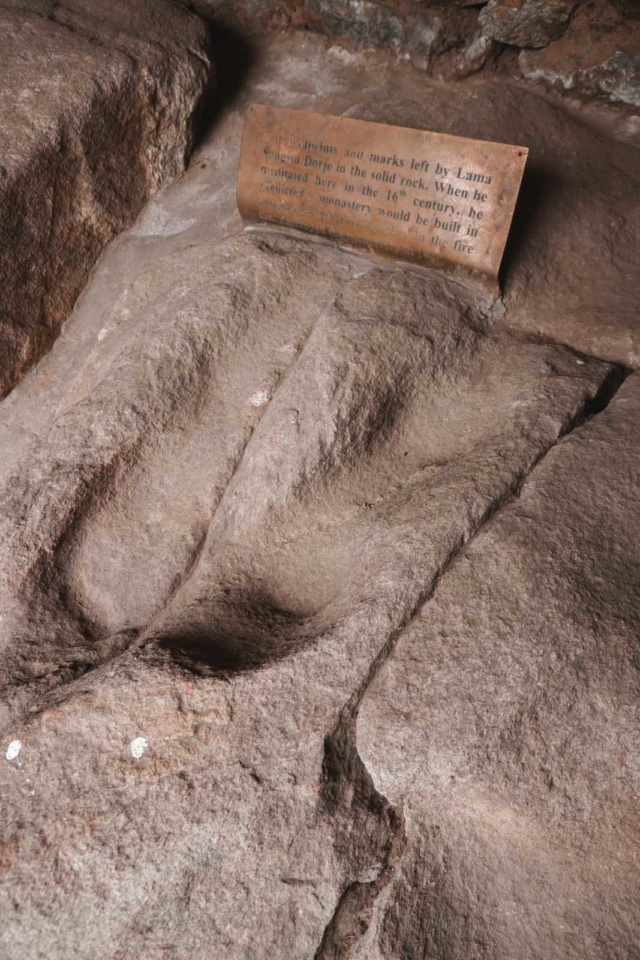
The footprints of Lama Pagna Dorje from the 16th century are embedded in solid stone in front of the monastery. A place where he mediated and raced through the Himalayas riding the wind with his mind.
Apparently, he sat on this stone for so long, his feet left their mark. He spent years traveling the world through the power of his mind and we believe the story. Especially after our yoga experience in Goa India. He predicted that a monastery would be built here and surprise surprise…here it is.
The View from Tengboche Monastery
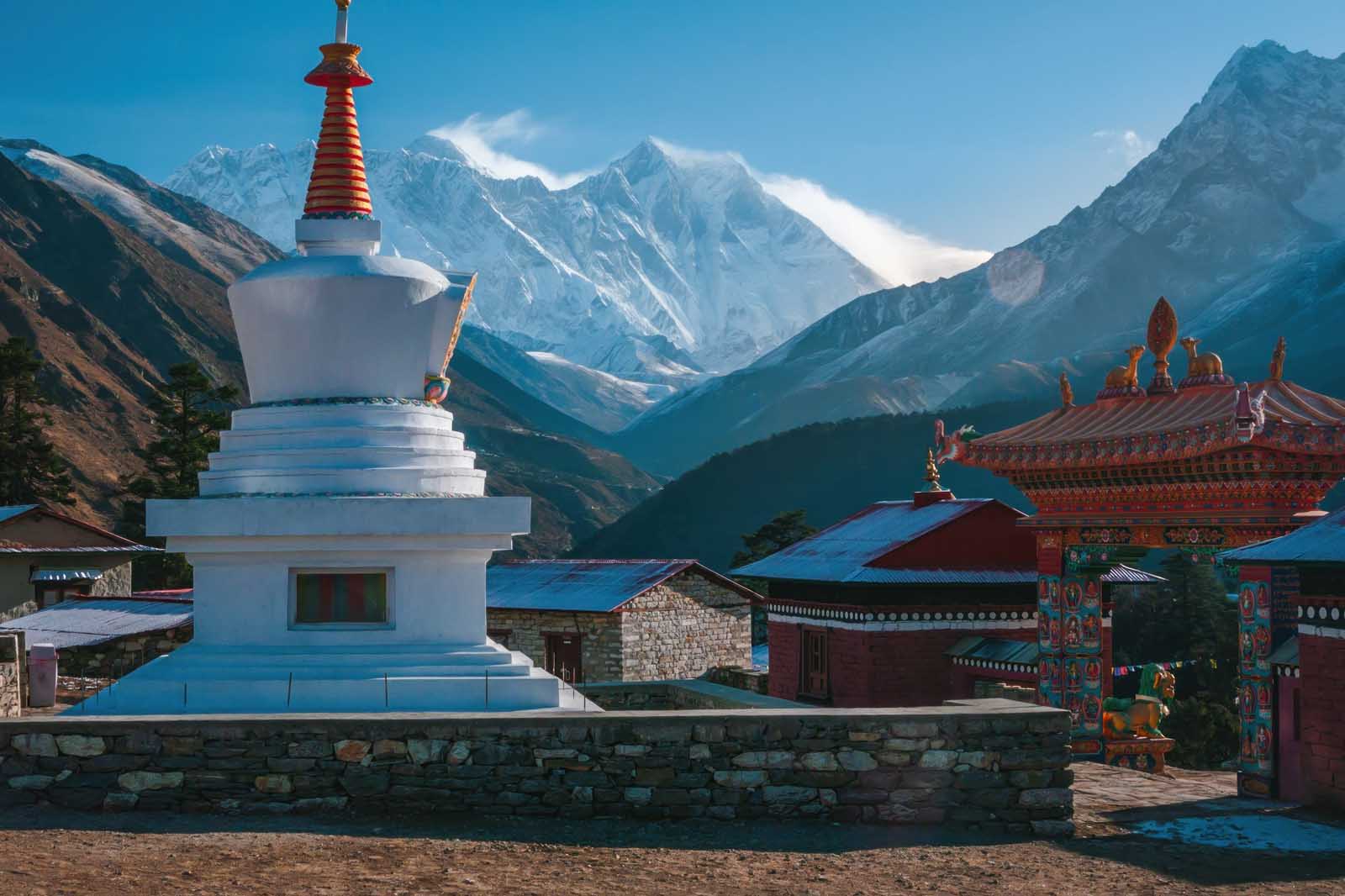
The view is magnificent from Tengboche Monastery. The valley is wide and opens up to massive rolling hills giving way to the highest peaks on earth. Plus it has a clear view of Mt. Everest and the surrounding mountains.
We were told that Sir Edmund Hillary came back to survey the peak of Mount Everest from this spot because the view is so clear of the mountain and we can understand why.
Accommodation – Basic Tea Houses at Higher Altitude
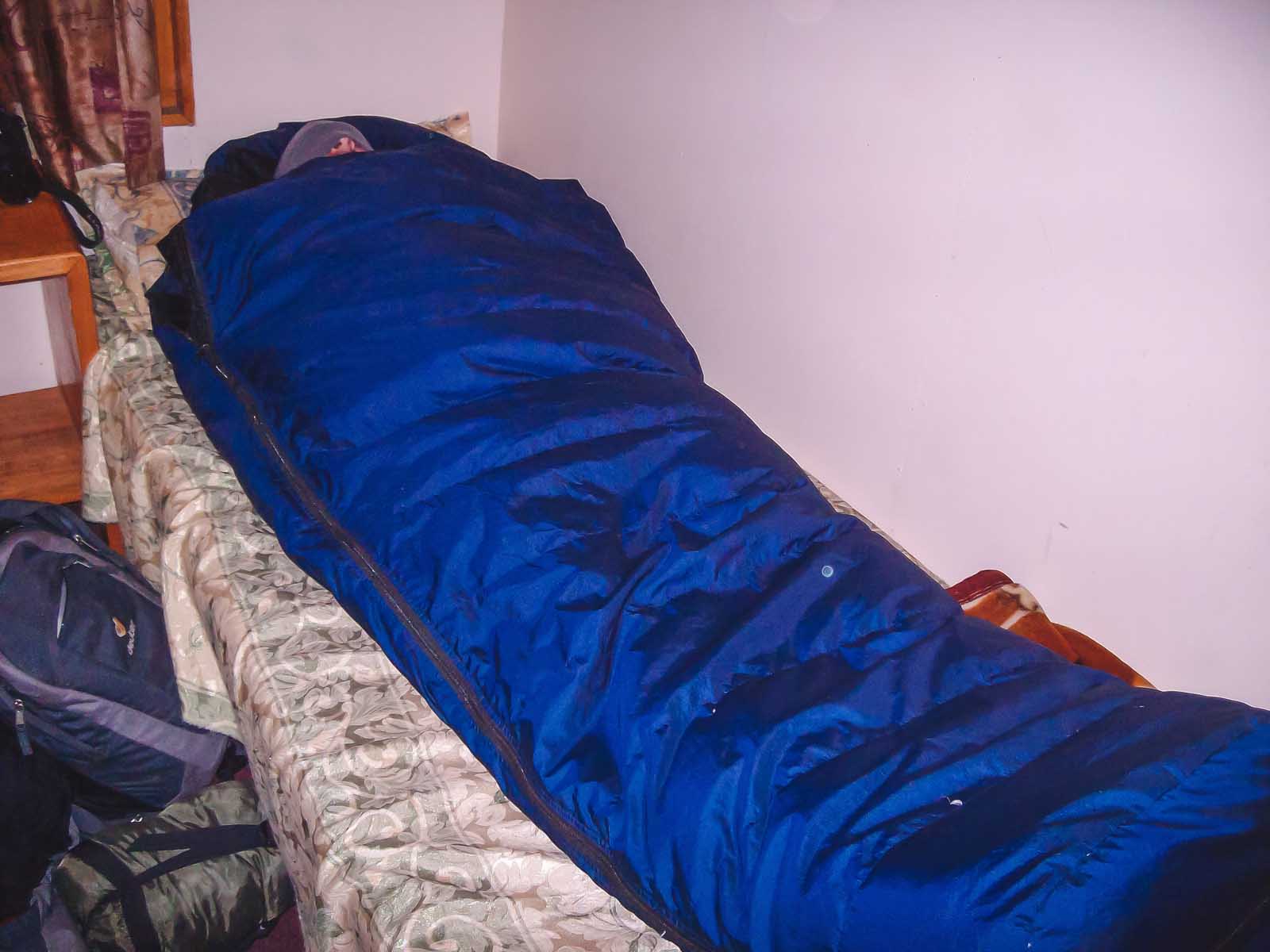
At this high elevation of the EBC trek, accommodation became very basic and rustic. We felt like true adventurers as we sat by the fire warming our feet and bonding with our fellow trekkers over our shared experience by candlelight.
There were 10 of us staying in this teahouse. All are sharing electricity to charge our camera batteries. Meals were now vegetarian and wood stoves were heated by yak dung. At this high altitude, meat cannot be transported fast enough to stay fresh and regular wood is scarce, so yak dung it is.
When we went to bed, our room was freezing. Rooms are not heated at higher elevations. We had our own room, but I sometimes wonder if sleeping in a dorm would have helped with more body heat. The temperature easily dipped down to -10 Celcius (14 degrees Fahrenheit) and our plywood walls didn’t offer a lot of comforts.
We tossed and turned all night long trying to keep our noses warm in our sleeping bags wearing our down jackets, thick socks, and thermal mid-layers.
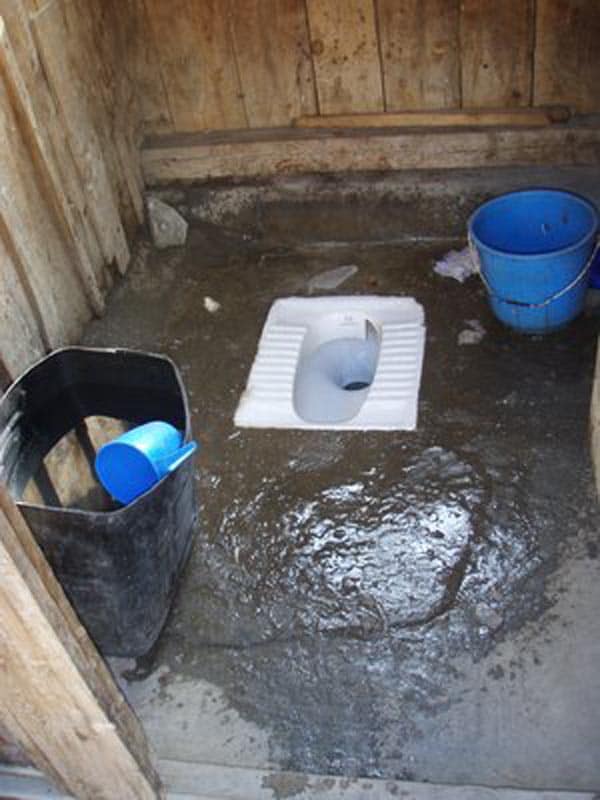
It was so cold the scoop bucket for the shared squat toilet froze over forming a patch of ice to form on the floor. It was a slippery trip to the outhouse. Sadly, we always have to pee a lot during the night when sleeping at high altitudes so we visited that toilet a lot.
Hot Tip: Pay for hots showers at lower elevations You won’t regret it! We realized that we should have paid the 250 Rupees for the hot showers offered at the accommodation in Namche Bazaar. Now that the weather was so cold there was no way we could face a bucket bath in a freezing shed. Dave and I set a new record in these mountains of Nepal, 9 days without a shower!
Namche Bazaar – Elevation – 3440 meters. (11246 feet) above sea level Tengboche – 3860 meters (12664 feet) Elevation Gain – 420 meters (1378 feet) Distance – 9.3 km (5.77 miles) Duration – 3 hours (without stopping) 5 hours for photos, lunch and rest.
Day 5 – Tengboche to Dingboche
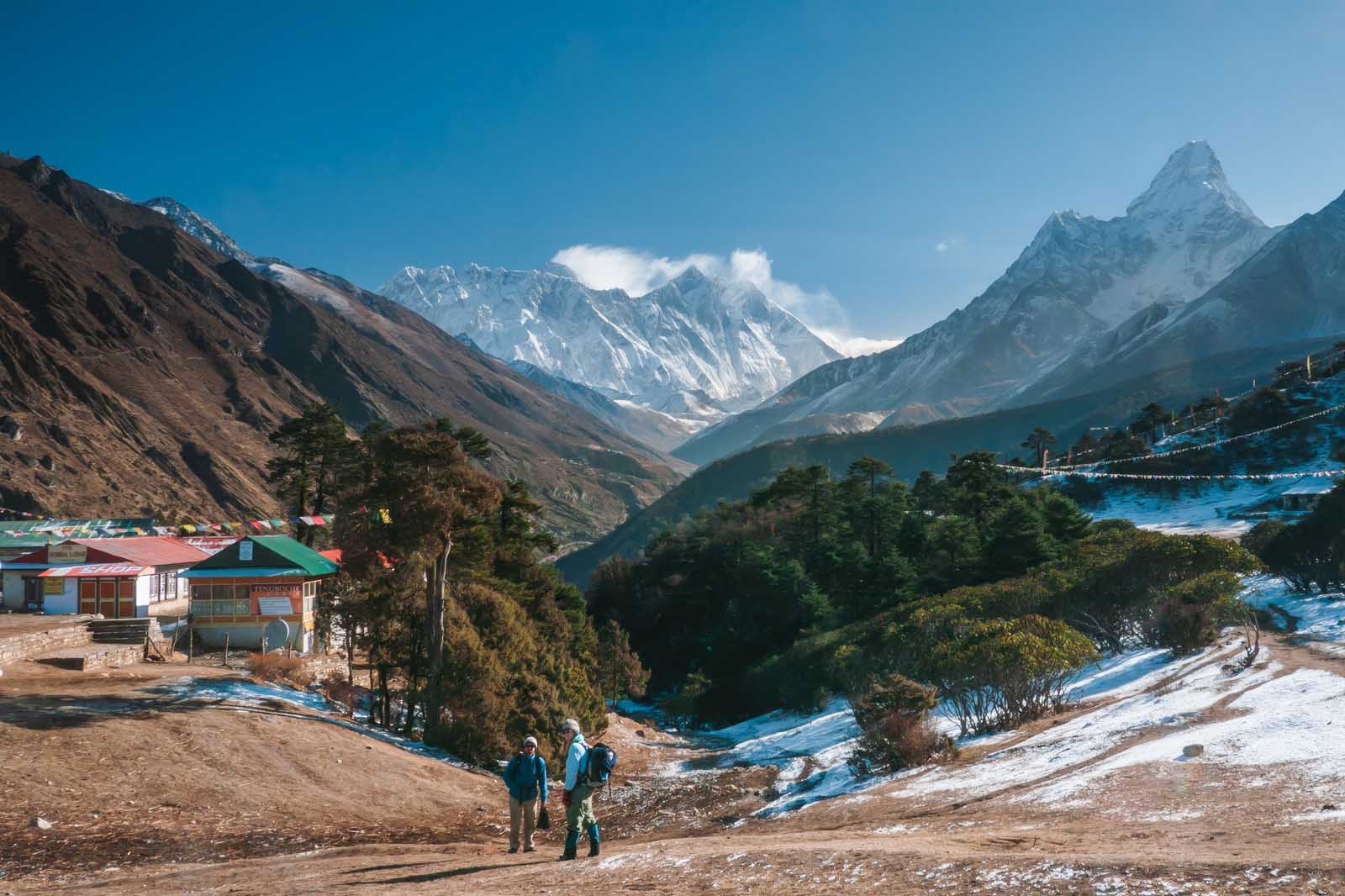
Day 5 of the EBC Trek was freezing! We had an early wake-up call and morning came too quickly on the Tengboche leg of the EBC Trek. But, we awoke to a winter wonderland of fresh snow at the Tengboche Monastery and clear views of Lhotse peak.
The snow from the night before made for more incredible views on the hiking trails. As we started out from the lodge, the sky was crisp and clear, showing Mount Everest in all its glory. It was stunning, and in between gasping for air, we admired the view.
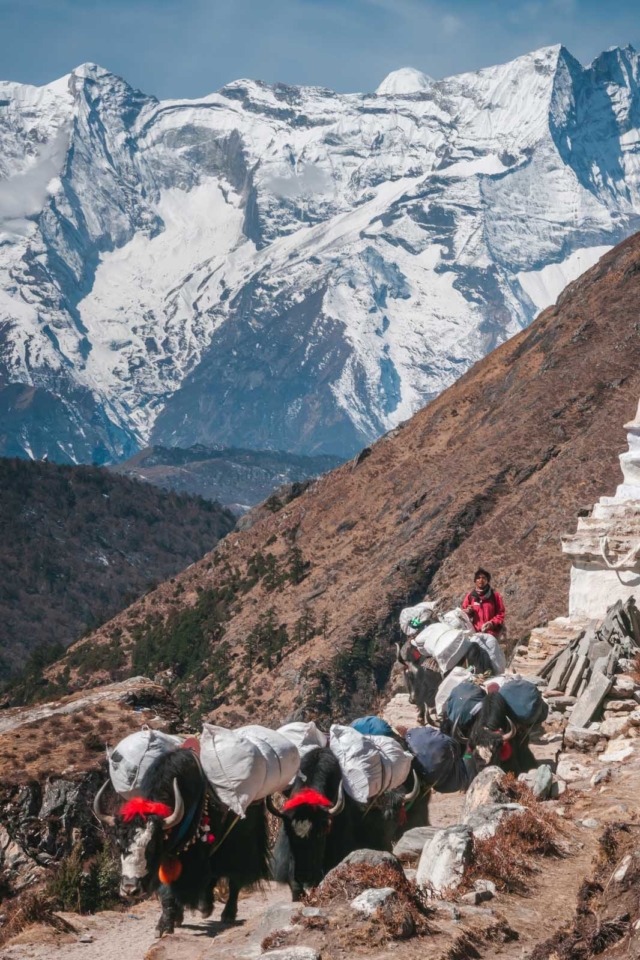
Today we walked to higher altitudes and saw our first trains of wooly yaks. Yaks cannot survive at low altitudes because it is too warm for them, so you don’t see yaks on the Everest Base Camp hike until at least 3000 meters. (9800 feet) They are beautiful.
Yaks on the Trek to Everest Base Camp
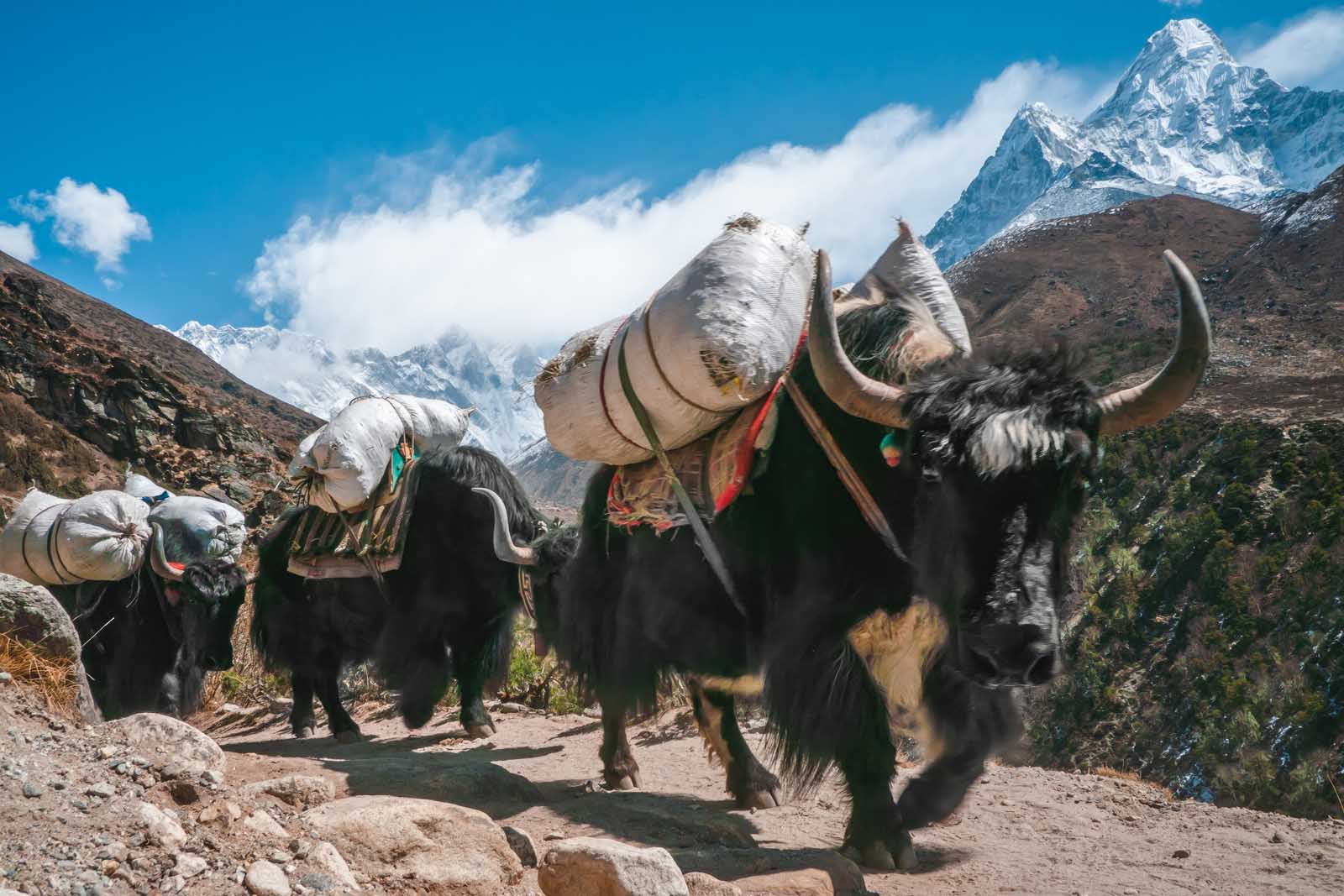
Woolly yak trains were more frequent and by day five of the EBC Trek, we had our system perfected to give them the right of way without letting them nudge us off the mountain.
As we said earlier, it is important to give yaks space. They will run you right off the mountain if you are in their way. Be sure to stand on the mountainside as they pass so you don’t get knocked over the edge. The yaks of the Everest Base Camp trek, have only one thing on their mind. To get to their destination.
On this day, signs of expeditions going up to summit Everest started to go by as large groups of yaks carried giant loads of climbing gear. It is exciting to think that we were walking the same route as so many great mountain climbers, like Sir Edmund Hillary and Tenzing Norgay Sherpa.
The Trek from Tengboche is breathtaking
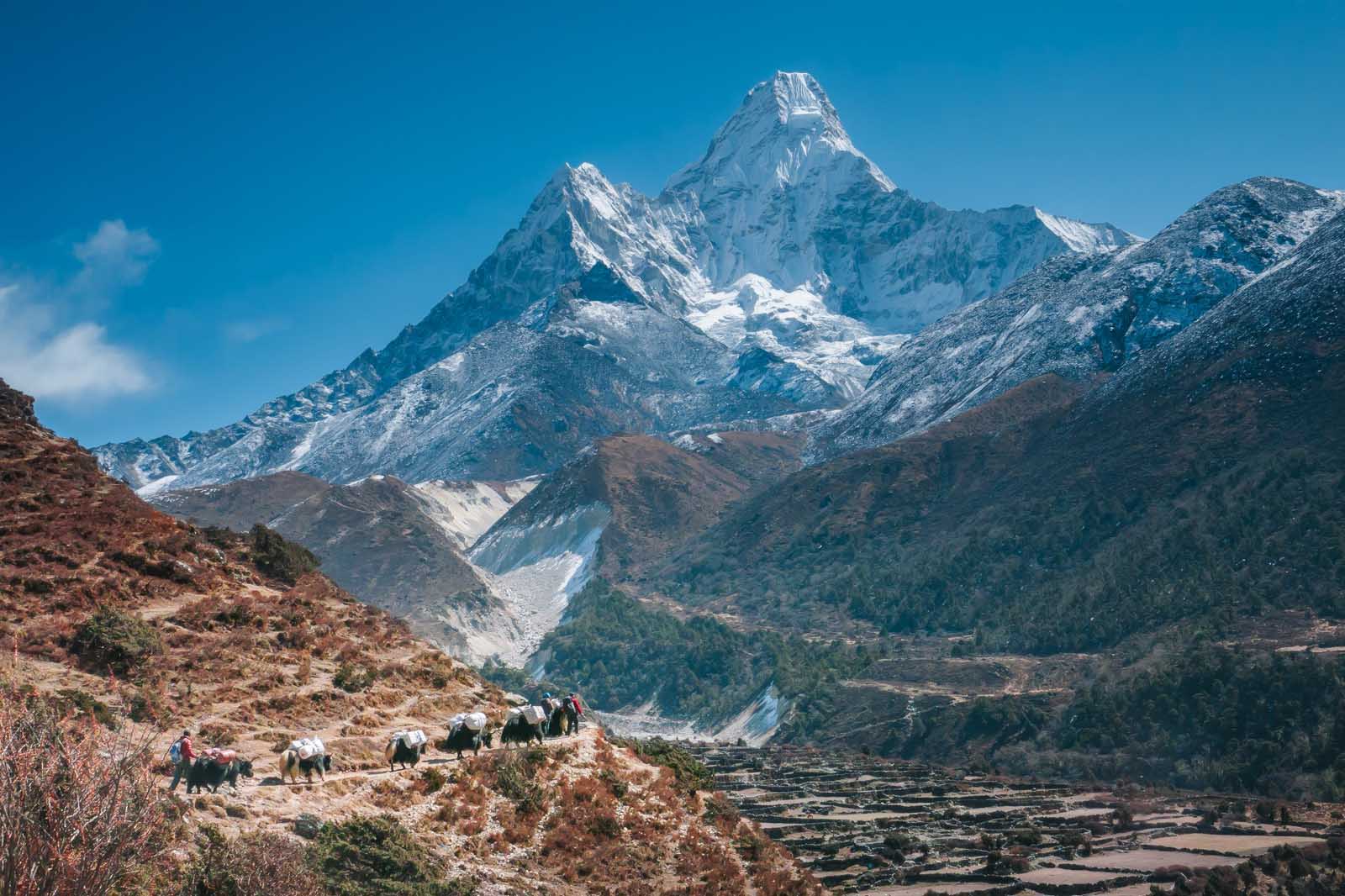
I conquered what little fear of heights I had left this day. Some of the narrow paths on the route dropped sharply into the deep valley below. Soon we found ourselves walking along the ledge not thinking at all about the dangers below. We hiked for a couple of hours before stopping for tea at a restaurant in Pangboche.
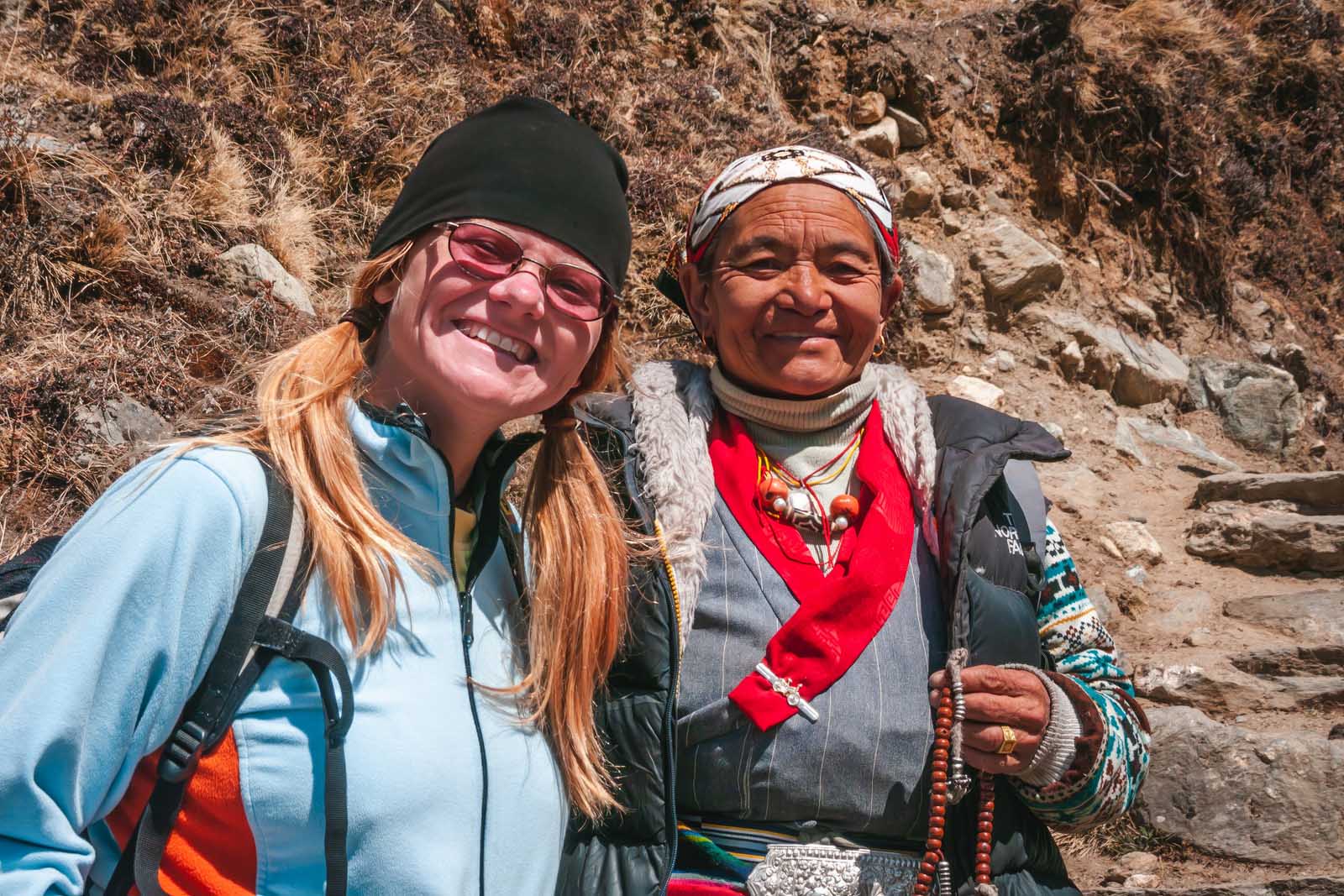
There are shops, teahouses, and restaurants along the route so we could buy lunch along the way and one of the more popular stops is in the village of Pangboche. After a tea stop in Pangboche, we met a sweet lady that walked with us all the way to the village of Dingboche. Her name was Yangshou and she waited for us as we struggled up hills and crossed the suspension bridge over the Imja Khola River.
Her cute laugh and quiet prayers helped to pass the time. She stopped to talk to everyone on the trail while we plugged along. She’d fall far behind when she chatted with friends, only to quickly catch us and then scoot by us with ease. She must have enjoyed our company because we really slowed her down. “ Yangzhou, we will always remember your smiling face!
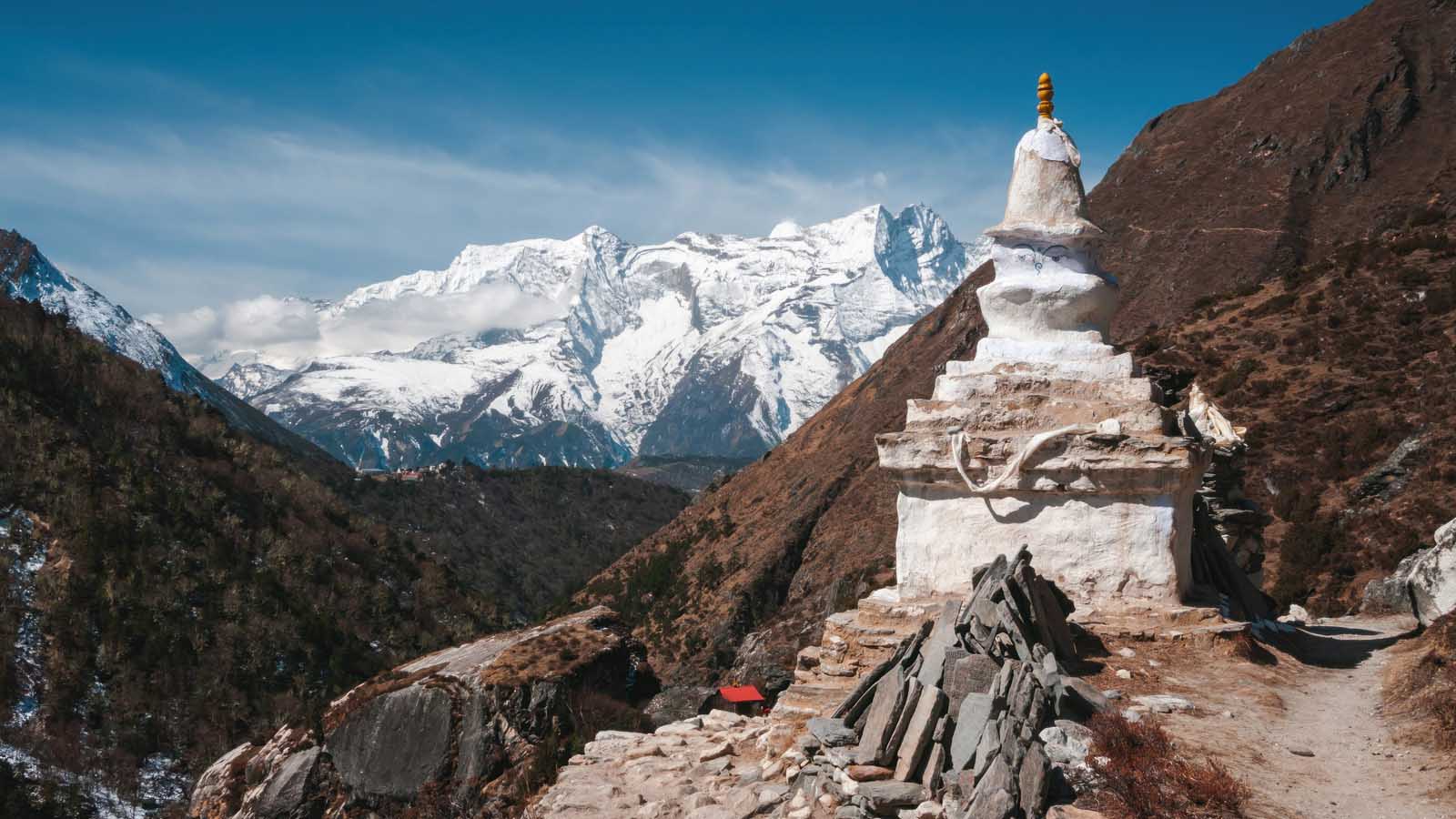
We spent the night in the village of Dingboche and wished that we had another night here. It is from here that you will see beautiful views of Island Peak and Lhotse, but it is also a good spot for another acclimatization day.
Tengboche – 3860 meters (12664 feet) above sea level Dingboche – Elevation – 4410 meters. (14468 feet) Elevation Gain – 550 meters (1804 feet) Distance – 10.8 km (6.71 miles) Duration – 3 hours (without stopping) 5 hours for photos, lunch, and rest.
Day 6 – Second Acclimatization Day at Dingboche
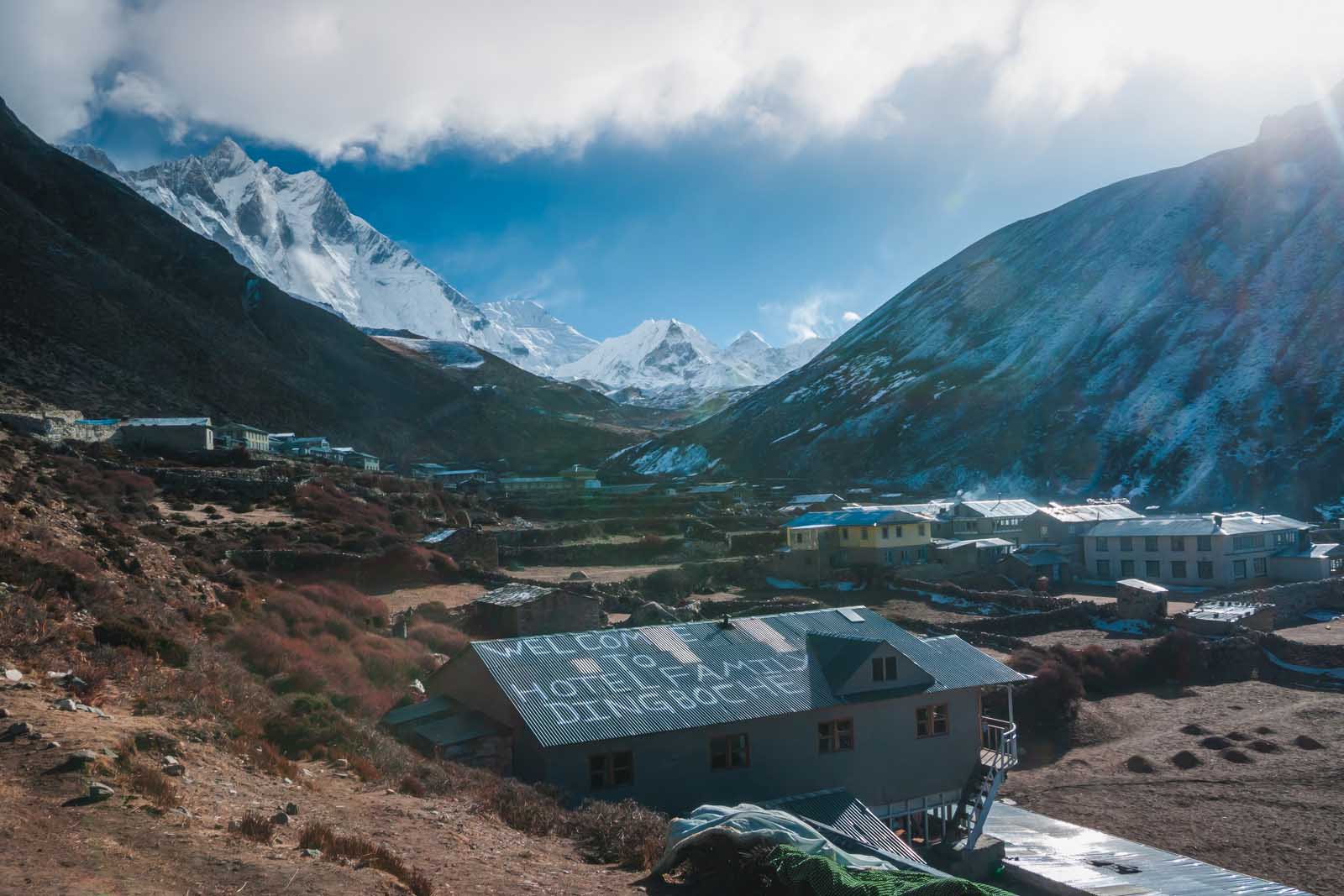
This is a day that most people spend acclimating to the high altitude. We did not do this day, but you should! So we are including it in the guide because it is a very important day when trekking to Everest Base Camp. If we were smarter, we would have spent 2 nights in the village of Dingboche where we would spend a day hiking up to Nagurjun Hill.
This is the best place for climbers looking to summit Everest, Ama Dablam (6812m), Lobuche peak (6,119 m), or Island Peak to do their acclimatization day. Dingboche is a small village in the Khumbu region with only a few guest houses, so it is a good time to relax, replenish and rejuvenate for the next push.
If we had brought our Lonely Planet Trekking in the Nepal Himalayas (which we forgot in Kathmandu and kicked ourselves about it every day) we would have realized that we should have taken an extra day to acclimate in Dingboche.
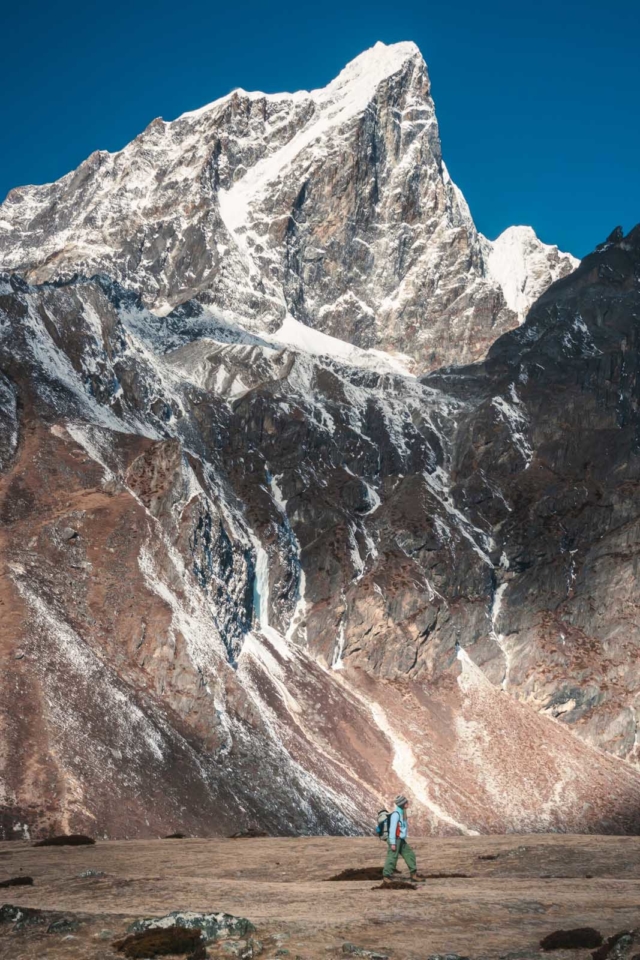
Dipendra was flexible so he would have easily added another day onto our trek, we just didn’t know any better to ask about it. Lucky for us, we felt strong, but other groups were complaining of headaches and dizziness.
In the end, we wish we spent the extra day here. Some people even spend two days here climbing to the surrounding peaks. We did suffer after reaching base camp and I believe that is because we didn’t spend time acclimatizing here.
Had we stayed, we would have done some light hikes to gain altitude and then come back down to rest at a lower elevation. Many people who are set to climb Island Peak or Kala Patthar stay here for a few days to get some practice climbs in.
Dingboche – Elevation – 4410 meters. (14468 feet) above sea level Nangkartshang Peak – Altitude – 5050 meters (16568 feet) Climb – 640 meters (2099 feet) Distance – 10.8 km (6.71 miles) Duration – 4 hours Elevation Gain – 0
Day 7 – Dingboche to Lobuche
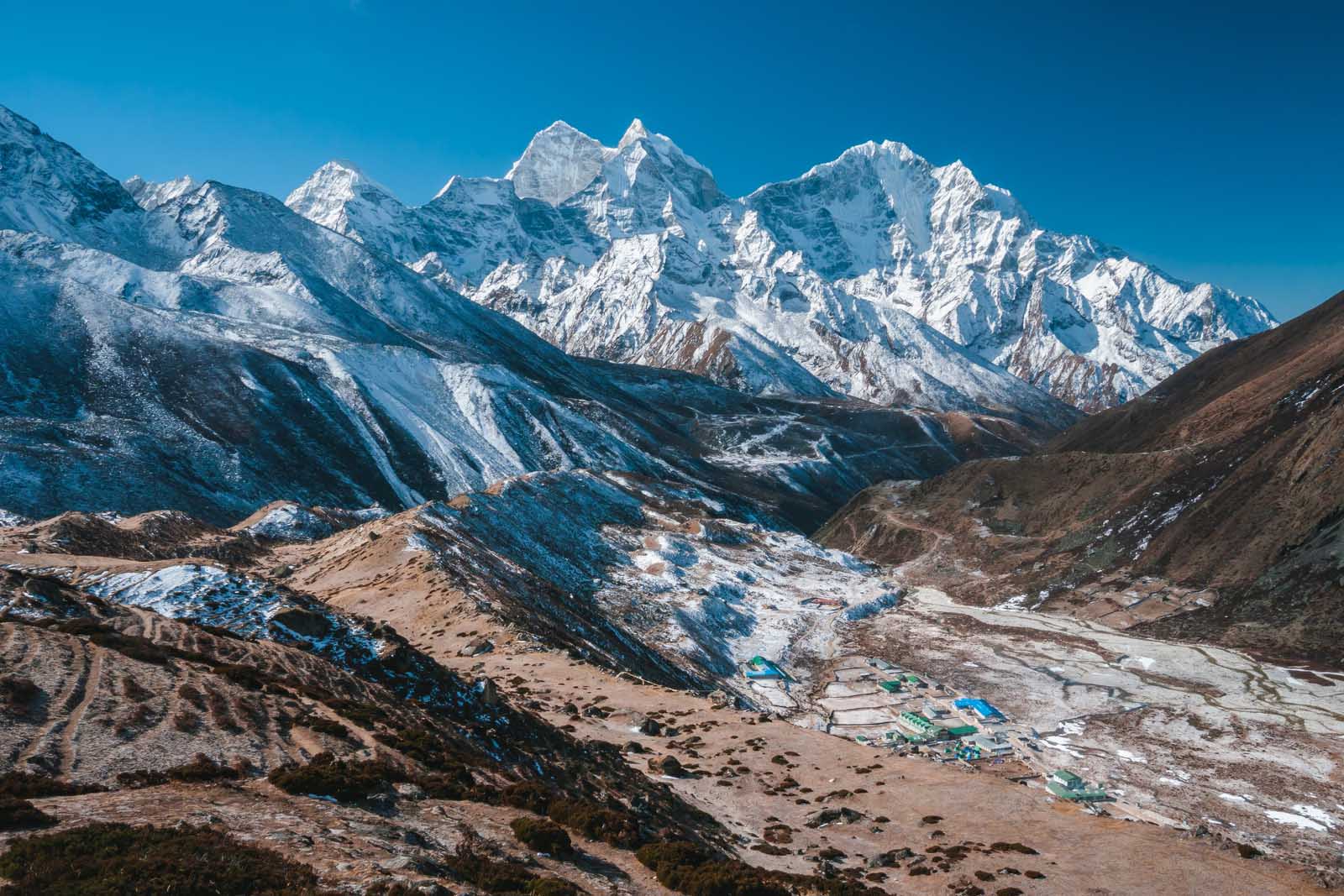
We walked with fellow trekkers we met at our guesthouse Martin and Richard from Slovakia during the morning hours. They carried their own packs and after watching them struggle, we were happy we hired a porter. (note: As of April 2023, you can no longer trek independently in Nepal) They were really starting to feel the altitude and we eventually left them behind.
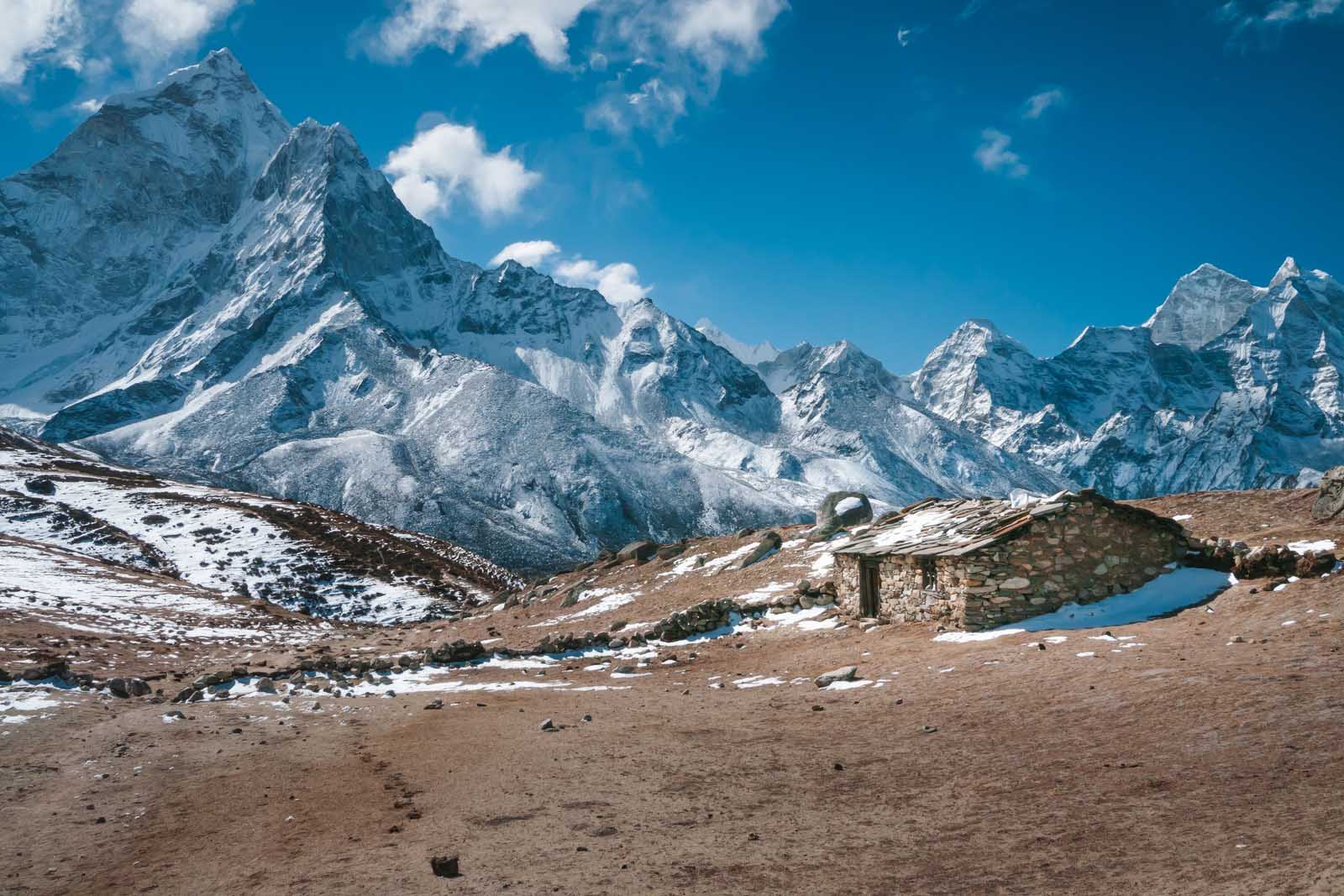
We enjoyed our day taking photos of the stunning clear views of the Everest region. It may be a little colder trekking in Nepal at this time of year (Early March), but the skies are clear and blue. When we came across a small cluster of houses, we felt like we had entered the Kingdom of Middle Earth. Little Hobbit houses lined a valley with giant peaks looming overhead.
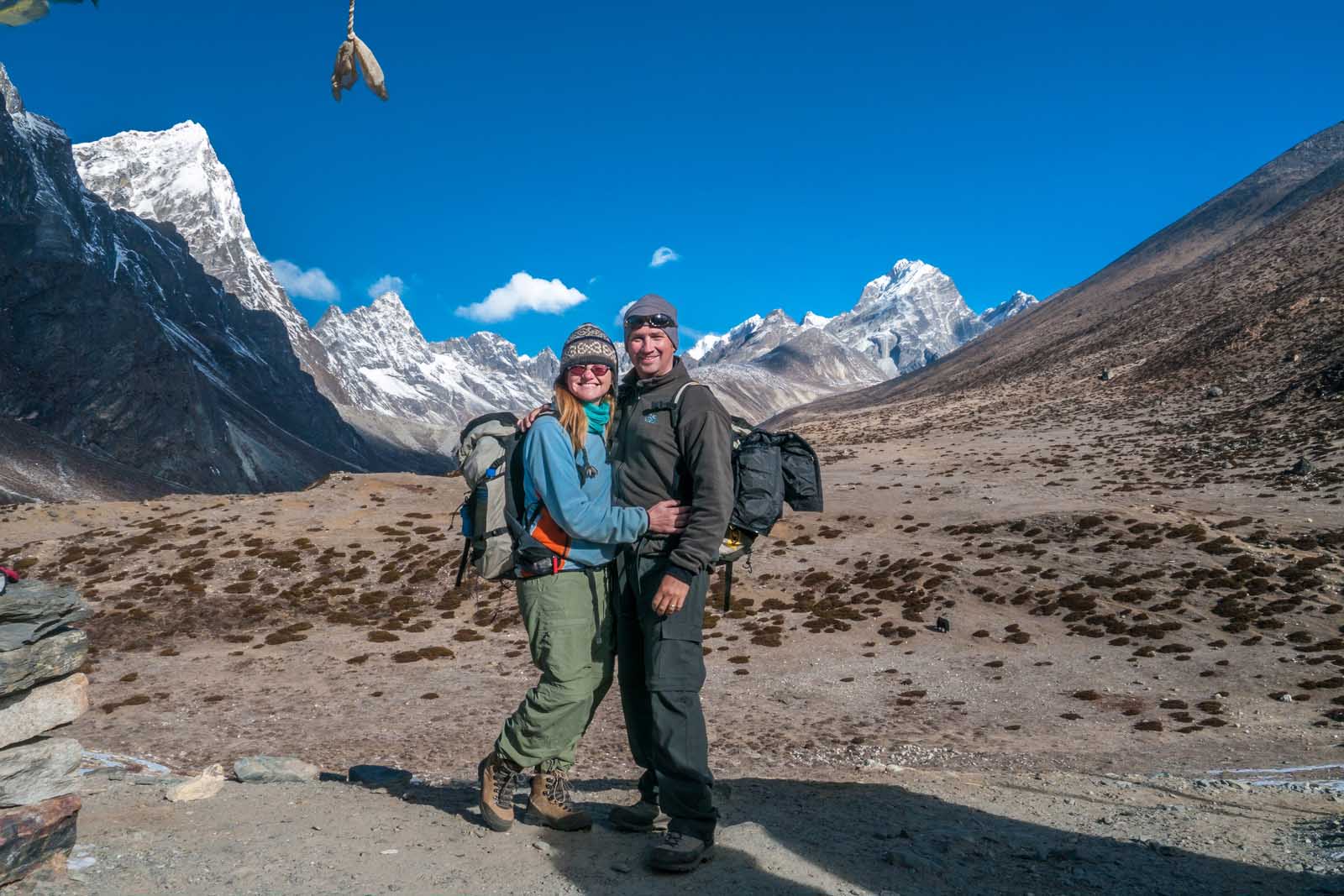
We had a front-row seat to some of the most breathtaking views on earth. An entire panorama of the mountains standing proudly overhead, reaching up to the deepest blue sky that I have ever witnessed. The scene took our breath away. The mountains looked more imposing with each corner we turned and we could not believe that we were fulfilling our dream of hiking to Everest.
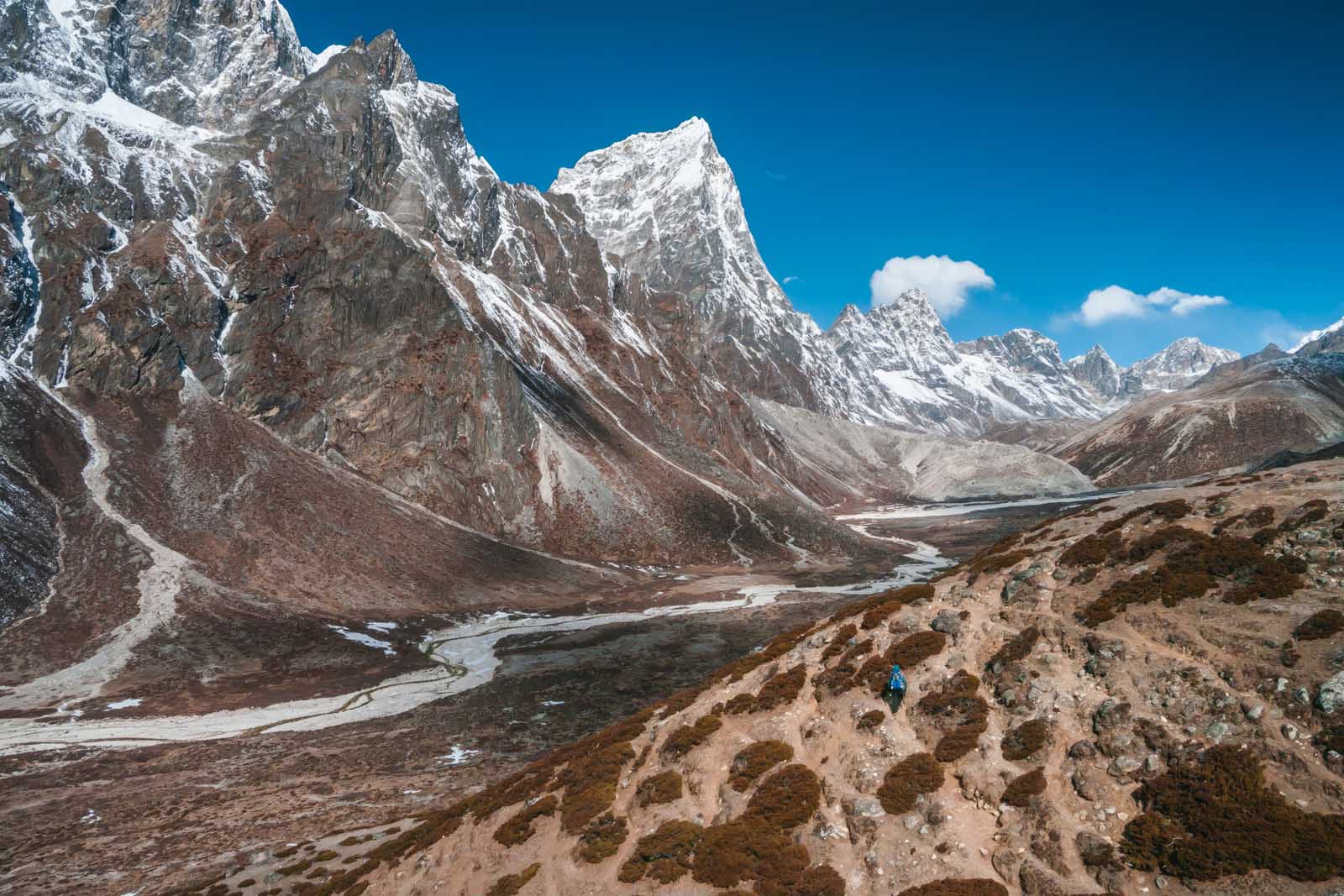
We had to knock on the door to see if Bilbo Baggins happened to be in. Sadly, he wasn’t home. I ended up singing Leonard Nimoy’s Ballad of Bilbo Baggin s for the rest of the day. A bad idea since I only know a few words.
Weather Conditions
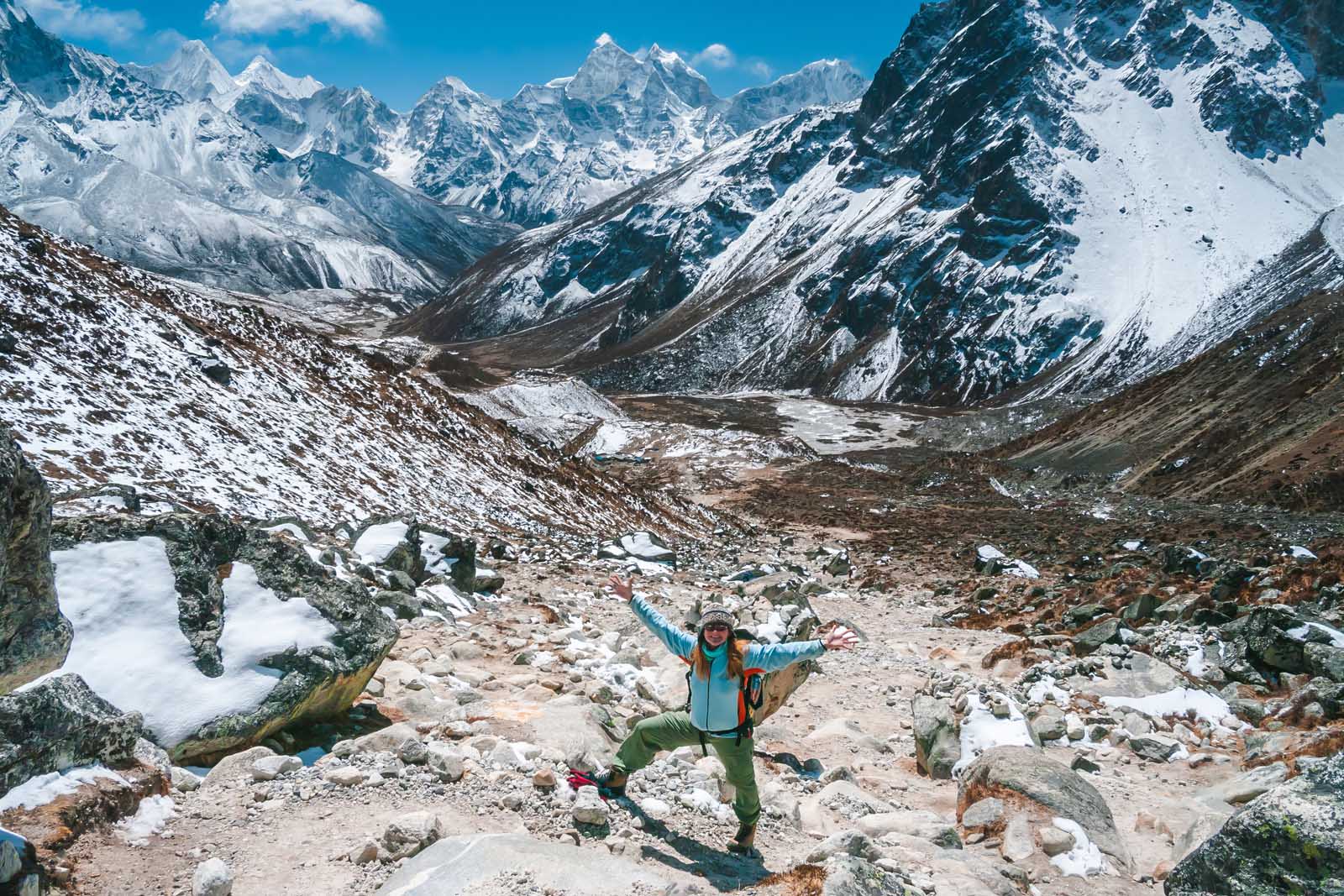
The wind picked up and we put on our outer layers for the first time. We were thankful to have them as we staggered through the high gusts. Weather varies greatly in the Everest Region and before you know it you can have inclement weather so be prepared with your layers. The sun can be shining one minute and then wind and clouds roll in the next.
After lunch, we faced quite the scramble up a steep hill littered with boulders. It looked like a tough climb, but we moved with ease and quickly made it to the top. Where we found our strength, I do not know.
Sherpa Monuments
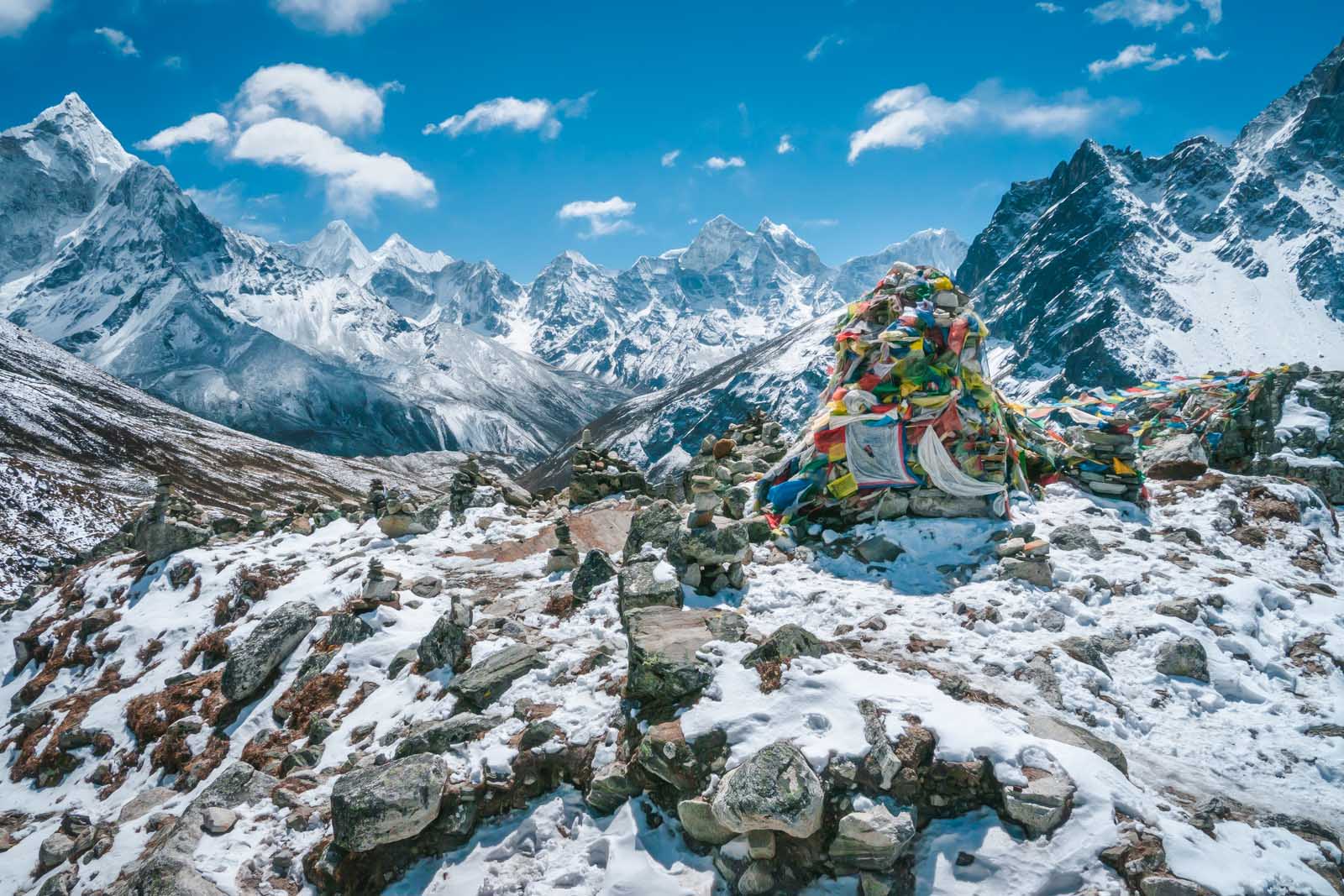
At the top of the hill is a very moving sight. Several monuments and stupas are erected, honoring Sherpas and climbers that have lost their lives on Everest. The most notable of these is Babu Chiri Sherpa .
Babu Chiri Sherpa was the former world record holder of the fastest ascent of Everest, the most number of ascents up the mountain, and the quickest back-to-back summits of 2 in less than 2 weeks. He tragically lost his life on his 11th attempt when he fell into a crevasse.
It was a moving experience and a strong reminder to not take things lightly on Everest, even if you are only trekking to Everest Base Camp. It is still a serious trek.
Dingboche – Elevation – 4410 meters. (14468 feet) above sea level Lobuche – Altitude – 4940 meters (16207 feet) Elevation Gain – 530 meters (1738 feet) Distance – 17.6 km (10.9 miles) Duration – 4 to 5 hours
Day 8 – Morning – Lobuche to Gorak Shep
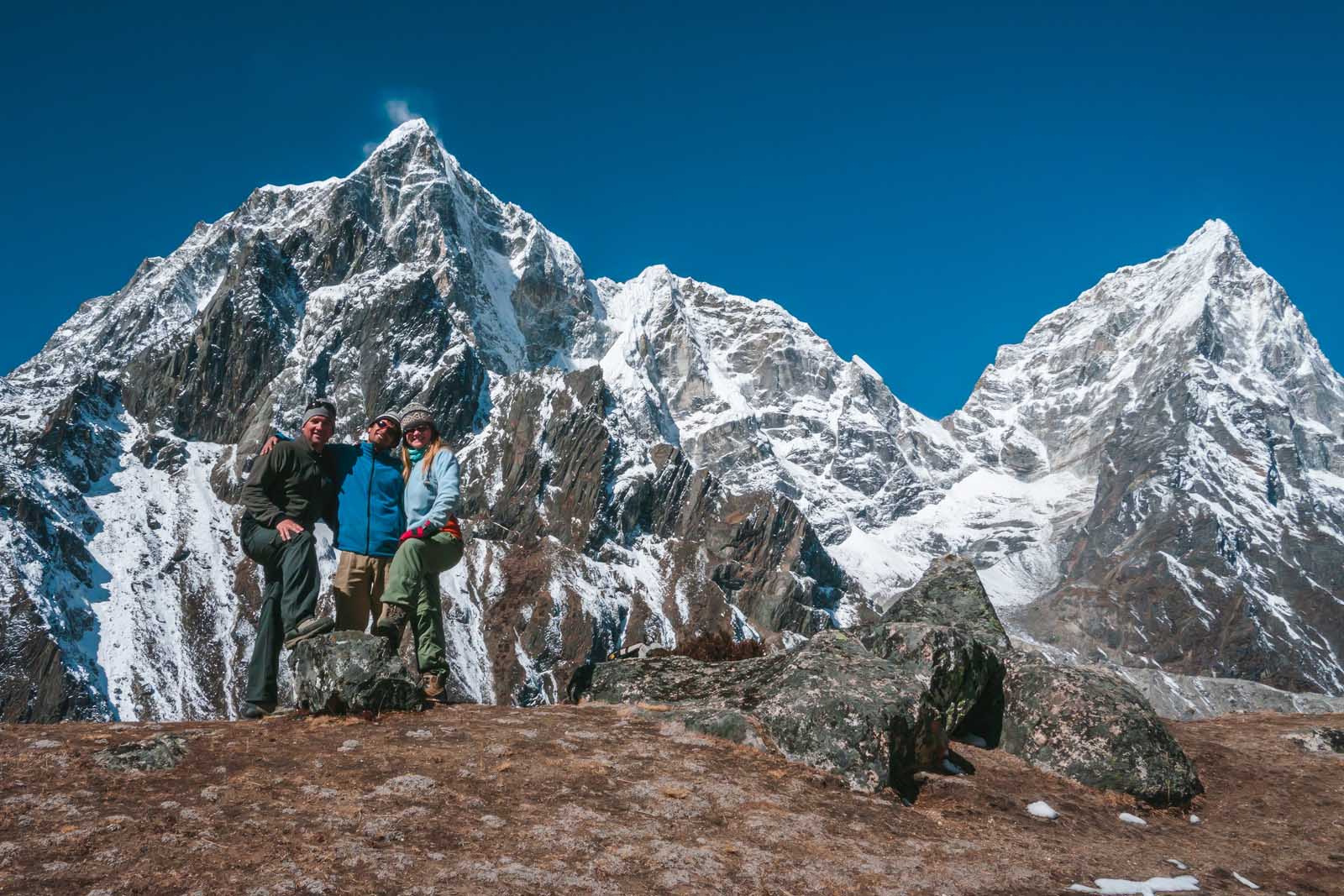
Day 8 on the Everest Base Camp Trek takes you to 5000 meters (16404 feet). How did we feel at 5000 meters? Terrible. Before entering Nepal, I had been suffering for a few weeks in India. The pollution of Kathmandu didn’t help and my congestion was worse when I started the climb. I thought it would clear up in the fresh air, but it intensified with each increase in altitude.
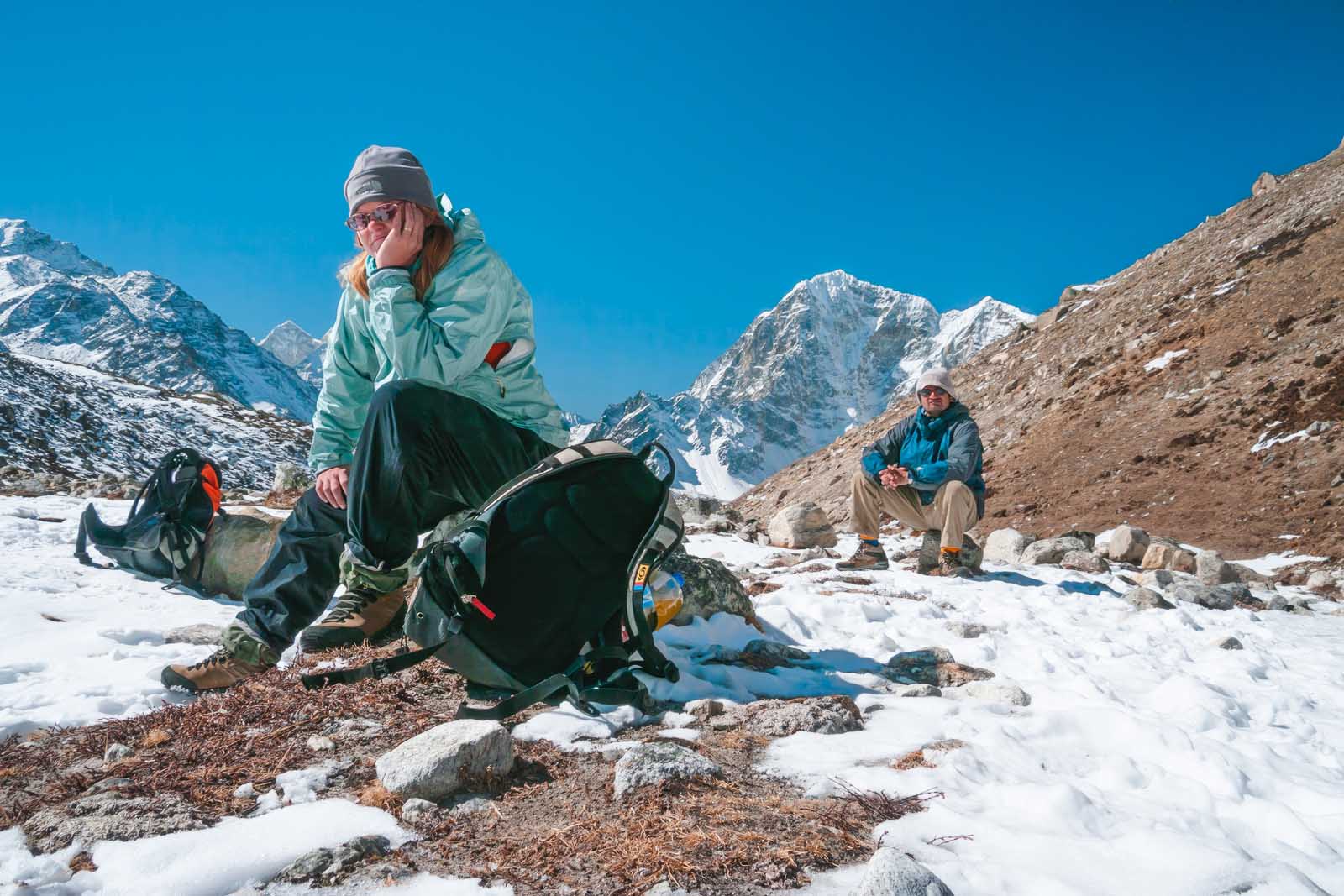
Every morning my cough got worse and my nose was stuffed up to the point of being unbearable. Today, I felt the effects of the congestion and couldn’t catch my breath. It didn’t help that we had gone into such a high altitude. The air is thin and cold.
Dave suffered his first symptoms of altitude sickness when reaching 5000 meters as well. He had a slight case of diarrhea and wasn’t happy about having to wait for the toilet in the teahouses. I think many people were suffering from the same symptoms.
Our was a slow climb to Gorak Shep. We stopped regularly to catch our breath and today we took more breaks than usual. Luckily it was only a couple of hundred meters in elevation gain so we made it to our guest house in Gorek Shep by 12:30.
Lobuche – Altitude – 4940 meters (16207 feet) above sea level Gorak Shep – 5164 meters (16942 feet) above sea level Elevation Gain – 224 meters (734 feet) Distance – 4.3 (2.6 miles) Duration – 4 Hours
Day 8 – Afternoon: Gorak Shep to Everest Base Camp
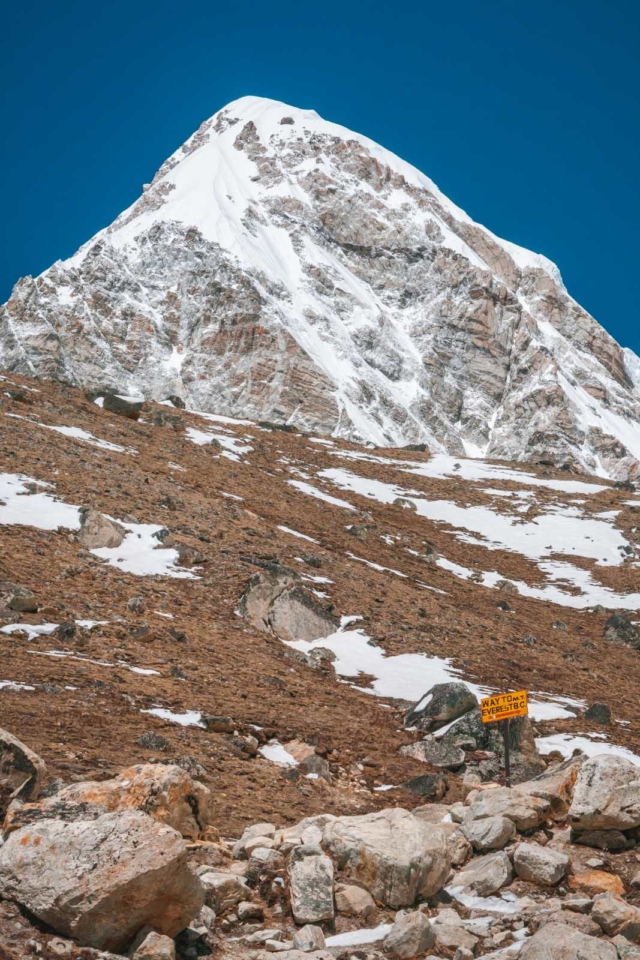
We took a break at Gorek Shep before making out way to Everest Base Camp. We sat in the sun marveling at the fact that we made it this far. After eating a hearty lunch of vegetarian Sherpa stew (Dal Bhat) on the terrace, (yes, we ate outside in the warm sun above 5100 meters) we set out for Everest Base Camp. The sun was shining brightly and it was quite pleasant outside so we were very excited.
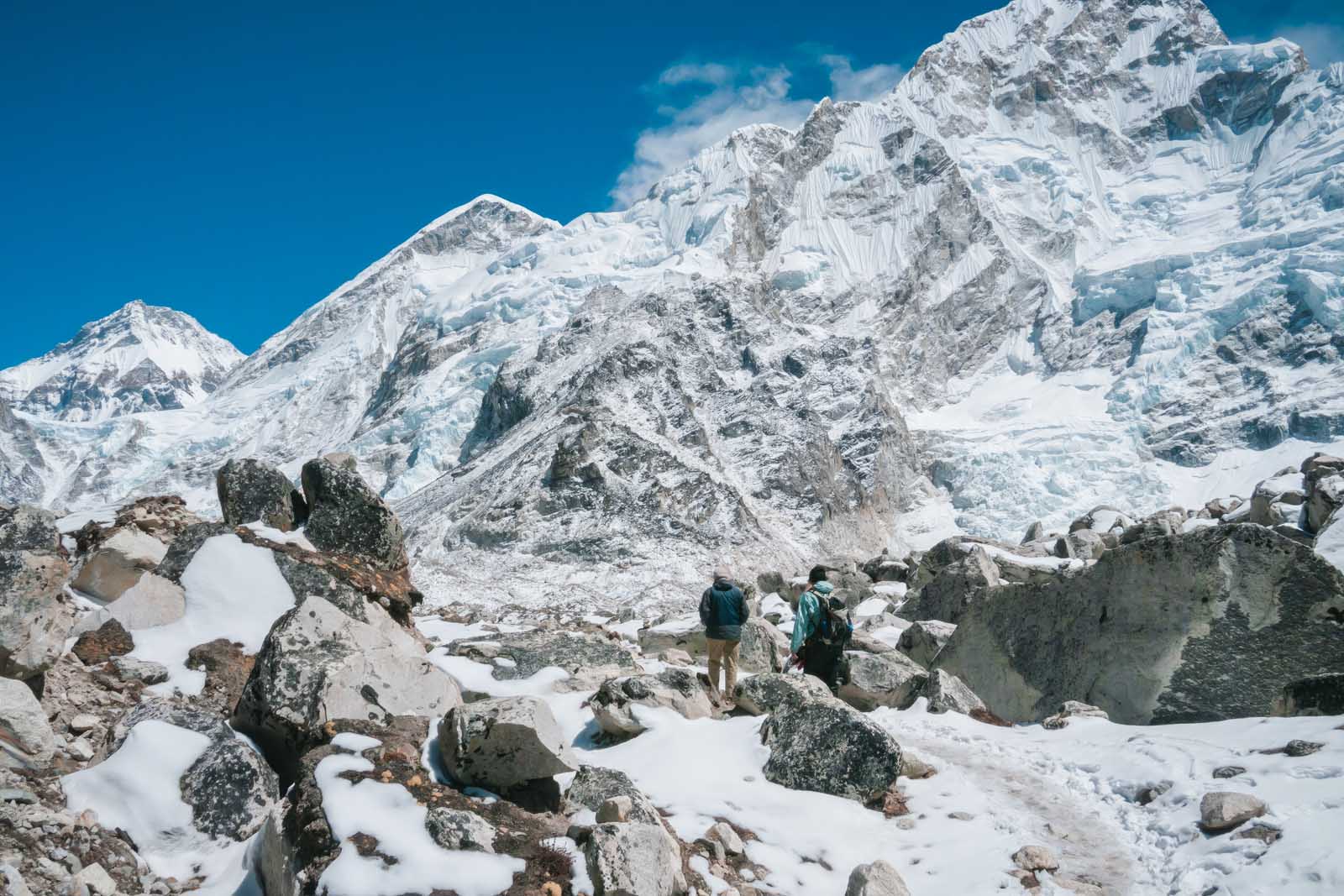
We were lucky and had clear skies. Up until today, the clouds had rolled in by early afternoon every day. Today the sun shone and the skies were blue until sunset. So, it was our perfect morning to make the push.
The trek to Base Camp from Gorak Shep is an easy one. It’s two hours of walking with only a small elevation gain, and we made it with ease. That break for lunch really helped our spirits.
Reaching Everest Base Camp
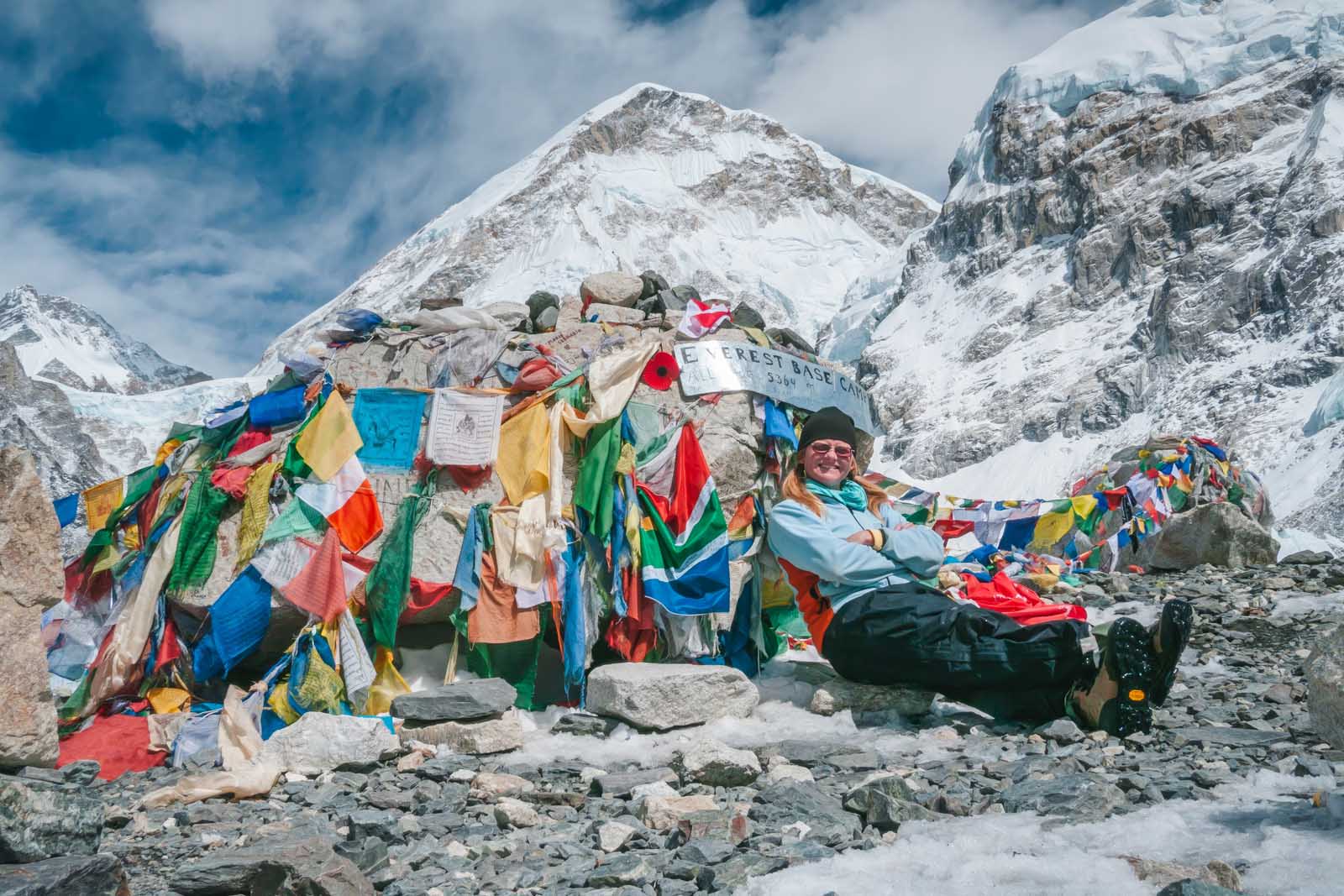
People can summit Mount Everest from Tibet, but the main Everest Base Camp expedition route is in Nepal, and it is busy when the season is in full swing. Even those climbing to the peak of Mt Everest hike the route we took along the Everest Base Camp trek.
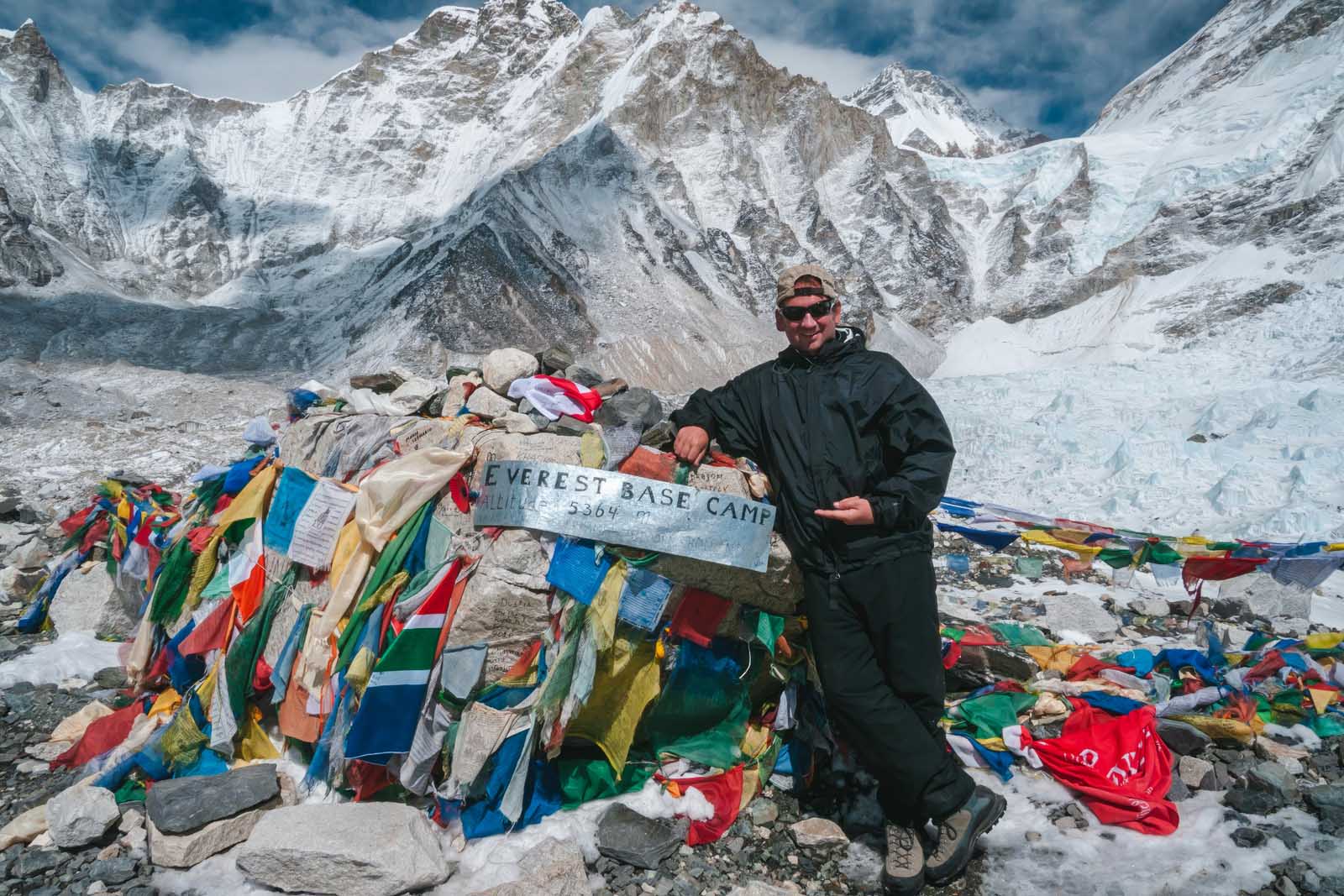
We arrived just a week or two before the season, so it was still quiet on the mountain. In fact, we were the only people at Base Camp that afternoon. We saw another group coming down on our way up, but once there we had it all to ourselves. It was thrilling.
To reach Everest base camp, you will hike out from nearby Gorak Shep and then hike back the same day to spend the night in the village. You do not spend the night at base camp.
Khumbu Glacier
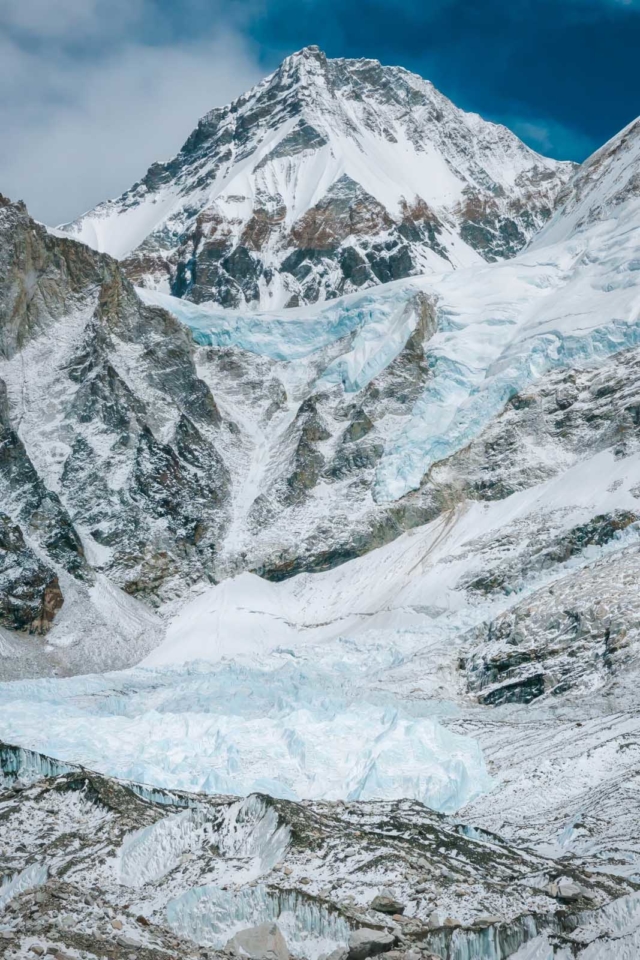
The Khumbu Glacier is the first thing to come into view, and it is unbelievable to think that we are actually standing there. The Khumbu Glacier is the largest glacier in all of Nepal and is famous for the Khumbu Icefall. This treacherous sheet of ice is the most dangerous obstacle that climbers face when summiting Everest.
We witnessed an avalanche that reminded us just how precarious the climb to Mount Everest is. It is an intimidating sight and I cannot imagine having the courage to cross that field of ice. Climbers walk across ladders that shift and move as the ice is alive and constantly settling. It has taken many lives, and we were happy to look at it from afar.
With an elevation of 7600 meters at its source, the Khumbu Glacier is the highest glacier in the world and the Khumbu Icefall is one of the most dangerous portions of the climb to the summit of the world’s highest peak. We were happy to look at it from afar.
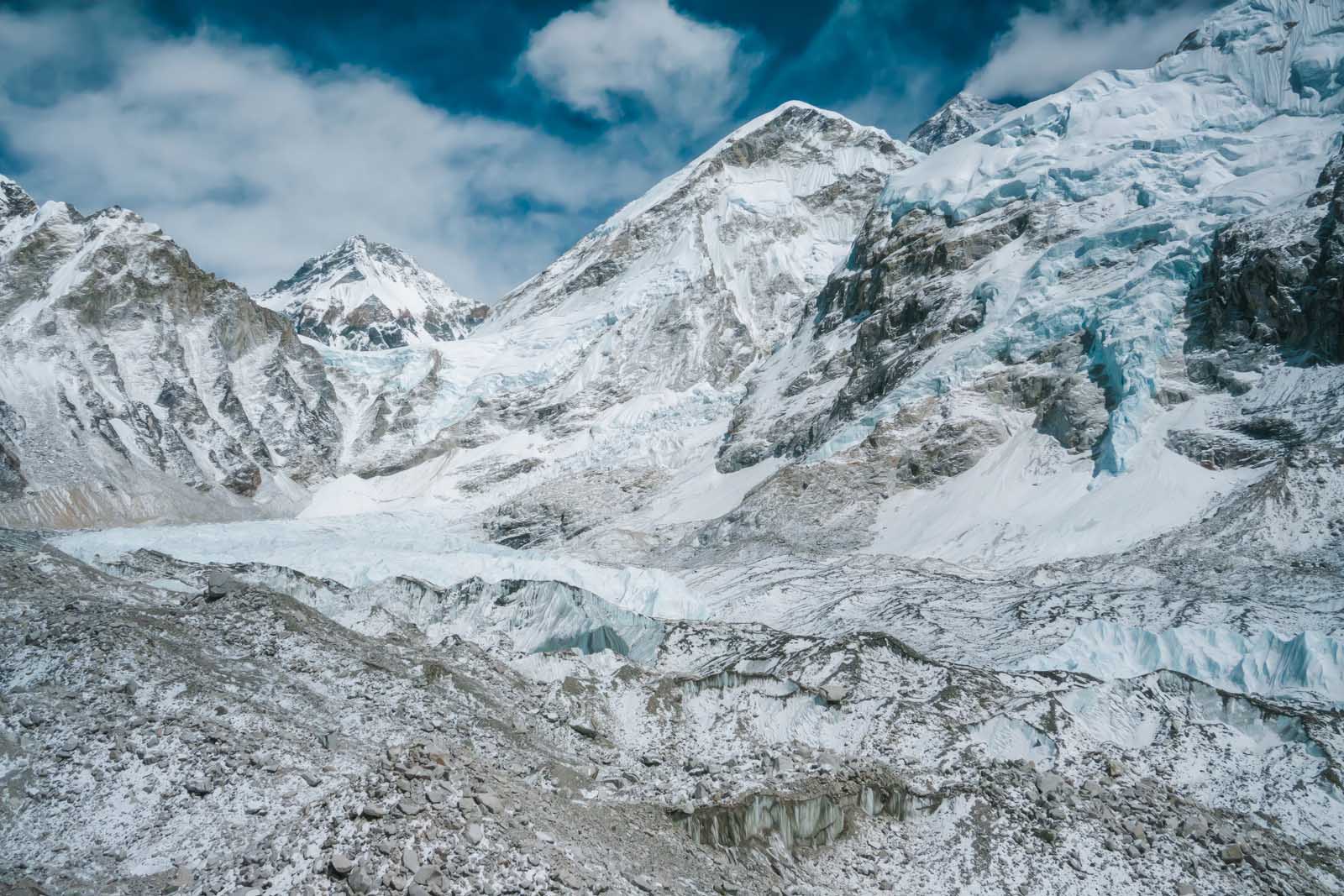
Everest Base Camp’s elevation is 5,364m (17,598 feet) so you will feel the high altitude. But, if you have taken your time you should feel pretty good. We had been at this elevation now for a while and stayed hydrated, so we could enjoy the experience.
We stood at a rock covered with prayer flags announcing that yes, we had made it to Mount Everest Base Camp at 5364 meters. We stayed for almost an hour taking videos, celebrating, and snapping photos. If you can bear it, don’t rush the experience, take it in and enjoy every minute. This will be the only time you’ll see it.
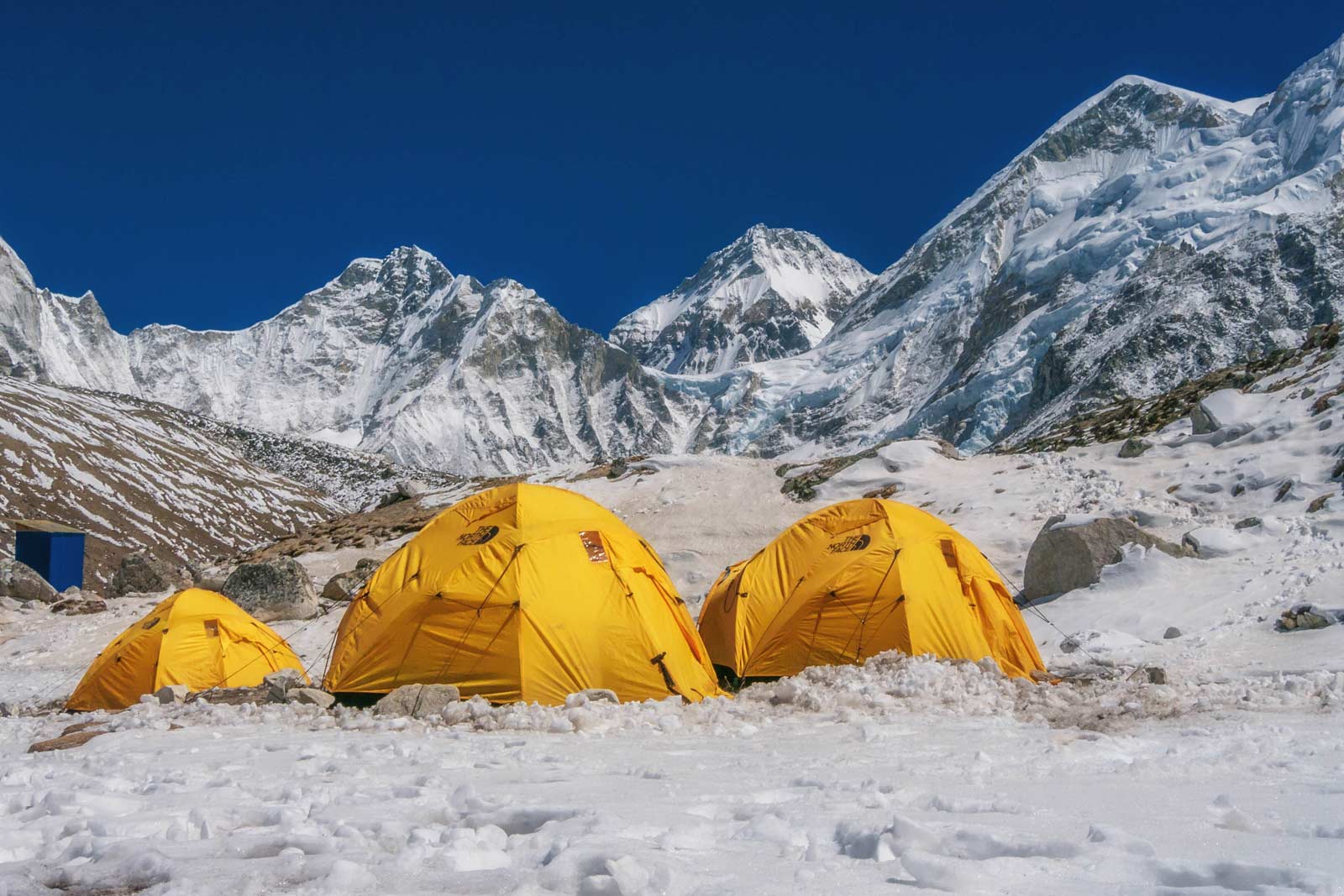
Trekking to Everest may be more exciting later in the season when Everest expeditions are there, but we really liked having base camp to ourselves. There wasn’t a soul on the mountain except for the three of us. We stayed for almost an hour taking videos, celebrating, snapping photos, and marveling at the massive Khumbu Glacier. Can it really be true that we are here? It felt like a dream.
We finished our climb about two weeks before the high season began and we wouldn’t have it any other way. We stood at a rock covered with prayer flags announcing that yes, we had made it to Everest Base Camp.
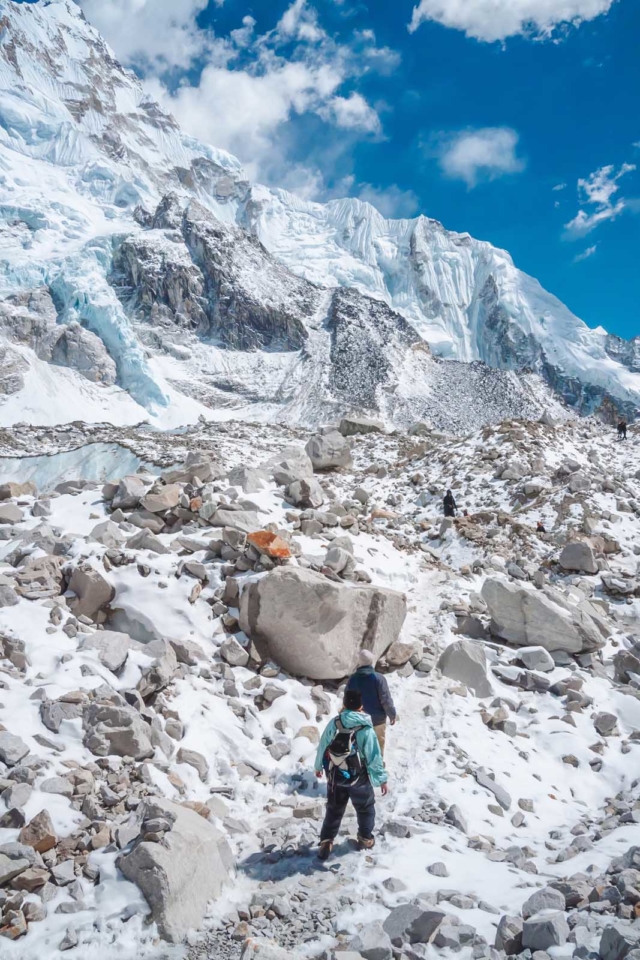
When it’s high season, base camp is filled with expeditions and tents spanning the valley. We only saw one expedition so far. They may have been here to climb Island Peak as base camp is also a place to acclimate for that peak.
We started to make our way back to Gorak Shep from Everest Base Camp at about 3:30 pm. Even though it was an easy trek back, there are narrow paths atop high ledges and it just so happens that while we were walking back, an ice bridge broke off after I stepped on it leaving Dave with a sticky situation of having to take one giant leap over a gorge. We made it back to Gorak Shep safely but it was a reminder just how dangerous the Himalayas can be.
Back to Gorak Shep
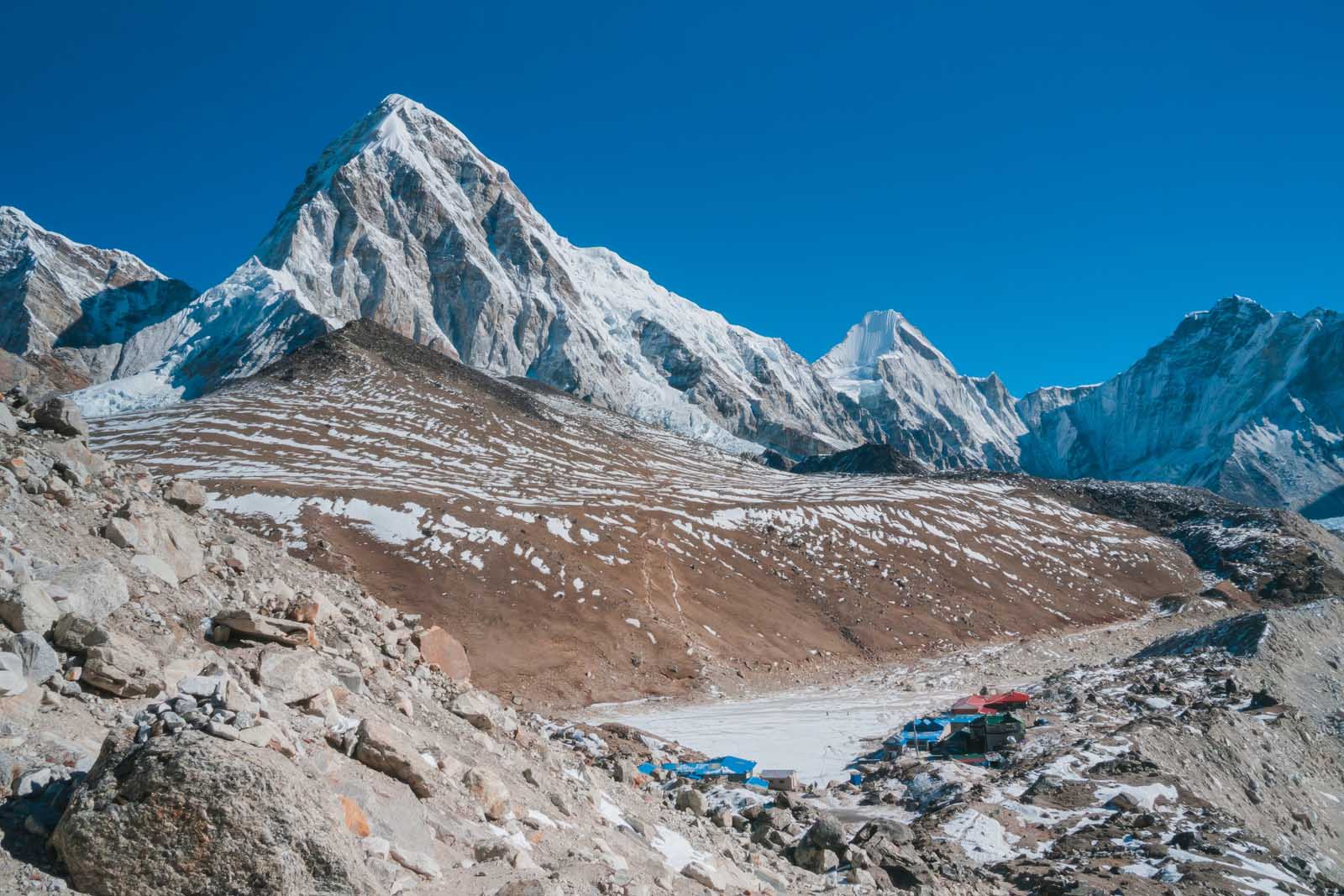
By the time we made it back to Gorak Shep, the excitement of reaching Everest base camp had worn off. We had reached our final destination Base Camp, but there was still a lot more trekking to go.
We were happy to have seen it, but we were exhausted. We felt the same when we climbed Mount Kilimanjaro. The thrill of reaching your destination is over and there is nothing more to look forward to, but there are still so many days to go.
That night I had serious sinus congestion and felt like I was suffocating in my freezing bed. It was quite scary to already be short of breath because of the altitude and then be completely congested. I really was terrified. Our guide Dipendra brought me hot tea all night and I slathered myself in Vicks Vaporub but nothing helped me to breathe easier.
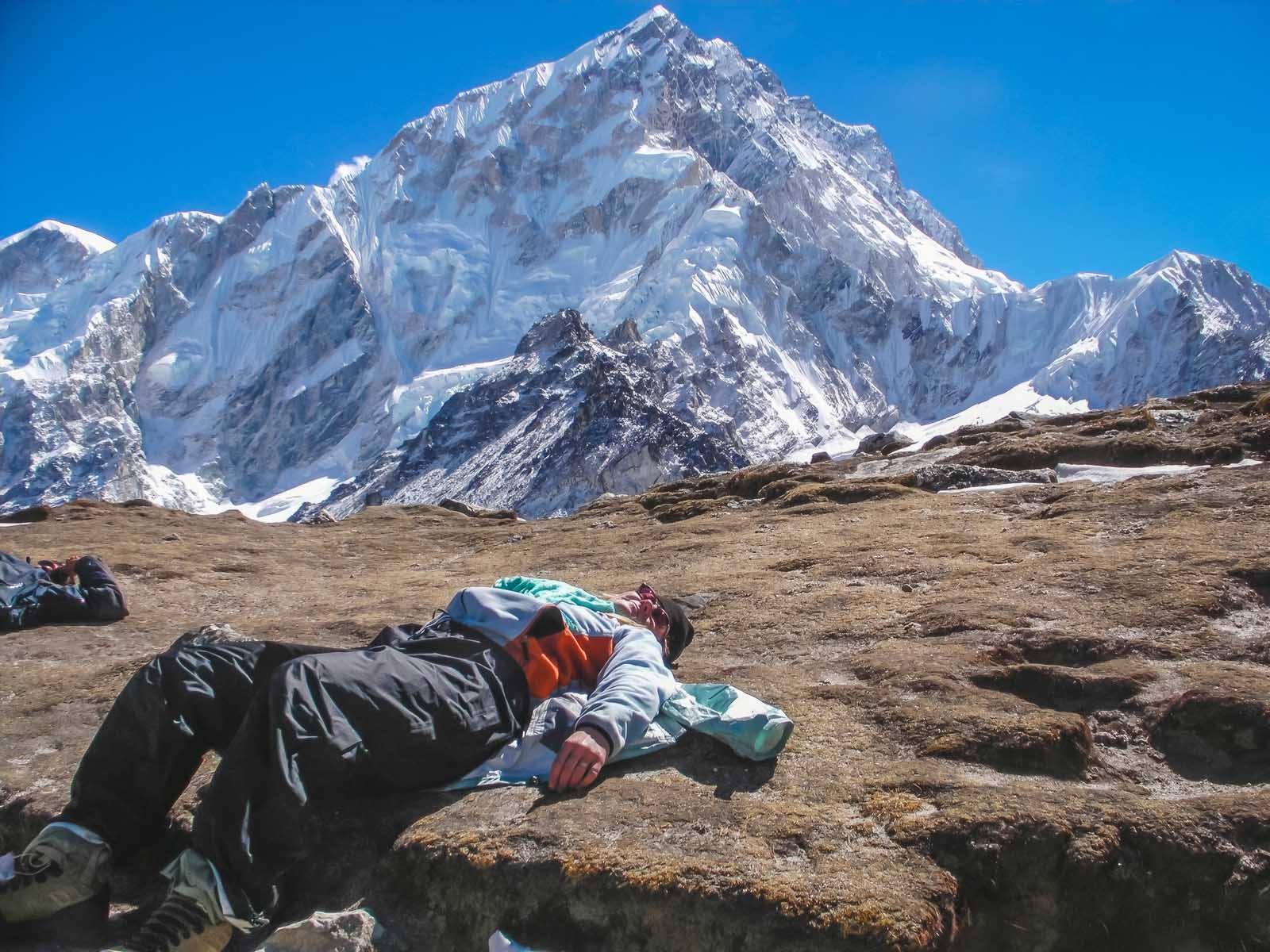
I was afraid as we had the Gokyo Lake trek ahead through the Cho La Pass. We were also planning to trek up to Kala Pattar for the best views of Everest in the morning. I hope I could make it but I was also dreading the day ahead. I barely slept a wink but I finally drifted into a not-so-peaceful slumber.
Gorak Shep – 5164 meters (16942 feet) above sea level Everest Base Camp Elevation – 5,364m (17,598 feet) above sea level Elevation Gain – 200 meters (656 feet) Distance – 3.5 km one way (2.1 miles) Duration – Three Hours Round Trip
Alternative Gokyo Lake Via Cho La Pass
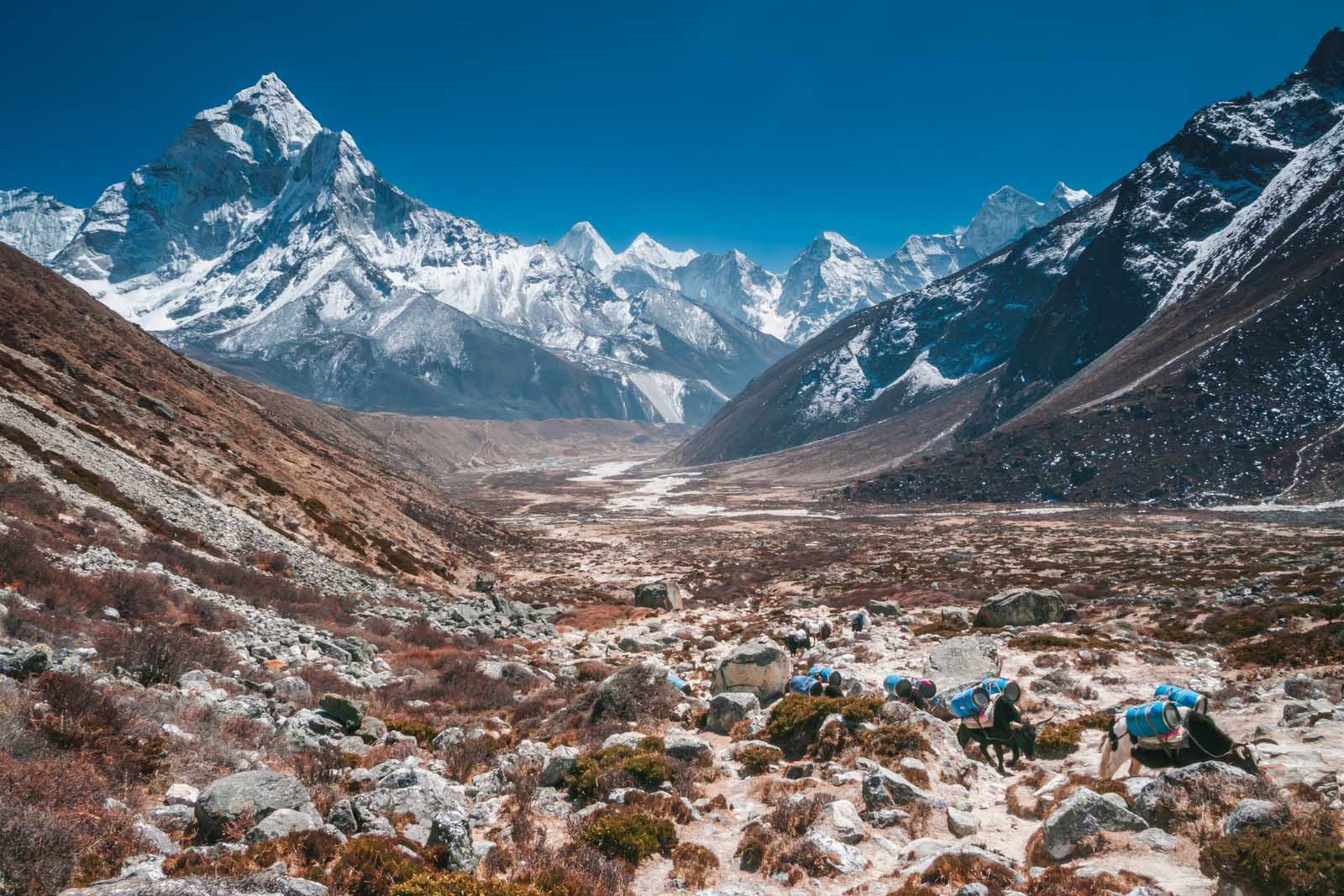
The next morning after a terrible night, we gave up our plans of climbing Kala Patthar and then on to the Gokyo Lakes and Cho La Pass trek. Even though I wasn’t feeling dizzy, nauseous, or lightheaded anymore, the sinus congestion was really getting to me. At altitude a cold can turn serious quickly, you just can’t take a chance when altitude is involved.
But, if we were going to trek on, this would be the next stop. It is supposed to be beautiful and if you are feeling up to it, we highly recommend it. This makes the trek much more interesting as you get to take a different way back to Lukla.
Cho La Pass: Altitude 5420 meters (17,782 feet) Gokyo Ri: 5357 Meters (17,575 feet) Gokyo Lakes: 4,700–5,000 m (15,400–16,400 ft)
Day 9 – The Descent and Kala Patthar
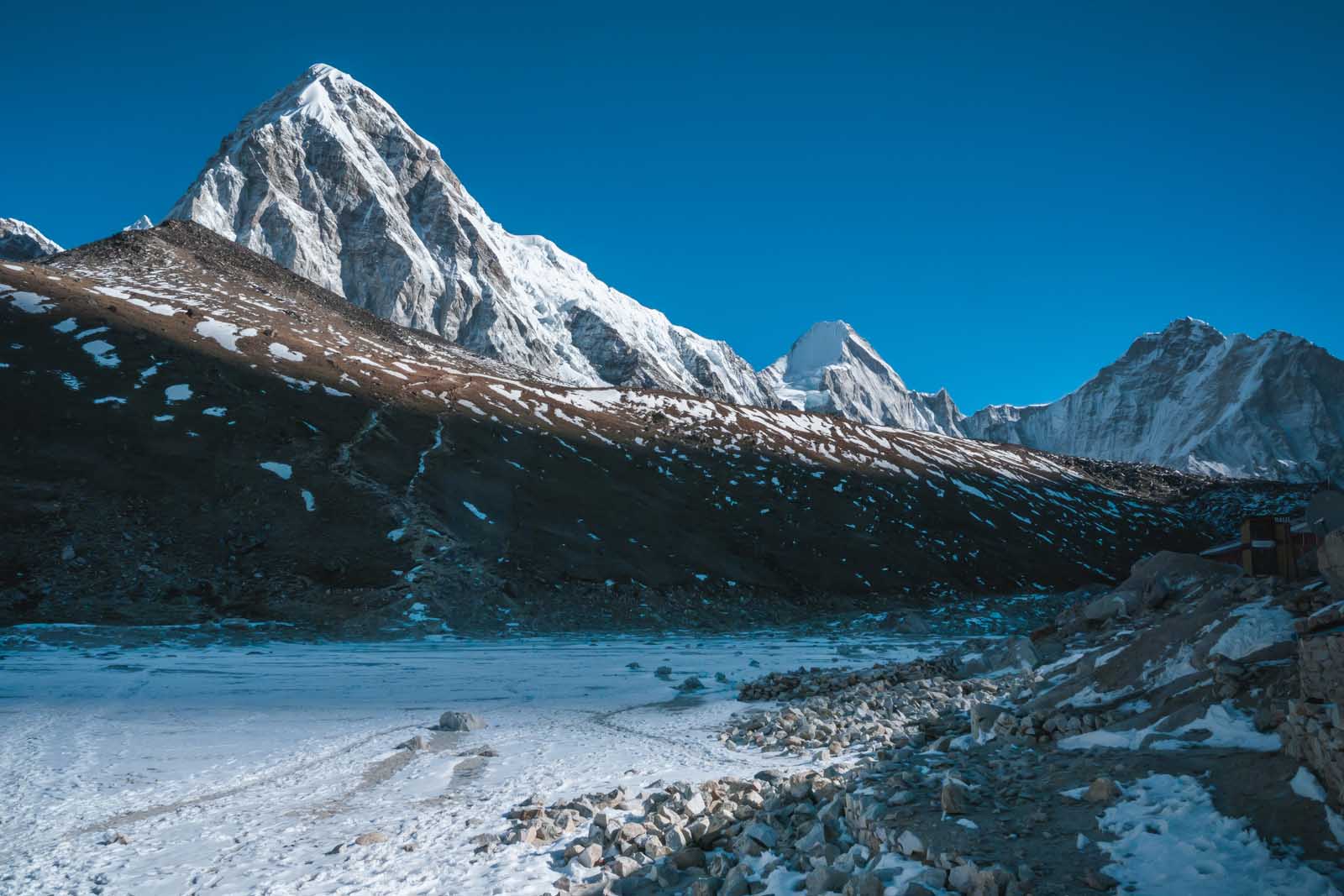
Kala Patthar is a hill above Gorak Shep that offers the best views of Everest and is a must-stop on anyone’s Everest Base Camp trekking route. We had planned to climb to the summit of Kala Patthar, but my congestion was so bad, that we decided it was safer to get to a lower elevation quickly.
Kala Patthar is a quick two-hour trek to add to your descent back to Lukla. It is a good option if you are feeling up for it as it gives a great view of Mt. Everest. Make sure to start early morning before dawn as there is still a long day of trekking after summiting Kala Pattar. Plan on another five or six hours to your next overnight stop at Pheriche.
Kala Patthar to Pheriche – Afternoon
By the time you reach your accommodation at Periche, you should be feeling a lot better. Dave and I find that we are fine in the 4000-meter ranges of altitude and experience very few symptoms of altitude sickness. It is at 5000 meters and above that, we start to feel our symptoms. Periche is a much more manageable 4371 meters.
Kala Pattar: 5643 metres Pheriche: 4371 Meters Altitude Loss : 1272
Days 10 to 11 – The Descent from Everest Base Camp
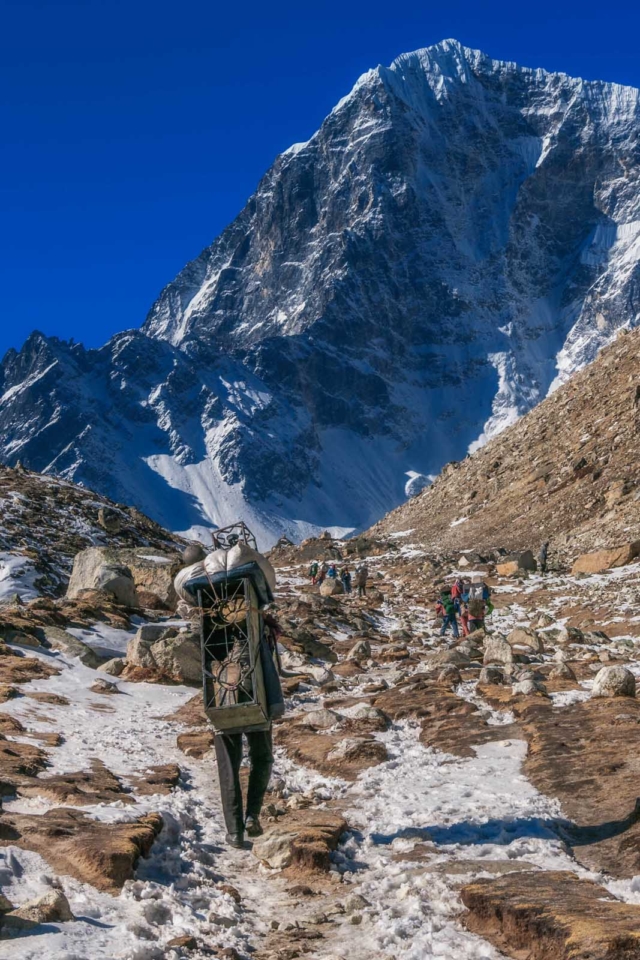
It took us two days more to trek back from Everest Base Camp to our final destination on the EBC Trek. I started feeling better on the second day as the dryness of the Everest base camp disappeared. My sinuses cleared and soon I was breathing easily. I started to feel guilty about turning around, but in hindsight, I know it was the right choice. You never want to take a chance with altitude sickness.
Even though we were heading down, there is still a lot of altitude gain as the EBC trek doesn’t continuously go downhill. I was feeling really fatigued and we still had a tough couple of days ahead of us. But knowing there was light at the end of the tunnel made everything easier.
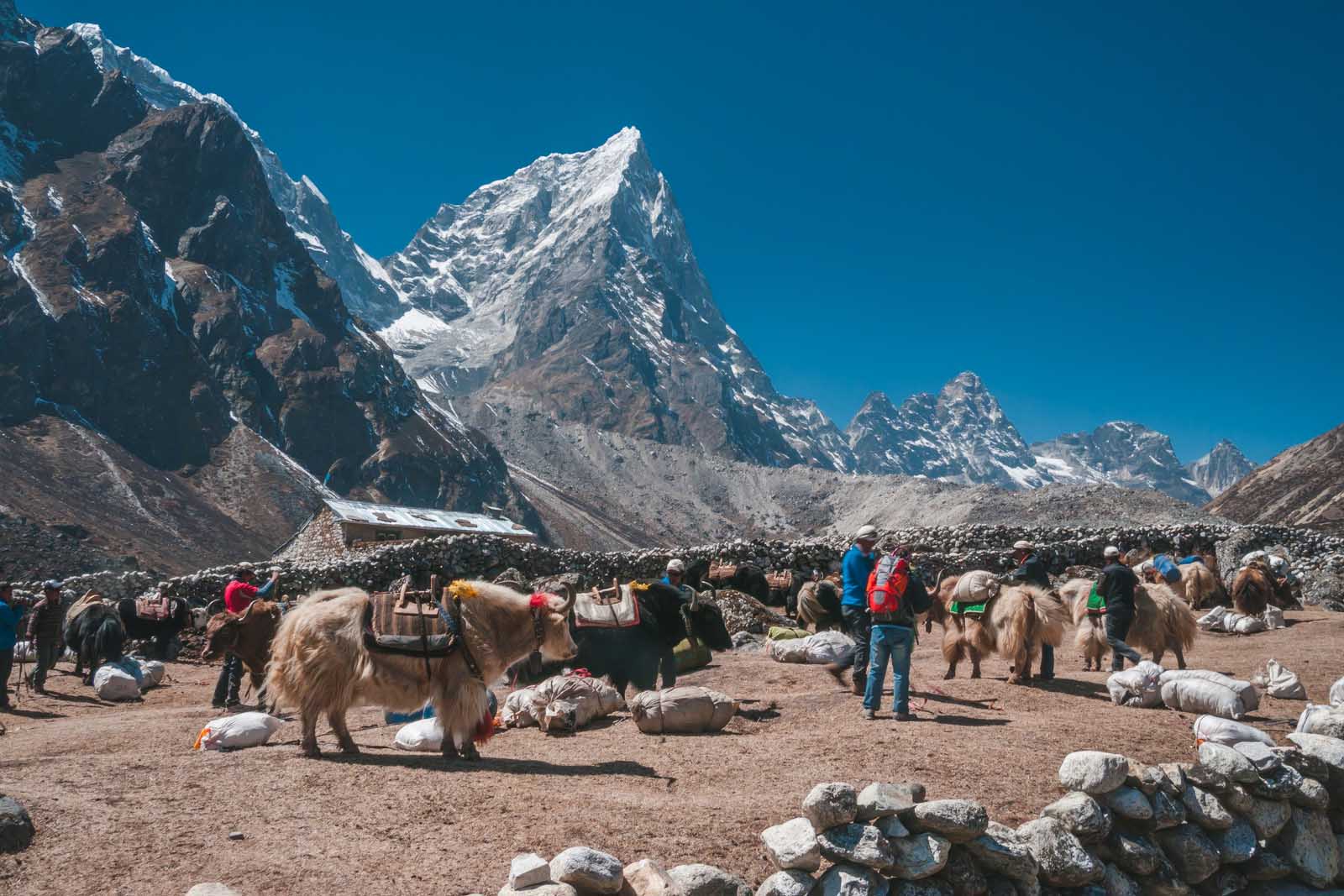
It takes a lot of mental stamina to climb back down as the euphoria of reaching the Everest base camp has worn off, but we made the most of it, by chatting with other trekkers and getting to know our guides better.
During our decent we could actually take our time to smell the roses or should I say enjoy the trekking trail that ran through the stunning rhododendron forest.
Rhododendrons are beautiful flowering plants that bloom in different shades of pink, red, white, and purple. The rhododendron forest is particularly prominent in the areas of Phakding, Namche Bazaar, Tengboche, and Dingboche which we really didn’t notice until we made our way down the mountains.
We followed the route we came up with, but it was much faster and we stayed in different villages. The beauty of booking organized trips with a local guide is that our guide Dipendra knew the routes like the back of his hand, so he could change accommodations easily to suit our speed.
Day 12 – Lukla
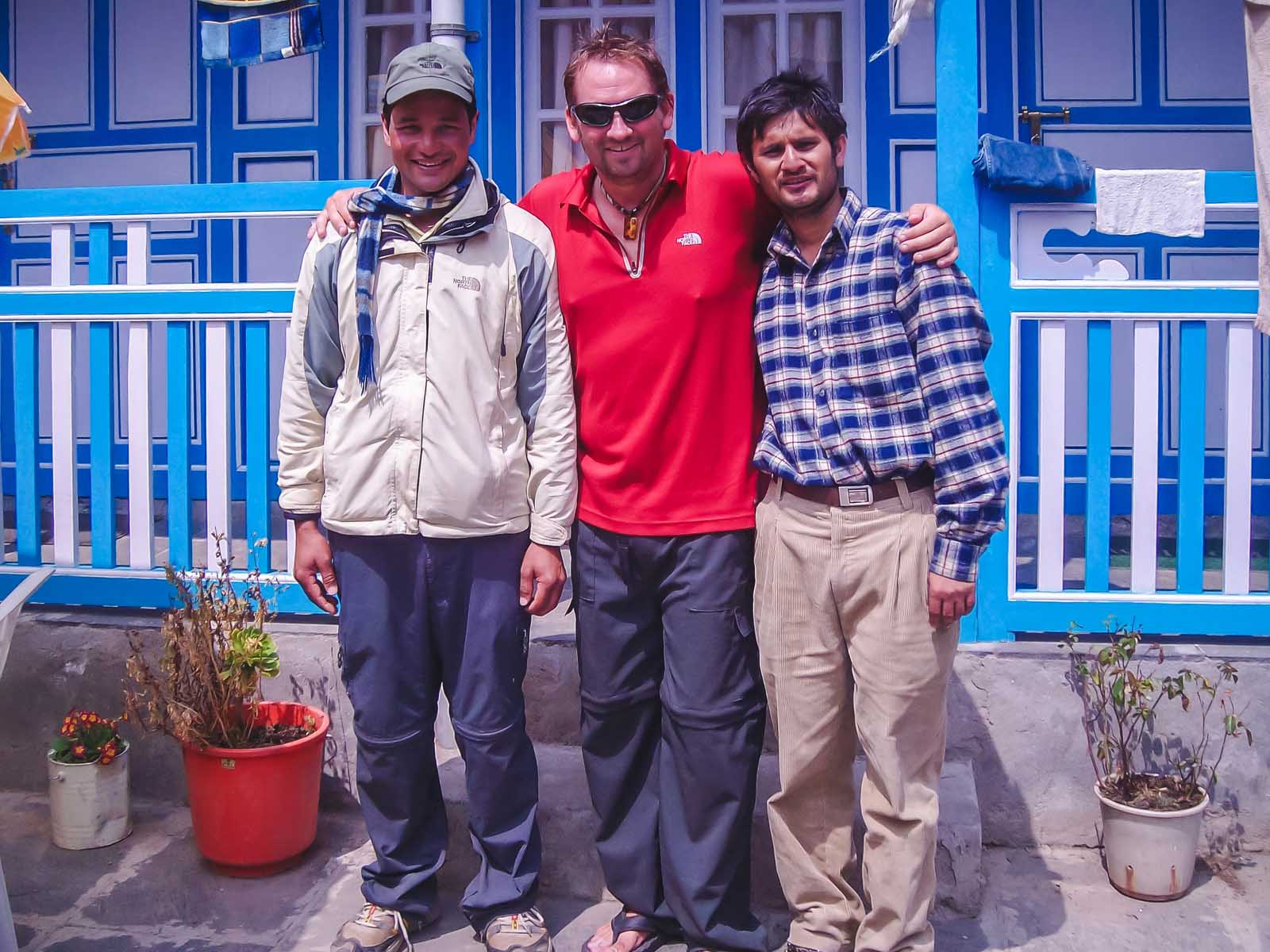
We were back in Lukla early on day 12 of our EBC Trek and had an evening booked in a guest house here to catch the first flight from Lukla back to Kathmandu in the morning. As much as we loved our trip to Everest, we were excited to be moving on to explore more of Nepal.
The accommodation was pleasant with a lovely restaurant, hot shower, and warm and cozy beds. It was a great way to end the trip.
Day 13 – Return To Kathmandu Flight from Lukla Airport
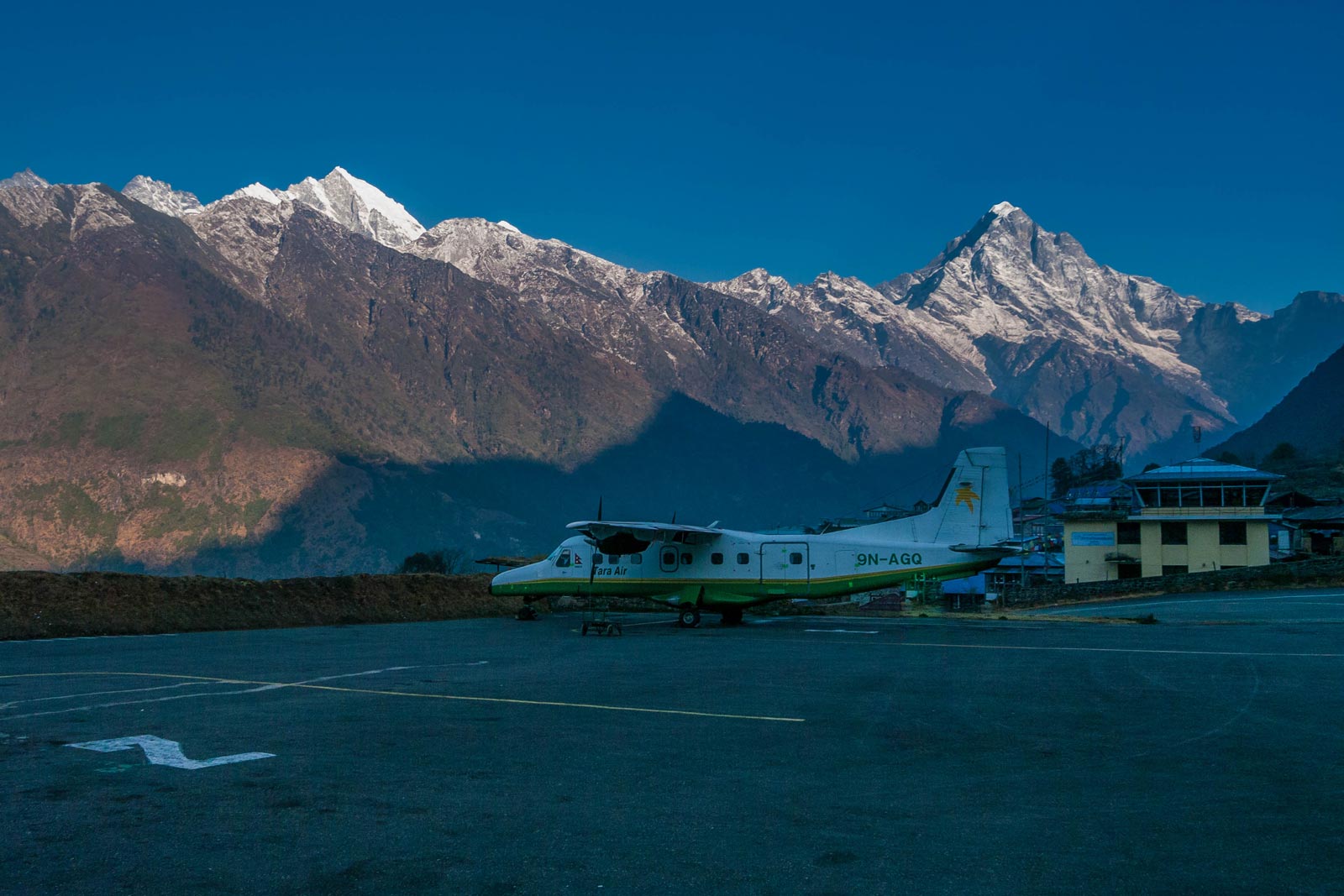
It is very important to give yourself an extra cushion when booking your return flight not only home from Kathmandu but from Lukla. We stayed overnight in Lukla on the final night of our trek and booked a flight to Kathmandu for first thing the next morning.
It is not uncommon for flights to be canceled or delayed flying out of Lukla Airport. Weather conditions change quickly. So give a bit of a cushion when booking your flight home from Nepal after you’ve finished your trek to Everest Base Camp. Many a traveler has missed their connecting flights home from Kathmandu because of delays in Lukla. It is safer to plan to spend a night or two in Kathmandu after your trek.
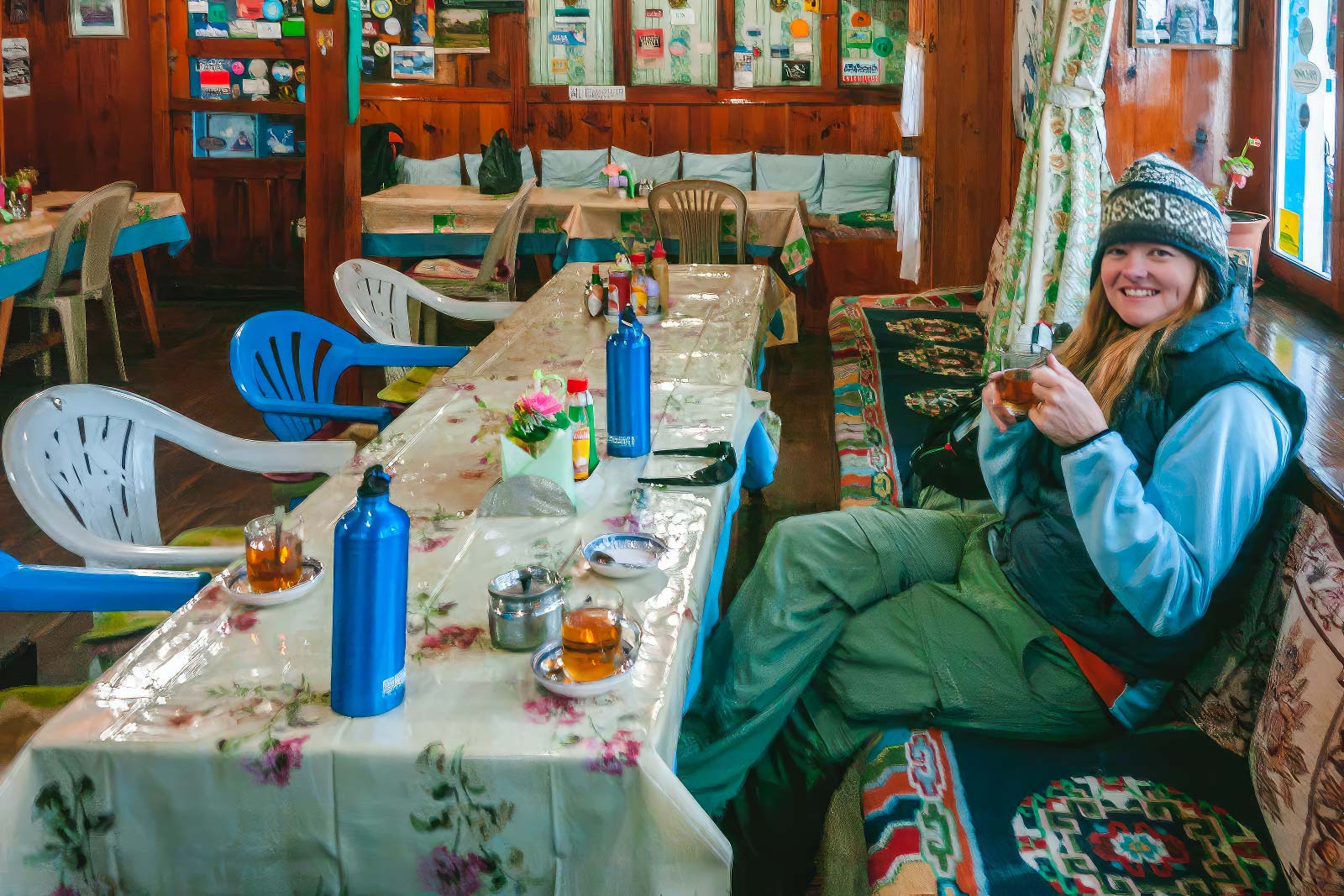
We were delayed an entire day. Even though we were booked on the first flight from Lukla, the weather made us wait until near sunset. We were the first (and only) flight out that day, so everyone else who was waiting for their flights all day was stuck another night.
It was a bumpy flight back to Kathmandu and we almost wished that we didn’t make it on the flight. The turbulence was so bad, I was sure we were going to drop out of the sky.
Everyone on the flight was silent as we were tossed about dropping huge amounts of elevation at a time. But we landed and we have never been so happy to arrive in Kathmandu. We kissed the ground, thankful to have trekked to Everest Base Camp, but vowed to never do it again.
Accommodation – Tea Houses on Everest Base Camp
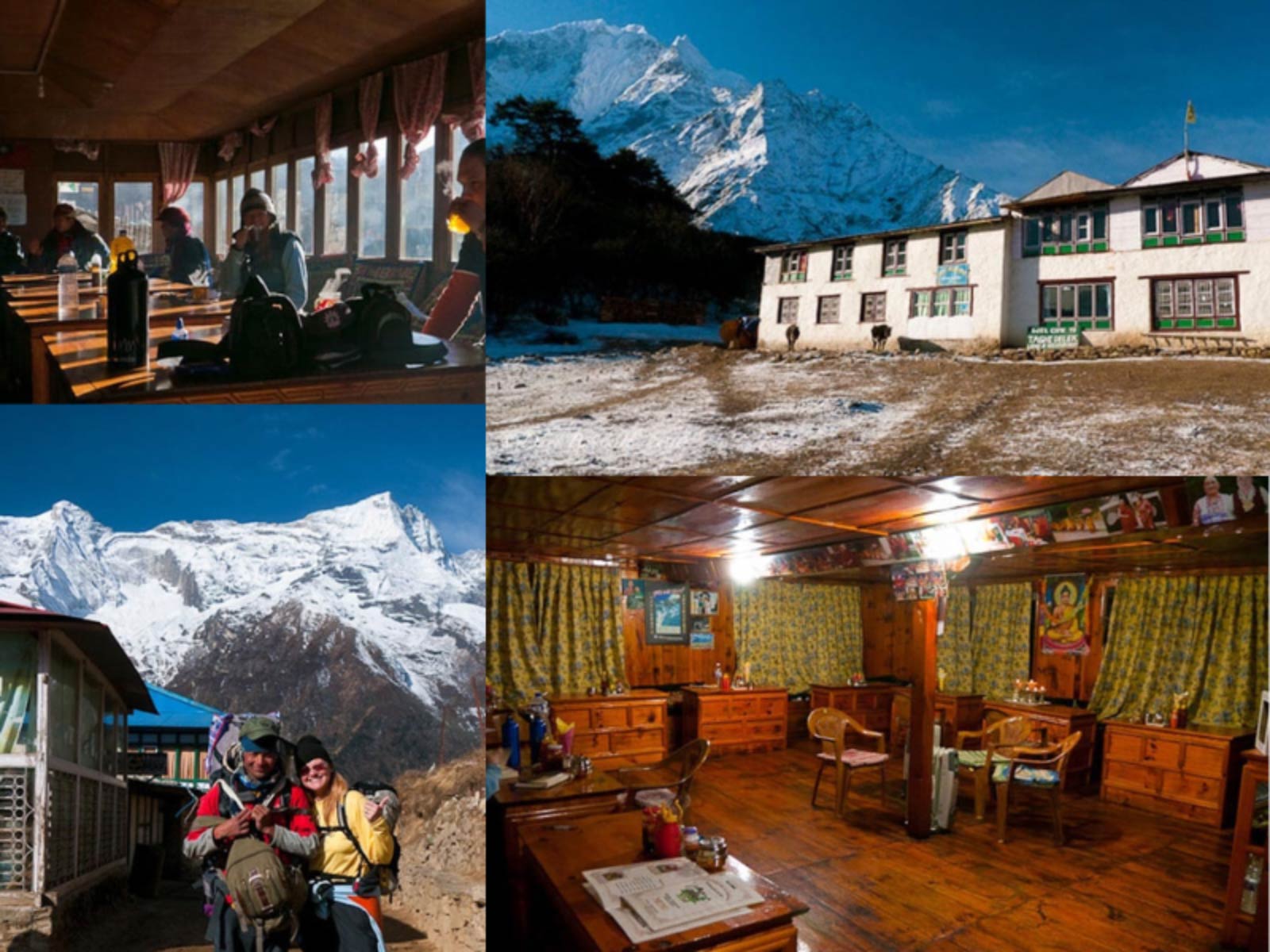
The main lodges of each teahouse we stayed in during the first half of our trip were cozy and warm. At the lower elevations, woodstoves burned wood in the dining room and common areas and our rooms were a comfortable temperature as we were wrapped up in our sleeping bags.
But as we ventured higher, the stoves were less abundant and instead of wood, they burned yak dung. You heard me, Yak Dung. Wood can’t burn in thin air, so they use yak dung to heat the teahouses at high elevations. Rooms are not heated so when we went to our rooms, we had to wear hats, thick socks, puffy coats, and long johns.
There were charging stations at the accommodation for electronics and we paid by the hour for electricity.
- We highly recommend taking a portable USB charger to charge your own electronics.
- We also used a solar USB charger that recharged during the day as we hiked.
Meals on Everest Base Camp
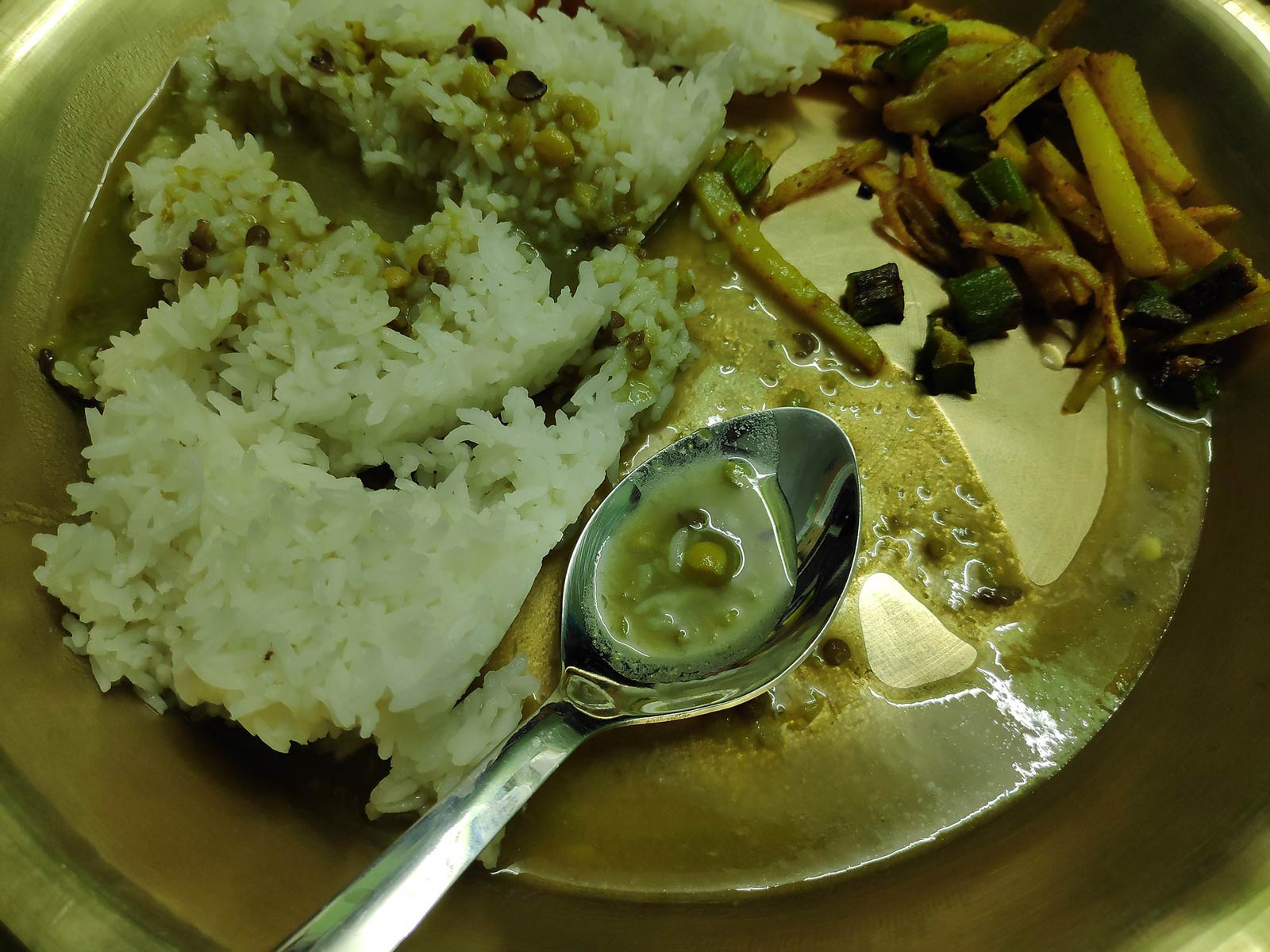
Because we booked an all-inclusive Everest Base Camp trek with Simrik Real Nepal tour company, all meals and snacks were included with our accommodation. Each evening, hearty meals were served that included pasta, rice, or Dal Bhat. Dal Bhat is the staple food of Nepal consisting of lentils, vegetables, steamed rice, and curry.
For the first few days, meat was served at meals, but as you climb higher, meals turned to vegetarian as it is more difficult to get the meat up the mountains.
Prayer Flags and Prayer Wheels – EBC Trek Etiquette
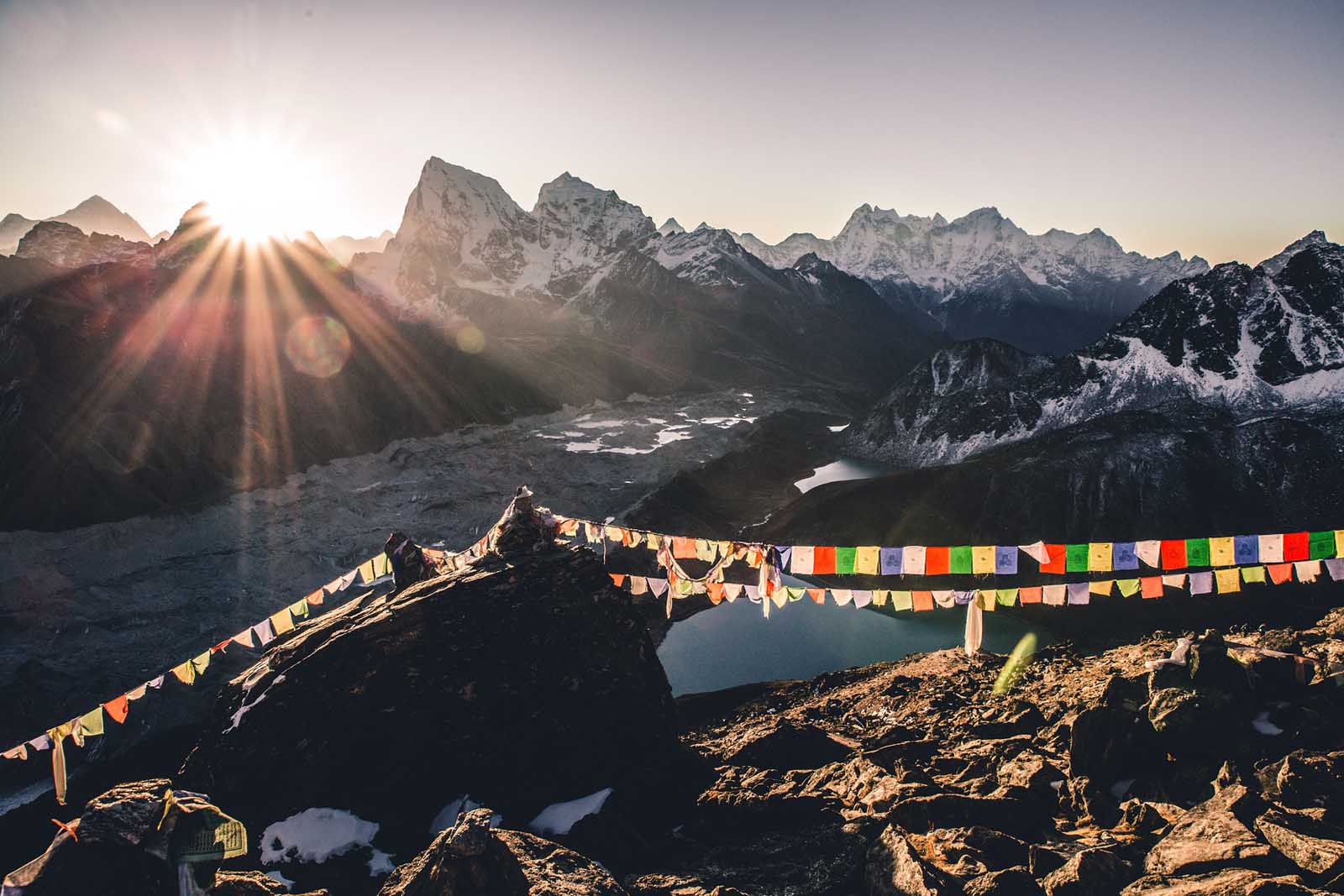
We saw many prayer wheels, prayer flags, and prayer rocks (mani stones) all along the trail to Everest. Everest is a sacred mountain and these monuments help give luck to the climbers on the mountain. There are customs to be followed when approaching prayer rocks or prayer wheels.
How to properly trek around prayer Wheels and Prayer Rocks
- When approaching a prayer rock, it is important to walk to the left of the prayer rocks (mani stones) in a clockwise direction. The stone on the right means you are on the “right hand of God.”
- When using prayer wheels, you walk along and spin them to ask for blessings for the climb ahead.
- Sherpas and locals spin prayer wheels saying the mantra “ Om Mani Padme Hum” giving blessings to the climb ahead.
- The prayer flags have prayers and mantras written on them which are believed to carry messages of positivity and to spread goodwill and compassion they are carried by the wind.
Altitude Sickness
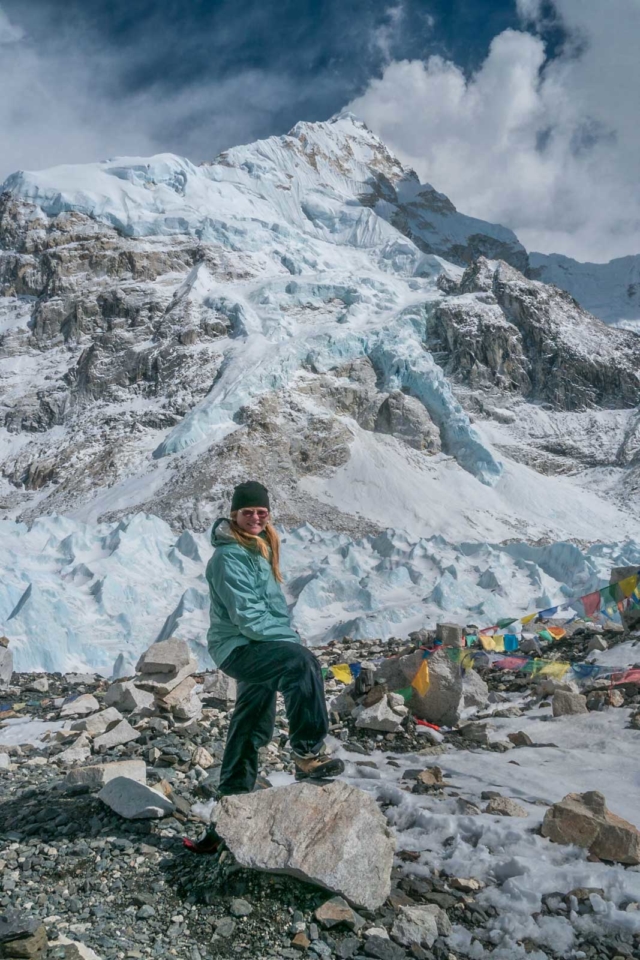
Altitude Sickness is a very real possibility on the EBC Trek. On average 3-5 people die each year doing the trek to Everest base camp. Make sure to keep an eye out for signs of Acute Mountain Sickness. Acute Mountain Sickness is life-threatening and early symptoms include nausea, headache, and vomiting. It can lead to death. The Best way to alleviate symptoms is to go down to a lower elevation.
If you start to feel dizzy, have a pounding headache, or if you start to vomit go down to a lower altitude as quickly as possible. Take your time climbing, stay hydrated, and listen to your body.
Drink plenty of fluids, try to eat, and rest regularly. It is better to walk slowly and steadily rather than rushing at high altitudes. And when you get to your accommodations each day, relax as much as possible.
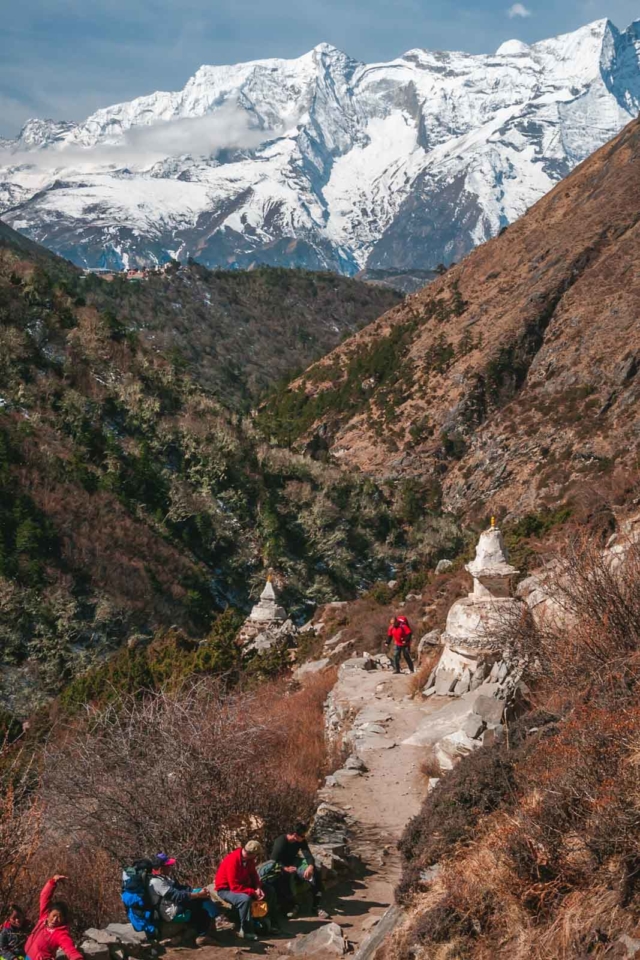
It can be dangerous trekking to Everest Base Camp from falling off the mountain to succumbing to altitude sickness. Some people have simply disappeared. Hiring a guide is a good option (and now the only option) for safety and it is very important to look for signals of altitude-related sickness.
But the Everest basecamp trek isn’t nearly as dangerous as climbing to the summit of Mt Everest. In 2019, 11 people died while trying to summit Mount Everest.
The village of Lukla is located at a high elevation so you will feel the effects of the thin air as soon as you land. The elevation of Lukla, Nepal is 2869 meters (9,350 feet). We were short of breath and already feeling fatigued upon landing. So instead of immediately starting our trek, we had a hot breakfast at one of the many restaurants in Lukla.
Travel Insurance for Everest Trek
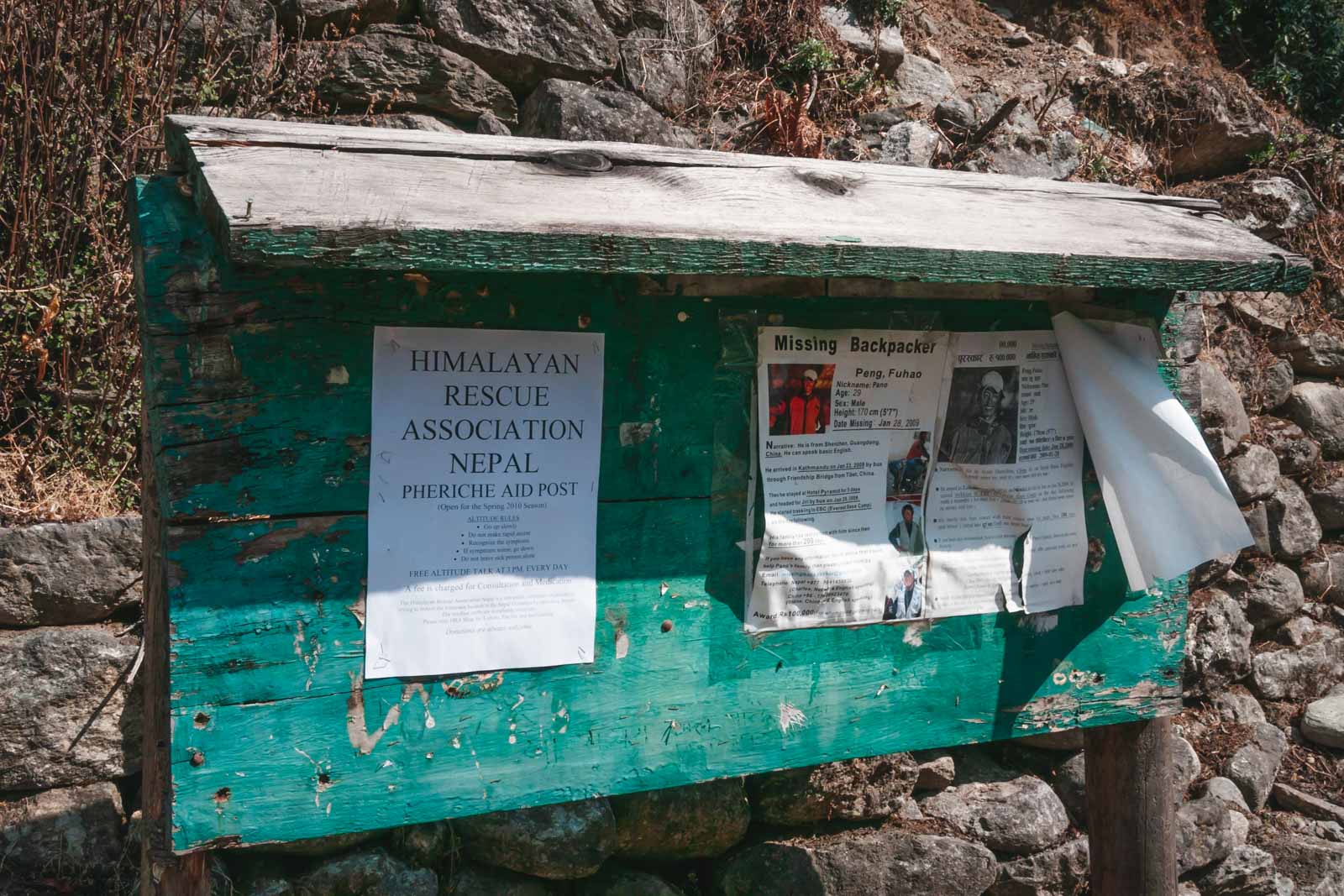
We always travel with travel insurance on our travels, but hiking to Everest Base Camp will not be covered by regular insurance providers. It is highly recommended to get supplemental comprehensive travel insurance that offers trip cancellation insurance, and medical evacuation insurance.
Medjet is a good option for medical evacuation insurance and is a good addition to your regular travel insurance. There is a very real possibility of altitude sickness and we knew of two people that needed helicopter rescues during our trek.
World Nomads offers specific Everest Base Camp Insurance. You can check them out to get a quote. I would suggest a combination of World Nomads travel insurance and Medjet medical evacuation insurance. Regardless of what travel insurance you choose, be sure to call them directly to ask for specific advice about trekking to Everest Base Camp.
For a trip like Everest Base Camp, you will want to make sure to have trip interruption and trip cancellation insurance as well as lost luggage. This is a trip of a lifetime, so make sure you have a backup plan.
Can you Trek Independently to Everest Base Camp?
As of April 1, 2023, Nepal has banned solo trekking. Foreigners must hire a guide for treks in high-altitude trekking regions of national parks. According to the Kathmandu Post in March, “ solo or independent trekkers have to mandatorily hire a guide or a porter before setting off to Nepal’s mountains.” However, after an updated article in the Kathmandu Post, it seems that the Everest Region is an exception. Before booking, we would check with local companies and authorities as rules are constantly changing.
Regardless, we loved hiring a local guide to make oure experience richer, to support the local economy and to feel safer hi
- Our all-inclusive Everest Base Camp Trek through the Simrik Real Nepal included return flights from Lukla, food, lodging, guiding, and all permits and paperwork.
- We didn’t have to search for accommodation at the end of each day of trekking
- We had English-speaking guides and a porter.
- We had our own room, but you can also share rooms on the EBC Trek
- We never worried about the cost of meals. They were all prepaid.
- And our guide (Dipendra) and porter were part of the package for the trip.
Costs for Everest Base Camp Trek
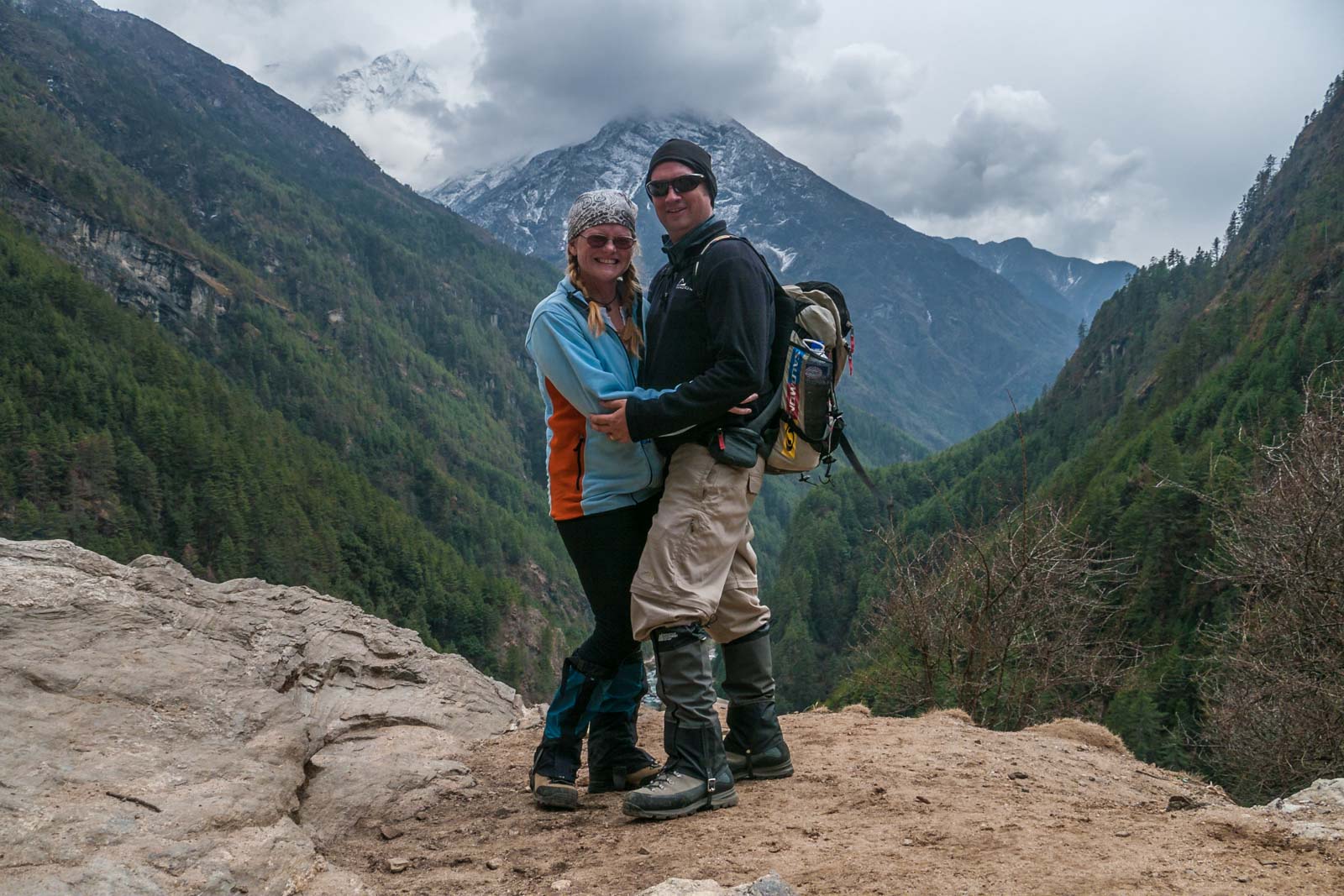
Prices can vary greatly for trekking to Everest Base Camp. You can contact Simrik Real Nepal for up to date prices.
- Booking with an international agency can cost from $1800 – $5000 USD
- Booking with a local agency and be anywhere from $1400 – $2500
W hen is the Best time to Trek to Base Camp?
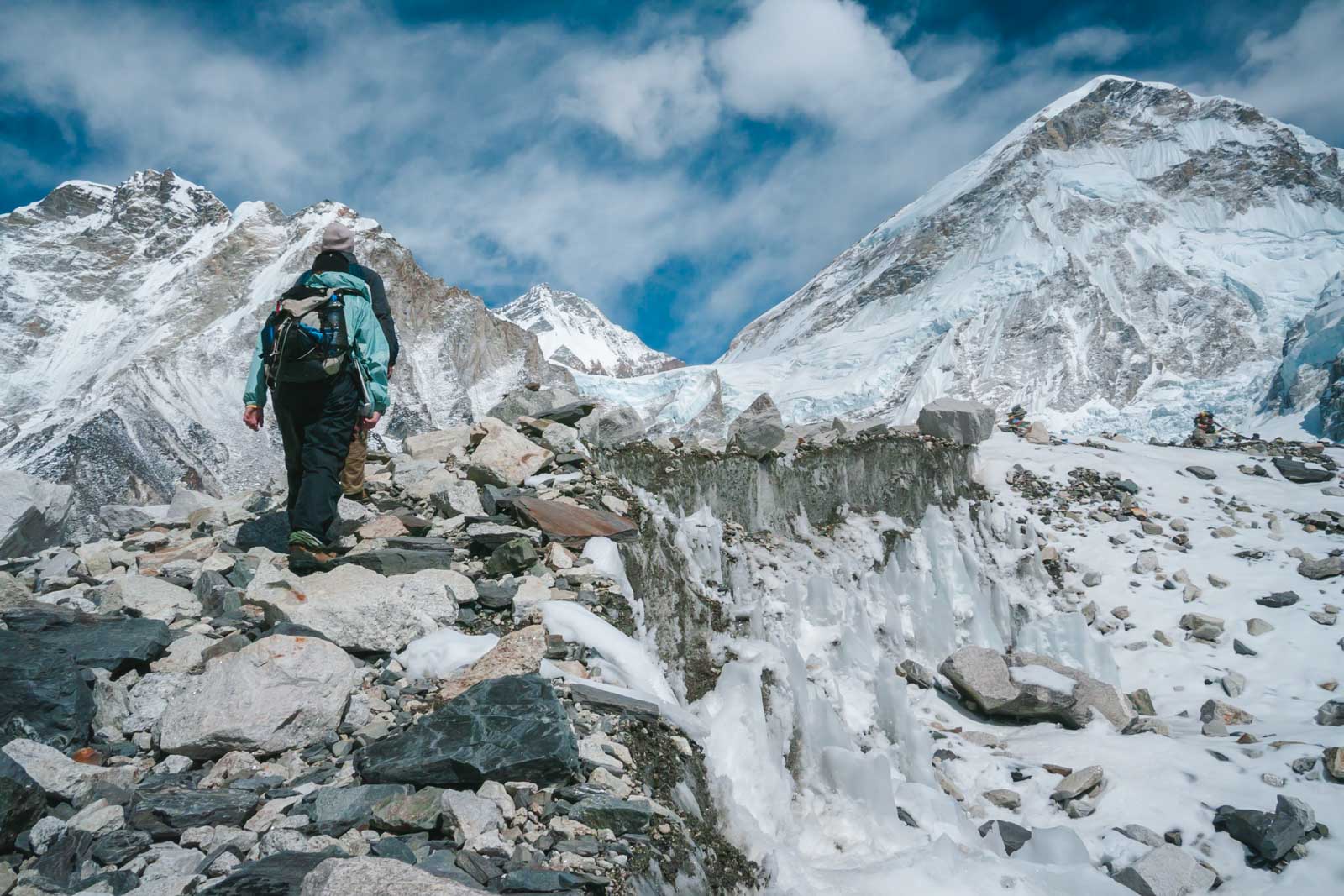
The high season for treks is April to May and October to November. We climbed in early March and felt that it was the perfect time of the year. The weather was beautiful, the skies were clear and the official climbing season hadn’t picked up yet. So we had a lot of the mountain to ourselves. We had heard stories of how busy the trail is, but at this time of year, it was quite deserted.
But a week and a half after our trek started as we made our way back to Lukla, it was already busier. We saw a lot of parties climbing up and the trail was getting congested. I can only imagine how packed the trails are during the high season.
What to Pack For Your Everest Base Camp Trek
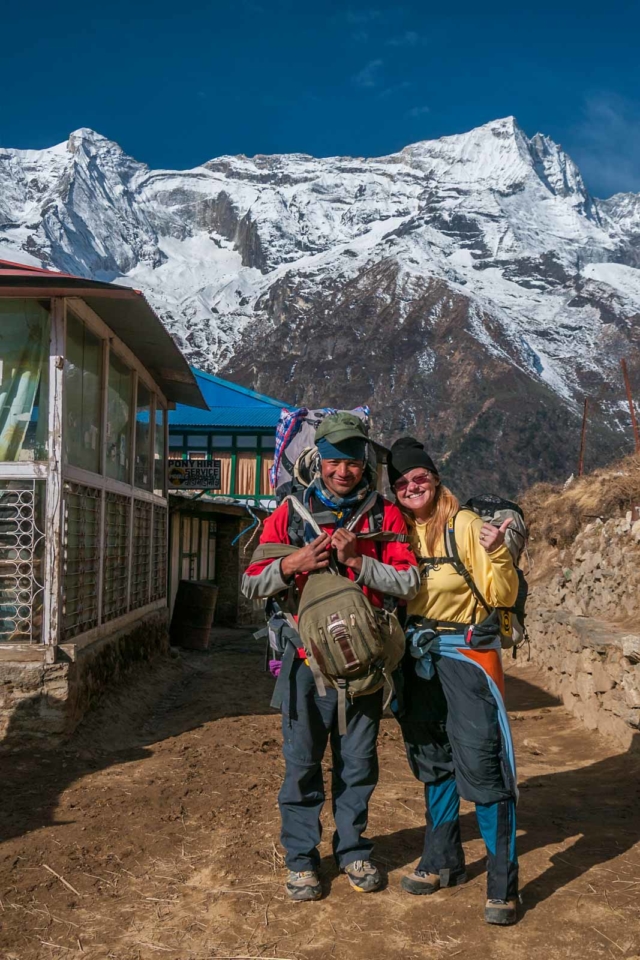
Layering is extremely important when trekking to Everest Base Camp. This is a quick guide for clothing but we wrote a complete packing guide for base camp here .
Make sure to have a day pack to carry the important items and layers that you will need for your day of trekking for the entire trek. Your porter will carry everything else.
- 2 quick drying long sleeved base layer shirts
- 2 trekking shirts short sleeve
- 2 Thermal Base Layer – 2 leggings/2shirts
- 2 liner socks
- 3 pairs of woolen blend trekking socks
- 2 pairs of trekking pants with zip-off bottoms
- 2 fleece sweaters – one lightweight, one heavier
- Outer windproof jacket and pants
- 2 water bottles to fill regularly
- Steripen or Lifestraw – this is great for purifying water
- Portable USB Charger
- Basic First Aid Kit – A first aid kit is important to have but your guide, they will have one as well.
- Warm sleeping bag. If you don’t have a sleeping bag rated to below zero, we recommend renting one from your guding company.
Treats and Medication
- Tang – I was glad we packed Tang for our water. It made it taste better, keeping us well-hydrated. We didn’t really want to drink just water, but the Tang (which we bought in Kathmandu) was actually delicious. Gatorade or another electrolyte-replenishing drink is a great idea.
- Diamox – (You can buy this in Kathmandu without a prescription) I highly recommend using Diamox tablets for altitude sickness as well. We met so many people suffering from headaches, dizziness, and fatigue and they weren’t taking anything. We’ve always used Diamox when climbing to altitude and it has worked beautifully for us.
- Chocolate – When we were feeling ill, we were happy to have chocolate to eat. It was the only thing that we could eat at times.
How to Get Fresh Water on An Everest Trek
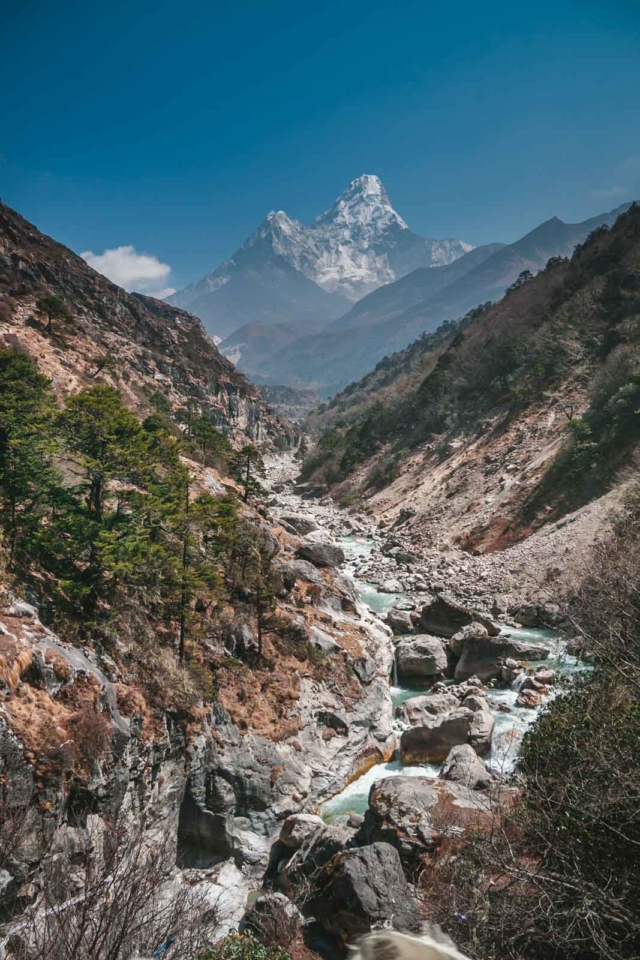
We recommend two refillable water bottles per person that can be refilled along the way. You can fill up anywhere for free along the Everest Base Camp route, but make sure you have a SteriPen or some other form of water purification with you. We love the SteriPen for purifying water, see our review here.
You can also use the LifeStraw or water purification tablets , but once we discovered the SteriPen , we never went back. See our complete Packing a Travel First Aid Kit here
Do You Need Climbing Experience for Everest Base Camp Trek?
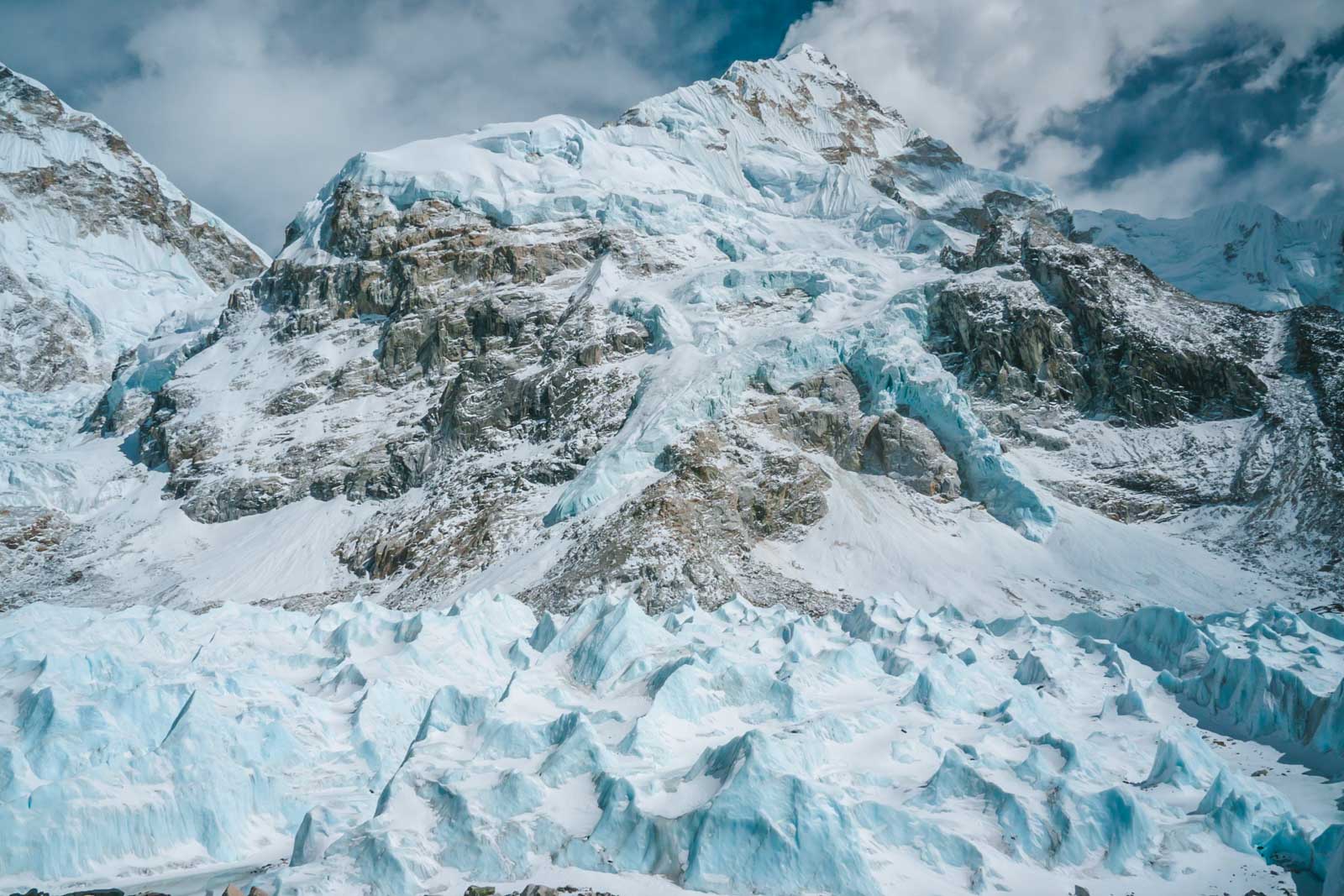
There is no need for any technical climbing experience to make it to Everest Base Camp. If you are relatively fit, it is very doable. But it is a full two weeks at a sustained altitude of over 4000 meters.
We didn’t train for our Everest Base Camp Trek but we had been to altitude before and had spent a lot of time backpacking leading up to the months prior. It’s good to know how your body reacts to altitude. We suggested doing a couple of treks above 3000 meters (9000 feet) to see how your body reacts.
Hot Tips for Trekking to EBC
- Keep your camera batteries close to your body when not in use. The cold and altitude really eat up battery life, so you will want to keep them warm for as long as you can.
- Bring USD, ATM Fees are high and you are limited to the amounts you can take out of the ATM, so have ISD to exchange instead.
- Pack handi wipes and Gold Bond Powder – it’s a lifesaver when you can’t get hot showers.
- See our Full list of Everest Base Camp Tips here.
How to Get to Everest Base Camp
There are daily flights to Kathmandu International Airport from international hubs around the world.
Where to Book Your Everest Base Camp Trek
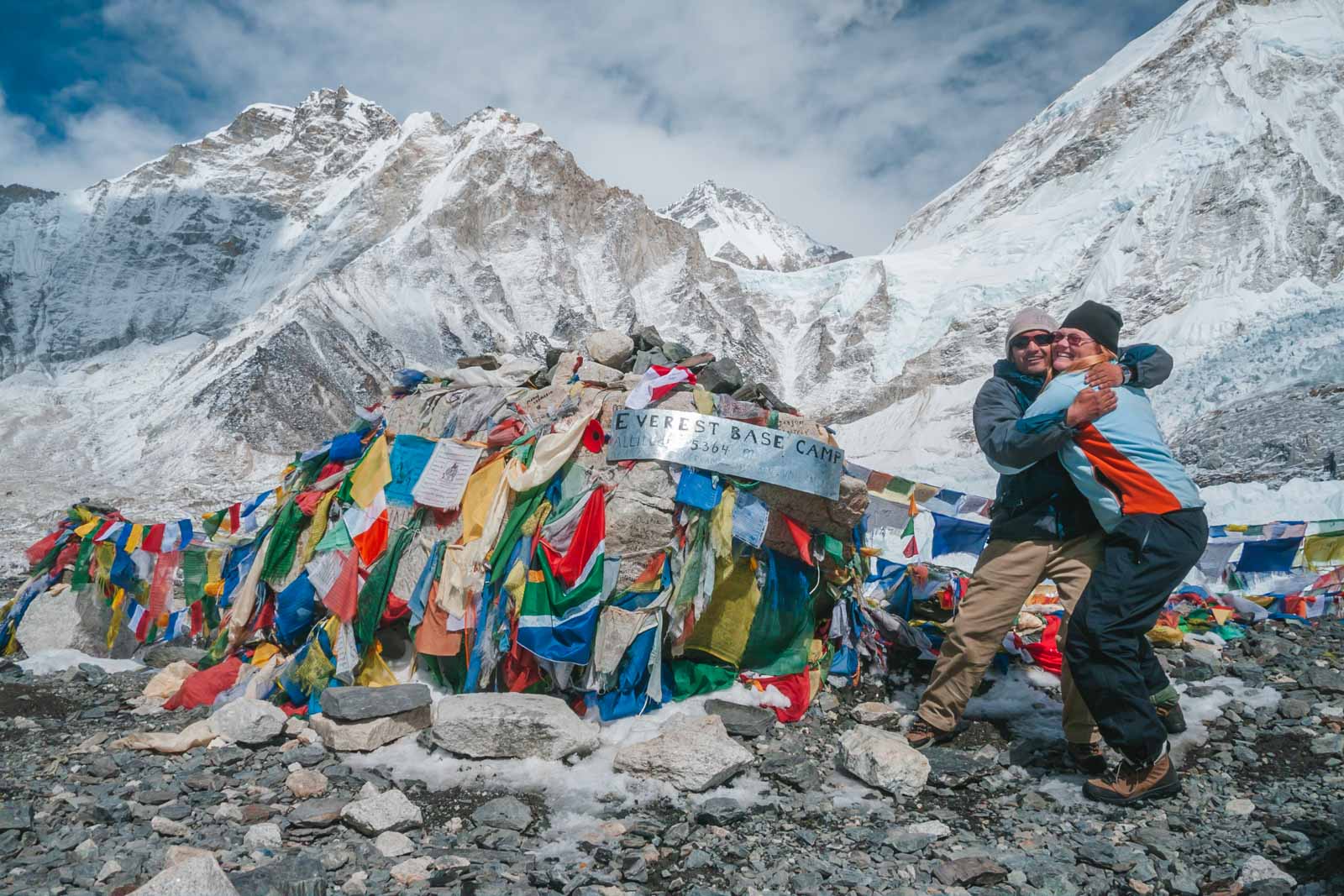
We booked our trek in Kathmandu with Local Guide Dipendra of Simrik Real Nepal. If you are looking for a local guide he is an excellent choice with nearly 20 years of experience in the mighty Himalayas.
Prices for the Everest base camp trek cost can vary depending on where you book. Group tours booked in North America will charge more. Ranging from $1500 – $5000 USD
You can save a lot of money by booking a local guide as you will cut out the middleman prices. Having a local guide let us know our money was going directly to the Nepal economy. Check with Simrik Real Nepal for current prices.
How Much to Tip Guides and Porters for an EBC Trek
Guides and porters in Nepal do not make a lot of money and rely on tipping. When we take tours of any kind, we (ourselves) tip 15% – 20% but that is a part of our culture in North America, we are quite large tippers and realize that others are not comfortable with that. We’ve done a lot of research and gone by what our tour companies have suggested on other tips, what we feel is a fair tip and what the average is across the internet.
For tipping in Nepal we have broken down the cost for a guide and porter.
Guide – Tipping – 10% – 15% of the total cost of the trip. We find this the easiest to figure out. If you paid $2000 for your trek, the lead guide should receive $200 – $300
Guide per day – Some suggest $10 – $15 per day per person for guides – For a 14 day trek that means you would tip your guide $140 – $210.
Porters per day – $5 – $10 per day per person for porters. – $70 – $140 for your porter.
We like to start at 15% of the total cost of our trips to give to the guides and then pay the porters a daily fee of $10.
If you can afford to trek to Everest Base Camp, you should be able to tip your guides and porters who have worked so hard accordingly.
Daily Life in the Everest Region of Nepal
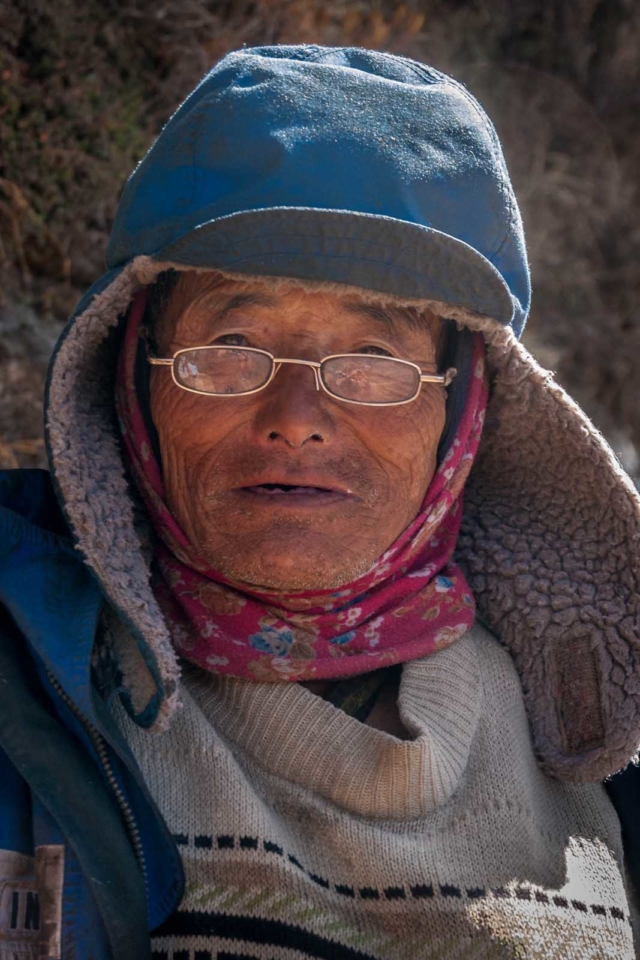
While trekking to Everest we passed through many picturesque villages. The people are friendly and life goes on as it would in any community in Nepal. People do well in the Khumbu Region and they respect the tours passing through because the tourists are what keep them going.
There is electricity from the water that they harness from the Imja Khola River and Dudh Kosi River; two rivers that run through the trek. They also have solar power for electricity as well. There are schools, fresh running water, televisions, a health clinic, and bars.
That is not to say that life is all roses. It is a remote region of Nepal and it is difficult to get any supplies in. Food and equipment need to be carried into villages on foot. Porters carry heavy loads on their backs and women and children also do the heavy lifting. Everything needs to be carted in by hand or by animals. Check out our tips for climbing to Base Camp
How Long Does it Take to Trek to Everest Base Camp?
The Everest base camp trek takes 12 – 14 days to climb including two acclimatization days. Treks can be done in 11 days and it is not uncommon for trips to take 15 days to allow for more acclimatization.
How Difficult is it to trek to Everest Base Camp?
Trekking to Everest Base Camp requires good fitness. You spend several days at a sustained altitude of more than 4000 meters (16,404 feet). Altitude sickness is a genuine possibility, it is important to take your time, stay hydrated, and listen to your body.
Can you trek to Everest Base Camp on your own?
As of April 1, 2023 the government states that all high altititude treks require a guide, but then after some backlash, they made an exception for the Everest region. However, we highly recommend hiring guides and porters . You can trek the region yourself carrying your own packs and gear, but you have a much better chance of making to base camp (and enjoying the experience) if you hire guides.
How Long is the Everest Base Camp Trek?
The trek is 63km (39 miles) each way . 126 km (78 miles) round trip from Lukla. Expect to hike anywhere between 7 to 17 km per day.
And that is a day-by-day breakdown of our experience on the Mount Everest Base Camp Trek. If you plan ahead and understand what to expect on the EBC Trek, you will be sure to have an amazing journey.
It’s an experience we’ll never forget and highly recommend it to everyone. The Himalayan Mountains are the most beautiful and spiritual place on earth and this trip will change your life.
Read More about travel to Nepal and things to do in Kathmandu before your trek
- Flight to Lukla
- Packing list for Everest Base Camp
- Remarkable Everest Base Camp Trek in Photos
- 30 Tips for Trekking to Everest Base Camp
- Nepal Travel Guide
- Top 6 Places to visit in Kathmandu, Nepal
- Where to Eat in Kathmandu – Eight Great Spots to Indulge After Your Trek
- The Ultimate Travel Songs Playlist to Inspire Wanderlust
Dal Bhat photograph courtesy of Wikimedia – I don’t know why we never took a photo of our Dal Bhat. We ate it nearly every day while trekking to Everest Base Camp. You’ll either learn to love it or despise it.
- Inca Trail – Machu Picchu Hiking Tips – How To Hike the Inca Trail
- Complete Guide to Climbing Mount Kilimanjaro – How Hard is It?
- Top 13 Best Treks in Nepal to Help you Choose The Right Trek for you
- Trolltunga Hike – Trekking to Norway’s Most Famous Landmark
- The Complete Guide to Climbing Mount Fuji
Travel Planning Resources
Looking to book your next trip? Why not use these resources that are tried and tested by yours truly.
Flights: Start planning your trip by finding the best flight deals on Skyscanner
Book your Hotel: Find the best prices on hotels with these two providers. If you are located in Europe use Booking.com and if you are anywhere else use TripAdvisor
Find Apartment Rentals: You will find the cheapest prices on apartment rentals with VRBO .
Travel Insurance: Don't leave home without it. Here is what we recommend:
- Allianz - Occasional Travelers.
- Medjet - Global air medical transport and travel security.
Need more help planning your trip? Make sure to check out our Resources Page where we highlight all the great companies that we trust when we are traveling.
You May Also Like
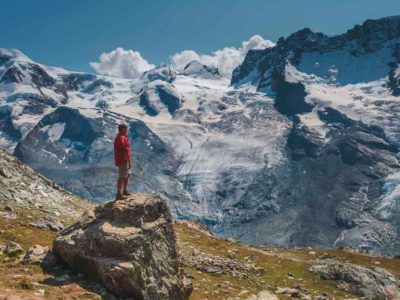
30 Beautiful and Best Hikes in the World
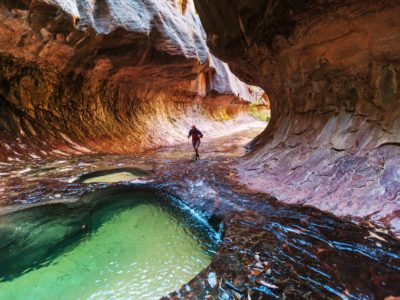
24 Best Hikes in the USA to Add to Your Bucket list
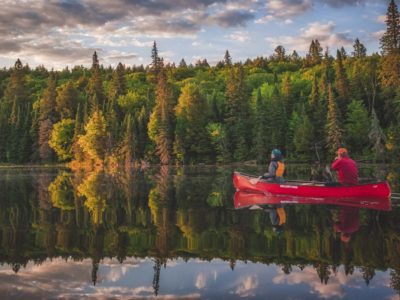
Weekend Warriors – 14 Awesome Hobbies to Turn You Into an Adventurer
About The Planet D
Dave Bouskill and Debra Corbeil are the owners and founders of The Planet D. After traveling to 115 countries, on all 7 continents over the past 13 years they have become one of the foremost experts in travel. Being recognized as top travel bloggers and influencers by the likes of Forbes Magazine , the Society of American Travel Writers and USA Today has allowed them to become leaders in their field.
Join thousands of others who get our monthly updates!
Leave a comment cancel reply.
Save my name, email, and website in this browser for the next time I comment.
53 thoughts on “Everest Base Camp Trek – Ultimate Guide For 2024”
Beautiful article! You have shared a thrilling journey with us till the end. It will definitely be useful for us trekkers. Thanks for the great pictures, videos, and useful tips!
This is a fantastic and unique post! After reading it, I learned a lot about Basecamp that I didn’t know before. Excellent article! That is true adventure, and conquering Mount Everest is without a doubt the goal of all hikers around the world. Keep up the excellent work. Thank you for providing this information.
Wow, the content has got all the details about the trek. Thank you so much for sharing your Journey experience of Everest Base Camp Nepal.
Hi There, Great Article! That’s the real adventure and especially climbing Mount Everest is the dream for all hikers across the globe without any doubt. Keep up the good work. Thanks for sharing.
Wow, the content has got all the details about the trek. Thank You so much for writing such an efficient article on Everest Base Camp Trek.
That’s the real adventure and especially climbing Mount Everest is the dream for all hikers across the globe without any doubt.
Thank you for taking the time and effort to produce such an awesome post with amazing pictures. Loved reading all your posts, really good insights here into Everest Base Camp ! Looking forward to read more.
Nice article on trekking best of luck for your new journeys
Dear Dave and Deb Namaste It is really beautiful article regards of Everest base camp trek in Nepal. Your article provides a lot details of the EBC trek. I’m sure your blog helping lot to organize other trekkers.
Excellent article. Everest Base camp is in my bucket list but I haven’t attempted because I’m prone to sickness quickly. Reading this article has triggered the interest even more. Thank you so much for explaining in detail about EBC trek. I hope One day I too can share my experience 🙂
Hey, I love trekking, I went last month with my friends in Nepal after reading your blog the memory are refreshed Thank you for sharing
Namaste, Dave and Dave, Thank you so much for sharing your Journey experience of Everest Base Camp Nepal. And also glad to read that why not support the local economy by hiring a guide and porter… I salute to your positive view. Visit Nepal anytime.
It is very interesting to read this Everest base camp trekking. I love trekking and i am excited very to do this base camp trekking once. Thanks for sharing.
This popped up in my inbox I love the way you break down your travel itinerary this way. I’m one of those people that love to know every detail of a place before travelling there myself. Another place to add to the list, thanks to you guys! Beautiful photographs.
Thank you for taking the time and effort to produce a terrific blog of your trek to EBC. I really appreciate being able to experience what it is going to be like before I actually arrive.
Everest is the highest mountain. It is at the Zenith. Most of the people just a dream of it.Very useful information. Thanks for sharing with us.
Excellent article !! Thanks for sharing such a great informative post it really helpful and amazing so keep it up and all the best………….
this was just amazing… keep sharing
The post was very informative. If you love adventure and treks you should definitely visit Nepal, it’s gonna be a life time experience. This post will really help people who are planning their next trek to Everest base camp. If you are planning your next trek to Nepal, North Nepal Trek can help you to make your trek much easier and will give you unique experience.
All of your photos are just awesome. Information is perfect.
Such an awesome post with amazing pictures. Thanks for sharing your experience with us.
This is really a very good blog post and thanks for sharing it with the community
It’s an informative post and I was thinking how you backpack for the weather? There are many things that somewhere can’t be cope at altitude like a sickness. I remember I scare when I attempt sky diving in Dubai. It’s was a wonderful experience but I have a fear of altitude places.
I have read about it but never tried. I am glad that at least i am reading such an informative article that clearly shows experience of treking over there. It might so much exciting and filled with happiness because seeing something like that would always be more of fun and achieving some of our own. Would love to try it once for sure!
Hi guys. Nice blog. Very informative. I just wonder, how did you prepare for the weather? How did you acclimatise so that you can cope with thr danger of altitude sickness? It is the ine thing that scares me to try to trek on high altitude places. To climb Kilimanjaro and to reach the EBC are in my bucket list. I’m hesitant because of my fear that I might die from cold temperature and altitude sickness.
Dress in layers, and drink plenty of water. You will want to bring DIamox with you and take it. You can get it in Kathmandu, or go to a travel clinic before leaving home. You won’t die from cold temperatures at Base Camp if you have a proper guide, and dress properly. The real dangers are if you are summitting Everest, that’s when you can get into problems, but Base Camp is very doable for anyone that is physically fit. If you don’t have the gear, you can buy winter coats, boots etc in Kathmandu. But we do recommend breaking in your boots beforehand, so you should buy those before you leave home and wear them a lot. Get warm, waterproof breathable boots with wool socks and bring several pairs. We have a guide to winter base layers to avoid the deep freeze here: https://theplanetd.com/layering-tips-for-cold-weather-travel/
Loved reading all your posts, some really good insights here into EBC! You mention putting your hair in braids, why is that? Is it because of the sweat? Is it windy so it gets knotted up? Just curious as I am doing this trek in a week and am open to all tips ?
Yes, hair can get really matted due to wind, dryness and lack of showering. The Braids kept it from matting up like dread locks. Have a great time!
Long hair can get very matted almost like dread locks. It’s becuase there aren’t a lot of chances to shower after Namche Baazar, the wind, sweat and dryness from altitude really takes its toll on both hair and skin and the braids, keep the hair from matting and breaking off.
Great read! Just curious. what time of year did you go to avoid the masses of tourists?
Thanks for sharing articles and videos it will be helpful to all people those wants to go Mount Everest.
This is just amazing and knowing each and every experience that we will have while travelling is another aspect that made me read this article fully. I am in Dubai now on a trip and would surely try to visit this place i could. I should consider the right time and other things roo. I must thank you for this wonderful piece.
Such a great journey you have shared from start to finish and your presentation is also impressive. I would love to follow these things when I will go for a camp tour.
Regards, Ronit
Your Video is superb, I feel your treking experience in this article. worth to read it.
Wow what an wonderful place is this. Want to trek this place in my life.
Great article, thanks, surprised at the early time of year you did the trek, but sounded ideal – any other good write-ups or links discussing the pros and cons of going in the spring vs fall? …weather, landscape, crowded w/ other trekkers, festivals, etc Thanks!
I am looking forward for this kind of base camp.
What an excellent post!! Thank you so much for an informative article and personal feel. This is very helpful and inspiring for my upcoming trek to Everest Base Camp.
There is so great view in pictures.it’s useful and helpful for the trekkers .i like these types of views .and tourist are also love these types of views.
Anyways amazing photos and love the videos! really gives you a feeling how it is there and must be just thrilling. Looking forward to read more about your travels.
Nice Articles and sharing a good details of Everest base camp and amazing photos. I will try to go this year Nepal and go to Everest Base Camp.
Great post. I am doing the Everest Base Camp trek in October. I completed the Annapurna Circuit in 2012 and loved it. Nepal is a such a lovely place and the people are amazing. Thanks for sharing!
Wow congratulations on your trip and everything looks really cool. I would love to do the same! Did you train a lot before you went there? Did you prepare physically? I don’t know how fit I have to be to be able to take on such a travel. Anyways amazing photos and love the videos! really gives you a feeling how it is there and must be just thrilling. Looking forward to read more about your travels.
Hi Marus, we didnt’ train a lot before. We were traveling a lot though. Before heading to Nepal we spent 4 months traveling Sri Lanka and India. We did a yoga retreat and a lot of hiking and walking, but we didn’t do any proper training. We were in relatively good shape. It’s mostly just a long uphill hike. The difficulty is being at altitude for a sustained amount of time. It affects everyone differently. Some people can be in tip top shape, but not do well at altitude and vice versa. So, it’s best to take it slow and steady, drink plenty of fluids and pay attention to how you are feeling.
All your photos are simple awesome and your posts are speaking a lot of useful information. Thank you for sharing this article.
Thanks for your beautiful video. I fell a little up lifted seeing this. I believe one of the prayer flags is for a lady I knew. Inspiring. I wish I would have done adventurous things like this when I was young. Young people don’t put off adventure.
I’m glad I read this. This is something I have always wanted to do but have been a little nervous to think about doing it when the climbing season is in full swing. The time of year you went and the company you chose make a lot of sense! Thanks for sharing.
The views are amazing!! I love adventure, but I would definitely need to build up my stamina to do the Everest Base Camp trek. It looks like it was an awesome experience for you!
Wow, what a beautiful experience. Your photos are amazing!
-Siggi The Voyaging Viking
Amazing! Can’t wait to check this off my list!
Thanks for writing this.
Thank you for sharing these helpful tips. Your post has given me some great ideas. Thanks again for the valuable information!
- Strava Updates
- Makings of Greatness
- English (US)
- Español de América
- Português do Brasil
Get Started
Everest Base Camp - 28.0023° N, 86.8529° E
The World's Greatest Hike: The Everest Base Camp Trek
, by Charlie Boscoe

The trek to Everest Base Camp (EBC) is the best hike on Earth and undoubtedly the most famous. There are quieter hikes out there and treks that could claim to be more adventurous, but no trip can rival the EBC route for scenery. Everest itself (which, ironically, is hidden for much of the trip) is the star attraction, but the views of Ama Dablam (often referred to as "The most beautiful mountain in the world"), Lhotse, Nuptse, and Kangtega would all be worth the trip on their own. The Khumbu region is home to the highest and most spectacular peaks on Earth, and the EBC trek leads you right into the heart of them.
The best times to make the trip are spring and autumn because winter is cold and snowy, and the summer is the monsoon. Spring is generally considered to be a little warmer, but the weather can be less stable than in the cold and dry autumn. Both options are popular, and going in spring does have the advantage that you'll arrive at Everest Base Camp in the middle of climbing season and will be able to watch teams as they attempt to summit the world's highest mountain.
RELATED: The 25 Best Long Distance Hikes in the World
Before even reaching the mountains, the EBC trek provides some rich cultural interest because it starts in the Nepali capital, Kathmandu. This ancient city is one of the oldest continuously inhabited places in the world and one of the most interesting. Durbar Square, Pashupatinath Temple, Boudhanath Stupa, and Swayambhunath Monkey Temple are all fascinating, but the real joy of Kathmandu can be found in just strolling around and taking in the sights, sounds and smells. It is remarkable how Kathmandu can, in some places, feel like an assault on the senses, only to transform into a serene oasis when you turn a corner into a quieter street. Having a couple of days to explore Kathmandu is highly recommended and only adds to the overall EBC experience.

When it comes time to journey into the mountains, a flight into Lukla, the world's most dangerous airport, awaits. The flight is short, and the runway at Lukla is VERY short! At just 527 metres in length, only specially trained pilots are licensed to land on the runway, and when you experience arriving there for yourself, you'll understand why. The views from the flight are lovely, but there is an inescapable feeling of relief when you touch down safely and can begin to enjoy the mountains without the fear of the impending landing!
DID YOU READ? How to Acclimatise at Altitude: 5 Tips
From Lukla, there follows a couple of peaceful days strolling along a valley bottom alongside the Dhudh Khosi river. There are often high mountain views, but much of the interest in these early days lies in the forests and villages you hike through. Towards the end of day two, the trail crosses the high and somewhat intimidating Hillary Bridge and then begins climbing up to Namche Bazaar, the Sherpa capital, where you really feel as if you've entered the high Himalayas. On the way up to Namche is a viewpoint from where you can get your first glimpse of Everest, and once in that famous mountain village, the jaw-dropping views just keep coming. Taking a rest day in Namche to aid with acclimatization is a good idea, and it also allows you to visit the famous Everest View Hotel, which provides exactly what you imagine it will! The entire process of acclimatizing is a crucial element of the EBC trek, and we've got an article dedicated to the topic here .

Above Namche, you enter high mountain terrain, and the dense forests that line the Khumbu's lower valleys slowly give way to scrubby bushes and rocks. There are some famous landmarks on the trail, including Tangboche Monastery and the medical clinic at Pheriche (where a daily talk on altitude sickness is delivered, and well worth attending), but the main attractions are above, not around you. The snow-covered giants towering all around defy description, but they will meet and exceed your expectations ahead of the trek. The weather in the Khumbu is generally better in the mornings, so getting up early to watch the sun creep onto those famous peaks is an effort well worth making. You may get lucky and also enjoy some sunsets, but the clouds tend to build in mid-afternoon, so a pre-dawn start is usually the best guarantee of good views. It goes dark around 6 pm in trekking season, so even if you get up at 6 am, you still have plenty of time for a good night's sleep!

The scenery around you becomes increasingly desolate as you climb higher towards EBC itself. The air gets dryer, the flora reduces, and those prominent peaks just keep getting closer - the upper reaches of the Khumbu is a tough place, and the difficulty of reaching EBC becomes increasingly apparent. For those who make it, the satisfaction of reaching such a legendary landmark is fabulous, and the strange familiarity of scenery that you've studied on maps and photographs is jarring. Many people find the experience of reaching EBC emotional, but climbing the small, rocky peak of Kala Patthar at dawn is perhaps even more dramatic. Everest is actually hidden from view at EBC, but from Kala Patthar, you get a perfect look at the mountain's southwest face and summit ridge. Some would argue that Everest is one of the less attractive mountains in the Khumbu, but there's no doubt that it has an aura and an attraction all of its own. It might look like another huge peak amongst many others, but something about it draws you in. Give in to the temptation to sit and stare at it from Kala Patthar as the sun slowly illuminates it and the darkness fades away.

Having visited EBC and climbed Kala Patthar, all that's left is to descend into thicker and warmer air all the way back to Lukla. After being cold, short of breath, and likely nursing a mild headache for a week, the feeling of the discomfort easing is wonderful. Enjoy every step before toasting your success in one of Kathmandu's many fine eateries.
So, if your appetite has been whetted, here's the famous route!
Related Tags
More stories.
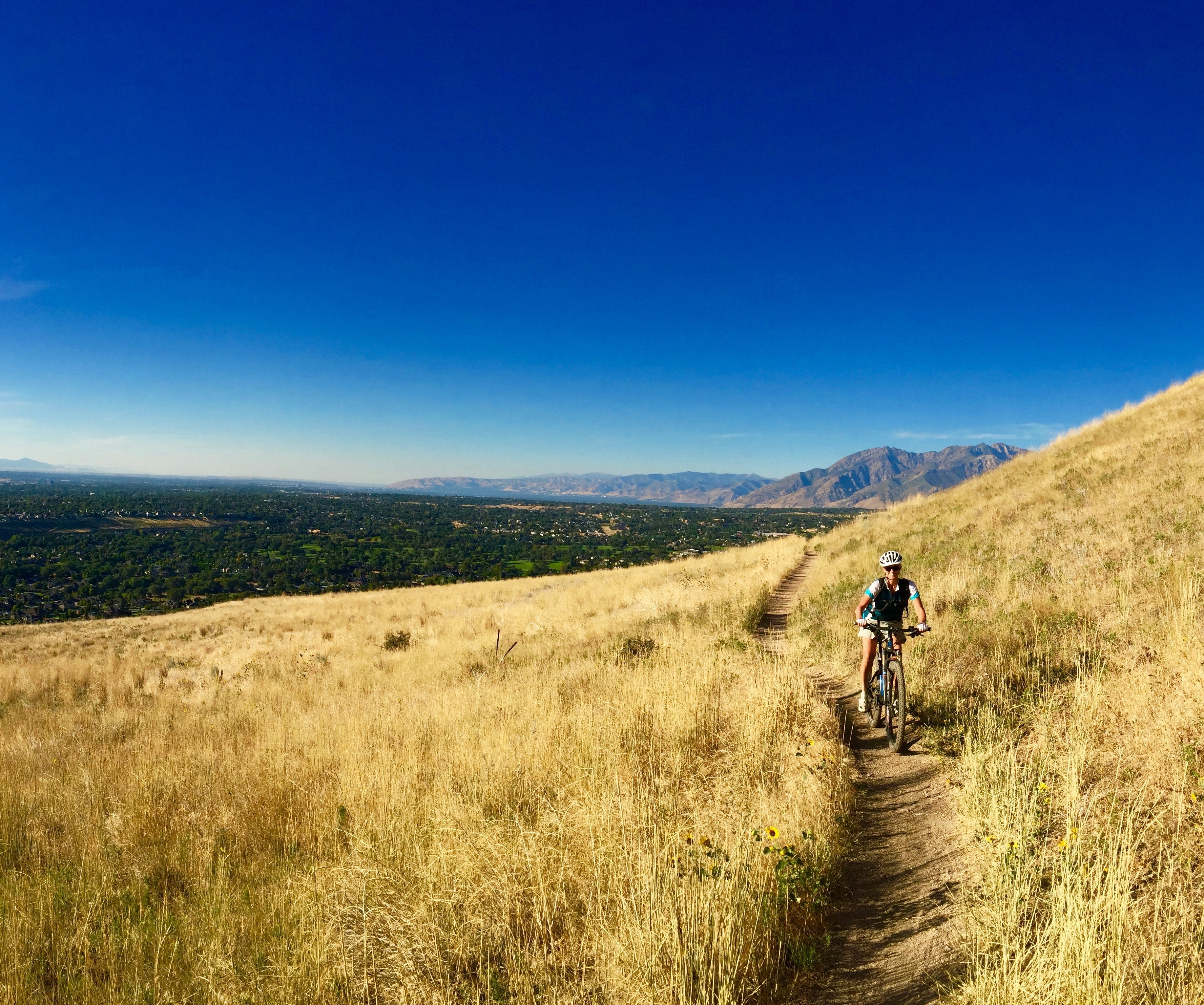
Mountain Biking
Passage of a Historic Congressional Bill Unblocks Completion of Utah's Bonneville Shoreline Trail
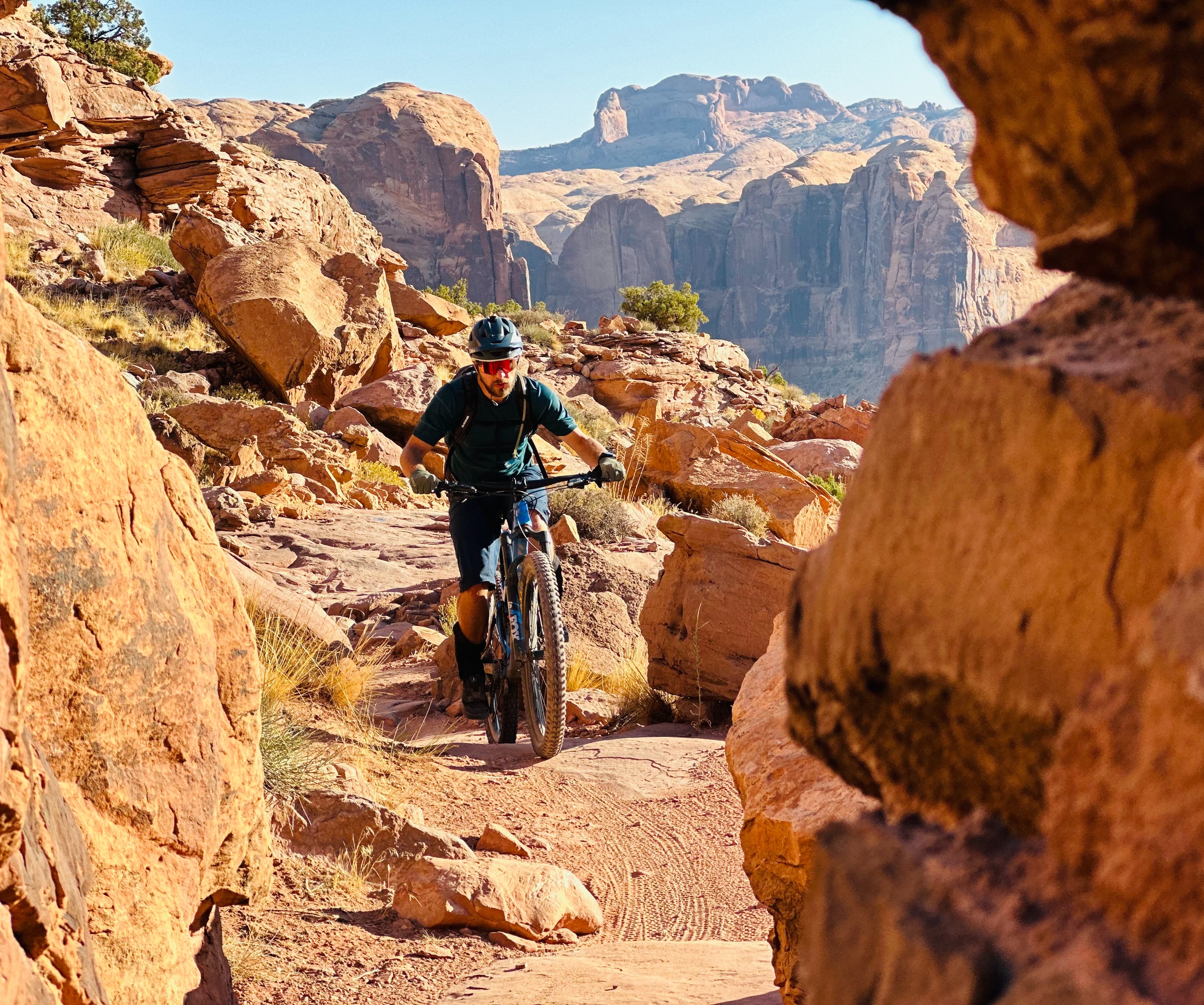
Tired of the Snow? Ride These 9 Desert MTB Destinations
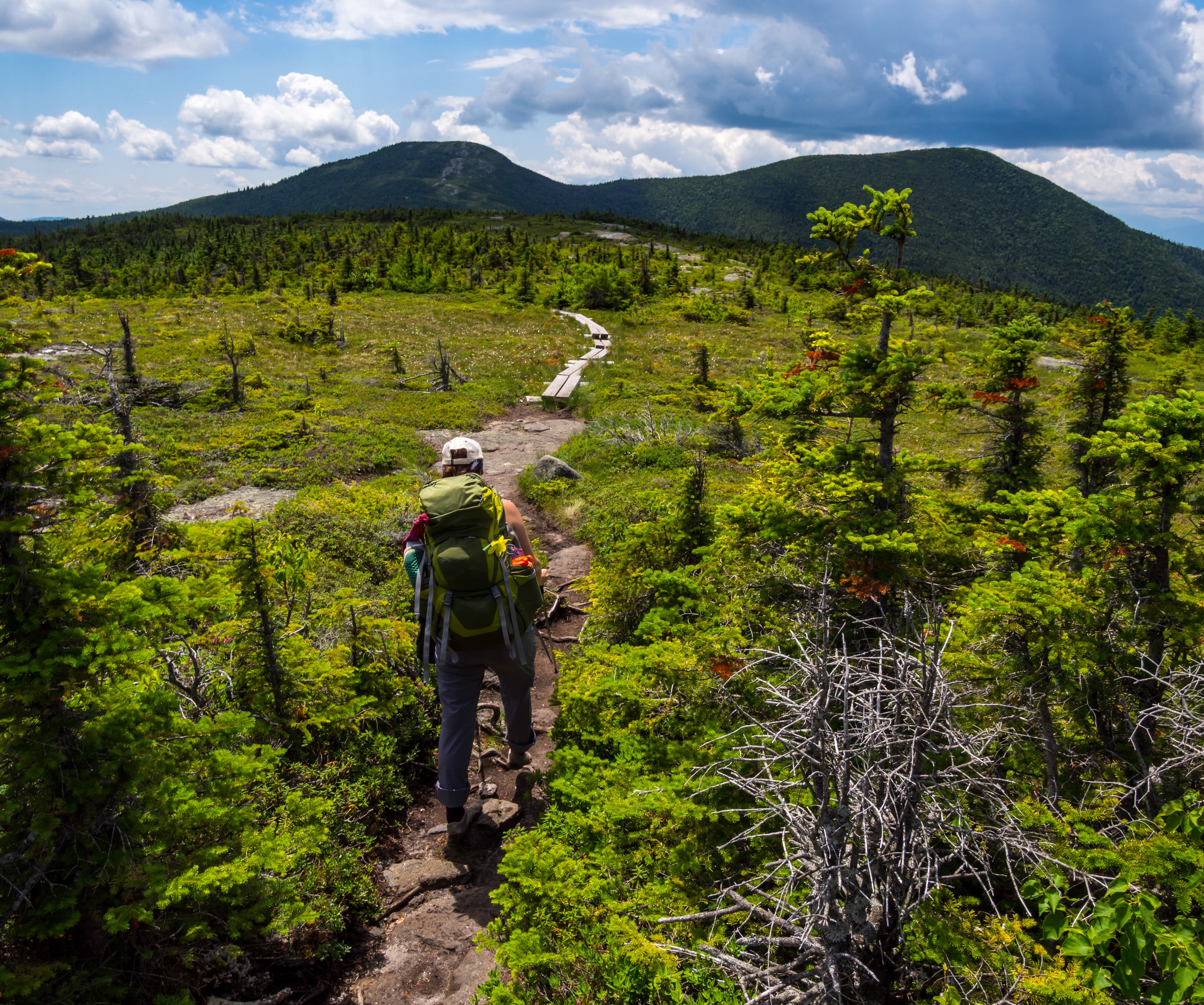
How to Prepare for Your First Thru-Hike

Himalaya Discovery Adventures
Trekking in Nepal in January
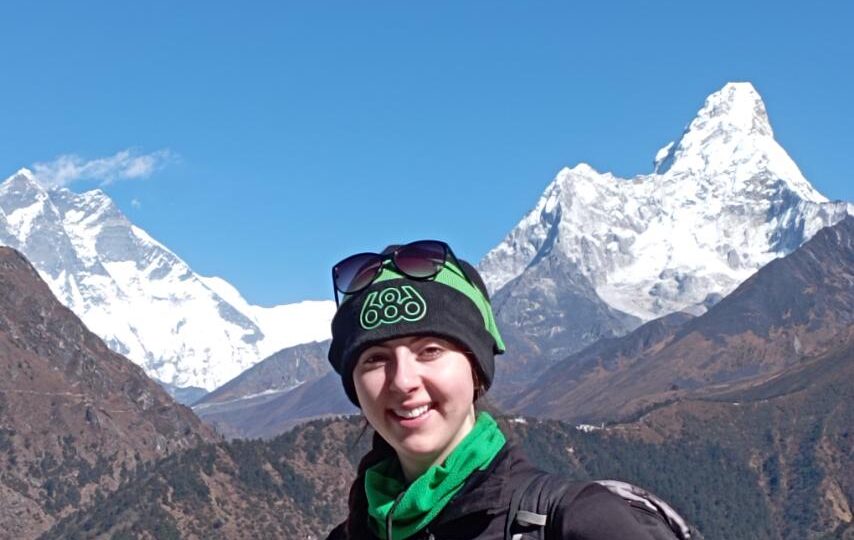
Nepal is world famous for its majestic mountains, awesome landscapes, and diverse culture and traditions. This geographical variation offers a number of trekking opportunities throughout the year. And so, trekking in Nepal in January is very much possible.
January is the month where the nature blankets in the world of snow and the whole surrounding turn into the serene peace of heaven. But since January is the local winter month in Nepal you should come prepared for the cold and snow in most of the high altitude trekking trails.
Trekking areas which are in lower altitude are open and are less affected by the cold weather of the winter season.
Trekking in winter has its own distinct advantages. It rarely rains in winter hence you will have clearer skies which ensures you the best views of the mountains.
Since it is an offseason, the trekking routes will be less crowded. You will have the route all to yourself which means you will have quality time to enjoy the views peacefully and take pictures of the mountains.
You will also have less problem with finding accommodation and food. The accommodations are also a lot affordable and with better service. Plus, you do not have to compete for the better room and quality food.
All this make January an ideal month for trekking in Nepal . Lower altitude treks such as Ghorepani Poon Hill Trek and Everest Panorama Treks are a hit. And higher altitude treks such as or the Annapurna Circuit are possible as well.
All you have to do is come prepared with the right clothing, equipment, and mental preparedness for the weather changes.
In order to help you have the best trekking experience in January in Nepal, we will discuss in detail about it below.
Climate and Weather in January
January is the coldest and the driest month of the year in Nepal. The Himalayan region of the country gets freezing cold during this time and the cold wind makes it even colder. It also sees a lot of snowfall during this time.
The average temperature during the daytime is around 8 degree Celsius and during the night time it is around 1 degree Celsius. However, the temperature at Annapurna Base Camp and Everest Base Camp can go below -20 degree Celsius.
Hence, for trekking in higher elevations in Nepal in January you need to be extra prepared. If you are a professional trekker or a climber you will have quite easy time trekking in the cold than the novice trekkers.
You are also advised to take a few extra days in case you face some situations such as flight cancellations etc due to the weather. You will also need to start your trek early because the days are shorter during winters.
Lower elevations treks are much more appropriate in January because it does not get very cold and it does not get snowfalls even in winters.
Even though it can be freezing cold in the mornings and night, the weather is surprisingly pleasant during the day with warm sunlight.
Highlights of Trekking in Nepal in January
- With clear weather almost guaranteed, you will get the best possible views of the mountain ranges.
- Enjoy trekking in the otherwise overcrowded popular trekking trails in peace and solitude.
- Easy access to tea houses and guest houses at cheaper rates.
- Better quality of food and services guaranteed.
Packing Lists for Trekking in January
Toiletries and Personal Hygiene
- Tissue / Toilet roll
- Antibacterial handwash
- Toothbrush and Toothpaste
- Quick drying towel
- Moisturizer
- Feminine Hygiene products
- Thermal Bottoms
- Undergarments
- Fleece or wool pants
- Waterproof shell pants
- Fleece jacket or pullover
- Fleece Windstopper Jacket
- Waterproof Shell Jacket
- Thermal tops
- Thick insulating Jacket
- Sun hat or scarf
- UV Sunglasses
- Warm beanies
Foot and Handwear
- Thin, lightweight inner socks
- Thick, warm hiking socks
- Heavyweight gloves or mittens
- Waterproof shell outer
- Gaiters for hiking in winter
- Hiking boots with spare laces
- Camp shoes (sneakers/sandals)
- Lightweight gloves
- Duffel or Rucksack Bag
Accessories
- Sleeping bag rated to zero degrees
- Water bottles
- Basic First Aid Kit
- Trekking Poles
Recommended Trekking in Nepal in January
Everest panorama trek.
Maximum Elevation: 3,870 meters
Everest Panorama Trek is the easiest and the safest trek in Nepal during January . As the maximum altitude you will ascend in this trek 3870 meters, the cold of January will not affect you adversely in the trek.
It is this five-seven day trek up to the elevation of 3,870 meters. It is a convenient way to get a taste of the Everest Region .
This trekking route lies in the Khumbu Everest region and the starting point of this trek is from Lukla.
You will take a flight from Kathmandu to Lukla and from Lukla, you will start your trek to Phakding, which takes about 3 hours. From here you will trek to Namche Bazaar, the biggest village in the Khumbu Region.
You will then trek for about 5 hours to reach Tengboche, home to the famous Tengboche Monastery. Tengboche offers breathtaking, panoramic views of the Everest, Lhotse, Ama Dablam and Thamserku.
Along the trek route, you will pass through some beautiful villages and cross some impressive suspension bridges. And thick the and spectacular rhododendron forests are bound to leave you in awe.
Ghorepani Poon Hill Trek
Maximum Elevation: 3,210 meters
The Ghorepani Poon Hill Trek is an extremely popular trek not only amongst foreigners but also the locals. And although Spring is the best time for this trek, January is also equally good. The snow-covered trails and the glistening sunrise views make this trek special in January.
Considered as the most popular destination for best short treks for all season, people usually complete this trek in four to five days. The starting point of this trek is Pokhara and from here you will trek to Tikhedhunga.
From Tikhedhunga you will trek to Ghorepani. This trail will take you across scenic rhododendron and oak forests. You will also get stunning views of some mountains such as Annapurna and Dhaulagiri.
But the main highlight of this trekking route is the view of the Machhapuchhre (Fishtail) which is present beside you throughout the trek.
Ghorepani is a village surrounded by spectacular scenery and is home to the traditionally rich Gurung community.
From Ghorepani, you will head towards Poon Hill at 1,500 feet. This place will provide you with breathtaking views of the snow-capped mountains. The mountains like Dhaulagiri, Annapurna, Fishtail and Singa Chuli etc are spectacular.
The views are especially more breathtaking because of the clear weather of January. You will also enjoy the peace and solitude in the trail which is normally packed with trekkers during the peak seasons.
Khopra Danda Trek
Maximum Elevation: 3,640 meters
Khopra Danda Trek is one of the lesser known trekking destinations as it is a newly opened trekking route in the Annapurna Region . It is usually not packed with trekkers even during the peak season so it is possible for you to have the route all to yourself in January.
So if you are looking for an off beaten trek with solitude, this trek is just for you. Khopra Danda is one of the best viewpoints to get magnificent and panoramic views of Mt. Dhaulagiri, Annapurna I, II, III and south, Hiu Chuli, Fishtail, Lamjung, and Nilgiri.
For this trek, you will follow the same trail as the Ghorepani Poonhill trek. And then descend to a valley before climbing back again to the Khopra Ridge at 3640 m.
Since this trekking route is fairly new, you will get to experience the untouched and raw natural beauty this place has to offer.
Kathmandu Valley Trek
Maximum Elevation: 2,175 meters
Since Kathmandu is at a lower elevation, this trek is the ideal trek in winters. This is a classic 3-day trek that takes you from Kathmandu to Nagarkot and finally to Dhulikhel.
It is a great alternative to those who cannot trek the higher altitudes in winter.
This trek will offer you beautiful views of the Himalayan ranges. And will give you an opportunity to observe the rich and diverse Nepalese culture closely.
You will trek through narrow mountain paths, dense forests, and small villages. The panoramic views of the pristine mountains in the background are absolute bliss.
There are also plenty of other day hikes for you to choose in Kathmandu. Trekking in Kathmandu is easy with a variety of guesthouses and resorts available to choose from.
Few Tips for Trekking in Nepal in January
- Since winters in higher altitudes are harsh, pack clothes and sleeping gears that will protect you from the extreme cold.
- Dress in layers. Even though it is freezing cold in the morning and night, it can get pretty warm during the day when the sun is up. Dressing in layers will help you take off some clothes when it gets hot during the day.
- Wear sturdy trekking boots to protect your feet from the snow.
- Be prepared with proper trekking gears and training prior to trekking in much higher altitudes.
- Always stay hydrated to prevent altitude sickness.
- Keep a few extra days in your itinerary to deal with any unexpected situations like canceled flights due to the weather.
- Always take a guide or porter-guide.
EBC Trek in January general FAQs.
What to expect while trekking in january.
Since winter promises clear weather with almost no rainfall, you can expect clear views of the Himalayan ranges. Trekking trails will be less crowded which will help you enjoy the views in peace.
You will have more choices in accommodation at a lesser price. Since the winters are harsher in higher altitudes, be careful of the ice and water on the trail.
Will the teahouses and restaurants on the trekking trail be open during winter?
Yes, most teahouses and restaurants in most of the trekking trails will be open even during winters. Especially the ones at the lower altitudes will be open throughout the year.
Trekking in January is enjoyable and safe when you are prepared with proper packing. The dry weather also facilitates trekking in the lower altitudes of Nepal.
The weather in Nepal during January is usually dry and predictable with clear skies. This guarantees you great views of the mountains. You will have clear skies with no rainfall and excellent weather.
Because of fewer people, you will have better choices for accommodation and food. You might even get some discounts from the locals during this time.
And if you are not fond of trekking in extreme cold, you can even enjoy some short treks in lower altitudes of Nepal. You can still get picturesque views of the mountains from the treks at lower altitudes.
If you are planning for trekking in Nepal in January, be well prepared for the cold and possible delays due to the weather. Other than that trekking in January is just as good as the peak seasons.
For further questions and information, please feel free to contact us .
Do you have any question about trip to Nepal?
- Solo Traveller
- Number of child (if you have child in your family/group) (Optional)
- When will you be traveling?* * Day 1 2 3 4 5 6 7 8 9 10 11 12 13 14 15 16 17 18 19 20 21 22 23 24 25 26 27 28 29 30 31 Month 1 2 3 4 5 6 7 8 9 10 11 12 Year 2025 2024 2023 2022 2021 2020 2019 2018 2017 2016 2015 2014 2013 2012 2011 2010 2009 2008 2007 2006 2005 2004 2003 2002 2001 2000 1999 1998 1997 1996 1995 1994 1993 1992 1991 1990 1989 1988 1987 1986 1985 1984 1983 1982 1981 1980 1979 1978 1977 1976 1975 1974 1973 1972 1971 1970 1969 1968 1967 1966 1965 1964 1963 1962 1961 1960 1959 1958 1957 1956 1955 1954 1953 1952 1951 1950 1949 1948 1947 1946 1945 1944 1943 1942 1941 1940 1939 1938 1937 1936 1935 1934 1933 1932 1931 1930 1929 1928 1927 1926 1925 1924 1923 1922 1921 1920
- How many days do you have?* *
- Give your trip a short title* *
- Private Trip
- Bellow 200$
- 200$ - 500$
- 500$ - 800$
- 800$ - 1200$
- 1200$- 2000$
- 2000$ and above
- Describe your trip* *
- Full Name* *
- Your Email* *
- Country* * Afghanistan Albania Algeria American Samoa Andorra Angola Anguilla Antarctica Antigua and Barbuda Argentina Armenia Aruba Australia Austria Azerbaijan Bahamas Bahrain Bangladesh Barbados Belarus Belgium Belize Benin Bermuda Bhutan Bolivia Bonaire, Sint Eustatius and Saba Bosnia and Herzegovina Botswana Bouvet Island Brazil British Indian Ocean Territory Brunei Darussalam Bulgaria Burkina Faso Burundi Cabo Verde Cambodia Cameroon Canada Cayman Islands Central African Republic Chad Chile China Christmas Island Cocos Islands Colombia Comoros Congo Congo, Democratic Republic of the Cook Islands Costa Rica Croatia Cuba Curaçao Cyprus Czechia Côte d'Ivoire Denmark Djibouti Dominica Dominican Republic Ecuador Egypt El Salvador Equatorial Guinea Eritrea Estonia Eswatini Ethiopia Falkland Islands Faroe Islands Fiji Finland France French Guiana French Polynesia French Southern Territories Gabon Gambia Georgia Germany Ghana Gibraltar Greece Greenland Grenada Guadeloupe Guam Guatemala Guernsey Guinea Guinea-Bissau Guyana Haiti Heard Island and McDonald Islands Holy See Honduras Hong Kong Hungary Iceland India Indonesia Iran Iraq Ireland Isle of Man Israel Italy Jamaica Japan Jersey Jordan Kazakhstan Kenya Kiribati Korea, Democratic People's Republic of Korea, Republic of Kuwait Kyrgyzstan Lao People's Democratic Republic Latvia Lebanon Lesotho Liberia Libya Liechtenstein Lithuania Luxembourg Macao Madagascar Malawi Malaysia Maldives Mali Malta Marshall Islands Martinique Mauritania Mauritius Mayotte Mexico Micronesia Moldova Monaco Mongolia Montenegro Montserrat Morocco Mozambique Myanmar Namibia Nauru Nepal Netherlands New Caledonia New Zealand Nicaragua Niger Nigeria Niue Norfolk Island North Macedonia Northern Mariana Islands Norway Oman Pakistan Palau Palestine, State of Panama Papua New Guinea Paraguay Peru Philippines Pitcairn Poland Portugal Puerto Rico Qatar Romania Russian Federation Rwanda Réunion Saint Barthélemy Saint Helena, Ascension and Tristan da Cunha Saint Kitts and Nevis Saint Lucia Saint Martin Saint Pierre and Miquelon Saint Vincent and the Grenadines Samoa San Marino Sao Tome and Principe Saudi Arabia Senegal Serbia Seychelles Sierra Leone Singapore Sint Maarten Slovakia Slovenia Solomon Islands Somalia South Africa South Georgia and the South Sandwich Islands South Sudan Spain Sri Lanka Sudan Suriname Svalbard and Jan Mayen Sweden Switzerland Syria Arab Republic Taiwan Tajikistan Tanzania, the United Republic of Thailand Timor-Leste Togo Tokelau Tonga Trinidad and Tobago Tunisia Turkmenistan Turks and Caicos Islands Tuvalu Türkiye US Minor Outlying Islands Uganda Ukraine United Arab Emirates United Kingdom United States Uruguay Uzbekistan Vanuatu Venezuela Viet Nam Virgin Islands, British Virgin Islands, U.S. Wallis and Futuna Western Sahara Yemen Zambia Zimbabwe Åland Islands Country
- Phone Number (Optional)
You May Also Like...
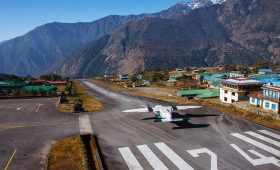
How to get to Lukla from Kathmandu
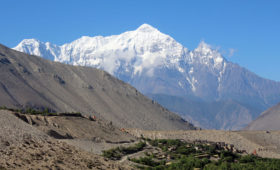
Trekking in Nepal in July
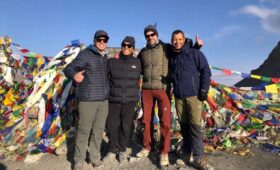
Trekking in Nepal Guide Compulsory
Leave a reply cancel reply.
Your email address will not be published. Required fields are marked *

“I was born and raised in Nepal, nearby Everest region. I am proud to be a native Sherpa, and I have been a Mountain guide over a decade now. Following my passion, I decided to start helping travelers with their travel plans! I think life is a journey, a trip where you collect experiences when you share with other people and with nature.”
Privacy Overview
Choose Trek
Customise Trek
Suggest me a trek
Rent a gear
Volunteer Program
Blogs & Articles
Discounts & Offers

Everest Base Camp Trek
Max Altitude
Trekking KM.
67,000 /Person
- +5% GST (Goods and Services Tax)
- Kathmandu to Kathmandu | lukla flight, food & stay included
- USD 1500 +5% GST for non Indians
Help & Support
- +91 7302321133
- 10:00 hrs to 18:00 hrs Monday - Saturday GMT +5:30 Sunday Closed
- [email protected]
- Cost & Cancellation Terms
- Risk & Respond
How To Reach
Trek essential, important links, fixed departure.
- Trail Type One way. The trek starts and ends at Lukla
- Rail Head Kathmandu is not connected to any Railways
- Airport Kathmandu (Tribhuvan International Airport)
- Base Camp Kathmandu
- Summer Treks (Mid Apr - Jun)
- Autumn Treks (Sep - Mid Nov)
- Snow October to november
- Services from Kathmandu to Kathmandu | Lukla flight, Food & stay included
- Meals Meals while on trek & at Hotel/Guesthouse (Veg & Eggs)
- Stay Hotel and teahouse
- Region - Kathmandu
- Duration - 13 Days
- Grade - Difficult
- Max Altitude - 18200 Ft.
- Approx Trekking Km - 108 Kms.
Why Everest Base Camp Is A Must-Do Trek
When it comes to trekking in the Himalayas, Mt. Everest is the most celebrated peak and not just in our country but all across the globe. For avid trekkers and mountaineers, getting up close to the highest mountain peak in the world is a once-in-a-lifetime experience. This classic trek takes place in the Bagmati Zone of Nepal and allows you to experience the immense beauty of the surroundings. Along your trek, you will get to witness 4 of the 6 highest mountain peaks in the world — Cho Oyu (8,201 m), Mt. Makalu (8,470 m), Mt. Lhotse (8,516 m), and Mt. Everest (8,848 m).
Everest Base Camp is a teahouse trek, which means you will stay at some of the highest villages in the world and get a close look at their cultures and traditions, and life in the remote corners of the Himalayas. Staying at the Sherpa villages you will get to learn a lot about the mountain lifestyle and how inextricably the people are connected to the mountains. There are many notable junctures throughout the trek and Kala Patthar is one such point. Standing at an altitude of 5,500 m it offers an astonishing view of Mt. Everest . EBC trek presents a wonderful opportunity to experience the grandeur of the Himalayas, the imposing challenge and thrill of the climb, and the charming culture of Nepal.
Trekking in Nepal is all about trekking amidst the biggest mountain ranges and on this trek, you will see mountains surrounding you. All along the way, you can feel the sense of legacy left behind by the greatest mountaineers. Crossing the route beyond Namche Bazaar, you will come across, Tenzing Norgay Stupa, a tribute to the great mountaineer, who was the first to scale Mt. Everest along with fellow mountaineer Edmund Hillary. Also, just near Dughla on Everest highway, there are memorials for distinguished mountaineers who dedicated their lives on the slopes.
Reaching Everest Base Camp means trekking through the traditional Sherpa villages, with warm and friendly villagers, hidden Gompas, picturesque mountain views, and exceptional natural beauty. Those who take part in such a trek will never forget the amazing experience.
About The Trek
Your journey will start at Kathmandu from where you will take a short flight to Lukla. The iconic trek starts at Lukla in the southern part and the trail weaves towards Namche Bazaar in the north. We will stay a day here, acclimatizing to the higher altitudes. It then diverges in the northeast direction towards Pheriche and Dingboche. Once we reach Dingboche, we will spend a day at Dingboche as a rest day. From Dingboche, the route continues to Lobuche. Everest Base Camp is a little further east from here and the Kala Patthar viewpoint can be seen towards the west.
There are other variations to the trek route as well, where the trek bifurcates towards Gyoko Ri early on at Namche Bazaar. The route then follows the left side to arrive at the Base Camp. Sometimes people also prefer trekking from Jiri village instead of Lukla, Jiri is a short bus ride away from Kathmandu. However, trekking from Jiri adds a couple of days to the trek as Jiri is considerably further away from Lukla. The EBC trek follows a gradual ascent up to the base camp, following which there is a steep descent. The entire journey lasts for 13 days and in between, we also have acclimatization days as well.
What Can You Expect At The Trek
It is a difficult grade trek. Trekking to the Everest Base Camp requires exceptionally high physical fitness and while the trek is not dangerous, you need to prepare well for it. A variety of factors add to the difficulty of the trek like the terrain, the duration of the trek, the distance covered every day, and the number of days spent at high altitude and a difficult exit in case of emergencies. While all trek is not especially tricky but it is surely an endurance test.
It is a high altitude trek and as such chances of AMS are quite high but with adequate hydration, proper rest, and a well-planned itinerary taking into consideration the acclimatization criteria will help counter such issues. Our trek leaders are mountaineering-certified individuals with a keen understanding of AMS and other high-altitude issues. They can detect the signs of AMS early on and adopt necessary measures for the prevention of the same. Our Trek Leaders are also all Wilderness First Aid Responders, who are diligent in handling emergencies.
The trek from Lukla to Everest Base Camp is 50 km and it takes 13 days to complete the trek starting from Kathmandu. To mitigate the risks of being at a higher altitude for such a long time, we have incorporated acclimatization and rest days in the itinerary. Mt. Everest can be spotted multiple times on the trek even in the initial part of the trial.
In cold conditions, batteries drain pretty quickly be it phones, cameras, or Kindles. Make sure to bring spare batteries with you. Some teahouses allow you to charge your phone and other electronics but they will charge you for it.
Be prepared for extreme weather conditions as the weather at high altitudes is unpredictable. Layer properly to regulate your body temperature and stay comfortable while trekking. When its sunny, the weather can get quite warm and you may even have to discard a couple of layers in the first few days of trekking, however, the temperature at night drops pretty quickly. Make sure to drink a lot of water to stay hydrated and avoid altitude sickness. Also, remember that sunburn happens much quicker at higher altitudes so always wear sunscreen and keep your sunglasses ready.
Accommodations at Everest Base Camp will be in teahouses in Sherpa villages or mountain lodges. Also, keep enough cash with you as there are no ATMs in Lukla. Also, if you want to do some last-minute shopping for trekking gear and equipment, Kathmandu is a good place to do so.
Who can participate
- Age; 15 years.
- Experience of any high altitude trek, at least 1 treks of 4,000m/13,100ft.
- The climber must be fit and have sufficient stamina to cover 5 km of distance in 30 minutes without a stress.
- The climber should be able to carry a 12-16 kg backpack.
Health Awareness
- Pulse rate at rest must be in between (60 to 90 beats per minute)
- Blood Pressure Reading must be in between (DIASTOLIC 75 – 85, SYSTOLIC 100 - 130 mm Hg)
- Respiratory rate at rest must be in between (12 to 20 breaths per minute)
- Should not have Liver and kidney issues
- Should not have Diabetes Mellitus, Bronchial Asthma, Epilepsy, Heart problems, Hypertension etc
- No pacemaker implant
- People with the Sinus issues please contact to trek coordinator before booking the trek
- If your BMI is not normal, Please contact our Trek coordinator before Trek booking.
- Junior trekkers (below 15 years) should have a company of parent/guardian.
- Trekkers between 15 to 18 years can come solo with the disclaimer form signed by parent/guardian.
- Medical & Disclaimer Form (Mandatory Documents) Click here
- Altitude: 1,400 m/ 4.600 ft
- Spend the day exploring Kathmandu
- A short briefing session in the evening
- Stay: in hotel (included in cost)
Welcome to trekkers’ paradise, Nepal. Nepal is characterized by beautiful Himalayan summits, rich natural biodiversity, and beautiful culture and history. Once you arrive at Kathmandu airport, you can take a taxi to the booked hotel in Kathmandu. There are loads of taxis available at the airport and you can easily find one to drop you off at the hotel. Once you check-in to the hotel, you can freshen up, and in the evening, you will receive a briefing session where you will learn about the trek and your schedule for the upcoming days. If you have any questions about the trek, then you can clear them at the time of the briefing session. Post the briefing session, you can explore Kathmandu and do some last-minute gear and equipment shopping if you want.
Note that, from April 2019 most flights have been diverted to Ramechhap airport due to construction and crowding at Kathmandu Airport. Ramechhap is a small airport in Manali and 4 hrs drive away from Kathmandu. In this case, your flight will be booked for the next day. So take an early night flight to Kathmandu and get ready to leave Kathmandu City by 1 o’clock so that you can take an early morning flight from Ramechhap airport.
- Altitude: Lukla - 2,850 m/ 9,350 ft; Phakding - 2,600 m/ 8,500 ft.
- Altitude Gain: 1200 m/ 3,900 ft.
- Early morning flight to Lukla (30 minutes).
- Trek to Phakding: 9 km | Duration: 4 to 5 hrs.
- Easy and gradual descent.
- Cheplung village lies en route from where you can see Mt. Khumbila.
- You can buy or refill your water bottles from teahouses on the way.
Note: Flights to Lukla are prone to delay due to weather, keep one or two buffer days in your plan.
Get ready for a beautiful flight from Kathmandu to Lukla. Its a short flight of about 35 minutes that will take you over a panoramic landscape. On these flights, the planes are quite small but the journey is quite scenic. Our representatives will meet you at Lukla airport and this is where your trek towards Everest Base Camp starts.
After arriving at Lukla, we will start our trek towards Phakding after some refreshments. The trail is 9 km long and passes through Nepali mountain villages, green mountains, suspension bridges, and forests to Phakding. It takes about 4 to 5 hrs to complete the trek. From Lukla, the trek begins with a gradual ascent, with a few ups and downs along the way. Along the route, you will witness amazing views of Kusum-Kanguru as you cross a suspension bridge on your way. After a short climb, you will arrive at Ghat Village and after another one and a half hours of gradual walking, you will arrive at Phkading. En route, you will also spot boulders that are carved with Buddhist Prayers. We will stay overnight in Phakding.
- Altitude: 3,450 m/ 11,300 ft
- Trek: 10 km | Duration: 7 hrs
- Altitude Gain: 850 m/ 2,800 ft
- Moderate level of climb and steep climb before Namche Bazaar.
- Namche Bazaar is the capital of the Khumbu region
- You will get the first views of Mt. Everest today
- You will spot Kongderei and Thamserku peak
- Monjo village is the mid-point of the trek.
- A swiss suspension bridge on Dudhkosi River. It is one of the major attractions.
- Dudhkosi River is considered as the lifeline of the Khumbu Region
- Today you will enter into the Sagarmatha National Park (a UNESCO World Heritage Site)
Post breakfast, we will start our trek towards Namche Bazaar. The route today is surrounded by green mountains and will take you through suspension bridges over the Dudh Koshi and Bhote Koshi rivers. Before entering the Sagarmatha National Park, you will have to obtain permits and then the trail follows a steep ascent before arriving at Namche Bazaar. Namche Bazaar is an important trading hub of the Khumbu region.
We will start our trek early in the morning from Phakding and soon you will cross a suspension bridge over the Dudh Koshi River, the walk from here is easy and pleasant with short uphill and downhill climbs. You will cross another suspension bridge over the Bhote-Koshi River. It is a busy area and you may notice a multitude of trekkers and porters here. After a 20 minute climb from this area, you will arrive at Monjo. Monjo is a pit stop for many trekkers and many people also camp here. At Monjo, you will see interesting watermills that are used to grind barley, a staple diet of the Sherpas. Monjo is situated right below the majestic Thermasarkhu peak (6,608 m) and quite close to this village is the entrance to the Sagarmatha National Park.
Treading along the Dudh Koshi River, you will arrive at the Sagarmatha National Park. At this point, your trekking permit will be checked and the officials will keep a record of all the trekkers going ahead. Sagarmatha is a UNESCO World Heritage Site that showcases stunning mountain views and rich biodiversity. Here, you may spot rare Himalayan species like snow leopard and the lesser panda. The presence of Sherpa settlements with their unique culture makes the trek even more interesting. A gradual walk from Sagarmatha National Park will lead you to Namche Bazaar. From Namche Bazaar, you will catch the first glimpses of Mt. Everest. Namche Bazaar is a historic trading center of the Khumbu area and you can stock up on essentials from this point. At night we will stay here at a guesthouse.
- Today is acclimatization day
- You can hike up to Sherpa Cultural Museum to get a view of Everest and Ama Dablam
- It’s worth exploring the town, a good place to buy trekking gear
- ATMs, internet cafes, shops, and restaurants are available at extra cost
- Stay in the guesthouse
Wake up to the beautiful views of the highest Himalayan peaks and enjoy a delicious breakfast. Today we will stay in Namche Bazaar allowing our bodies to acclimatize to high altitudes. You can spend the day exploring the surroundings and enjoy the culture and hospitality of Nepal. Namche Bazaar is a commercial hub so you can do any last-minute trek shopping from here. The market has a vibrant atmosphere and there are a couple of restaurants and coffee shops as well.
You can do a short hike to Sagarmatha National Park headquarters. From here, you can get a good view of Ama Dablam, Mt. Everest, and other Khumbu peaks. Sherpa Cultural Museum is close by and lies just above Namche Bazaar. The museum gives you a fair amount of details about the history of the Himalayas, the geographic and cultural aspects, mountaineering history, and information about the various flora and fauna in the region. You will see many pictures of Tenzing Norgay and Edmund Hillary from their climb and maps detailing their trails as well. In the evening, take acclimatization walks around the market, preparing your body for higher altitudes. Soak in the Nepalese Buddhist culture, food, and traditions. Namche Bazaar gained popularity during the time when Tibetan salt was traded for grains from Nepal\\s lowlands. Nowadays, you can see a roaring trade of rugs, clothing, dried meat, and salt in the village center. There are many shops that also offer locally made handicraft items, you can buy them as souvenirs or gifts for your friends and families. You will stay the night at a guesthouse in Namche Bazaar.
- Altitude: 3,850 m/ 12,650 ft.
- Altitude Gain: 400 m/ 1,350 ft.
- Trek Distance: 8 km | Duration: 5 to 6 hrs.
- Mixed ascent till Phunki Tenga.
- Steep ascent after Phunki Tenga to Tengboche.
- Tengboche has the biggest monastery in the area.
- You can attend a prayer ceremony held by the monks to invoke protection on your expedition.
- Cross another high bridge at the village of Phunki Tenga.
Start your day with a delicious breakfast and get ready for your trek to Tengboche from Namche Bazaar. It’s an 8 km long trail and is a fairly easy trek accompanied by the views of the majestic Himalayas. You will also spot Himalayan Wildlife on the way as well.
Tengboche is a small alpine valley that is situated at an altitude of 3860 m and the trek starts with an easy walk. The trek from Namche Bazaar to Tengboche is extremely beautiful and along your trek, you will get a bird’s eye view of Dudh Koshi River down below and the epic mountain views as Thamserku (6,608 m), Kantega (6,782 m), Ama Dablam (6,812 m), Lhotse (8,516 m) and Everest (8,849 m) comes into view.
A 20-minute walk from Namche Bazaar will take you to the top of Namche Bazaar. From here the trek descends to Khumjung, a Sherpa village and then climbs up the sides of the mountains through some stairs and then diverges from the Everest Highway at Sanasa. You will be able to catch glimpses of Lhotse, Nuptse, and Mt. Everest from here. This is probably the best view of Mt. Everest you will get until you reach Gorakshep when climbing to Kala Patthar. Two hours of pleasant walking will bring you to Sanasa. Up to Sanasa, it is a walk-through forest covers of Oak and Rhododendrons. It is a great location for bird watching and you may spot the Danphe Pheasant, the national bird of Nepal. Musk-deer and Himalayan Tahr, a Himalayan goat that looks like an antelope are commonly spotted in these areas. You will also spot the Tengboche monastery from here which you will reach in the later part of your trek.
Next, following a gradual descent, you will reach the Imajtse River at Phungitenga at an altitude of 3,250 meters. Phunki Tenga is a small Himalayan settlement with teahouses and army posts. The climb down can be a little tougher as the terrain is rocky and uneven. You will reach a suspension bridge over the river and after you make the crossing, you will need to get permits at a checkpoint to proceed further in your trek. From here it\\\\\\\\s a strenuous climb of about an hour that will take you to a Buddhist monastery just before Tengboche and finally to Tengboche village. This is the last part of today’s trek and you can expect the trail to be rocky with a couple of switchbacks. Don’t push yourself too hard, take it slow and steady as you make your trek uphill.
Tengboche Monastery, locally known as Dawa Choling Gompa is the largest monastery in the Khumbu region. It overlooks the beautiful region and the mountain landscapes around. There are daily prayers that occur around 7:00 am and once around 3:30 pm. You can take part in the prayers if you truly want a cultural experience. It is one of the important cultural aspects of the EBC Trek. Enjoy the serenity at this revered place of worship and at night your stay will be in the guesthouses at Tengboche.
- Altitude: 4,350 m/ 14,250 ft
- Altitude Gain: 500 m/ 1,600 ft
- Trek Distance: 9 km | Duration: 6-7 hrs
- Gradual descend and little bit of ascent after Lobuche River to Dingboche
- The trail passes through lush forests of birch, conifer, and Rhododendron trees
- The route offers amazing views of Ama Dablam standing over you
- The trail crosses the Imja River to reach Pangboche
- Continue along the Imja Valley and Lobuche River before ascending to Dingboche
Today, we will begin our trek towards Dingboche. From Tengboche, cross bridges and rivers accompanied by beautiful mountain views all the way to Dingboche. Stone steps will lead you through forests of Rhododendrons, conifers, and birches, and at the bottom of the forest lies the Deboche village. From here, the trail rises up and enters into the alpine meadows and Dingboche. Dingboche is the only place in the entire Khumbu region where barley is grown. The views of the Himalayas are amazing from Dingboche. Start your trek from Tengboche and walk towards Pangboche Village, you will get to see some beautiful views of Mt. Ama Dablam and from Pangboche we will trek towards Pheriche and to Imja Valley. The beautiful Lobuche River passes through Imja Valley and from here a steep hike will take you to Dingboche. The trek takes about 6 to 7 hrs and for the most part, the difficulty is moderate.
At the beginning of the trail, you will first descend into a forest trail passing the small settlement of Deboche. As you trek from Tengboche to Dingboche, the scenery changes as you gain altitude, greenery slowly giving way to barren landscapes, and the trails gradually becoming more rugged and it will also start getting cold and windy. In the initial part of the trek, you will pass by a wall with stone inscriptions and a small stream will keep you company along the trail. You will have to cross the stream to the left-hand side of the valley. The majestic Ama Dablam dominates the skyline ahead of you. About two hours into the trek, you will arrive at Pangboche, a mountain village, where you get beautiful views of Mt. Everest. From Pangboche, you will hike upwards towards the valley and throughout the trek, you will slowly gain elevation. Although the trek is mostly uphill, the slope is relatively easy without extremely steep inclines. Ama Dablam continues to stay in view, however, you will only get to see a tiny silver of the top of Mt. Everest. Lhotse and Nuptse become quite prominent now.
Soon you will arrive at the village of Shomare, your last village before Dingboche. Ama Dablam still remains in view but now you will get to see a different angle of the mountain from what you have seen before. The trail continues winding to the valley side and you will cross another river before entering Dingboche village. Dingboche is a lovely Himalayan hamlet and you will see agricultural fields protected by stone walls. Once at the village, we will check into a guesthouse and we will stay the night in the guesthouse.
- Rest Day helps you acclimatize well to high altitudes
- A small hike today will show you the world’s six tallest peaks including Lhotse (8,516 m), Makalu (8,463 m), and Cho Oyu (8,188 m)
- From another location, you can see the Imja Khola Valley and Dingboche Valley
Today is a rest day at Dingboche, which will help us acclimatize to the high altitude. As we exert a good deal of energy on the trek, our body needs to get accustomed to less oxygen at higher elevations. So instead of taking a rest day, if continue to gain elevation it can result in altitude sicknesses like dizziness, nausea, and headache or potentially even more dangerous conditions like cerebral or pulmonary edema. To prevent these issues, we start our acclimatization process at the 11,500 ft mark. Since Namche Bazaar is quite near that elevation, we start our acclimatization process from Namche Bazaar itself.
For acclimatization, you can walk around the village. Dingboche village has many farms and crop fields sparse across the village, native crops include barley, potatoes, and buckwheat. You can also do a short hike around the village to Chukung. Its a 3 - 5 hrs trek that takes you to an altitude of 4,730 m. Chukung lies in the Imjatse Valley towards the east. Although the trek is gradual you can feel the effects of thinning air. Chukung has a couple of teahouses as well and you get a superb view of the surrounding areas from here. Some of the views are exceptionally beautiful as you continue to climb higher and higher. Explore the valley and the surrounding areas, return back to the guesthouse. This hike will prepare your body for the next few days at higher altitudes.
- Altitude: 4,950 m/ 16,200 ft
- Trek Distance: 7 km | Duration: 6 hrs
- Altitude Gain: 600 m/ 1,950 ft
- Tricky climb on moraine and rocky terrain
- You can visit the memorial shrine
- The top of the ridge is filled with prayer flags and stones which are memorial shrines for climbers who lost their lives on Mt. Everest
- As you cross Khumbu Glacier, you will see Mt. Nuptse (7,861 m)
Today’s walk will take you from Dingboche to Lobuche through alpine pastures and in the summertime, you can see Yaks grazing in these pastures. You will trek towards the end of the moraine of the Khumbu Glacier offering spectacular views of Mt. Nuptse. At the moraine, you will see stone monuments, these are dedicated to six Sherpas who died in an avalanche along with monuments dedicated to other mountaineers. From here, it’s a steep climb towards Lobuche where you will get a magnificent view of Mt. Nuptse and the sunset over this mountain peak is even more spectacular. From Dingboche, you will have to ascend a small ridge behind the village, towards the north you can see Lobuche Peak (6119 m) and the snowfields of Cho La. Later you will cross Khumbu Khola, the huge glacier moraines of the Khumbu Glacier flowing from Everest. Crossing the memorial cairns, and following the valley stream, you will arrive at Lobuche in the early afternoon. The 6 hrs trek covers 7 km and brings us much closer to the Everest Base Camp
Start the hike from Dingboche along the inclined path running alongside the mountain’s wall and go further into the valley. As you make your turn along the path and inside the valley, you arrive at the village of Pheriche, we will be staying here on our way back from the base camp. For the next 2 to 2.5 hrs, you will follow into the valley, while the incline is not very difficult but you are at a high altitude, so take it slow and steady and avoid using too much energy too quickly. A river lies in front of you and crossing the river, you will arrive at the village of Thukla. This is a great spot to rest for a couple of minutes, refuel yourself and continue on the trek.
The next part is going to be the toughest part of the trek today as you climb to Lobuche. The climb takes you along a zig-zag path all the way to the Thukla Pass and it becomes steeper and steeper as you climb until you reach the edge of the Khumbu Glacier and the Everest Memorial. The oxygen gets less and less from here and the temperature also starts to get lower. The remaining part of the trek follows the left side of the glacier as you reach the village of Lobuche and you will also gain a little elevation from the glacier as you arrive at Lobuche. In front of you, you get to see a beautiful view of Nuptse in front of you. Lobuche is a small Himalayan village with only a handful of teahouses. We will stay the night here before we head out to the last village on the trek tomorrow.
- Altitude: Gorakshep - 5,150 m/ 16,900 ft & highest point - 5,350 m/ 17,750 ft
- Altitude Gain: 200 m/ 700 ft
- Lobuche To Gorakshep: 6 km | Duration: 4 hrs
- Gorakshep To EBC: 3 km away each
- It’s Everest Base Camp Day Today
- Good steep climb to Gorakshep
- It takes about 3 to 4 hrs to reach Gorakshep
- Lunch is at Gorak Shep
- A steeper climb to Everest Base Camp
- The trek to Everest Base Camp is not very difficult
- Trekker\\\\\\\\s stop point is just below the actual base camp.
- Most tour groups are not allowed to enter or stay in EBC
- Make sure you carry your day pack since you will need water
- You can enjoy amazing views of Nuptse, Khumbutse, and Pumori mountains from the base camp
- Overnight stay in Gorakshep
Note: Drinking water in Gorakshep is chargeable. We don’t include drinking water on the trek which you can buy from a number of places between $1 to $3 a bottle (it gets more expensive towards the base camp). The better alternative is to buy water tablets in Kathmandu/Pokhra for around $2 and treat the water.
Today is the most exciting day of the trek as you make an excursion to the Everest Base Camp. An adventurous journey and a great trekking experience await you. Waking up early, have your breakfast, and gear yourself up. We will follow the trail from Lobuche through narrow gaps in the mountains and glacial moraines along the Khumbu glacier to Gorak Shep, the last village on the trek. Post lunch in Gorak Shep, we begin our trek to the Everest Base Camp, the ultimate adventure of this entire journey. We follow the lead of Sherpas as the trail changes every season as the glaciers move. It takes about 7 hrs of walking to reach Everest Base Camp. Spend some time at the base camp, celebrate your victory, capture some stills and descend back to Gorakshep. Overnight stay will be at Gorakshep.
The trek today can be broken down into two parts, the first part is the trek from Lobuche to Gorak Shep and the second part is an excursion to EBC and back to Gorak Shep. After breakfast at Lobuche campsite, we begin our trek towards Gorak Shep. It is a 6 km hike that takes about 4 hrs. Walking along the sandy and rocky parts, you will gradually gain elevation as you walk alongside the Khumbu Glacier. Mt. Nuptse looms on the horizon in front of you. Some sections of the trail are a little steeper than others. On the way, you will pass Sherpa flag monuments indicating that you are getting closer to the Everest Base Camp.
The last section of the trail directs into a glacier before you reach Gorak Shep. the terrain is rocky and uneven with inclines and declines. Be cautious and watch your step in this part and always pay heed to the trek leader\\\\\\\\s advice to complete the patch safely. You can see a sliver of the top of Mt. Everest from here, right behind Nuptse. Soon the village of Gorak Shep comes into view guarded by Kala Patthar and Pumori in the back. Make your way into the guest house have some lunch, reenergize yourself and get ready for the next part of the trek.
From Gorak Shep, you will walk right along the Khumbu Glacier, the Everest Range lies right behind it. It is a vast glacier and as you continue walking along the side of the glacier, you will constantly gain elevation until you reach the base camp. The incline is not very steep and is slightly moderate. A technical terrain lays ahead of you with a mixture of sand and rocks and it can get pretty slippery at some points as well. As long as you watch your steps, you will be good. Continue on and you will reach a point where the Khumbu icefall comes into better view as it winds down from the mountain to the valley. More Sherpa prayer flags mark the way to the base camp. In the final stretch of the trail, you will see numerous prayer flags flowing in the wind and the popular Everest Base Camp Rock. You have made it to the Base Camp, congratulations! While this is not the actual base camp, it is a trekker’s base camp. Most tour groups are not allowed to enter or stay in EBC. Once you have had enough time to enjoy the area around EBC, it is time to head back to Gorakshep. Follow the rocky trail back to Gorak Shep. We will stay the night in Gorak Shep.
- Altitude: Kalapatthar - 5,550 m/ 18,200 ft Pangboche - 4,300 m/ 14,100 ft
- Gorakshep To Kalapatthar: 2 km each way | Duration: 3 to 4 hrs
- Gorakshep To Pangboche: 25 km | Duration: 6 hrs
- Altitude Loss: 850 m/ 2,800 ft
- Steep climb to Kalapatthar (difficult)
- Gradual descent to Pangboche
- Start early in the morning to avoid early morning clouds
- Kala Patthar is the rocky hilltop below Pumori
- Views from the summit: Everest, South Col, Lhotse, Makalu, Khumbu Glacier & icefall, Pumori & Everest Base Camp
- Breakfast at Gorakshep after Kalapatthar hike
After your trek to EBC and back to Gorakshep, you are now ready to climb Kala Patthar. Gorakshep is also a good place to roam around, it has a couple of teahouses and it also used to be the base camp for climbing Mt. Everest in the 1950s. The trek starts with an easy walk from Gorakshep and you will be walking on sandy fields. After this, there is a steep climb of 45 minutes. After the strenuous climb, you will come to level fields and the walk is easy and gradual. You will have the comfort of walking for the next one hour, post which there is another steep climb to Kalapatthar for about half an hour. Mt. Everest from this point looks closer than you can imagine. From here, you will trek down to Pangboche.
Start your day early and leave your stuff at Gorakshep, only carry a daypack with the essentials as you will return to Gorakshep. As you cross the sandy trail and begin ascending, you will notice the Gorakshep village and Khumbu Glacier behind you including Ama Dablam. The top of Mt. Everest begins to peek out above the surrounding mountain ranges. The more you gain altitude the more Mt. Everest will come into view. The best part of today’s trek is that all along the trek you can enjoy the landscape of the surroundings and not just on the summit. The higher you get, the rockier and trickier the trail gets. Be mindful and watch your steps. The last patch is especially rocky.
The summit is a little difficult to navigate as well. You will know you are near the summit when the Sherpa prayer flags and weather reading device come into view. Take your time and dont rush to the summit to avoid any accidents. Once you reach the summit, you will get to see the breathtaking views of the entire Sagarmatha National Park but the main attraction is of course Mt. Everest itself. You will get the best view of Mt. Everest from here. Below Everest lies the Khumbu icefall that feeds into the Khumbu Glacier and to the right is the face of Mt. Nuptse. On the opposite side of the lake, you will see even more glaciers, lakes, and mountains, as far as your eyes can see. After spending some time at the top, descend the same path that you came in. When you are back in Gorakshep have a nice meal and refuel yourself as we will descend to Pangboche.
On the trek down, the first village will be Lobuche and throughout the trek, you will again be alongside the Khumbu Glacier. You have already completed this section while ascending up so you now have an idea of what to expect. The trek is a little tricky till Sagarmatha National Park sprawls out in front of you and the rest of the part is manageable. You can have some snacks at Lobuche before heading down to Pangboche.
As you descend, you will come to the intersection where one path diverges towards Dzonghla village, Cho la pass, and Gyoko Ri, and the one on the left heads towards Pangboche. Stay on the left side of the trail and you will come across another difficult patch of the trek. You will head down from the moraine wall of the Khumbu Glacier and descend to the Thukla Pass. Crossing the Everest Memorial, begin a tricky hike down to the river below and soon you will arrive at Pangboche.
Pheriche lies just below Dingboche so after crossing Thukla, you can take the lower path towards Pheriche instead of taking the higher path towards Dingboche. Once we arrive at Pangboche, you will check into a teahouse, have your dinner, and rest for the night before heading down to Namche Bazaar the next day.
- Trek Distance: 15 km | Duration: 6 to 7 hrs
- Altitude Loss: 850 m/ 2,800 ft
- Moderately, continuous descent and short ascent just before Namche Bazaar.
After your descent to Namche Bazaar, the cumbersome part of the trekking is almost over. From here on the descent will be easy after having the Everest Base Camp trek. But we recommend starting early as it is a long walk. Start the journey by heading down to the village, across the river, and again climbing back up the valley wall. You can rest here for some time, catch your breath before resuming your decline down the valley.
Once you have declined the path, you will cross a suspension bridge followed by a 2 km incline along the valley wall. As you zig-zag up towards the trail, it becomes forested and once you have completed the uphill ascent, it is a fairly smooth walk for the remaining 5 km to Namche Bazaar. The path to Namche Bazaar is etched on a valley wall and there’s the river below. Soon the path bends inwards and you are welcomed with views of Namche Bazaar. Descend down to the village below and check into a teahouse. Rest well. Tomorrow will be the last day of your trek.
- Altitude: Phakding - 2,600 m/ 8,500 ft, Lukla - 2,850 m/ 9,350 ft
- Altitude Loss: 600 m/ 1,950 ft
- Trek Distance: 19 km | Duration: 7 to 8 hrs
- Moderate, continuous descent till Phkading and gradual ascent to Lukla
- Start your trek early in the morning as it is a long day trek
- Stop at Phakding for lunch
- Stay in Lukla
Waking up to the lovely weather at Namche Bazaar, you can visit the place and roam around a little bit. You can explore the market and buy souvenirs from your trip to the Everest Base Camp and buy gifts for your friends and family. There are several local handicraft stores in Namche Bazaar as it is the biggest trade hub in the Khumbu region. You can also take a small walk-in around the Sagarmatha National Park and enjoy the local cuisine as well. Post which treks down to Phakding, it is an easy trek down to the village. The beauty of the distant mountains with several waterfalls adds to the beauty of your journey. This is the beauty of Nepal trekking, there will be a few uphill climbs but you will manage it very easily. The lush green beauty and forests will take your pain away. After this easy walk, you will reach Lukla. This will be your last day with the Sherpas and other crew members, so you would like to enjoy the day with a delicious dinner and a few drinks.
Right at the beginning of the trek, you will begin to lose elevation, after about 45 minutes of walking, you will arrive at a rest stop, the same that you came in on when ascending towards the basecamp. This is where you will get the last glimpses of Mt. Everest. After this point, there are no mountain views anymore only little peeks from behind the forest covers. You will cross a few suspension bridges and continue alongside the river as the initial steep decline eases into a more moderate decline. While most of the trek is downhill, there are a few uphill climbs as well. Pass by Sherpa stones into the village of Phakding. You are more than halfway to Lukla by now. We will stop at Phakding for lunch before descending further down the valley with river views, mountain ridges, and suspension bridges. You will also have several stair sections and an incline path all the way through. Passing by a few more villages, you will arrive at Lukla, your final stop for the day.
- Morning flight to Kathmandu
- Your trek to Everest Base Camp is over
- Spend the day in Kathmandu or fly back to your onwards destination
- Hotel accommodation in Kathmandu is included in the cost
Note: Weather conditions may cause flight cancellations. Delays are possible any time of the year but are more typical on summer departures. Keep one or two buffer days.
Today you will have to wake up early as flights to Kathmandu are generally scheduled in the morning. This is because during the daytime, the weather is generally windy and there might be a delay in the flight timings. However, you can expect a slight delay in your early morning flight as well if the weather is not suitable. As you make your way through the security checks and your flight takes off from Lukla airport, you will have a magnanimous view of the surroundings. Drive back to Kathmandu from Ramechhap Airport and overnight stay in a hotel. You can book your further journey from here. We wish you a great journey towards your home with lots of memories.
- Pick Up Place
First of all everyone has to reach Kathmandu
You have to come to our hotel, once you book the trek our trek coordinator will share with you the Kathmandu hotel name, location and contact person number
- The best way is to fly to Kathmandu Tribhuvan International Airport , which receives airlines mostly from South-east Asia and Europe. A number of direct flights fly from Delhi, Mumbai, Kolkata, Bangalore and Varanasi to Kathmandu. Popular airlines that operate regularly are Jet Airways, Air India, IndiGo and Nepal Airlines.
- Delhi to Kathmandu by train + bus :-
Day 1: Take a train from Delhi to Gorakhpur. The Vaishali Express leaves Delhi at around 19:45 and arrives at Gorakhpur Junction at 09:10 next morning, or there's another train from New Delhi at 17:20 arriving Gorakhpur at 06:35 next morning. The fare is around Rs. 2440 (£35 or $54) in AC1, Rs. 1240 (£18 or $27) in AC2, Rs. 785 (£12 or $18) in AC3 or Rs. 315 in Sleeper Class - check current times and fares at www.indianrail.gov.in or www.irctc.co.in.
Day 2: Take a bus or jeep from Gorakhpur to the Nepalese frontier at Sunauli (Indian side) and Bhairawa (Nepalese side, often also called Sunauli). Journey time about 3 hours, Rs. 55 (£1 or $2).
Walk across the frontier, it's then a few minutes’ walk to the Bhairawa bus station. Take a bus or jeep on to Kathmandu. Buses take 9 to 12 hours, cost about 120 Nepalese Rupees or 230 Indian Rupees (£1 or $2). There are many buses daily, either daytime buses leaving regularly until about 11:00 or overnight buses leaving regularly from about 16:00 until 19:00. Indian rupees may be accepted here in Bhairawa, but not further into Nepal.
It's also possible to travel via Varanasi An overnight train links Delhi & Varanasi. Buses link Varanasi with the Nepalese border.
By Air :- Most major air carriers like Indian Airlines (www.indian-airlines.nic.in) Indigo airways (https://www.goindigo.in/) operate daily flights to Kathmandu. Reaching Kathmandu by flight from New Delhi is the most convenient way.
Delhi to Kathmandu by train + bus :- Day 1: Take a train from Delhi to Gorakhpur. The Vaishali Express leaves Delhi at around 19:45 and arrives at Gorakhpur Junction at 09:10 next morning, or there's another train from New Delhi at 17:20 arriving Gorakhpur at 06:35 next morning. The fare is around Rs. 2440 (£35 or $54) in AC1, Rs. 1240 (£18 or $27) in AC2, Rs. 785 (£12 or $18) in AC3 or Rs. 315 in Sleeper Class - check current times and fares at www.indianrail.gov.in or www.irctc.co.in. Day 2: Take a bus or jeep from Gorakhpur to the Nepalese frontier at Sunauli (Indian side) and Bhairawa (Nepalese side, often also called Sunauli). Journey time about 3 hours, Rs. 55 (£1 or $2). Walk across the frontier, it's then a few minutes’ walk to the Bhairawa bus station. Take a bus or jeep on to Kathmandu. Buses take 9 to 12 hours, cost about 120 Nepalese Rupees or 230 Indian Rupees (£1 or $2). There are many buses daily, either daytime buses leaving regularly until about 11:00 or overnight buses leaving regularly from about 16:00 until 19:00. Indian rupees may be accepted here in Bhairawa, but not further into Nepal. It's also possible to travel via Varanasi An overnight train links Delhi & Varanasi. Buses link Varanasi with the Nepalese border.
To go back from the Kathmandu, you can take any option by road or flight. Our services are up to hotel only and hotel check out time is 11:00 am.
- Cancellation Policy
1. Accommodation : (Sharing basis) • Day 1 and Day 13 Hotel Accommodation in 3 Star Hotel in Kathmandu with Bed & Breakfast • Day 2 to Day 12 Accommodation in Teahouse. 2. Flights : (According to Itinerary) • Arrival Departure Airport Transfer as per itinerary. • Domestic airport transfers for Lukla. • Kathmandu to Lukla/Ramecchap and return (Round trip) 3. Team Support : • 1 English Speaking Guide. • Assistant Guide 4. All meals Lukla to Lukla from Day 2 Lunch to Day 13 Breakfast • Fresh fruit after dinner every day. 5. All necessary permits and entry fees. 6. TIMS card. 7. High-altitude sleeping bag. 8. Medical Safety : First aid medical kit
9. Store room facility in Kathmandu for extra luggage. 10. Insurance of Trekking Guide and porters. 11. Services from Kathmandu to Kathmandu. 12. EBC Map 13. Farewell Dinner in Kathmandu 14. Trek Completion Certificate 15. Complementary Trekking Kit Bag (Duffle bag if opted for Porter facility)
Exclusion 1. Extra Expenses. • Porters for the personal bag*. • Wifi, charging batteries and hot showers. • Customary gratuities for guides & porters. 2. Nepal entry visa (approximately $40 USD, Bring Two Passport Size photos) only for foreigners (Not for Indians). 3. Unforeseen costs due to flight cancellation, weather conditions etc. 4. Evacuation and medical expenses*. 5. Personal Expenses like shopping, laundry, bar bill, battery recharge, Mineral Water, Bottled Water & Boiled Water, Phone call, Hot Shower, Mule/Pony for riding or etc 6. High Altitude Trekking insurance is compulsory (we suggest getting high altitude trekking insurance from ASC360 /World Nomad) 7. All costs not outlined under "What's included". 8. Lunch and Dinner in Kathmandu ( This applies on early come back from the trek also then the fixed itinerary) 9. Extra night accommodation Kathmandu
Things can be provided on demand and availability (participant has to pay extra for these things)
1- Satellite phone/setphone - is a type of mobile phone that connects via radio links via satellites orbiting the Earth instead of terrestrial cell sites like cellphones. Therefore, they can operate in most geographic locations on the Earth's surface.
2- Gamow/PAC HAPO Bag (Portable Hyperbaric Bag) - is a unique, portable hyperbaric chamber for the treatment of acute mountain sickness (AMS), also known as altitude sickness.
3- AEDs (Automated External Defibrillators) - are portable life-saving devices designed to treat people experiencing sudden cardiac arrest, a medical condition in which the heart stops beating suddenly and unexpectedly
Insurance is mandatory and can be obtained through TTH or other providers. Non-Indian rates are slightly higher, trek coordinator will share the balance payment link after booking. If you choose not to book through us, we will refund your insurance fee; email us immediately after booking for the refund.
1- Offloading for the personal backpack: Normally TTH expect to carry your personal luggage on your own, if you wish to offload your backpack, you can hire a porter. Charges of offloading backpack:
- INR 5300/-including GST, please let us know 10 days in advance
- Backpack weight limit 10 kg per bag per person
2. Mandatory Documents & Instruction
- 3-4 Copies of Passport/Voter ID with Original
- 3-4 Passport Size Photographs
- Medical Form Signed by MBBS Doctor (Download from here)
- HightAltitude Trekking Insurance is compulsory which cover Helicopter evacuation ( Participants can buy it from ADVENTURE SPORTS COVER 360 or World Nomads )
Applicable for foreign national/OCI/NRI : Trek fee for Non-Indians are higher. However, They can book trek by paying fee applicable for indian national directly from website but balance fee need to be paid in cash on your arrival or pay online prior to the trip. Non Indian's balance fee will be calculated as per ongoing current exchange rate at the time of payment to avoid any kind of confusion. If you want to pay in advance then mail us at [email protected] for balance payment link.
The fee can be paid by online transfer/Check deposit/Cash deposit/Demand draft. Instruction for payment will be forwarded along with your confirmation email. When your transfer is done, please e-mail us a confirmation mail with your transfer details, so that we can follow up your reservation efficiently.
Cancellation terms:
For the cancellation of services due to any avoidable/unavoidable reasons, Trek The Himalayas must be notified of the same in writing at [email protected] At the time we receive your written cancellation, refunds based on the total fare are as follows.
Cancellations prior to 25 days from the start of the Trip
Refund options
- 5% deduction of trek fee
- 100% cash voucher for any trip till one year
Cancellation between 24 days and 15 days to the start of the Trip
- 30% deduction of trek fee
- 100% cash voucher for same trip till one year
- 85% cash voucher for any trip till one year
Cancellation between 14 days and 10 days to the start of the Trip
- Book the same trek, in the same season, with any other batch
- 50% deduction of trek fee
- 80% cash voucher for same trip till one year
- 70% cash voucher for any trip till one year
Cancellation less than 9 days to the start of the trek
- Transfer your trek (same trek, same batch) to your friend
- No cash refund
- 20% cash voucher for the same trip till one year
- 10% cash voucher for any trip till one year
In the unlikely event that TTH cancels a trek prior to the scheduled departure date:
While it is extremely rare for TTH to cancel a trek, we understand that unforeseen circumstances or natural disasters may occasionally require us to do so before the scheduled departure. These circumstances could include continuous rain or snow, thunderstorms, snowstorms, landslides, floods, earthquakes, or any other natural calamity that poses a risk to the safety of our trekkers. Additionally, unforeseeable events such as local riots, curfews, pandemics, lockdowns, government orders, or any similar situations that compromise the safety of the trekking experience may also necessitate a cancellation.
In the event of such a cancellation, TTH will provide you with a voucher equivalent to the amount you paid for the trek. This voucher can be redeemed for any of our treks within the next year, allowing you to still enjoy an adventure with us at a later date.
- The issuance of a voucher is not applicable in situations where you are required to descend from the trek for any reason. The trek leader may make the decision to send you down from the trek due to factors such as insufficient fitness level, symptoms of Acute Mountain Sickness (AMS), high blood pressure, exceeding the designated turn-around-time, health concerns, or if you are found smoking, drinking, or violating the rules set for the trek. In such cases, the provision of a voucher does not apply.
In the rare event that TTH shifts a trek:
We would like to emphasize that weather conditions in high-altitude areas are highly unpredictable and can undergo sudden changes at any time, irrespective of the day. Additionally, circumstances beyond our control, such as natural disasters, political unrest, pandemics, and lockdowns, may impact the feasibility of conducting a trek. In cases where we are unable to proceed with an event due to such circumstances that are beyond our direct control, we will make every effort to provide you with an alternative trek that is safer and more suitable.
In such situations, we will issue a voucher to offset the cost difference between the originally scheduled trek and the alternative trek. This voucher can be redeemed at any time within one year from the date of issue. Please note that a refund fee or reimbursement of the cost difference is not applicable in these cases.
- Change of trek batch is dependent on the availability of seats in the batch
- In case of transferring a trek to a friend, he/she should satisfy all the mandatory requirements put forward by TTH
- TTH holds the right to change/cancel the policies, without prior notice
- Cash refund is applicable only in case of bookings made without using any promotional offer code or vouchers
Cash Voucher Terms:
- This is a non-transferable voucher
- The voucher cannot be merged with any other offer of Trek The Himalayas
- The voucher is valid for Trek booked directly with Trek The Himalayas in India
- To avail the voucher please use your register phone number or e-mail id
- All the other Terms of booking a trek with Trek The Himalayas are applicable to the voucher
- Trek The Himalayas holds rights to add/remove any of the Terms and Conditions without prior notice
Itineraries are based on information available at the time of planning and are subject to change. "Trek The Himalayas" reserves the right to change expedition dates, people or itineraries as conditions warrant. If a trip must be delayed or the itinerary changed due to bad weather, road conditions, transportation delays, government intervention, airline schedules, sickness, or other contingency for which TTH or its agents cannot make provision, the cost of delays and/or other changes are the responsibility of the participant. TTH reserves the right to decline, or accept, any individual as a trip member for any reason whatsoever.
- Personal Utilities
- Health Awareness for Trekking in the Himalayas Read more
- Mandatory Documents to Bring on A Trek Read more
- To rent or not to rent Read more
- Trek Hacks: How to choose your trekking shoes Read more
- Medical & Disclaimer Form (Mandatory Documents) Read more
Fitness regime for:
Calculate Your BMI :
Your BMI value is
Congratulations, your body is in good conditions!
- If your BMI is normal, you can plan your fitness regime as mentioned.
- If your BMI is not normal, consult your trusted physician before you plan your fitness regime.
- If you're suffering from any chronic illnesses consult a medical practitioner.

Similar Treks
Chadar Trek Frozen River
Audens col expedition.
Uttarakhand
Bali Pass Trek
Deo tibba peak expedition.
Himachal Pradesh
Dzo Jongo Peak Trek Expedition
Friendship peak expedition, kanamo peak trek expedition, kang yatse ii peak trek expedition, manali to leh (khardungla) cycling expedition, pin parvati pass trek, rudragaira peak expedition, rupin pass trek, stok kangri peak trek expedition, yunam peak trek expedition, twin peak - kang yatse ii, dzo jongo, markha valley trek, frequently asked questions.
Everest Base Camp Trek (EBC) is a popular trekking destination located at the base of Mount Everest in the Khumbu region of Nepal. It serves as a starting point for many climbers who aim to summit Mount Everest and offers stunning views of the surrounding Himalayan mountain range.
Everest Base Camp is located in the Khumbu region of Nepal, at an altitude of approximately 18,200 ft above sea level.
The altitude of Everest Base Camp is approximately 18,200 ft above sea level.
To get to Everest Base Camp , you need to first fly to Lukla from Kathmandu and then trek for around 8-12 days through the Khumbu region of Nepal.
Yes, you need to obtain a Sagarmatha National Park Permit and a TIMS (Trekkers' Information Management System) card to trek to Everest Base Camp.
It takes 13 days to complete Everest Base Camp, depending on your fitness level and the route you take.
The best time to trek to Everest Base Camp is during the spring (March-May) and autumn (September-November) seasons when the weather is dry and stable.
The weather at Everest Base Camp can be unpredictable and harsh, with temperatures ranging from -20°C to 15°C (-4°F to 59°F) and strong winds.
There are teahouses and lodges available at Everest Base Camp that offer basic accommodations and food.
The food at Everest Base Camp mostly consists of Nepali and Tibetan cuisine, including dal bhat (rice and lentils), momos (dumplings), and noodle soup .
Trekking to Everest Base Camp can be challenging and there are risks associated with high-altitude trekking, but with proper preparation and guidance from experienced guides, it can be a safe and rewarding experience.
The risks associated with trekking to Everest Base Camp include altitude sickness, hypothermia, falls, and avalanches.
Yes, you need to bring proper trekking gear, including warm clothing, trekking boots, a sleeping bag, and a backpack.
Trekking to Everest Base Camp requires a moderate to high level of physical fitness, as you will be trekking 8 for several days at a high altitude.
Other popular trekking destinations near Everest Base Camp include Gokyo Lakes, Cho La Pass, and Island Peak.

COMMENTS
As EBC is Nepal's most popular and crowded trek, this has the potential to make a huge difference to your experience. Recommended Routes. Some higher-elevation treks are not ideal in January. Aside from the cold temperatures, some will be impassable with snow. ... Events in January. A trek in the Everest region could be the most memorable New ...
A winter trek to Everest Base Camp in January offers you a great opportunity to experience some of the highest mountains in the world in their winter glory. With few trekkers on the trail, a winter trek to EBC offers you a great experience that you can hardly expect to enjoy during the busy peak seasons.
The average daily wind speed is around 8-12 mph. You can enjoy the trek in a warm environment during the day when the sun shines for 5-7 hours a day. What to Expect On Your EBC Trek In January. During January, there are very few people who make the trek to Everest Base Camp as the cold makes it impossible for some trekkers.
EBC trek is a mid-long duration high altitude trek. Along with this, January is a winter trek. Hence, getting some training like jogging, walking, and staying fit is essential. Make sure you get these training at least 3-4 months before your actual trek. The fitter you are the more comfortable the trek will be for you.
Overview of Trekking to EBC in January. ... The Everest Base Camp Trek, also known as the EBC Trek, is the best-known trek in the Everest Region. It is also very probably the best-known trek in Nepal. Over 40,000 trekkers reach base camp annually, so we know it is a dream of many people.
Packing essentials for the EBC trek in January should include sun protection gear. This includes sunscreen, a hat, lip balm with UV protection, and sunglasses. The sun is scorching in the high altitudes during the daylight hours, because of the white snow in January, 80% of the sun reflects back to you. As a result, your skin burns more quickly.
Weather for Everest Base Camp Trek in January. January is the coldest month in the Everest Region. The absolute minimum temperature at altitudes of 5,000 masl can go as low as -26°C or -14.8°F. However, when the mercury hits that temperature, you will be under layers of blankets in a cozy lodge. Daytime temperatures while cold is still tolerable.
Weather During Everest Base Camp Trek in January. As it barely rains, the EBC weather in January is mostly dry and stable.. However, the temperature changes drastically from day to night. During the day, the sunshine is warm and the temperature remains around 4℃ (39℉).
For a complete cent-by-cent cost breakdown of our trek to Everest Base Camp in 2020. Cost of trekking to EBC in different ways in a nutshell: Package tour EBC trek with international agency $1700. Package tour EBC trek with local agency $1600. Independent EBC trek with a guide and porter $1370.
When To Do The EBC Trek. The Mt Everest region has 4 different trekking seasons: March - May: High season. Best weather, with stable temperatures and bright sunny days, but the trails can get crowded. ... January 2, 2024. Paisu Pok Lake In Banggai: Bluest Lake In Indonesia December 11, 2023. Samet Nangshe Viewpoint: Best Sunrise Spot In ...
January and February. TREK DIFFICULTY Moderate (challenging if including Kongma La or Gokyo Lakes) ELEVATION GAIN/LOSS +/- approx 7600 metres (Classic EBC Trek incl. acclimatisation/day hikes) MAX ALTITUDE 5611 m (Kala Patthar) GUIDE MANDATORY? Khumbu Pasanglhamu Rural Municipality has stated that it is NOT mandatory to trek with a guide in the ...
Either by package tour or independently you have the choice of taking a bus from Kathmandu to Jiri and trek to Lukla then onwards to EBC. Or fly into Lukla and begin your trek from there. The trek from Lukla to EBC takes about 12 days return. From Jiri to Lukla is 6-8 days. Trekkers with a guide going to Everest Base Camp
Temperature: Daytime temperatures at Everest Base Camp in January can range from -10°C to -20°C (14°F to -4°F). Nighttime temperatures can plummet even further, often dropping below -20°C (-4°F) and occasionally reaching as low as -30°C (-22°F). Precipitation: January is a dry month in the Everest region. While there may be occasional ...
The month of January is perhaps the most peaceful trekking month of all. Winter tends to be in full front in the mountains during January, with freezing temperatures. ... The minimum temperature during the EBC Trek during March tends to be about -10 C, while the maximum temperature hovers at about 15 to 16 C during the daytime. In terms of the ...
January is the middle of the winter and one of the coldest times in the Everest region. The daylight hours are short, ranging from 5 to 7 hours in the upper part of the region. ... If you wish to do the EBC trek in peak season but avoid the crowd, thendo the Everest Base Camp trek at the start of March. The trails are still serene, with only a ...
December, January, and February are the months when there is winter in EBC. During the winter season, minimum amount of rainfall takes place in the Everest region. The most stunning pictures of the mountains are captured in this season. But due to heavy snowfall some trekking routes are closed in this season. ... While doing the EBC trek, you ...
Everest (8.848m), Mt. Lhotse (8,516 meters), Mt. Makalu (8,470 meters) and Cho Oyu (8,201 meters). The classic trek retraces the footsteps of Sir Edmund Hillary, Tenzing Norgay and the countless other early pioneers of Mount Everest as you trek from Lukla to the Base Camp. As a teahouse trek you will stay in some of the highest villages in the ...
Guide - Tipping - 10% - 15% of the total cost of the trip. We find this the easiest to figure out. If you paid $2000 for your trek, the lead guide should receive $200 - $300. Guide per day - Some suggest $10 - $15 per day per person for guides - For a 14 day trek that means you would tip your guide $140 - $210.
January 12, 2024. , by Charlie Boscoe. Mount Everest en route to Everest Base Camp. Photography by: Daniel Prudek. The trek to Everest Base Camp (EBC) is the best hike on Earth and undoubtedly the most famous. There are quieter hikes out there and treks that could claim to be more adventurous, but no trip can rival the EBC route for scenery.
The suggested Everest Base Camp trek itinerary to complete the route in 12 days. Day 1. Flight Kathmandu - Lukla. Walk Lukla (2800m) - Monjo (2800m) Kathmandu - Lukla - Chheplung - Ghat - Phakding - Bengkar - Monjo. A flight to Lukla is probably the most unpredictable part of the Everest Base Camp trek itinerary.
Maximum Elevation: 3,870 meters. Everest Panorama Trek is the easiest and the safest trek in Nepal during January. As the maximum altitude you will ascend in this trek 3870 meters, the cold of January will not affect you adversely in the trek. It is this five-seven day trek up to the elevation of 3,870 meters.
This classic trek takes place in the Bagmati Zone of Nepal and allows you to experience the immense beauty of the surroundings. Along your trek, you will get to witness 4 of the 6 highest mountain peaks in the world — Cho Oyu (8,201 m), Mt. Makalu (8,470 m), Mt. Lhotse (8,516 m), and Mt. Everest (8,848 m). Everest Base Camp is a teahouse trek ...